Peptidomimetic macrocycles
Nash , et al.
U.S. patent number 10,300,109 [Application Number 15/349,478] was granted by the patent office on 2019-05-28 for peptidomimetic macrocycles. This patent grant is currently assigned to AILERON THERAPEUTICS, INC.. The grantee listed for this patent is AILERON Therapeutics, Inc.. Invention is credited to Jia-Wen Han, Rosana Kapeller-Libermann, Noriyuki Kawahata, Huw M. Nash, Justin Noehre, Tomi K. Sawyer.
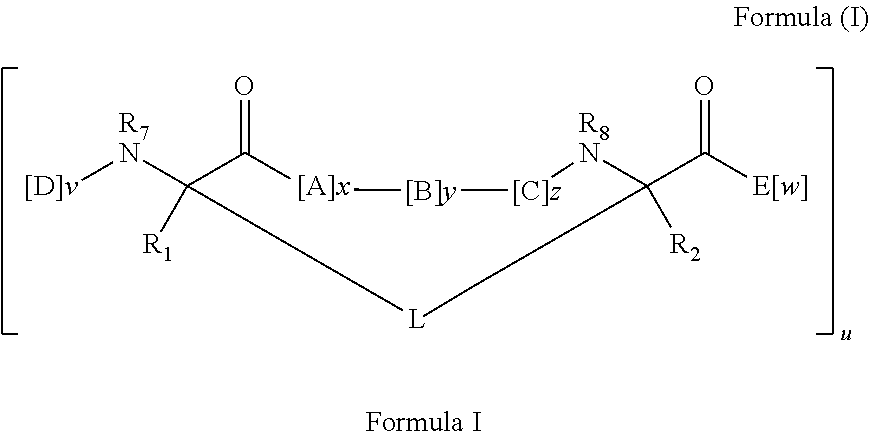
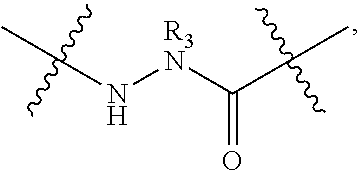
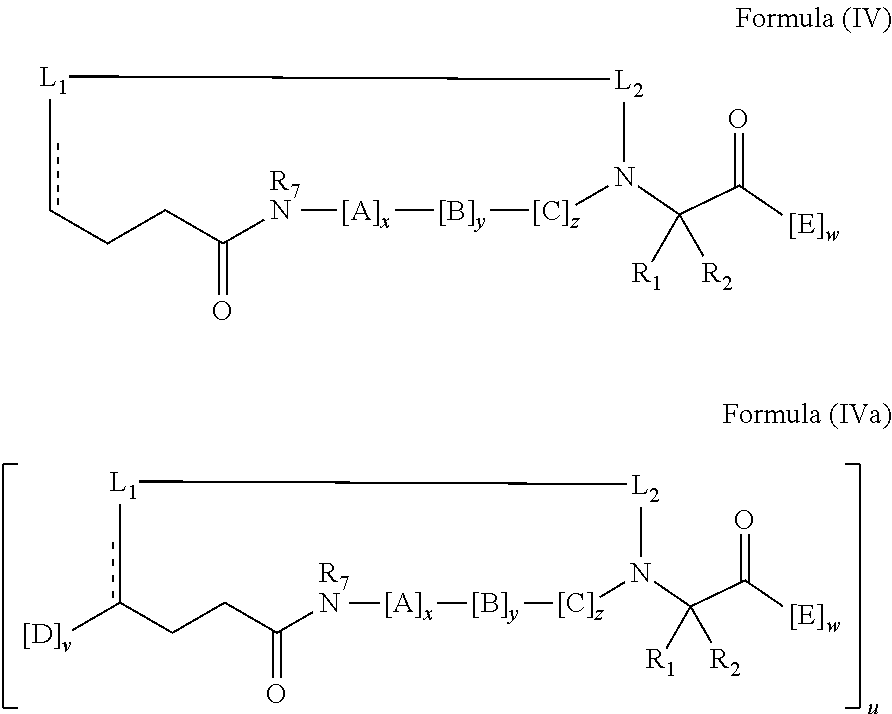
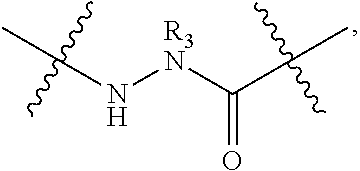


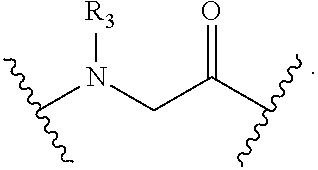


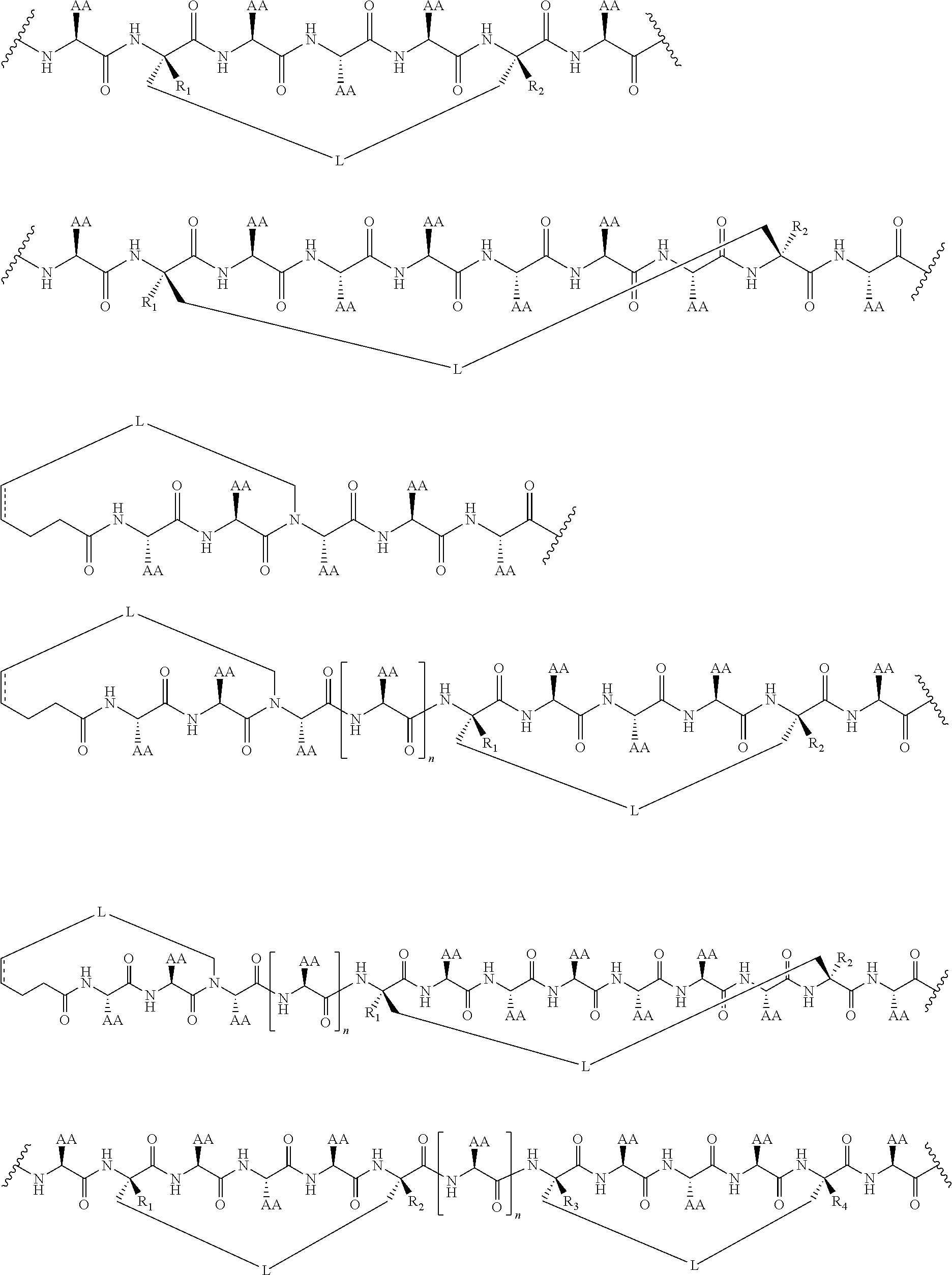
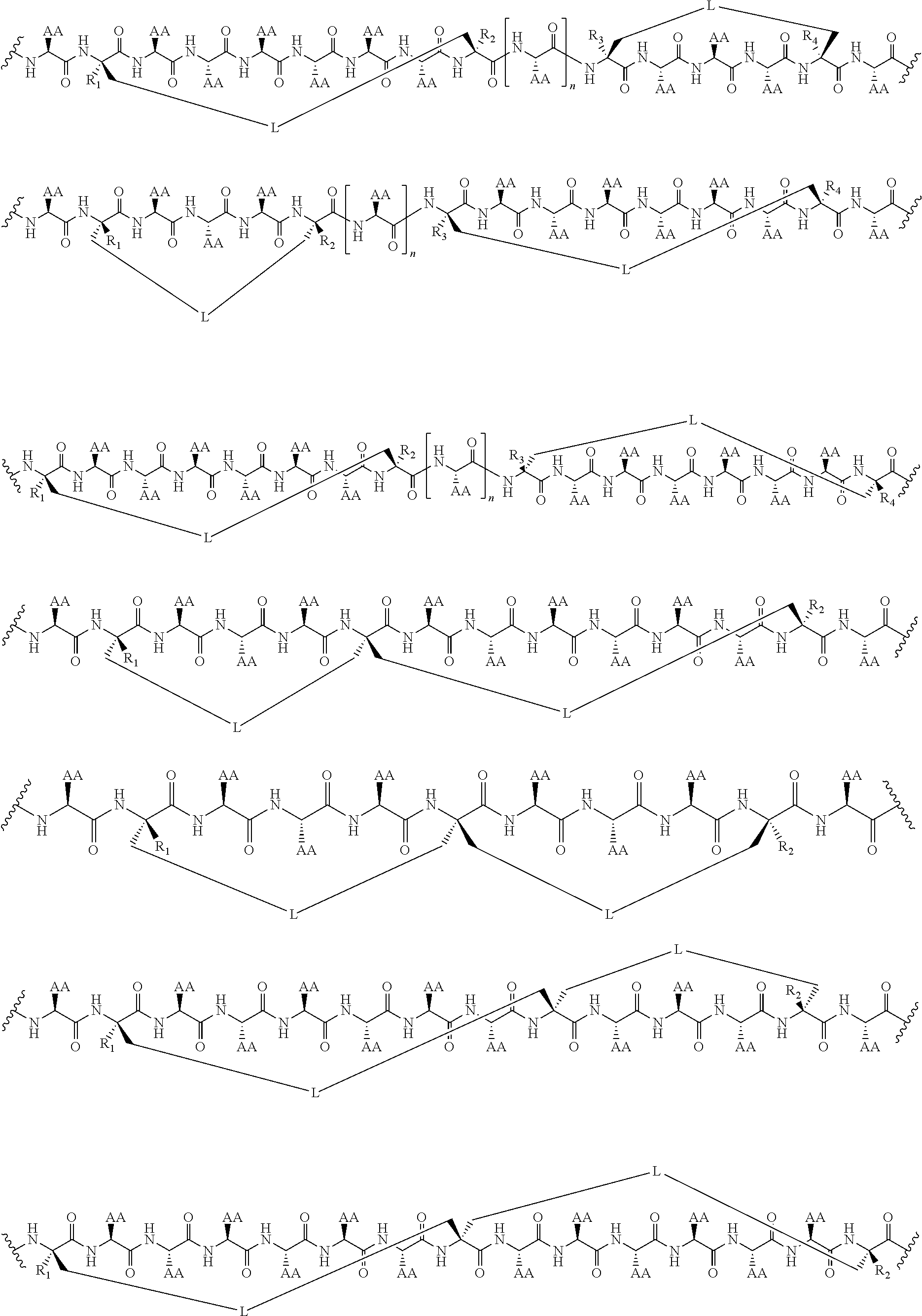

View All Diagrams
| United States Patent | 10,300,109 |
| Nash , et al. | May 28, 2019 |
Peptidomimetic macrocycles
Abstract
Disclosed are peptidomimetic macrocycles comprising a helix, such as an alpha helix, and methods of using such macrocycles for the treatment of disease such as cancer. In other aspects, the peptidomimetic macrocycle comprises an .alpha.,.alpha.-disubstituted amino acid, or may comprise a crosslinker linking the .alpha.-positions of at least two amino acids or at least one of said two amino acids may be an .alpha.,.alpha.-disubstituted amino acid. Further included is the targeting of components of the Wnt signaling pathway such as the Tcf4-/3-catenin complex.
| Inventors: | Nash; Huw M. (Concord, MA), Kapeller-Libermann; Rosana (Chestnut Hill, MA), Han; Jia-Wen (Newton, MA), Sawyer; Tomi K. (Southborough, MA), Noehre; Justin (Cambridge, MA), Kawahata; Noriyuki (West Roxbury, MA) | ||||||||||
|---|---|---|---|---|---|---|---|---|---|---|---|
| Applicant: |
|
||||||||||
| Assignee: | AILERON THERAPEUTICS, INC.
(Cambridge, MA) |
||||||||||
| Family ID: | 43796193 | ||||||||||
| Appl. No.: | 15/349,478 | ||||||||||
| Filed: | November 11, 2016 |
Prior Publication Data
| Document Identifier | Publication Date | |
|---|---|---|
| US 20170266254 A1 | Sep 21, 2017 | |
Related U.S. Patent Documents
| Application Number | Filing Date | Patent Number | Issue Date | ||
|---|---|---|---|---|---|
| 13497522 | |||||
| PCT/US2010/049892 | Sep 22, 2010 | ||||
| 61244819 | Sep 22, 2009 | ||||
| Current U.S. Class: | 1/1 |
| Current CPC Class: | A61P 35/02 (20180101); A61P 35/00 (20180101); C07K 7/64 (20130101); A61K 38/16 (20130101); C07K 7/50 (20130101); A61K 38/12 (20130101); C07K 14/00 (20130101); A61P 35/04 (20180101); A61K 38/00 (20130101) |
| Current International Class: | A61K 38/16 (20060101); C07K 14/00 (20060101); C07K 7/50 (20060101); A61K 38/12 (20060101); C07K 7/64 (20060101); A61K 38/00 (20060101) |
References Cited [Referenced By]
U.S. Patent Documents
| 4000259 | December 1976 | Garsky |
| 4191754 | March 1980 | Nutt et al. |
| 4270537 | June 1981 | Romaine |
| 4596556 | June 1986 | Morrow et al. |
| 4730006 | March 1988 | Bohme et al. |
| 4737465 | April 1988 | Bond et al. |
| 4790824 | December 1988 | Morrow et al. |
| 4886499 | December 1989 | Cirelli et al. |
| 4940460 | July 1990 | Casey et al. |
| 4941880 | July 1990 | Burns |
| 5015235 | May 1991 | Crossman |
| 5064413 | November 1991 | McKinnon et al. |
| 5120859 | June 1992 | Webb |
| 5141496 | August 1992 | Dalto et al. |
| 5190521 | March 1993 | Hubbard et al. |
| 5245009 | September 1993 | Kornreich et al. |
| 5312335 | May 1994 | McKinnon et al. |
| 5328483 | July 1994 | Jacoby |
| 5334144 | August 1994 | Alchas et al. |
| 5339163 | August 1994 | Homma et al. |
| 5364851 | November 1994 | Joran |
| 5383851 | January 1995 | McKinnon, Jr. et al. |
| 5417662 | May 1995 | Hjertman et al. |
| 5446128 | August 1995 | Kahn |
| 5466220 | November 1995 | Brenneman |
| 5480381 | January 1996 | Weston |
| 5503627 | April 1996 | McKinnon et al. |
| 5520639 | May 1996 | Peterson et al. |
| 5527288 | June 1996 | Gross et al. |
| 5569189 | October 1996 | Parsons |
| 5599302 | February 1997 | Lilley et al. |
| 5622852 | April 1997 | Korsmeyer |
| 5649912 | July 1997 | Peterson |
| 5650133 | July 1997 | Carvalho et al. |
| 5663316 | September 1997 | Xudong |
| 5672584 | September 1997 | Borchardt et al. |
| 5704911 | January 1998 | Parsons |
| 5708136 | January 1998 | Burrell et al. |
| 5731408 | March 1998 | Hadley et al. |
| 5750767 | May 1998 | Carpino et al. |
| 5811515 | September 1998 | Grubbs et al. |
| 5817752 | October 1998 | Yu |
| 5817789 | October 1998 | Heartlein et al. |
| 5824483 | October 1998 | Houston, Jr. et al. |
| 5834209 | November 1998 | Korsmeyer |
| 5837845 | November 1998 | Hosokawa et al. |
| 5840833 | November 1998 | Kahn |
| 5851775 | December 1998 | Barker et al. |
| 5856445 | January 1999 | Korsmeyer |
| 5859184 | January 1999 | Kahn et al. |
| 5874529 | February 1999 | Gilon et al. |
| 5922863 | July 1999 | Grubbs et al. |
| 5955593 | September 1999 | Korsmeyer |
| 5965703 | October 1999 | Horne et al. |
| 5993412 | November 1999 | Deily et al. |
| 5998583 | December 1999 | Korsmeyer |
| 6030997 | February 2000 | Eilat et al. |
| 6031072 | February 2000 | Blaschuk et al. |
| 6031073 | February 2000 | Yu |
| 6043339 | March 2000 | Lin et al. |
| 6046289 | April 2000 | Komazawa et al. |
| 6051554 | April 2000 | Hornik et al. |
| 6054556 | April 2000 | Huby et al. |
| 6153391 | November 2000 | Picksley et al. |
| 6169073 | January 2001 | Halazonetis et al. |
| 6177542 | January 2001 | Ruoslahti et al. |
| 6184344 | February 2001 | Kent et al. |
| 6204361 | March 2001 | Carpino et al. |
| 6271198 | August 2001 | Braisted et al. |
| 6287787 | September 2001 | Houghten et al. |
| 6326354 | December 2001 | Gross et al. |
| 6348558 | February 2002 | Harris et al. |
| 6495674 | December 2002 | Lemke et al. |
| 6514685 | February 2003 | Moro |
| 6569993 | May 2003 | Sledeski et al. |
| 6572856 | June 2003 | Taylor et al. |
| 6610657 | August 2003 | Goueli |
| 6613874 | September 2003 | Mazur et al. |
| 6686148 | February 2004 | Shen et al. |
| 6703382 | March 2004 | Wang et al. |
| 6713280 | March 2004 | Huang et al. |
| 6849428 | February 2005 | Evans et al. |
| 6875594 | April 2005 | Muir et al. |
| 7064193 | June 2006 | Cory et al. |
| 7083983 | August 2006 | Lane et al. |
| 7084244 | August 2006 | Gilon et al. |
| 7115372 | October 2006 | Shen et al. |
| 7183059 | February 2007 | Verdine et al. |
| 7192713 | March 2007 | Verdine et al. |
| 7202332 | April 2007 | Arora et al. |
| 7247700 | July 2007 | Korsmeyer et al. |
| 7538190 | May 2009 | Robinson et al. |
| 7705118 | April 2010 | Arora et al. |
| 7723469 | May 2010 | Walensky et al. |
| 7745573 | June 2010 | Robinson et al. |
| 7786072 | August 2010 | Verdine et al. |
| 7960506 | June 2011 | Nash |
| 7981998 | July 2011 | Nash |
| 7981999 | July 2011 | Nash |
| 8071541 | December 2011 | Arora et al. |
| 8124726 | February 2012 | Robinson et al. |
| 8198405 | June 2012 | Walensky et al. |
| 8324428 | December 2012 | Verdine et al. |
| 8389484 | March 2013 | Shen et al. |
| 8399405 | March 2013 | Nash et al. |
| 8524653 | September 2013 | Nash et al. |
| 8592377 | November 2013 | Verdine et al. |
| 8609809 | December 2013 | Nash |
| 8637686 | January 2014 | Nash |
| 8796418 | August 2014 | Walensky et al. |
| 8808694 | August 2014 | Nash et al. |
| 8859723 | October 2014 | Guerlavais et al. |
| 8871899 | October 2014 | Wang et al. |
| 8889632 | November 2014 | Bernal et al. |
| 8895699 | November 2014 | Verdine et al. |
| 8927500 | January 2015 | Guerlavais et al. |
| 8957026 | February 2015 | Verdine et al. |
| 8987414 | March 2015 | Guerlavais et al. |
| 9023988 | May 2015 | Nash |
| 9096684 | August 2015 | Kawahata et al. |
| 9163330 | October 2015 | Verdine et al. |
| 9175045 | November 2015 | Nash et al. |
| 9175047 | November 2015 | Huw et al. |
| 9175056 | November 2015 | Nash |
| 9206223 | December 2015 | Nash et al. |
| 9273099 | March 2016 | Walensky et al. |
| 9394336 | July 2016 | Nash et al. |
| 9458202 | October 2016 | Nash et al. |
| 9464115 | October 2016 | Walensky et al. |
| 9493509 | November 2016 | Nash et al. |
| 9505801 | November 2016 | Verdine et al. |
| 9505804 | November 2016 | Guerlavais et al. |
| 9522947 | December 2016 | Kawahata et al. |
| 9527896 | December 2016 | Bernal et al. |
| 9556227 | January 2017 | Verdine et al. |
| 9604919 | March 2017 | Darlak et al. |
| 9675661 | June 2017 | Nash et al. |
| 9845287 | December 2017 | Darlak et al. |
| 9951099 | April 2018 | Verdine et al. |
| 9957296 | May 2018 | Nash et al. |
| 9957299 | May 2018 | Guerlavais et al. |
| 10022422 | July 2018 | Nash et al. |
| 10023613 | July 2018 | Guerlavais et al. |
| 10030019 | July 2018 | Nash |
| 10030049 | July 2018 | Nash |
| 10059741 | August 2018 | Annis et al. |
| 2003/0166138 | September 2003 | Kinsella et al. |
| 2004/0023887 | February 2004 | Pillutla et al. |
| 2004/0038901 | February 2004 | Basler et al. |
| 2004/0067503 | April 2004 | Tan et al. |
| 2004/0106159 | June 2004 | Kern et al. |
| 2004/0106548 | June 2004 | Schmidt et al. |
| 2004/0115135 | June 2004 | Quay |
| 2004/0152708 | August 2004 | Li et al. |
| 2004/0171809 | September 2004 | Korsmeyer et al. |
| 2004/0235746 | November 2004 | Hawiger et al. |
| 2005/0119167 | June 2005 | Abbenante et al. |
| 2005/0222427 | October 2005 | Sharpless et al. |
| 2005/0250680 | November 2005 | Walensky et al. |
| 2006/0008848 | January 2006 | Verdine et al. |
| 2006/0014675 | January 2006 | Arora et al. |
| 2006/0073518 | April 2006 | Timmerman et al. |
| 2006/0111411 | May 2006 | Cooper et al. |
| 2006/0148715 | July 2006 | Tweardy |
| 2006/0293380 | December 2006 | Nantermet et al. |
| 2007/0020620 | January 2007 | Finn et al. |
| 2007/0117154 | May 2007 | Deslongchamps et al. |
| 2007/0161544 | July 2007 | Wipf et al. |
| 2007/0203057 | August 2007 | Doherty et al. |
| 2008/0081831 | April 2008 | Gour et al. |
| 2008/0213175 | September 2008 | Kolb et al. |
| 2008/0234183 | September 2008 | Hallbrink et al. |
| 2008/0250515 | October 2008 | Reed |
| 2008/0262200 | October 2008 | Nash |
| 2009/0047711 | February 2009 | Nash |
| 2009/0088553 | April 2009 | Nash |
| 2009/0149630 | June 2009 | Walensky et al. |
| 2009/0176964 | July 2009 | Walensky et al. |
| 2009/0275519 | November 2009 | Nash |
| 2009/0326192 | December 2009 | Nash et al. |
| 2010/0081611 | April 2010 | Bradner et al. |
| 2010/0168388 | July 2010 | Bernal et al. |
| 2010/0184628 | July 2010 | Nash |
| 2010/0184645 | July 2010 | Verdine et al. |
| 2010/0210515 | August 2010 | Nash et al. |
| 2010/0216688 | August 2010 | Nash et al. |
| 2010/0234563 | September 2010 | Arora et al. |
| 2010/0273704 | October 2010 | Korsmeyer et al. |
| 2010/0298201 | November 2010 | Nash et al. |
| 2011/0028753 | February 2011 | Verdine et al. |
| 2011/0046043 | February 2011 | Wang et al. |
| 2011/0144303 | June 2011 | Nash et al. |
| 2011/0144306 | June 2011 | Verdine et al. |
| 2011/0223149 | September 2011 | Nash et al. |
| 2011/0245175 | October 2011 | Arora et al. |
| 2011/0250685 | October 2011 | Nash |
| 2011/0263815 | October 2011 | Nash |
| 2012/0040889 | February 2012 | Nash et al. |
| 2012/0082636 | April 2012 | Walensky et al. |
| 2012/0101047 | April 2012 | Nash et al. |
| 2012/0115783 | May 2012 | Nash et al. |
| 2012/0115793 | May 2012 | Nash et al. |
| 2012/0172311 | July 2012 | Nash et al. |
| 2012/0178700 | July 2012 | Nash et al. |
| 2012/0264674 | October 2012 | Nash et al. |
| 2012/0270800 | October 2012 | Verdine et al. |
| 2013/0005943 | January 2013 | Arora et al. |
| 2013/0023646 | January 2013 | Nash et al. |
| 2013/0072439 | March 2013 | Nash |
| 2013/0123196 | May 2013 | Arora et al. |
| 2013/0177979 | July 2013 | Turkson |
| 2013/0211046 | August 2013 | Verdine et al. |
| 2014/0005118 | January 2014 | Verdine et al. |
| 2014/0011979 | January 2014 | Verdine et al. |
| 2014/0051828 | February 2014 | Arora et al. |
| 2014/0128581 | May 2014 | Darlak et al. |
| 2014/0162339 | June 2014 | Verdine et al. |
| 2014/0235549 | August 2014 | Moellering et al. |
| 2014/0256912 | September 2014 | Moellering et al. |
| 2014/0296160 | October 2014 | Walensky et al. |
| 2014/0323701 | October 2014 | Nash et al. |
| 2014/0378390 | December 2014 | Guerlavais et al. |
| 2015/0038430 | February 2015 | Nash et al. |
| 2015/0051155 | February 2015 | Guerlavais et al. |
| 2015/0056612 | February 2015 | Shen et al. |
| 2015/0119551 | April 2015 | Bernal et al. |
| 2015/0183825 | July 2015 | Guerlavais et al. |
| 2015/0225471 | August 2015 | Liang et al. |
| 2015/0239937 | August 2015 | Verdine et al. |
| 2015/0284437 | October 2015 | Verdine et al. |
| 2016/0052970 | February 2016 | Guerlavais et al. |
| 2016/0068573 | March 2016 | Nash et al. |
| 2016/0095896 | April 2016 | Nash |
| 2016/0096873 | April 2016 | Nash et al. |
| 2016/0101145 | April 2016 | Annis et al. |
| 2016/0108089 | April 2016 | Nash et al. |
| 2016/0115204 | April 2016 | Nash et al. |
| 2016/0137710 | May 2016 | Kawahata et al. |
| 2016/0193283 | July 2016 | Chen et al. |
| 2016/0250278 | September 2016 | Nash et al. |
| 2016/0251399 | September 2016 | Nash et al. |
| 2016/0257716 | September 2016 | Guerlavais et al. |
| 2016/0289274 | October 2016 | Nash |
| 2016/0304564 | October 2016 | Nash |
| 2016/0333049 | November 2016 | Chen et al. |
| 2017/0002042 | January 2017 | Annis et al. |
| 2017/0008930 | January 2017 | Walensky et al. |
| 2017/0015716 | January 2017 | Walensky et al. |
| 2017/0037086 | February 2017 | Kawahata et al. |
| 2017/0037105 | February 2017 | Samant |
| 2017/0066714 | March 2017 | Darlak et al. |
| 2017/0066799 | March 2017 | Verdine et al. |
| 2017/0081379 | March 2017 | Bernal et al. |
| 2017/0088581 | March 2017 | Verdine et al. |
| 2017/0107252 | April 2017 | Guerlavais et al. |
| 2017/0114098 | April 2017 | Aivado et al. |
| 2017/0212125 | July 2017 | Nash et al. |
| 2017/0226177 | August 2017 | Kawahata et al. |
| 2017/0281720 | October 2017 | Guerlavais et al. |
| 2017/0296620 | October 2017 | Nash |
| 2017/0298099 | October 2017 | Nash et al. |
| 2017/0360881 | December 2017 | Samant et al. |
| 2018/0085426 | March 2018 | Nash et al. |
| 2018/0100001 | April 2018 | Verdine et al. |
| 1252808 | May 2000 | CN | |||
| 1583730 | Feb 2005 | CN | |||
| 19909251 | Aug 1999 | DE | |||
| 0467699 | Jan 1992 | EP | |||
| 0467699 | Feb 1993 | EP | |||
| 0729972 | Sep 1996 | EP | |||
| 1452868 | Sep 2004 | EP | |||
| 1541692 | Jun 2005 | EP | |||
| 1602663 | Dec 2005 | EP | |||
| 1597585 | Jun 2011 | EP | |||
| 2002505255 | Feb 2002 | JP | |||
| 2002524391 | Aug 2002 | JP | |||
| WO-8909233 | Oct 1989 | WO | |||
| WO-9301203 | Jan 1993 | WO | |||
| WO-9425482 | Nov 1994 | WO | |||
| WO-9500534 | Jan 1995 | WO | |||
| WO-9602642 | Feb 1996 | WO | |||
| WO-9628449 | Sep 1996 | WO | |||
| WO-9634878 | Nov 1996 | WO | |||
| WO-9700267 | Jan 1997 | WO | |||
| WO-9713537 | Apr 1997 | WO | |||
| WO-9730072 | Aug 1997 | WO | |||
| WO-9737705 | Oct 1997 | WO | |||
| WO-9801467 | Jan 1998 | WO | |||
| WO-9846631 | Oct 1998 | WO | |||
| WO-9914259 | Mar 1999 | WO | |||
| WO-9934833 | Jul 1999 | WO | |||
| WO-9934850 | Jul 1999 | WO | |||
| WO-0006187 | Feb 2000 | WO | |||
| WO-0006187 | May 2000 | WO | |||
| WO-0244378 | Jun 2002 | WO | |||
| WO-02064790 | Aug 2002 | WO | |||
| WO-02072597 | Sep 2002 | WO | |||
| WO-02064790 | May 2003 | WO | |||
| WO-03059933 | Jul 2003 | WO | |||
| WO-03070892 | Aug 2003 | WO | |||
| WO-03106491 | Dec 2003 | WO | |||
| WO-03059933 | Jan 2004 | WO | |||
| WO-2004041275 | May 2004 | WO | |||
| WO-2004058804 | Jul 2004 | WO | |||
| WO-2004077062 | Sep 2004 | WO | |||
| WO-03070892 | Nov 2004 | WO | |||
| WO-03106491 | Dec 2004 | WO | |||
| WO-2004077062 | Jan 2005 | WO | |||
| WO-2005007675 | Jan 2005 | WO | |||
| WO-2004077062 | Feb 2005 | WO | |||
| WO-2005012335 | Feb 2005 | WO | |||
| WO-2005040202 | May 2005 | WO | |||
| WO-2005044839 | May 2005 | WO | |||
| WO-2005040202 | Jun 2005 | WO | |||
| WO-2005007675 | Jul 2005 | WO | |||
| WO-2005044839 | Jul 2005 | WO | |||
| WO-2005085457 | Sep 2005 | WO | |||
| WO-2005090388 | Sep 2005 | WO | |||
| WO-2005118620 | Dec 2005 | WO | |||
| WO-2005118634 | Dec 2005 | WO | |||
| WO-2005118634 | May 2006 | WO | |||
| WO-2005118620 | Jun 2006 | WO | |||
| WO-2006078161 | Jul 2006 | WO | |||
| WO-2006103666 | Oct 2006 | WO | |||
| WO-2006103666 | Mar 2007 | WO | |||
| WO-2007141533 | Dec 2007 | WO | |||
| WO-2008061192 | May 2008 | WO | |||
| WO-2008076904 | Jun 2008 | WO | |||
| WO-2008095063 | Aug 2008 | WO | |||
| WO-2008104000 | Aug 2008 | WO | |||
| WO-2008121767 | Oct 2008 | WO | |||
| WO-2008137633 | Nov 2008 | WO | |||
| WO-2009042237 | Apr 2009 | WO | |||
| WO-2009089004 | Jul 2009 | WO | |||
| WO-2009099677 | Aug 2009 | WO | |||
| WO-2009110952 | Sep 2009 | WO | |||
| WO-2009126292 | Oct 2009 | WO | |||
| WO-2009099677 | Dec 2009 | WO | |||
| WO-2009149214 | Dec 2009 | WO | |||
| WO-2010011313 | Jan 2010 | WO | |||
| WO-2010033879 | Mar 2010 | WO | |||
| WO-2010034026 | Mar 2010 | WO | |||
| WO-2010034028 | Mar 2010 | WO | |||
| WO-2010034029 | Mar 2010 | WO | |||
| WO-2010034031 | Mar 2010 | WO | |||
| WO-2010034032 | Mar 2010 | WO | |||
| WO-2010034034 | Mar 2010 | WO | |||
| WO-2010060112 | May 2010 | WO | |||
| WO-2010068684 | Jun 2010 | WO | |||
| WO-2010083347 | Jul 2010 | WO | |||
| WO-2011008260 | Jan 2011 | WO | |||
| WO-2011038049 | Mar 2011 | WO | |||
| WO-2011047215 | Apr 2011 | WO | |||
| WO-2012021874 | Feb 2012 | WO | |||
| WO-2012021875 | Feb 2012 | WO | |||
| WO-2012021876 | Feb 2012 | WO | |||
| WO-2012040459 | Mar 2012 | WO | |||
| WO-2012122059 | Sep 2012 | WO | |||
| WO-2012173846 | Dec 2012 | WO | |||
| WO-2012174423 | Dec 2012 | WO | |||
| WO-2013033645 | Mar 2013 | WO | |||
| WO-2013059525 | Apr 2013 | WO | |||
| WO-2013059530 | Apr 2013 | WO | |||
| WO-2013123266 | Aug 2013 | WO | |||
| WO-2013123267 | Aug 2013 | WO | |||
| WO-2014052647 | Apr 2014 | WO | |||
| WO-2014055564 | Apr 2014 | WO | |||
| WO-2014071241 | May 2014 | WO | |||
| WO-2014138429 | Sep 2014 | WO | |||
| WO-2015157508 | Oct 2015 | WO | |||
| WO-2016049355 | Mar 2016 | WO | |||
| WO-2016049359 | Mar 2016 | WO | |||
| WO-2016154058 | Sep 2016 | WO | |||
| WO-2017004548 | Jan 2017 | WO | |||
| WO-2017004591 | Jan 2017 | WO | |||
| WO-2017023933 | Feb 2017 | WO | |||
| WO-2017040990 | Mar 2017 | WO | |||
| WO-2017044633 | Mar 2017 | WO | |||
| WO-2017165299 | Sep 2017 | WO | |||
| WO-2017205786 | Nov 2017 | WO | |||
| WO-2017218949 | Dec 2017 | WO | |||
Other References
|
Co-pending U.S. Appl. No. 15/711,576, filed Sep. 21, 2017. cited by applicant . Co-pending U.S. Appl. No. 15/794,355, filed Oct. 26, 2017. cited by applicant . Kelekar, et al. Bcl-2-family proteins: the role of the BH3 domain in apoptosis. Trends Cell Biol. Aug. 1998;8(8):324-30. cited by applicant . Office action dated Aug. 30, 2017 for U.S. Appl. No. 15/287,513. cited by applicant . Adhikary et al., Transcriptional regulation and transformation by Myc proteins. Nat Rev Mol Cell Biol. Aug. 2005;6(8):635-45. cited by applicant . Aman et al., cDNA cloning and characterization of the human interleukin 13 receptor alpha chain. J Biol Chem. Nov. 15, 1996;271(46):29265-70. cited by applicant . Andrews et al. Forming Stable Helical Peptide Using Natural and Artificial Amino Acids. Tetrahedron. 1999;55:11711-11743. cited by applicant . Andrews et al., Kinetic analysis of the interleukin-13 receptor complex. J Biol Chem. Nov. 29, 2002;277(48):46073-8. Epub Sep. 26, 2002. cited by applicant . Angel & Karin, "The Role of Jun, Fos and the AP-1 Complex in Cell-proliferation and Transformation," Biochim. Biophys. Acta 1072:129-157 (1991). cited by applicant . Angell, et al. Peptidomimetics via copper-catalyzed azide-alkyne cycloadditions. Chem Soc Rev. Oct. 2007;36(10):1674-89. cited by applicant . Angell, et al. Ring closure to beta-turn mimics via copper-catalyzed azide/alkyne cycloadditions. J Org Chem. Nov. 11, 2005;70(23):9595-8. cited by applicant . Annis, et al. A general technique to rank protein-ligand binding affinities and determine allosteric versus direct binding site competition in compound mixtures. J Am Chem Soc. Dec. 1, 2004;126(47):15495-503. cited by applicant . Annis, et al. ALIS: An Affinity Selection-Mass Spectrometry System for the Discovery and Characterization of Protein-Ligand Interactions. In: Wanner, K. and Hofner, G. eds. Mass Spectrometry in Medicinal Chemistry. Wiley-VCH; 2007:121-156. cited by applicant . Armstrong et al., X=Y-ZH Systems as potential 1,3-dipoles. 5. Intramolecular cycloadditions of imines of a-amino acid esters. Tetrahedron. 1985;41(17):3547-58. cited by applicant . Arosio, et al. Click chemistry to functionalise peptidomimetics. Tetrahedron Letters. 2006; 47:3697-3700. cited by applicant . Artavanis-Tsakonas et al., Notch signaling: cell fate control and signal integration in development. Science. Apr. 30, 1999;284(5415):770-6. cited by applicant . Attisano et al., TGFbeta and Wnt pathway cross-talk. Cancer Metastasis Rev. Jan.-Jun. 2004;23(1-2):53-61. cited by applicant . Austin et al., "A Template for Stabilization of a Peptide .alpha.-Helix: Synthesis and Evaluation of Conformational Effects by Circular Dichroism and NMR," J. Am. Chem. Soc. 119:6461-6472(1997). cited by applicant . Babcock, Proteins, radicals, isotopes, and mutants in photosynthetic oxygen evolution. Proc Natl Acad Sci U S A. Dec. 1, 1993;90(23):10893-5. cited by applicant . Babine et aL, Molecular Recognition of Proteinminus signLigand Complexes: Applications to Drug Design. Chem Rev. Aug. 5, 1997;97(5):1359-1472. cited by applicant . Badyal, et al. A Simple Method for the Quantitative Analysis of Resin Bound Thiol Groups. Tetrahedron Lett. 2001; 42:8531-33. cited by applicant . Baell, J.B. Prospects for Targeting the Bcl-2 Family of Proteins to Develop Novel cytotoxic drugs. Biochem Pharmacol. Sep. 2002;64(5-6):851-63. cited by applicant . Bakhshi, et al. Cloning the chromosomal breakpoint of t(14;18) human lymphomas: clustering around JH on chromosome 14 and near a transcriptional unit on 18. Cell. Jul. 1985;41(3):899-906. cited by applicant . Banerjee et aL, Structure of a DNA glycosylase searching for lesions. Science. Feb. 24, 2006;311(5764):1153-7. cited by applicant . Banerjee et al., Structure of a repair enzyme interrogating undamaged DNA elucidates recognition of damaged DNA. Nature. Mar. 31, 2005;434(7033):612-8. cited by applicant . Banerji et al. Synthesis of Cyclic .beta.-Turn Mimics from L-Pro-Phe/Phe-L-Pro Derived Di- and Tripeptides via Ring Closing Metathesis: The Role of Chirality of the Phe Residue During Cyclization. Tetrahedron Lett. 2002; 43:6473-6477. cited by applicant . Bang et al., Total chemical synthesis of crambin. J Am Chem Soc. Feb. 11, 2004;126(5):1377-83. cited by applicant . Barker, et al. Cyclic RGD peptide analogues as antiplatelet antithrombotics. J Med Chem. May 29, 1992;35(11):2040-8. (Abstract only). cited by applicant . Barker et al., Mining the Wnt pathway for cancer therapeutics. Nat Rev Drug Discov. Dec. 2006;5(12):997-1014. cited by applicant . Behrens, et al. Functional interaction of beta-catenin with the transcription factor LEF-1. Nature. Aug. 15, 1996;382(6592):638-42. cited by applicant . Belokon et al., Chiral Complexes of Ni(II), Cu(II) and Cu(I) as Reagents, Catalysts and Receptors for Asymmetric Synthesis and Chiral Recognition of Amino Acids. Pure & Appl Chem. 1992;64(12):1917-24. cited by applicant . Belokon et al., Improved procedures for the synthesis of (S)-21N-(N'-benzyl-prolypaminolbenzophenone (BPB) and Ni(II) complexes of Schiffs bases derived from BPB and amino acids. Tetrahedron: Asymmetry. 1998;9:4249-52. cited by applicant . Belokon, et al. Improved procedures for the synthesis of (S)-2-[N-(N'-benzylprolyl)amino]benzophenone (BPB) and Ni(II) complexes of Schiffs bases derived from BPB and amino acids. Tetrahedron: Asymmetry, vol. 9, Issue 23, Dec. 11, 1998, pp. 4249-4252. cited by applicant . Bennett, et al. Regulation of osteoblastogenesis and bone mass by Wntl Ob. Proc Natl Acad Sci U S A. Mar. 1, 2005;102(9):3324-9 . . . Epub Feb. 22, 2005. cited by applicant . Berendsen et al. A glimpse of the Holy Grail? Science 282(5389):642-643 (1998). cited by applicant . Berge et al. Pharmaceutical Salts. Journal of Pharmaceutical Sciences 66(1):1-19 (Jan. 1977). cited by applicant . Bernal, et al. Reactivation of the p53 tumor suppressor pathway by a stapled p53 peptide. J Am Chem Soc. Mar. 7, 2007;129(9):2456-7. cited by applicant . Biagini et al., Cross-metathesis of Unsaturated a-amino Acid Derivatives. J Chem Soc Perkin Trans. 1998;1:2485-99. cited by applicant . Bienz et al. Linking colorectal cancer to Wnt signaling. Cell 103(2):311-320 (2000). cited by applicant . Bierzynski et al. A salt bridge stabilizes the helix formed by isolated C-Peptide of RNase A. PNAS USA. 1982;79:2470-2474. cited by applicant . Blackwell, et al. Highly Efficient Synthesis of Covalently Cross-Linked Peptide Helices by Ring-Closing Metathesis. Angewandte Chemie International Edition. 1998; 37(23):3281-3284. cited by applicant . Blackwell, et al. Ring-closing metathesis of olefinic peptides: design, synthesis, and structural characterization of macrocyclic helical peptides. J Org Chem. Aug. 10, 2001;66(16):5291-302. cited by applicant . Blundell et al., Atomic positions in rhombohedral 2-zinc insulin crystals. Nature. Jun. 25, 1971;231(5304):506-11. cited by applicant . Bock, et al. 1,2,3-Triazoles as peptide bond isosteres: synthesis and biological evaluation of cyclotetrapeptide mimics. Org Biomol Chem. Mar. 21, 2007;5(6):971-5. cited by applicant . Bode et al., Chemoselective amide ligations by decarboxylative condensations of N-alkylhydroxylamines and alpha-ketoacids. Angew Chem Int Ed Engl. Feb. 13, 2006;45(8):1248-52. cited by applicant . Boguslavsky, et al. Effect of peptide conformation on membrane permeability. J Pept Res. Jun. 2003;61(6):287-97. cited by applicant . Bossy-Wetzel et al. Assays for cytochrome c release from mitochondria during apoptosis. Methods Enzymol. 322:235-242 (2000). cited by applicant . Bossy-Wetzel, et al. Detection of apoptosis by annexin V labeling. Methods Enzymol. 2000;322:15-8. cited by applicant . Boyden et al. High bone density due to a mutation in LDL-receptor-related protein 5. N Engl J Med 346(20):1513-1521 (2002). cited by applicant . Bracken et al. Synthesis and nuclear magnetic resonance structure determination of an alpha-helical, bicyclic, lactam-bridged hexapeptide. JACS. 1994;116:6431-6432. cited by applicant . Bradley et al. Limits of cooperativity in a structurally modular protein: response of the Notch ankyrin domain to analogous alanine substitutions in each repeat. J Mol Biol. 324(2):373-386 (2002). cited by applicant . Brandt et al., Dimeric fragment of the insulin receptor alpha-subunit binds insulin with full holoreceptor affinity. J Biol Chem. Apr. 13, 2001;276(15):12378-84. Epub Jan. 12, 2001. cited by applicant . Bray, Notch signalling: a simple pathway becomes complex. Nat Rev Mol Cell Biol. Sep. 2006;7(9):678-89. cited by applicant . Brou et al., A novel proteolytic cleavage involved in Notch signaling: the role of the disintegrin-metalloprotease TACE. Mol Cell. Feb. 2000;5(2):207-16. cited by applicant . Brubaker et al., Solution structure of the interacting domains of the Mad-Sin3 complex: implications for recruitment of a chromatin-modifying complex. Cell. Nov. 10, 2000;103(4):655-65. cited by applicant . Brunel, et al. Synthesis of constrained helical peptides by thioether ligation: application to analogs of gp41. Chem Commun (Camb). May. 28, 2005;(20):2552-4. Epub Mar. 11, 2005. cited by applicant . Brusselle et al., Allergen-induced airway inflammation and bronchial responsiveness in wild-type and interleukin-4-deficient mice. Am J Respir Cell Mol Biol. Mar. 1995;12(3):254.-9. cited by applicant . Burfield & Smithers, "Desiccant Efficiency in Solvent Drying. 3. Dipolar Aprotic Solvents," J. Org. Chem. 43(20):3966-3968 (1978). cited by applicant . Burrage, et al. Biomimetic synthesis of lantibiotics. Chemistry. Apr. 14, 2000;6(8):1455-66. cited by applicant . Cabezas & Satterthwait, "The Hydrogen Bond Mimic Approach: Solid-phase Synthesis of a Peptide Stabilized as an .alpha.-Helix with a Hydrazone Link," J. Am. Chem. Soc. 121:3862-3875 (1999). cited by applicant . Campbell, et al. N-alkylated oligoamide alpha-helical proteomimetics. Org Biomol Chem. May 21, 2010;8(10):2344-51. doi: 10.1039/c001164a. Epub Mar. 18, 2010. cited by applicant . Cantel, et al. Synthesis and Conformational Analysis of a Cyclic Peptide Obtained via i to i+4 Intramolecular Side-Chain to Side-Chain Azide-Alkyne 1,3-Dipolar Cycloaddition. JOC Featured Article. Published on the web May 20, 2008. cited by applicant . Caricasole et al., The Wnt pathway, cell-cycle activation and beta-amyloid: novel therapeutic strategies in Alzheimer's disease? Trends Pharmacol Sci. May 2003;24(5):233-8. cited by applicant . Carlson et al., Specificity landscapes of DNA binding molecules elucidate biological function. Proc Natl Acad Sci USA. Mar. 9, 2010;107(10):4544-9. doi: 10.1073/pnas.0914023107. Epub Feb. 22, 2010. cited by applicant . Chakrabartty et al., "Helix Capping Propensities in Peptides Parallel Those in Proteins," Proc. Nat'l Acad. Sci. USA 90:11332-11336 (1993). cited by applicant . Chapman et al., "A Highly Stable Short .alpha.-Helix Constrained by a Main-chain Hydrogen-bond Surrogate," J. Am. Chem. Soc. 126:12252-12253 (2004). cited by applicant . Chapman, et al. Optimized synthesis of hydrogen-bond surrogate helices: surprising effects of microwave heating on the activity of Grubbs catalysts. Org Lett. Dec. 7, 2006;8(25):5825-8. cited by applicant . Chapman, et al. Trapping a folding intermediate of the alpha-helix: stabilization of the pi-helix. Biochemistry. Apr. 8, 2008;47(14):4189-95. doi: 10.1021/bi800136m. Epub Mar. 13, 2008. cited by applicant . Chen et al., Determination of the helix and beta form of proteins in aqueous solution by circular dichroism. Biochemistry. Jul. 30, 1974;13(16):3350-9. cited by applicant . Chen, et al. Determination of the Secondary Structures of Proteins by Circular Dichroism and Optical Rotatory Dispersion. Biochemistry. 1972; 11(22):4120-4131. cited by applicant . Chen et al., Small molecule-mediated disruption of Wnt-dependent signaling in tissue regeneration and cancer. Nat Chem Biol. Feb. 2009;5(2):100-7. Epub Jan. 4, 2009. cited by applicant . Chen et al., "Structure of the DNA-binding Domains from NFAT, Fos and Jun Bound Specifically to DNA," Nature 392:42-48 (1998). cited by applicant . Cheng et al., Emerging role of RAB GTPases in cancer and human disease. Cancer Res. Apr. 1, 2005;65(7):2516-9. cited by applicant . Cheng et al., The RAB25 small GTPase determines aggressiveness of ovarian and breast cancers. Nat Med. Nov. 2004;10(11):1251-6. Epub Oct. 24, 2004. cited by applicant . Cheon et al., beta-Catenin stabilization dysregulates mesenchymal cell proliferation, motility, and invasiveness and causes aggressive fibromatosis and hyperplastic cutaneous wounds. Proc Natl Acad Sci U S A. May 14, 2002;99(10):6973-8. Epub Apr. 30, 2002. cited by applicant . Chia et al., Emerging roles for Rab family GTPases in human cancer. Biochim Biophys Acta. Apr. 2009;1795(2):110-6. cited by applicant . Chiaramonte et al., Studies of murine schistosomiasis reveal interleukin-13 blockade as a treatment for established and progressive liver fibrosis. Hepatology. Aug. 2001;34(2):273-82. cited by applicant . Chin & Schepartz, "Design and Evolution of a Miniature Bcl-2 Binding Protein," Angew. Chem. Int. Ed. 40(20):3806-3809 (2001). cited by applicant . Chin et al., "Circular Dichroism Spectra of Short, Fixed-nucleus Alanine Helices," Proc. Nat'l Acad. Sci. USA 99(24):15416-15421 (2002). cited by applicant . Chittenden, et al. A conserved domain in Bak, distinct from BH1 and BH2, mediates cell death and protein binding functions. EMBO J. Nov. 15, 1995;14(22):5589-96. cited by applicant . Chene et al., "Study of the Cytotoxic Effect of a Peptidic Inhibitor of the p53-hdm2 Interaction in Tumor Cells," FEBS Lett. 529:293-297 (2002). cited by applicant . Chene, P., "Inhibiting the p53-MDM2 Interaction: An Important Target for Cancer Therapy," Nat Rev. Cancer 3:102-109 (2003). cited by applicant . Choi, et al. Application of azide-alkyne cycloaddition `click chemistry` for the synthesis of Grb2 SH2 domain-binding macrocycles. Bioorg Med Chem Lett. Oct. 15, 2006;16(20):5265-9. cited by applicant . Christodoulides et al., WNT1OB mutations in human obesity. Diabetologia. Apr. 2006;49(4):678-84. Epub Feb. 14, 2006. cited by applicant . Chu, et al. Peptide-formation on cysteine-containing peptide scaffolds. Orig Life Evol Biosph. Oct. 1999;29(5):441-9. cited by applicant . Clark et al., Supramolecular Design by Covalent Capture. Design of a Peptide Cylinder via Hydrogen-Bond-Promoted Intermolecular Olefin Metathesis. J Am Chem Soc. 1995;117:12364-65. cited by applicant . Cleary, et al. Nucleotide sequence of a t(14;18) chromosomal breakpoint in follicular lymphoma and demonstration of a breakpoint-cluster region near a transcriptionally active locus on chromosome 18. Proc Natl Acad Sci U S A. Nov. 1985;82(21):7439-43. cited by applicant . Clevers, Wnt/beta-catenin signaling in development and disease. Cell. Nov. 3, 2006;127(3):469-80. cited by applicant . Cline, et al. Effects of As(III) binding on alpha-helical structure. J Am Chem Soc. Mar. 12, 2003;125(10):2923-9. cited by applicant . Cohn et al., Cutting Edge: IL-4-independent induction of airway hyperresponsiveness by Th2, but not Thl, cells. J Immunol. Oct. 15, 1998;161(8):3813-6. cited by applicant . Colaluca et al., NUMB controls p53 tumour suppressor activity. Nature. Jan. 3, 2008;451(7174):76-80. doi: 10.1038/nature06412. cited by applicant . Cole et al., Transcription-independent functions of MYC: regulation of translation and DNA replication. Nat Rev Mol Cell Biol. Oct. 2008;9(10):810-5. Epub Aug. 13, 2008. cited by applicant . Cong et al., A protein knockdown strategy to study the function of beta-catenin in tumorigenesis. BMC Mol Biol. Sep. 29, 2003;4:10. cited by applicant . Co-pending U.S. Appl. No. 13/494,846, filed Jun. 12, 2012. cited by applicant . Co-pending U.S. Appl. No. 13/655,442, filed Oct. 18, 2010. cited by applicant . Co-pending U.S. Appl. No. 15/229,517, filed Aug. 5, 2016. cited by applicant . Co-pending U.S. Appl. No. 15/233,796, filed Aug. 10, 2016. cited by applicant . Co-pending U.S. Appl. No. 15/256,130, filed Sep. 2, 2016. cited by applicant . Co-pending U.S. Appl. No. 15/257,807, filed Sep. 6, 2016. cited by applicant . Co-pending U.S. Appl. No. 15/259,947, filed Sep. 8, 2016. cited by applicant . Co-pending U.S. Appl. No. 15/332,492, filed Oct. 24, 2016. cited by applicant . Co-pending U.S. Appl. No. 15/493,301, filed Apr. 21, 2017. cited by applicant . Cory et al., "The Bcl-2 Family: Roles in Cell Survival and Oncogenesis," Oncogene 22:8590-8607 (2003). cited by applicant . Cossu et al., Wnt signaling and the activation of myogenesis in mammals EMBO J. Dec. 15, 1999;18(24):6867-72. cited by applicant . Cox et al., Insulin receptor expression by human prostate cancers. Prostate. Jan. 1, 2009;69(1):33- 40. doi: 10.1002/pros.20852. cited by applicant . Cummings, et al. Disrupting protein-protein interactions with non-peptidic, small molecule alpha-helix mimetics. Curr Opin Chem Biol. Jun. 2010;14(3):341-6. doi: 10.1016/j.cbpa.2010.04.001. Epub Apr. 27, 2010. cited by applicant . Cusack et al. 2,4,6-Tri-isopropylbenzenesulphonyl Hydrazide: A convenient source of Di-Imide. Tetrahedron. 1976;32:2157-2162. cited by applicant . Danial, et al. Cell death: critical control points. Cell. 2004; 116:204-219. cited by applicant . Danial et al., Dual role of proapoptotic BAD in insulin secretion and beta cell survival. Nat Med. Feb. 2008;14(2):144-53. doi: 10.1038/nm1717. Epub Jan. 27, 2008. cited by applicant . Daniels, et al. beta-catenin: molecular plasticity and drug design. Trends Biochem Sci. Nov. 2001;26(11):672-8. cited by applicant . Darnell, Transcription factors as targets for cancer therapy. Nat Rev Cancer. Oct. 2002;2(10):740-9. cited by applicant . Daugherty & Gellman, "A Fluorescence Assay for Leucine Zipper Dimerization: Avoiding Unintended Consequences of Fluorophore Attachment," J. Am. Chem. Soc. 121:4325-4333 (1999). cited by applicant . David et al., Expressed protein ligation. Method and applications. Eur J Biochem. Feb. 2004;271(4):663-77. cited by applicant . Dawson et al., Synthesis of proteins by native chemical ligation. Science. Nov. 4, 1994;266(5186):776-9. cited by applicant . De Guzman et al., Structural basis for cooperative transcription factor binding to the CBP coactivator. J Mol Biol. Feb. 3, 2006;355(5):1005-13. Epub Oct. 5, 2005. cited by applicant . De La O et al., Notch and Kras reprogram pancreatic acinar cells to ductal intraepithelial neoplasia. Proc Natl Acad Sci U S A. Dec. 2, 2008;105(48):18907-12. doi: 10.1073/pnas.0810111105. Epub Nov. 21, 2008. cited by applicant . De Meyts et al., Insulin interactions with its receptors: experimental evidence for negative cooperativity. Biochem Biophys Res Commun. Nov. 1, 1973;55(1):154-61. cited by applicant . De Meyts, The structural basis of insulin and insulin-like growth factor-I receptor binding and negative co-operativity, and its relevance to mitogenic versus metabolic signalling. Diabetologia. Sep. 1994;37 Suppl 2:S135-48. cited by applicant . De Strooper et al., A presenilin-I-dependent gamma-secretase-like protease mediates release of Notch intracellular domain. Nature. Apr. 8, 1999;398(6727):518-22. cited by applicant . Debinski et al., Retargeting interleukin 13 for radioimmunodetection and radioimmunotherapy of human high-grade gliomas. Clin Cancer Res. Oct. 1999;5(10 Suppl):3143s-31475. cited by applicant . Definition of Analog from http://cancerweb.ncl.ac.uk/cgi-bin/omd?query=analog. pp. 1-5. Accessed Jul. 7, 2005. cited by applicant . Degterev et al. Identification of Small-molecule Inhibitors of Interaction between the BH3 Domain and Bcl-xL. Nature Cell Biol. 3:173-182 (2001). cited by applicant . Deiters, et al. Adding amino acids with novel reactivity to the genetic code of Saccharomyces cerevisiae. J Am Chem Soc. Oct. 1, 2003;125(39):11782-3. cited by applicant . Del Bianco et al., Mutational and energetic studies of Notch 1 transcription complexes. J Mol Biol. Feb. 8, 2008;376(1):131-40. Epub Nov. 28, 2007. cited by applicant . Deng, et al. Cross-Coupling Reaction of lodo-1,2,3-triazoles Catalyzed by Palladium. Synthesis 2005(16): 2730-2738. cited by applicant . Denmark et al., Cyclopropanation with Diazomethane and Bis(oxazoline)palladium(II) Complexes. J Org Chem. May 16, 1997;62(10):3375-3389. cited by applicant . Designing Custom Peptide. Sigma Genosys (pp. 1-2) (Accessed Dec. 16, 2004). cited by applicant . Devereux et al., A comprehensive set of sequence analysis programs for the VAX. Nucleic Acids Res. Jan. 11, 1984;12(1 Pt 1):387-95. cited by applicant . DiMartino et al. Solid-phase synthesis of hydrogen-bond surrogate-derived alpha-helices. Org Lett. Jun. 9, 2005;7(12):2389-92. cited by applicant . Dombroski et al., Isolation of an active human transposable element. Science. Dec. 20, 1991;254(5039):1805-8. cited by applicant . Doron, et al. Probiotics: their role in the treatment and prevention of disease. Expert Rev Anti Infect Ther. Apr. 2006;4(2):261-75. cited by applicant . Dovey et al., Functional gamma-secretase inhibitors reduce beta-amyloid peptide levels in brain. J Neurochem. Jan. 2001;76(1):173-81. cited by applicant . Duronio, Insulin receptor is phosphorylated in response to treatment of HepG2 cells with insulin-like growth factor I. Biochem J. Aug. 15, 1990;270(1):27-32. cited by applicant . Eckert & Kim, "Mechanisms of Viral Membrane Fusion and Its Inhibition," Annu. Rev. Biochem. 70:777-810 (2001). cited by applicant . Eglen et al., The use of AlphaScreen technology in HTS: current status. Curr Chem Genomics. Feb. 25, 2008;1:2-10. doi: 10.2174/1875397300801010002. cited by applicant . Eisenmesser et al., Solution structure of interleukin-13 and insights into receptor engagement. J Mol Biol. Jun. 29, 2001;310(1):231-41. cited by applicant . Ellis et al., Design, synthesis, and evaluation of a new generation of modular nucleophilic glycine equivalents for the efficient synthesis of sterically constrained alpha-amino acids. J Org Chem. Oct. 27, 2006;71(22):8572-8. cited by applicant . Ellisen et al., TAN-1, the human homolog of the Drosophila notch gene, is broken by chromosomal translocations in T lymphoblastic neoplasms. Cell. Aug. 23, 1991;66(4):649-61. cited by applicant . Ellman. Tissue sulfhydryl groups. Arch Biochem Biophys. May 1959;82(1):70-7. cited by applicant . Erez, et al. Induction of apoptosis in cultured endothelial cells by a cadherin antagonist peptide: involvement of fibroblast growth factor receptor-mediated signalling. Exp Cell Res. Apr. 1, 2004;294(2):366-78. Abstract only. cited by applicant . Erlanson, et al. Facile synthesis of cyclic peptides containing di-, tri-, tetra-, and Pentasulfides. Tetrahedron Letters. 1998; 39(38):6799-6802. cited by applicant . Erlanson et al., The leucine zipper domain controls the orientation of AP-1 in the NFAT.AP-1.DNA complex. Chem Biol. Dec. 1996;3(12):981-91. cited by applicant . European search report and opinion dated Dec. 4, 2013 for EP Application No. 10819418.4. cited by applicant . Evans et al., The Rise of Azide-Alkyne 1,3-Dipolar `Click` Cycloaddition and its Application to Polymer Science and Surface Modification. Australian Journal of Chemistry. 2007;60:384-95. cited by applicant . Favrin et al., Two-state folding over a weak free-energy barrier. Biophys J. Sep. 2003;85(3):1457-65. cited by applicant . Felix et al., "Synthesis, Biological Activity and Conformational Analysis of Cyclic GRF Analogs," Int. J. Pep. Protein Res. 32:441-454 (1988). cited by applicant . Feng et al. Solid-phase SN2 macrocyclization reactions to form beta-turn mimics. Org Lett. Jul. 15, 1999;1(1):121-4. cited by applicant . Fields, et al. Chapter 3 in Synthetic Peptides: A User's Guide. Grant W.H. Freeman & Co. New York, NY. 1992. p. 77. cited by applicant . Fieser, et al. Fieser and Fieser's Reagents for Organic Synthesis. John Wiley and Sons. 1994. cited by applicant . File Hcaplus on STN. AN No. 1986:572318. Armstrong et al. X=Y-ZH systems as potential 1,3-dipoles. 5. Intramolecular imines of .alpha.-amino acid esthers. Tetrahedron. 1985; 41(17):3547-58. Abstract only. Abstract date Nov. 1986. cited by applicant . File Hcaplus on STN. AN No. 1990:532752. Burger et al. Synthesis of a-(trifluoromethyl)-substituted a-amino acids. Part 7. An efficient synthesis for a-trifluoromethyl-substituted w-carboxy a-amino acids. Chemiker-Zeitung (1990), 114(3), 101-4. Abstract only, date Oct. 1990. cited by applicant . File Hcaplus on STN. AN No. 1979:168009. Greenlee et al. A general synthesis of alpha- vinyl-alpha-amino acids Tetrahedron Letters (1978), (42), 3999-4002. Abstract date 1984. cited by applicant . Fischbach et al., Specific biochemical inactivation of oncogenic Ras proteins by nucleoside diphosphate kinase. Cancer Res. Jul. 15, 2003;63(14):4089-94. cited by applicant . Fischer, et al. Apoptosis-based therapies and drug targets. Cell Death and Differentiation. 2005; 12:942-961. cited by applicant . Fischer et al., The HIV-1 Rev activation domain is a nuclear export signal that accesses an export pathway used by specific cellular RNAs. Cell. Aug. 11, 1995;82(3):475-83. cited by applicant . Fisher et al., Myc/Max and other helix-loop-helix/leucine zipper proteins bend DNA toward the minor groove. Proc Natl Acad Sci U S A. Dec. 15, 1992;89(24):11779-83. cited by applicant . Formaggio et al., Inversion of 3(10)-helix screw sense in a (D-alpha Me)Leu homo-tetrapeptide induced by a guest D-(alpha Me)Val residue. J Pept Sci. Nov.-Dec, 1995;1(6):396-402. cited by applicant . Friedmann et al., RAM-induced allostery facilitates assembly of a notch pathway active transcription complex. J Biol Chem. May 23, 2008;283(21):14781-91. doi: 10.1074/jbc.M709501200. Epub Apr. 1, 2008. cited by applicant . Fromme et al., Structural basis for removal of adenine mispaired with 8-oxoguanine by MutY adenine DNA glycosylase. Nature. Feb. 12, 2004;427(6975):652-6. cited by applicant . Fryer et al., Mastermind mediates chromatin-specific transcription and turnover of the Notch enhancer complex. Genes Dev. Jun. 1, 2002;16(11):1397-411. cited by applicant . Fuchs et al., Socializing with the neighbors: stem cells and their niche. Cell. Mar. 19, 2004;116(6):769-78. cited by applicant . Fulda, et al. Extrinsic versus intrinsic apoptosis pathways in anticancer chemotherapy. Oncogene. Aug. 7, 2006;25(34):4798-811. cited by applicant . Fung et al., Delta-like 4 induces notch signaling in macrophages: implications for inflammation. Circulation. Jun. 12, 2007;115(23):2948-56. Epub May 28, 2007. cited by applicant . Furstner et al., Alkyne Metathesis: Development of a Novel Molybdenum-Based Catalyst System and Its Application to the Total Synthesis of Epothilone A and C. Chem Euro J. 2001 ;7(24):5299-5317. cited by applicant . Furstner, et al. Mo[N(t-Bu)(Ar)]3 Complexes as catalyst precursors: In situ activation and application to metathesis reactions of alkynes and diynes. J Am chem Soc. 1999; 121:9453-54. cited by applicant . Furstner, et al. Nozaki-Hiyama-Kishi reactions catalytic in chromium. J Am Chem Soc. 1996; 118:12349-57. cited by applicant . "Fustero, et al. Asymmetric synthesis of new beta,beta-difluorinated cyclic quaternary alpha-amino acid derivatives. Org Lett. Aug. 31, 2006;8(18):4129-32." cited by applicant . Galande, et al. Thioether side chain cyclization for helical peptide formation: inhibitors of estrogen receptor-coactivator interactions. Journal of Peptide Research. 2004; 63(3): 297-302. cited by applicant . Galande, et al. An effective method of on-resin disulfide bond formation in peptides. J Comb Chem. Mar.-Apr. 2005;7(2):174-7. cited by applicant . Gallivan et al., A neutral, water-soluble olefin metathesis catalyst based on an N-heterocyclic carbene ligand. Tetrahedron Letters. 2005;46:2577-80. cited by applicant . Galluzzi, et al. Guidelines for the use and interpretation of assays for monitoring cell death in higher eukaryotes. Cell Death Differ. Aug. 2009;16(8):1093-107. Epub Apr. 17, 2009. cited by applicant . Gante, Peptidomimetics--Tailored Enzyme Inhibitors. J Angew Chem Int Ed Engl. 1994;33:1699-1720. cited by applicant . Garcia-Echeverria et al., "Discovery of Potent Antagonists of the Interaction between Human Double Minute 2 and Tumor Suppressor p53," J. Med. Chem. 43:3205-3208 (2000). cited by applicant . Garg et al., Mutations in NOTCH1 cause aortic valve disease. Nature. Sep. 8, 2005;437(7056):270-4. Epub Jul. 17, 2005. cited by applicant . Gat et al., De Novo hair follicle morphogenesis and hair tumors in mice expressing a truncated beta-catenin in skin. Cell. Nov. 25, 1998;95(5):605-14. cited by applicant . Gavathiotis et al., Bax activation is initiated at a novel interaction site. Nature. Oct. 23, 2008;455(7216):1076-81. cited by applicant . Geistlinger & Guy, "An Inhibitor of the Interaction of Thyroid Hormone Receptor .beta. and Glucocorticoid Interacting Protein 1," J. Am. Chem. Soc. 123:1525-1526 (2001). cited by applicant . Gemperli et al., "Paralog-selective Ligands for Bcl-2 Proteins," J. Am. Chem. Soc. 127:1596-1597 (2005). cited by applicant . Gentle et al., Direct production of proteins with N-terminal cysteine for site-specific conjugation. Bioconjug Chem. May-Jun. 2004;15(3):658-63. cited by applicant . Gerber-Lemaire et al., Glycosylation pathways as drug targets for cancer: glycosidase inhibitors. Mini Rev Med Chem. Sep. 2006;6(9):1043-52. cited by applicant . Ghadiri & Choi, "Secondary Structure Nucleation in Peptides. Transition Metal Ion Stabilized .alpha.-Helices," J. Am. Chem. Soc. 112:1630-1632 (1990). cited by applicant . Giannis et aL, Peptidomimetics for Receptor Ligands--Discovery, Development, and Medical Perspectives. Angew Chem Int Ed Engl. 1993;32:1244-67. cited by applicant . Glover & Harrison, "Crystal Structure of the Heterodimeric bZIP Transcription Factor c-Fos-c-Jun Bound to DNA," Nature 373:257-261 (1995). cited by applicant . Goncalves, et al. On-resin cyclization of peptide ligands of the Vascular Endothelial Growth Factor Receptor 1 by copper(I)-catalyzed 1,3-dipolar azide-alkyne cycloaddition. Bioorg Med Chem Lett. Oct. 15, 2007;17(20):5590-4. cited by applicant . Gong et al. LDL receptor-related protein 5 (LRP5) affects bone accrual and eye development. Cell 107:513-523 (Nov. 16, 2001). cited by applicant . Goodson et al., Potential Growth Antagonists. I. Hydantoins and Disubstituted Glycines. J Org Chem. 1960;25:1920-24. cited by applicant . Gorlich et al., Transport between the cell nucleus and the cytoplasm. Annu Rev Cell Dev Biol. 1999;15:607-60. cited by applicant . Goun et al., Molecular transporters: synthesis of oligoguanidinium transporters and their application to drug delivery and real-time imaging. Chembiochem. Oct. 2006;7(10):1497-515. cited by applicant . Graham, et al. Crystal structure of a beta-catenin/Tcf complex. Cell. Dec. 8, 2000;103(6):885-96. cited by applicant . Greene, et al. Protective Groups in Organic Synthesis, 2nd Ed. John Wiley and Sons. 1991. cited by applicant . Greenfield et al. Computed circular dichroism spectra for the evaluation of protein conformation. Biochemistry. Oct. 8, 1969;(10):4108-4116. cited by applicant . Greenlee et al., A General Synthesis of a-vinyl-a-amino acids. Tetrahedron Letters. 1978;42:3999-40002. cited by applicant . Grossman, et al. Inhibition of oncogenic Wnt signaling through direct targeting of-catenin. Proc. Natl. Acad. Sco. 2012; 109(44):17942-179747. cited by applicant . Grubbs, et al. Ring-Closing Metathesis and Related Processes in Organic Synthesis. Acc. Chem. Res., 1995, 28 (11), pp. 446-452. cited by applicant . Grunig et al., Requirement for IL-13 independently of IL-4 in experimental asthma. Science. Dec. 18, 1998;282(5397):2261-3. cited by applicant . Guinn et al., Synthesis and characterization of polyamides containing unnatural amino acids. Biopolymers. May 1995;35(5):503-12. cited by applicant . Guo et al., Probing the alpha-helical structural stability of stapled p53 peptides: molecular dynamics simulations and analysis. Chem Biol Drug Des. Apr. 2010;75(4):348-59. doi: 10.1111/.1747-0285.2010.00951.x. cited by applicant . Gupta et al., Long-term effects of tumor necrosis factor-alpha treatment on insulin signaling Gupta pathway in HepG2 cells and HepG2 cells overexpressing constitutively active Akt/PKB. J Cell Biochem. Feb. 15, 2007;100(3):593-607. cited by applicant . Hanessian, et al. Structure-based design and synthesis of macroheterocyclic peptidomimetic inhibitors of the aspartic protease beta-site amyloid precursor protein cleaving enzyme (BACE). J Med Chem. Jul. 27, 2006;49(15):4544-67. cited by applicant . Harper et al., Efficacy of a bivalent Li virus-like particle vaccine in prevention of infection with human papillomavirus types 16 and 18 in young women: a randomized controlled trial. Lancet. Nov. 13-19, 2004;364(9447):1757-65. cited by applicant . Harris et al., Synthesis of proline-modified analogues of the neuroprotective agent glycyl-I-prolyl-glutamic acid (GPE). Tetrahedron. 2005;61:10018-35. cited by applicant . Harrison, et al. Downsizing human, bacterial, and viral proteins to short water-stable alpha helices that maintain biological potency. Proc Natl Acad Sci U S A. Jun. 29, 2010;107(26):11686-91. doi: 10.1073/pnas.1002498107. Epub Jun. 11, 2010. cited by applicant . Hartmann, A Wnt canon orchestrating osteoblastogenesis. Trends Cell Biol. Mar. 2006;16(3):151-8. Epub Feb. 7, 2006. cited by applicant . Hartmann et al., Dual roles of Wnt signaling during chondrogenesis in the chicken limb. Development. Jul. 2000;127(14):3141-59. cited by applicant . Hase; et al., "1,6-Aminosuberic acid analogs of lysine- and arginine-vasopressin and--vasotocin. Synthesis and biological properties. J Am Chem Soc. May 17, 1972;94(10):3590-600." cited by applicant . Hecht, et al. Functional characterization of multiple transactivating elements in beta-catenin, some of which interact with the TATA-binding protein in vitro. J Biol Chem. Jun. 18, 1999;274(25):18017-25. cited by applicant . Hein, et al. Copper(I)-Catalyzed Cycloaddition of Organic Azides and 1-lodoalkynes. Angew Chem Int Ed Engl. 2009;48(43):8018-21. cited by applicant . Hellman et al., Electrophoretic mobility shift assay (EMSA) for detecting protein-nucleic acid interactions. Nat Protoc. 2007;2(8):1849-61. cited by applicant . Henchey et al., Contemporary strategies for the stabilization of peptides in the a-helical conformation. Curr Opin Chem Biol. 2008;12:692-97. cited by applicant . Henchey, et al. High specificity in protein recognition by hydrogen-bond-surrogate .alpha.-helices: selective inhibition of the p53/MDM2 complex. Chembiochem. Oct. 18, 2010;11(15):2104-7. doi: 10.1002/cbic.201000378. cited by applicant . Henchey, et al. Inhibition of Hypoxia Inducible Factor 1-Transcription Coactivator Interaction by a Hydrogen Bond Surrogate .alpha.-Helix. J Am Chem Soc. Jan. 27, 2010;132(3):941-3. cited by applicant . Hilton et al., Notch signaling maintains bone marrow mesenchymal progenitors by suppressing osteoblast differentiation. Nat Med. Mar. 2008;14(3):306-14. doi: 10.1038/nm1716. Epub Feb. 24, 2008. cited by applicant . Hipfner et al., Connecting proliferation and apoptosis in development and disease. Nat Rev Mol Cell Biol. Oct. 2004;5(10):805-15. cited by applicant . Hiroshige, et al. Palladium-mediated macrocyclisations on solid support and its applica-tions to combinatorial synthesis. J. Am. Chem. Soc. 1995; 117:11590-11591. cited by applicant . Hoang et al., Dickkopf 3 inhibits invasion and motility of Saos-2 osteosarcoma cells by modulating the Wnt-beta-catenin pathway. Cancer Res. Apr. 15, 2004;64(8):2734-9. cited by applicant . Holford et al., Adding `splice` to protein engineering. Structure. Aug. 15, 1998;6(8):951-6. cited by applicant . Horiguchi, et al. Identification and characterization of the ER/lipid droplet-targeting sequence in 17beta-hydroxysteroid dehydrogenase type 11. Arch Biochem Biophys. Nov. 15, 2008;479(2):121-30. doi: 10.1016/j.abb.2008.08.020. Epub Sep. 10, 2008. cited by applicant . Horne, et al. Foldamers with heterogeneous backbones. Acc Chem Res. Oct. 2008;41(10):1399-408. doi: 10.1021/ar800009n. Epub Jul. 1, 2008. cited by applicant . Horne, et al. Heterocyclic peptide backbone modifications in an alpha-helical coiled coil. J Am Chem Soc. Dec. 1, 2004;126(47):15366-7. cited by applicant . Horne, et al. Structural and biological mimicry of protein surface recognition by alpha/beta-peptide foldamers. Proc Natl Acad Sci U S A. Sep. 1, 2009;106(35):14751-6. doi: 10.1073/pnas.0902663106. Epub Aug. 17, 2009. cited by applicant . Hoveyda et al., "Ru Complexes Bearing Bidentate Carbenes: From Innocent Curiosity to Uniquely Effective Catalysts for Olefin Metathesis," Org. Biomolec. Chem. 2:8-23 (2004). cited by applicant . Huang et al., How insulin binds: the B-chain alpha-helix contacts the LI beta-helix of the insulin receptor. J Mol Biol. Aug. 6, 2004;341(2):529-50. cited by applicant . Huang et al., Tankyrase inhibition stabilizes axin and antagonizes Wnt signalling. Nature. Oct. 1, 2009;461(7264):614-20. Epub Sep. 16, 2009. cited by applicant . Huber, et al. Three-Dimensional Structure of the Armadillo Repeat Region of b-Catenin. Cell. 1997; 90:871-882. cited by applicant . Hunt, S. The Non-Protein Amino Acids. In: Barrett G.C., ed. Chemistry and Biochemistry of the Amino Acids. New York; Chapman and Hall; 1985. cited by applicant . International search report and written opinion dated Jan. 7, 2011 for PCT Application No. US2010/049892. cited by applicant . International Search Report and Written Opinion for PCT/US2008/052580, dated May 16, 2008. cited by applicant . International search report dated Nov. 30, 2009 for PCT Application No. US2009/02225. cited by applicant . International search report dated Apr. 28, 2008 for PCT Application No. US2007/87615. cited by applicant . International search report dated May 18, 2005 for PCT Application No. US2004/38403. cited by applicant . International Search Report dated Sep. 10, 2014 for PCT Application No. US2014/025544. cited by applicant . International search report dated Sep. 25, 2008 for PCT Application No. US2008/54922. cited by applicant . Jackson et al. General approach to the synthesis of short alpha-helical peptides. JACS. 1991;113:9391-9392. cited by applicant . Jamieson et al., Granulocyte-macrophage progenitors as candidate leukemic stem cells in blast-crisis CML. N Engl J Med. Aug. 12, 2004;351(7):657-67. cited by applicant . Jensen et al., Activation of the insulin receptor (IR) by insulin and a synthetic peptide has different effects on gene expression in IR-transfected L6 myoblasts. Biochem J. Jun. 15, 2008;412(3):435-45. doi: 10.1042/BJ20080279. cited by applicant . Jin, et al. Structure-based design, synthesis, and activity of peptide inhibitors of RGS4 GAP activity. Methods Enzymol. 2004;389:266-77. cited by applicant . Jin, et al. Structure-based design, synthesis, and pharmacologic evaluation of peptide RGS4 inhibitors. J Pept Res. Feb. 2004;63(2):141-6. cited by applicant . Joerger, et al. Structural biology of the tumor suppressor p53. Annu Rev Biochem. 2008;77:557-82. doi: 10.1146/annurev.biochem.77.060806.091238. cited by applicant . Johannesson, et al. Vinyl sulfide cyclized analogues of angiotensin II with high affinity and full agonist activity at the AT(1) receptor. J Med Chem. Apr. 25, 2002;45(9):1767-77. cited by applicant . Jordan et al., Wnt4 overexpression disrupts normal testicular vasculature and inhibits testosterone synthesis by repressing steroidogenic factor 1/beta-catenin synergy. Proc Natl Acad Sci U S A. Sep. 16, 2003;100(19):10866-71. Epub Aug. 29, 2003. cited by applicant . Joutel et al., Notch3 mutations in CADASIL, a hereditary adult-onset condition causing stroke and dementia. Nature. Oct. 24, 1996;383(6602):707-10. cited by applicant . Junutula et al., Molecular characterization of RabII interactions with members of the family of RabI I-interacting proteins. J Biol Chem. Aug. 6, 2004;279(32):33430-7. Epub Jun. 1, 2004. cited by applicant . Kanan et al. Reaction discovery enabled by DNA-templated synthesis and in vitro selection. Nature. Sep. 30, 2004;431(7008):545-9. cited by applicant . Karle, et al. Structural charateristics of alpha-helical peptide molecules containing Aib residues. Biochemistry. Jul. 24, 1990;29(29):6747-56. cited by applicant . Karle. Flexibility in peptide molecules and restraints imposed by hydrogen bonds, the Aib residue, and core inserts. Biopolymers. 1996;40(1):157-80. cited by applicant . Karwoski et al., Lysinonorleucine cross-link formation in alpha amino heptenoic acid-substituted peptide derivatives. Biopolymers. 1978;17(5):1119-27. cited by applicant . Katoh et al., Cross-talk of WNT and FGF signaling pathways at GSK3beta to regulate beta-catenin and SNAIL signaling cascades. Cancer Biol Ther. Sep. 2006;5(9):1059-64. Epub Sep. 4, 2006. cited by applicant . Katsu et al., The human frizzled-3 (FZD3) gene on chromosome 8p21, a receptor gene for Wnt ligands, is associated with the susceptibility to schizophrenia. Neurosci Lett. Dec. 15, 2003;353(1):53-6. cited by applicant . Kaul & Balaram, "Stereochemical Control of Peptide Folding," Bioorg. Med. Chem. 7:105-117 (1999). cited by applicant . Kawamoto, Targeting the BCL9/B9L binding interaction with beta-catenin as a potential anticancer strategy. PhD Thesis. Jun. 3, 2010. Available at http://deepblue.lib.umich.edu/handle/2027.42/75846 last accessed Apr. 9, 2012. Abstract only. 2 pages. cited by applicant . Kazmaier, Sythesis of Quaternary Amino Acids Containing 13, y- as well as 7,6-Unsaturated Side Chains via Chelate-Enolate Claisen Rearrangement. Tetrahedron Letters. 1996;37(30):5351-4. cited by applicant . Kelly-Welch et al, Interleukin-4 and Interleukin-13 Signaling Connections Maps. Science. 2003;300:1527-28. cited by applicant . Kelso et al., "A Cyclic Metallopeptide Induces .alpha. Helicity in Short Peptide Fragments of Thermolysin," Angew. Chem. Int. Ed. 42(4):421-424 (2003). cited by applicant . Kelso et al., ".alpha.-Turn Mimetics: Short Peptide .alpha.-Helices Composed of Cyclic Metallopentapeptide Modules," J. Am. Chem. Soc. 126:4828-4842 (2004). cited by applicant . Kemp et al., "Studies of N-Terminal Templates for .alpha.-Helix Formation. Synthesis and Conformational Analysis of (2S,5S,8S,11S)-1-Acetyl-1,4-diaza-3-keto-5-carboxy-10-thiatricyclo[2.8.1.- 04,8]-tridecane (Ac-Hel1-OH)," J. Org. Chem. 56:6672-6682 (1991). cited by applicant . Kent. Advanced Biology. Oxford University Press. 2000. cited by applicant . Khalil et al., An efficient and high yield method for the N-tert-butoxycarbonyl protection of sterically hindered amino acids. Tetrahedron Lett. 1996;37(20):3441-44. cited by applicant . Kilby et al., "Potent Suppression of HIV-1 Replication in Humans by T-20, a Peptide Inhibitor of gp41-Mediated Virus Entry," Nat. Med. 4(11):1302-1307 (1998). cited by applicant . Kim et al., Introduction of all-hydrocarbon i,i+3 staples into alpha-helices via ring-closing olefin metathesis. Org Lett. Jul. 2, 2010;12(13):3046-9. doi: 10.1021/o11010449. cited by applicant . Kim et al., Stereochemical effects of all-hydrocarbon tethers in i,i+4 stapled peptides. Bioorg Med Chem Lett. May 1, 2009;19(9):2533-6. Epub Mar. 13, 2009. cited by applicant . Kim; et al., "Stereochemical effects of all-hydrocarbon tethers in i,i+4 stapled peptides.", May 1, 2009, 19(9), 2533-6. cited by applicant . Kimmerlin et al., `100 years of peptide synthesis`: ligation methods for peptide and protein synthesis with applications to beta-peptide assemblies. J Pept Res. Feb. 2005;65(2):229-60. cited by applicant . Kinzler et al., Identification of FAP locus genes from chromosome 5q21. Science. Aug. 9, 1991;253(5020):661-5. cited by applicant . Kinzler et al., Lessons from hereditary colorectal cancer. Cell. Oct. 18, 1996;87(2):159-70. cited by applicant . Knackmuss et al., Specific inhibition of interleukin-13 activity by a recombinant human single-chain immunoglobulin domain directed against the IL-13 receptor alphal chain. Biol Chem. Mar. 2007;388(3):325-30. cited by applicant . Kohler et al., DNA specificity enhanced by sequential binding of protein monomers. Proc Natl Acad Sci U S A. Oct. 12, 1999;96(21):11735-9. cited by applicant . Kolb et al., Click Chemistry: Diverse Chemical Function from a Few Good Reactions. Angew Chem Int Ed Engl. Jun. 1, 2001;40(11):2004-2021. cited by applicant . Kondo et al., Frizzled 4 gene (FZD4) mutations in patients with familial exudative vitreoretinopathy with variable expressivity. Br J Ophthalmol. Oct. 2003;87(10):1291-5. cited by applicant . Konishi et al Gamma-secretase inhibitor prevents Notch3 activation and reduces proliferation in human lung cancers. Cancer Res. Sep. 1, 2007;67(17):8051-7. cited by applicant . Korcsmaros et al., Uniformly curated signaling pathways reveal tissue-specific cross-talks and support drug target discovery. Bioinformatics. Aug. 15, 2010;26(16):2042-50. Epub Jun. 11, 2010. cited by applicant . Korinek et al. Depletion of epithelial stem-cell compartments in the small intestine of mice lacking Tcf-4. Nat Genet 19(4):379-383 (1998). cited by applicant . Kotha et al., Modification of constrained peptides by ring-closing metathesis reaction. Bioorg Med Chem Lett. Jun. 4, 2001;11(11):1421-3. cited by applicant . Kouzarides, Acetylation: a regulatory modification to rival phosphorylation? EMBO J. Mar. 15, 2000;19(6):1176-9. cited by applicant . Kovall et al., Crystal structure of the nuclear effector of Notch signaling, CSL, bound to DNA. EMBO J. Sep. 1, 2004;23(17):3441-51. Epub Aug. 5, 2004. cited by applicant . Kozlovsky et aL, GSK-3 and the neurodevelopmental hypothesis of schizophrenia. Eur Neuropsychopharmacol. Feb. 2002;12(1):13-25. cited by applicant . Kristensen et al., Expression and characterization of a 70-kDa fragment of the insulin receptor that binds insulin. Minimizing ligand binding domain of the insulin receptor. J Biol Chem. Jul. 10, 1998;273(28):17780-6. cited by applicant . Kristensen et al., Functional reconstitution of insulin receptor binding site from non-binding receptor fragments. J Biol Chem. May 24, 2002;277(21):18340-5. Epub Mar. 18, 2002. cited by applicant . Kritzer et al., "Helical .beta.-Peptide Inhibitors of the p53-hDM2 Interaction," J. Am. Chem. Soc. 126:9468-9469 (2004). cited by applicant . Kudaj, et al. An efficient synthesis of optically pure alpha-alkyl-beta-azido- and alpha-alkyl-beta-aminoalanines via ring opening of 3-amino-3-alkyl-2-oxetanones. Tetrahedron Letters. 2007; 48:6794-6797. cited by applicant . Kurose et al., Cross-linking of a B25 azidophenylalanine insulin derivative to the carboxyl-terminal region of the alpha-subunit of the insulin receptor. Identification of a new insulin-binding domain in the insulin receptor. J Biol Chem. Nov. 18, 1994;269(46):29190-7. cited by applicant . Kussie et al, "Structure of the MDM2 Oncoprotein Bound to the p53 Tumor Suppressor Transactivation Domain," Science 274:948-953 (1996). cited by applicant . Kutchukian et al., All-atom model for stabilization of alpha-helical structure in peptides by hydrocarbon staples. J Am Chem Soc. Apr. 8, 2009;131(13):4622-7. cited by applicant . Kutzki et al., "Development of a Potent Bcl-xL Antagonist Based on .alpha.-Helix Mimicry," J. Am. Chem. Soc. 124:11838-11839 (2002). cited by applicant . Kwon, et al. Quantitative comparison of the relative cell permeability of cyclic and linear peptides. Chem Biol. Jun. 2007;14(6):671-7. cited by applicant . Lacombe et al. Reduction of olefins on solid support using diimide. Tetrahedron Letters. 1998;39:6785-6786. cited by applicant . Lammi et al., Mutations in AXIN2 cause familial tooth agenesis and predispose to colorectal cancer. Am J Hum Genet. May 2004;74(5):1043-50. Epub Mar. 23, 2004. cited by applicant . Laporte et al., Molecular and structural basis of cytokine receptor pleiotropy in the interleukin-4/13 system. Cell. Jan. 25, 2008;132(2):259-72. cited by applicant . Larock, R.C. Comprehensive Organic Transformations, New York: VCH Publishers; 1989. cited by applicant . Le Geuzennec et al., Molecular characterization of Sin3 PAH-domain interactor specificity and identification of PAH partners. Nucleic Acids Res. 2006;34(14):3929-37. Epub Aug. 12, 2006. cited by applicant . Le Geuzennec et al., Molecular determinants of the interaction of Mad with the PAH2 domain of mSin3. J Biol Chem. Jun. 11, 2004;279(24):25823-9. Epub Mar. 26, 2004. cited by applicant . Leduc et al., Helix-stabilized cyclic peptides as selective inhibitors of steroid receptor-coactivator interactions. Proc Natl Acad Sci USA. 2003;100(20):11273-78. cited by applicant . Lee, et al. A novel BH3 ligand that selectively targets Mc1-1 reveals that apoptosis can proceed without Mcl-1 degradation. J Cell Biol. Jan. 28, 2008;180(2):341-355. . cited by applicant . Letai, et al. Distinct BH3 Domains Either Sensitize or Activate Mitochondrial Apoptosis, Serving as Prototype Cancer Therapeutics. Cancer Cell. 2002; 2:183-192. cited by applicant . Lewis et al., Apoptosis in T cell acute lymphoblastic leukemia cells after cell cycle arrest induced by pharmacological inhibition of notch signaling. Chem Biol. Feb. 2007;14(2):209-19. cited by applicant . Li, et al. A convenient preparation of 5-iodo-1,4-disubstituted-1,2,3-triazole: multicomponent one-pot reaction of azide and alkyne mediated by Cul-NBS. J Org Chem. May 2, 2008;73(9):3630-3. doi: 10.1021/jo800035v. Epub Mar. 22, 2008. cited by applicant . Li et al., Alagille syndrome is caused by mutations in human Jaggedl, which encodes a ligand for Notchl. Nat Genet. Jul. 1997;16(3):243-51. cited by applicant . Li et al., Modulation of Notch signaling by antibodies specific for the extracellular negative regulatory region of NOTCH3. J Biol Chem. Mar. 21, 2008;283(12):8046-54. doi: 10.1074/jbc.M800170200. Epub Jan. 8, 2008. cited by applicant . Li et al., Notch3 signaling promotes the development of pulmonary arterial hypertension. Nat Med. Nov. 2009;15(11):1289-97. doi: 10.1038/nm.2021. Epub Oct. 25, 2009. cited by applicant . Li, et al. Structure-based design of thioether-bridged cyclic phosphopeptides binding to Grb2-SH2 domain. Bioorg Med Chem Lett. Mar. 10, 2003;13(5):895-9. cited by applicant . Liang et al., Wnt5a inhibits B cell proliferation and functions as a tumor suppressor in hematopoietic tissue. Cancer Cell. Nov. 2003;4(5):349-60. cited by applicant . Lifson & Roig, "On the Theory of Helix-coil Transition in Polypeptides," J. Chem. Phys. 34(6):1963-1974 (1961). cited by applicant . Liskamp, et al. Conformationally restricted amino acids and dipeptides, (non)peptidomimetics and secondary structure mimetics. Recl Travl Chim Pays-Bas. 1994; 113:1-19. cited by applicant . Litowski & Hodges, "Designing Heterodimeric Two-stranded .alpha.-Helical Coiled-coils: Effects of Hydrophobicity and .alpha.-Helical Propensity on Protein Folding, Stability, and Specificity," J. Biol. Chem. 277(40):37272-37279 (2002). cited by applicant . Little et aL, A Mutation in the LDL Receptor-Related Protein 5 Gene Results in the Autosomal Dominant High-Bone-Mass Trait. Am J Hum Genet. 2002;70:11-19. cited by applicant . Liu et al., Chemical Ligation Approach to Form a Peptide Bond between Unprotected Peptide Segments. Concept and Model Study. J Am Chem Soc. 1994;116(10):4149-53. cited by applicant . Liu et al., Targeted degradation of beta-catenin by chimeric F-box fusion proteins. Biochem Biophys Res Commun. Jan. 23, 2004;313(4):1023-9. cited by applicant . Lo et al., Phosphorylation by the beta-catenin/MAPK complex promotes 14-3-3-mediated nuclear export of TCF/POP-1 in signal-responsive cells in C. elegans. Cell. Apr. 2, 2004;117(1):95-106. cited by applicant . Logan et al., The Wnt signaling pathway in development and disease. Annu Rev Cell Dev Biol. 2004;20:781-810. cited by applicant . Losey et al., Crystal structure of Staphylococcus aureus tRNA adenosine deaminase TadA in complex with RNA. Nat Struct Mol Biol. Feb. 2006;13(2):153-9. Epub Jan. 15, 2006. cited by applicant . Lou et al., The first three domains of the insulin receptor differ structurally from the insulin-like growth factor 1 receptor in the regions governing ligand specificity. Proc Natl Acad Sci U S A. Aug. 15, 2006;103(33):12429-34. Epub Aug. 7, 2006. cited by applicant . Loughlin et al., Functional variants within the secreted frizzled-related protein 3 gene are associated with hip osteoarthritis in females. Proc Natl Acad Sci U S A. Jun. 29, 2004;101(26):9757-62. Epub Jun. 21, 2004. cited by applicant . Lubman et al., Quantitative dissection of the Notch:CSL interaction: insights into the Notch- mediated transcriptional switch. J Mol Biol. Jan. 19, 2007;365(3):577-89. Epub Oct. 3, 2006. cited by applicant . Luo, et al. Mechanism of helix induction by trifluoroethanol: a framework for extrapolating the helix-forming properties of peptides from trifluoroethanol/water mixtures back to water. Biochemistry. Jul. 8, 1997;36(27):8413-21. cited by applicant . Luo et al., Wnt signaling and human diseases: what are the therapeutic implications? Lab Invest. Feb. 2007;87(2):97-103. Epub Jan. 8, 2007. cited by applicant . Luscher et al., The basic region/helix-loop-helix/leucine zipper domain of Myc proto-oncoproteins: function and regulation. Oncogene. May 13, 1999;18(19):2955-66. cited by applicant . Luu et al, Wnt/beta-catenin signaling pathway as a novel cancer drug target. Curr Cancer Drug Targets. Dec. 2004;4(8):653-71. cited by applicant . Lyu, et al. Capping Interactions in Isolated .alpha. Helices: Position-dependent Substitution Effects and Structure of a Serine-capped Peptide Helix. Biochemistry. 1993; 32:421-425. cited by applicant . Lyu et al, ".alpha.-Helix Stabilization by Natural and Unnatural Amino Acids with Alkyl Side Chains," Proc. Nat'l Acad. Sci. USA 88:5317-5320 (1991). cited by applicant . MacMillan, Evolving strategies for protein synthesis converge on native chemical ligation. Angew Chem Int Ed Engl. Nov. 27, 2006;45(46):7668-72. cited by applicant . Mai, et al. A proapoptotic peptide for the treatment of solid tumors. Cancer Research. 2001; 61:7709-7712. cited by applicant . Mangold, et al. Azidoalanine mutagenicity in Salmonella: effect of homologation and alpha-Mutat Res. Feb. 1989;216(1):27-33.methyl substitution. cited by applicant . Mannhold, R et al. Molecular Drug Properties: Measurement and Prediction (Methods and Principles in Medicinal Chemistry). Wiley-VCH; 2007. cited by applicant . Marqusee & Baldwin, "Helix Stabilization by Glu- . . . Lys+ Salt Bridges in Short Peptides of De Novo Design," Proc. Nat'l Acad. Sci. USA 84:8898-8902 (1987). cited by applicant . Marshall et al., Back to the future: ribonuclease A. Biopolymers. 2008;90(3):259-77. cited by applicant . Martin, et al. Thermal [2+2] intramolecular cycloadditions of fuller-1,6-enynes. Angew Chem Int Ed Engl. Feb. 20, 2006;45(9):1439-42. cited by applicant . McGahon, et al. The end of the (cell) line: methods for the study of apoptosis in vitro. Methods Cell Biol. 1995;46:153-85. cited by applicant . McKern et al., Structure of the insulin receptor ectodomain reveals a folded-over conformation. Nature. Sep. 14, 2006;443(7108):218-21. Epub Sep. 6, 2006. cited by applicant . McNamara et al. Peptides constrained by an aliphatic linkage between two C(alpha) sites: design, synthesis, and unexpected conformational properties of an i,(i+4)-linked peptide. J Org Chem. Jun. 29, 2001;66(13):4585-95. cited by applicant . Menting et al., A thermodynamic study of ligand binding to the first three domains of the human insulin receptor: relationship between the receptor alpha-chain C-terminal peptide and the site 1 insulin mimetic peptides. Biochemistry. Jun. 16, 2009;48(23):5492-500. doi: 10.1021/bi900261q. cited by applicant . Meyers et al., Formation of mutually exclusive RabII complexes with members of the family of RabII-interacting proteins regulates RabII endocytic targeting and function. J Biol Chem. Dec. 13, 2002;277(50):49003-10. Epub Oct. 9, 2002. cited by applicant . Miller & Scanlan, "oNBS-SPPS: A New Method for Solid-phase Peptide Synthesis," J. Am. Chem. Soc. 120:2690-2691 (1998). cited by applicant . Miller et al., Application of Ring-Closing Metathesis to the Synthesis of Rigidified Amino Acids and Peptides. J Am Chem Soc. 1996;118(40):9606-9614. cited by applicant . Miller et al., Synthesis of Conformationally Restricted Amino Acids and Peptides Employing Olefin Metathesis. J Am Chem Soc. 1995;117(21):5855-5856. cited by applicant . Miloux et al., Cloning of the human IL-13R alphaI chain and reconstitution with the IL4R alpha of a functional IL-4/IL-13 receptor complex. FEBS Lett. Jan. 20, 1997;401(2-3):163-6. cited by applicant . Miyaoka et al., Increased expression of Wnt-1 in schizophrenic brains. Schizophr Res. Jul. 27, 1999;38(1):1-6. cited by applicant . Moellering et al., Abstract 69. Computational modeling and molecular optimization of stabilized alpha-helical peptides targeting NOTCH-CSL transcriptional complexes. Nov. 2010; 8(7):30. DOI: 10.1016/S1359-6349(10)71774-2. Abstract Only, European Journal of Cancer Supplements, 2010, 8(7). cited by applicant . Moellering et al., Direct inhibition of the NOTCH transcription factor complex. Nature. Nov. 12, 2009;462(7270):182-8. Erratum in: Nature. Jan. 21, 2010;463(7279):384. cited by applicant . Moon et al., WNT and beta-catenin signalling: diseases and therapies. Nat Rev Genet. Sep. 2004;5(9):689-701. cited by applicant . Morin, beta-catenin signaling and cancer. Bioessays. Dec. 1999;21(12):1021-30. cited by applicant . Mosberg, et al. Dithioeter-containing cyclic peptides. J. Am. Chem. Soc. 1985;107(10):2986-2987. cited by applicant . Moy et al., Solution structure of human IL-13 and implication for receptor binding. J Mol Biol. Jun. 29, 2001;310(1):219-30. cited by applicant . Muchmore, et al. X-ray and NMR structure of human Bcl-xL, an inhibitor of programmed cell death. Nature. May 23, 1996;381(6580):335-41. cited by applicant . Mudher et al., Alzheimer's disease-do tauists and baptists finally shake hands? Trends Neurosci. Jan. 2002;25(1):22-6. cited by applicant . Muir et al., Expressed protein ligation: a general method for protein engineering. Proc Natl Acad Sci U S A. Jun. 9, 1998;95(12):6705-10. cited by applicant . Muir, Semisynthesis of proteins by expressed protein ligation. Annu Rev Biochem. 2003;72:249-89. Epub Feb. 27, 2003. cited by applicant . Mulqueen et al. Synthesis of the thiazoline-based siderophore (S)-desferrithiocin. 1993;48(24):5359-5364. cited by applicant . Murray, et al. Targeting protein-protein interactions: lessons from p53/MDM2. Biopolymers. 2007;88(5):657-86. cited by applicant . Mustapa, et al. Synthesis of a Cyclic Peptide Containing Norlanthionine: Effect of the Thioether Bridge on Peptide Conformation. J. Org. Chem. 2003;68(21):8193-8198. cited by applicant . Mynarcik et al., Alanine-scanning mutagenesis of a C-terminal ligand binding domain of the insulin receptor alpha subunit. J Biol Chem. Feb. 2, 1996;271(5):2439-42. cited by applicant . Mynarcik et al., Identification of common ligand binding determinants of the insulin and insulin-like growth factor 1 receptors. Insights into mechanisms of ligand binding. J Biol Chem. Jul. 25, 1997;272(30):18650-5. cited by applicant . Myung et al., The ubiquitin-proteasome pathway and proteasome inhibitors. Med Res Rev. Jul. 2001;21(4):245-73. cited by applicant . Nair et al., X-ray structures of Myc-Max and Mad-Max recognizing DNA. Molecular bases of regulation by proto-oncogenic transcription factors. Cell. Jan. 24, 2003;112(2):193-205. cited by applicant . Nakashima et al., Cross-talk between Wnt and bone morphogenetic protein 2 (BMP-2) signaling in differentiation pathway of C2C12 myoblasts. J Biol Chem. Nov. 11, 2005;280(45):37660-8. Epub Sep. 2, 2005. cited by applicant . Nam et al., Structural basis for cooperativity in recruitment of MAML coactivators to Notch transcription complexes. Cell. Mar. 10, 2006;124(5):973-83. cited by applicant . Nam et al., Structural requirements for assembly of the CSL.intracellular Notchl.Mastermind-like 1 transcriptional activation complex. J Biol Chem. Jun. 6, 2003;278(23):21232-9. Epub Mar. 18, 2003. cited by applicant . Nefedova et al., Involvement of Notch-1 signaling in bone marrow stroma-mediated de novo drug resistance of myeloma and other malignant lymphoid cell lines. Blood. May 1, 2004;103(9):3503-10. Epub Dec. 11, 2003. cited by applicant . Nelson & Kallenbach, "Persistence of the .alpha.-Helix Stop Signal in the S-Peptide in Trifluoroethanol Solutions," Biochemistry 28:5256-5261 (1989). cited by applicant . Ngo et al. Computational complexity, protein structure prediction, and the levinthal paradox. In: The Protein Folding Problem and Tertiary Structure Prediction. K. Merz, Jr., et al. Eds. 1994:433-506. cited by applicant . Ngo et al. Computational complexity, protein structure prediction and the Levinthal Paradox.In: The Protein Folding Problem and Tertiary Structure Prediction. K.Merz, Jr. and S. LeGrand, eds., 1994, pp. 491-495. cited by applicant . Niemann et al., Homozygous WNT3 mutation causes tetra-amelia in a large consanguineous family. Am J Hum Genet. Mar. 2004;74(3):558-63. Epub Feb. 5, 2004. cited by applicant . Nilsson et al., Staudinger ligation: a peptide from a thioester and azide. Org Lett. Jun. 29, 2000;2(13):1939-41. cited by applicant . Niranjan et al., The Notch pathway in podocytes plays a role in the development of glomerular disease. Nat Med. Mar. 2008;14(3):290-8. doi: 10.1038/nm1731. Epub Mar. 2, 2008. cited by applicant . Nishisho et al., Mutations of chromosome 5q21 genes in FAP and colorectal cancer patients. Science. Aug. 9, 1991;253(5020):665-9. cited by applicant . Node et al., Hard Acid and Soft Nucleophile Systems. 3. Dealkylation of Esters with Aluminum Halide-Thiol and Aluminum Halide-Sulfide Stustems. J Org Chem. 1981;46:1991-93. cited by applicant . Noguera-Troise et al., Blockade of D114 inhibits tumour growth by promoting non-productive angiogenesis. Nature. Dec. 21, 2006;444(7122):1032-7. cited by applicant . Notice of allowance dated Jan. 27, 2014 for U.S. Appl. No. 12/233,555. cited by applicant . Notice of allowance dated Mar. 22, 2010 for U.S. Appl. No. 11/148,976. cited by applicant . Notice of allowance dated May 4, 2004 for U.S. Appl. No. 09/574,086. cited by applicant . Notice of allowance dated May 8, 2012 for U.S. Appl. No. 12/182,673. cited by applicant . Notice of allowance dated Jul. 7, 2009 for U.S. Appl. No. 10/981,873. cited by applicant . Notice of allowance dated Jul. 28, 2014 for U.S. Appl. No. 13/680,905. cited by applicant . Notice of allowance dated Aug. 6, 2012 for U.S. Appl. No. 12/796,212. cited by applicant . Office action dated Jan. 20, 2016 for U.S. Appl. No. 13/497,522. cited by applicant . Office action dated Jan. 26, 2009 for U.S. Appl. No. 11/148,976. cited by applicant . Office Action dated Jan. 30, 2008 for U.S. Appl. No. 10/981,873. cited by applicant . Office action dated Feb. 6, 2014 for U.S. Appl. No. 13/680,905. cited by applicant . Office action dated Feb. 9, 2012 for U.S. Appl. No. 12/420,816. cited by applicant . Office action dated Feb. 17, 2011 for U.S. Appl. No. 12/796,212. cited by applicant . Office action dated Feb. 24, 2015 for U.S. Appl. No. 13/252,751. cited by applicant . Office action dated Mar. 13, 2014 for U.S. Appl. No. 13/497,522. cited by applicant . Office action dated Mar. 18, 2013 for U.S. Appl. No. 13/097,930. cited by applicant . Office action dated Mar. 22, 2013 for U.S. Appl. No. 12/233,555. cited by applicant . Office action dated Apr. 18, 2011 for U.S. Appl. No. 12/182,673. cited by applicant . Office action dated Apr. 26, 2012 for U.S. Appl. No. 13/097,930. cited by applicant . Office action dated May 10, 2010 for U.S. Appl. No. 11/957,325. cited by applicant . Office action dated May 19, 2010 for U.S. Appl. No. 12/140,241. cited by applicant . "Office action dated Jun. 18, 2015 for U.S. Appl. No. 13/497,522." cited by applicant . Office action dated Jun. 28, 2012 for U.S. Appl. No. 12/233,555. cited by applicant . Office action dated Jun. 28, 2013 for U.S. Appl. No. 13/370,057. cited by applicant . Office action dated Jul. 15, 2013 for U.S. Appl. No. 13/570,146. cited by applicant . Office action dated Aug. 9, 2010 for U.S. Appl. No. 12/182,673. cited by applicant . Office action dated Aug. 10, 2009 for U.S. Appl. No. 11/957,325. cited by applicant . Office action dated Aug. 11, 2009 for U.S. Appl. No. 12/140,241. cited by applicant . Office action dated Aug. 12, 2016 for U.S. Appl. No. 13/497,522. cited by applicant . Office action dated Aug. 19, 2010 for U.S. Appl. No. 12/037,041. cited by applicant . Office action dated Sep. 23, 2013 for U.S. Appl. No. 13/680,905. cited by applicant . Office action dated Sep. 24, 2014 for U.S. Appl. No. 13/497,522. cited by applicant . Office action dated Oct. 15, 2012 for U.S. Appl. No. 13/097,930. cited by applicant . Office action dated Oct. 18, 2011 for U.S. Appl. No. 12/796,212. cited by applicant . Office action dated Nov. 5, 2002 for U.S. Appl. No. 09/574,086. cited by applicant . Office action dated Nov. 25, 2009 for U.S. Appl. No. 11/148,976. cited by applicant . Office action dated Dec. 5, 2008 for U.S. Appl. No. 10/981,873. cited by applicant . Office action dated Dec. 13, 2012 for U.S. Appl. No. 12/690,076. cited by applicant . Office action dated Dec. 19, 2014 for U.S. Appl. No. 14/068,844. cited by applicant . Office action dated Dec. 29, 2011 for U.S. Appl. No. 12/233,555. cited by applicant . O'Shea et al., "Mechanism of Specificity in the Fos-Jun Oncoprotein Heterodimer," Cell 68:699-708 (1992). cited by applicant . Okamura et al., Redundant regulation of T cell differentiation and TCRalpha gene expression by the transcription factors LEF-1 and TCF-1. Immunity. Jan. 1998;8(1):11-20. cited by applicant . Olson et al., Sizing up the heart: development redux in disease. Genes Dev. Aug. 15, 2003;17(16):1937-56. Epub Jul. 31, 2003. cited by applicant . O'Neil & DeGrado, "A Thermodynamic Scale for the Helix-forming Tendencies of the Commonly Occurring Amino Acids," Science 250:646-651(1990). cited by applicant . O'Neil et al., FBW7 mutations in leukemic cells mediate NOTCH pathway activation and resistance to gamma-secretase inhibitors. J Exp Med. Aug. 6, 2007;204(8):1813-24. Epub Jul. 23, 2007. cited by applicant . Or et al. Cysteine alkylation in unprotected peptides: synthesis of a carbavasopressin analogue by intramolecular cystein alkylation. J. Org. Chem. Apr. 1991;56(9):3146-3149. cited by applicant . Oswald et al., RBP-Jkappa/SHARP recruits CtIP/CtBP corepressors to silence Notch target genes. Mol Cell Biol. Dec. 2005;25(23):10379-90. cited by applicant . Pakotiprapha et al., Crystal structure of Bacillus stearothermophilus UvrA provides insight into ATP-modulated dimerization, UvrB interaction, and DNA binding. Mol Cell. Jan. 18, 2008;29(1):122-33. Epub Dec. 27, 2007. cited by applicant . Palomero et al., Mutational loss of PTEN induces resistance to NOTCH1 inhibition in T-cell leukemia. Nat Med. Oct. 2007;13(10):1203-10. Epub Sep. 16, 2007. cited by applicant . Pangborn et al., "Safe and Convenient Procedure for Solvent Purification," Organometallics 15:1518-1520 (1996). cited by applicant . Paquette, L.A., ed. Encyclopedia of Reagents for Organic Synthesis. New York; John Wiley & Sons; 1995. cited by applicant . Park et al., Notch3 gene amplification in ovarian cancer. Cancer Res. Jun. 15, 2006;66(12):6312-8. cited by applicant . Patgiri, et al. A hydrogen bond surrogate approach for stabilization of short peptide sequences in alpha-helical conformation. Acc Chem Res. Oct. 2008;41(10):1289-300. Epub Jul. 17, 2008. cited by applicant . Patgiri, et al. Solid phase synthesis of hydrogen bond surrogate derived alpha-helices: resolving the case of a difficult amide coupling. Org Biomol Chem. Apr. 21, 2010;8(8):1773-6. cited by applicant . Pattenden, et al. Enantioselective synthesis of 2-alkyl substituted cysteines. 1993;49(10):2131-2138. cited by applicant . Pattenden, et al. Naturally occurring linear fused thiazoline-thiazole containing metabolites: total synthesis of (-)-didehydromirabazole A, a cytotoxic alkaloid from blue-green algae. J Chem Soc. 1993;14:1629-1636. cited by applicant . Peifer, et al. A repeating amino acid motif shared by proteins with diverse cellular roles. Cell. Mar. 11, 1994;76(5):789-91. cited by applicant . Pellois et al., Semisynthetic proteins in mechanistic studies: using chemistry to go where nature can't. Curr Opin Chem Biol. Oct. 2006;10(5):487-91. Epub Aug. 28, 2006. cited by applicant . Petros et al., "Rationale for Bcl-xL/Bad Peptide Complex Formation from Structure, Mutagenesis, and Biophysical Studies," Protein Sci. 9:2528-2534 (2000). cited by applicant . Phelan, et al. A General Method for Constraining Short Peptides to an .alpha.-Helical Conformation. J. Am. Chem. Soc. 1997;119:455-460. cited by applicant . Picksley et al., Immunochemical analysis of the interaction of p53 with MDM2;--fine mapping of the MDM2 binding site on p53 using synthetic peptides. Oncogene. Sep. 1994;9(9):2523-9. cited by applicant . Piergentili, et al. Solution-phase synthesis of ICT-001, a beta-turn peptidomimetic molecule inhibitor of beta-catenin-Tcf-mediated transcription. Tetrahedron. 2007; 63(52):12912-12916. cited by applicant . Pillutla et al., Peptides identify the critical hotspots involved in the biological activation of the insulin receptor. J Biol Chem. Jun. 21, 2002;277(25):22590-4. Epub Apr. 18, 2002. cited by applicant . Pinnix et al., Active Notchl confers a transformed phenotype to primary human melanocytes. Cancer Res. Jul. 1, 2009;69(13):5312-20. doi: 10.1158/0008-5472.CAN-08-3767. Epub Jun. 23, 2009. cited by applicant . Polakis, The oncogenic activation of beta-catenin. Curr Opin Genet Dev. Feb. 1999;9(1):15-21. cited by applicant . Polakis. Wnt Signaling and Cancer. Genes Dev. Aug. 1,2000;14(15):1837-51. cited by applicant . Poy, et al. Structure of a human Tcf4-beta-catenin complex. Nat Struct Biol. Dec. 2001;8(12):1053-7. cited by applicant . Punna, et al. Head-to-tail peptide cyclodimerization by copper-catalyzed azide-alkyne cycloaddition. Angew Chem Int Ed Engl. Apr. 8, 2005;44(15):2215-20. cited by applicant . Qian & Schellman, "Helix-coil Theories: A Comparative Study for Finite Length Polypeptides," J. Phys. Chem. 96:3987-3994 (1992). cited by applicant . Qiu et al., Convenient, Large-Scale Asymmetric Synthesis of Enantiomerically Pure trans-Cinnamylglycine and -a-Alanine. Tetrahedron. 2000;56:2577-82. cited by applicant . Rao et al., Inhibition of NOTCH signaling by gamma secretase inhibitor engages the RB pathway and elicits cell cycle exit in T-cell acute lymphoblastic leukemia cells. Cancer Res. Apr. 1, 2009;69(7):3060-8. doi: 10.1158/0008-5472.CAN-08-4295. Epub Mar. 24, 2009. cited by applicant . Rasmussen, et al. Ruthenium-catalyzed cycloaddition of aryl azides and alkynes. Org Lett. Dec. 20, 2007;9(26):5337-9. cited by applicant . Rawlinson et al., CRM1-mediated nuclear export of dengue virus RNA polymerase NS5 modulates interleukin-8 induction and virus production. J Biol Chem. Jun. 5, 2009;284(23):15589-97. Epub Mar. 18, 2009. cited by applicant . Reya et al., Wnt signalling in stem cells and cancer. Nature. Apr. 14, 2005;434(7035):843-50. cited by applicant . Rich et al., Synthesis of the cytostatic cyclic tetrapeptide, chlamydocin. Tetranderon Letts. 1983;24(48):5305-08. cited by applicant . Riddoch, et al. A solid-phase labeling strategy for the preparation of technetium and rhenium bifunctional chelate complexes and associated peptide conjugates. Bioconjug Chem. Jan.-Feb. 2006;17(1):226-35. cited by applicant . Ridgway et al., Inhibition of D114 signalling inhibits tumour growth by deregulating angiogenesis. Nature. Dec. 21, 2006;444(7122):1083-7. cited by applicant . Rink, et al. Lantibiotic Structures as Guidelines for the Design of Peptides That Can Be Modified by Lantibiotic Enzymes. Biochemistry. 2005; 44:8873-8882. cited by applicant . Robert, A hierarchical "nesting" approach to describe the stability of alpha helices with side-chain interactions. Biopolymers. 1990;30(3-4):335-47. cited by applicant . Roberts, et al. Efficient synthesis of thioether-based cyclic peptide libraries. Tetrahedon Letters. 1998; 39: 8357-8360. cited by applicant . Roberts, et al. Examination of methodology for the synthesis of cyclic thioether peptide libraries derived from linear tripeptides. J Pept Sci. Dec. 2007;3(12):811-21. cited by applicant . Robitaille et al., Mutant frizzled-4 disrupts retinal angiogenesis in familial exudative vitreoretinopathy. Nat Genet. Oct. 2002;32(2):326-30. Epub Aug. 12, 2002. cited by applicant . Rodova et al., The polycystic kidney disease-1 promoter is a target of the beta-catenin/T-cell factor pathway. J Biol Chem. Aug. 16, 2002;277(33):29577-83. Epub Jun. 4, 2002. cited by applicant . Roehrl et al., "A General Framework for Development and Data Analysis of Competitive High-throughput Screens for Small-molecule Inhibitors of Protein-Protein Interactions by Fluorescence Polarization," Biochemistry 43:16056-16066 (2004). cited by applicant . Roehrl et al., "Discovery of Small-molecule Inhibitors of the NFAT-Calcineurin Interaction by Competitive High-throughput Fluorescence Polarization Screening," Biochemistry 43:16067-16075 (2004). cited by applicant . Roice, et al. High Capacity Poly(ethylene glycol) Based Amino Polymers for Peptide and Organic Synthesis. QSAR & Combinatorial Science. 2004;23(8):662-673. cited by applicant . Rojo, et al. Macrocyclic peptidomimetic inhibitors of -secretase (BACE): First X-ray structure of a macrocyclic peptidomimetic-BACE complex. Bioorg. Med. Chem. Lett. 2006; 16:191-195. cited by applicant . Roof, et al. Mechanism of action and structural requirements of constrained peptide inhibitors of RGS proteins. Chem Biol Drug Des. Apr. 2006;67(4):266-74. cited by applicant . Roos et al., Synthesis of a-Substituted a-Amino Acids via Cationic Intermediates. J Org Chem. 1993;58:3259-68. cited by applicant . Ross et al. Inhibition of adipogenesis by Wnt signaling. Science 289:950-953 (2000). cited by applicant . Rostovtsev et al. A stepwise huisgen cycloaddition process: copper (i)-catalyzed regioselective "ligation" of azides and terminal alkynes. Angew. Chem. Int. Ed. Engl. 41(14):2596-2599 (2002). cited by applicant . Ruan et al., "Metal Ion Enhanced Helicity in Synthetic Peptides Containing Unnatural, Metal-ligating Residues," J. Am. Chem. Soc. 112:9403-9404 (1990). cited by applicant . Rudinger J, "Characteristics of the amino acids as components of a peptide hormone sequence," Peptide Hormones, JA Parsons Edition, University Park Press, Jun. 1976, pp. 1-7. cited by applicant . Ruffolo and Shore. BCL-2 Selectively Interacts with the BID-Induced Open Conformer of BAK, Inhibiting BAK Auto-Oligomerization. J. Biol. Chern. 2003;278(27):25039-25045. cited by applicant . Rutledge et al., "A View to a Kill: Ligands for Bcl-2 Family Proteins," Curr. Opin. Chem. Biol. 6:479-485 (2002). cited by applicant . Sadot et al., Down-regulation of beta-catenin by activated p53. Mol Cell Biol. Oct. 2001;21(20):6768-81. cited by applicant . Sali et al., Stabilization of protein structure by interaction of alpha-helix dipole with a charged side chain. Nature. Oct. 20, 1988;335(6192):740-3. cited by applicant . Sampietro et al., Crystal structure of a beta-catenin/BCL9/Tcf4 complex. Mol Cell. Oct. 20, 2006;24(2):293-300. cited by applicant . Sanchez-Garcia, et al. Tumorigenic activity of the BCR-ABL oncogenes is mediated by BCL2. Proc Natl Acad Sci U S A. Jun. 6, 1995;92(12):5287-91. cited by applicant . Osapay & Taylor, "Multicyclic Polypeptide Model Compounds. 2. Synthesis and Conformational Properties of a Highly .alpha.-Helical Uncosapeptide Constrained by Three Side-chain to Side-chain Lactam Bridges," J. Am. Chem. Soc. 114:6966-6973 (1992). cited by applicant . Satoh et al., AXIN1 mutations in hepatocellular carcinomas, and growth suppression in cancer cells by virus-mediated transfer of AXIN1. Nat Genet. Mar. 2000;24(3):245-50. cited by applicant . Sattler et al. Structure of Bcl-xL-Back peptide complex: recognition between regulators of apoptosis. Science. 275:983-986 (1997). cited by applicant . Sawyer. Aileron Therapeutics. Chemical Biology and Drug Design. 2009; 73:3-6. cited by applicant . Saxon et al., Cell surface engineering by a modified Staudinger reaction. Science. 2000 Mar 17;287(5460):2007-10. cited by applicant . Schaffer et al., A novel high-affinity peptide antagonist to the insulin receptor. Biochem Biophys Res Commun. Nov. 14, 2008;376(2):380-3. doi: 10.1016/j.bbrc.2008.08.151. Epub Sep. 7, 2008. cited by applicant . Schaffer et al., Assembly of high-affinity insulin receptor agonists and antagonists from peptide building blocks. Proc Natl Acad Sci U S A. Apr. 15, 2003;100(8):4435-9. Epub Apr. 8, 2003. cited by applicant . Schafmeister et al. An all-hydrocarbon crosslinking system for enhancing the helicity and metabolic stability of peptides. J. Am Chem. Soc. 2000;122:5891-5892. cited by applicant . Scheffzek et al. The Ras-RasGAP complex: structural basis for GTPase activation and its loss in oncogenic Ras mutants. Science 277(5324):333-338 (1997). cited by applicant . Schinzel et al., The phosphate recognition site of Escherichia coli maltodextrin phosphorylase. Febs Lett. Jul. 29, 1991;286(1-2):125-8. cited by applicant . Schmiedeberg et al. Reversible backbone protection enables combinatorial solid-phase ring-closing metathesis reaction (RCM) in peptides. Org Lett. Jan. 10, 2002;4(1):59-62. cited by applicant . Scholtz et al., The mechanism of alpha-helix formation by peptides. Annu Rev Biophys Biomol Struct. 1992;21:95-118. cited by applicant . Schrock et al., Tungsten(VI) Neopentylidyne Complexes. Organometallics. 1982;1:1645-51. cited by applicant . Schwarzer et al., Protein semisynthesis and expressed protein ligation: chasing a protein's tail. Curr Opin Chem Biol. Dec. 2005;9(6):561-9. Epub Oct. 13, 2005. cited by applicant . Scorrano, et al. A distinct pathway remodels mitochondrial cristae and mobilizes cytochrome c during apoptosis. Dev Cell. Jan. 2002;2(1):55-67. cited by applicant . Scott et al., Evidence of insulin-stimulated phosphorylation and activation of the mammalian target of rapamycin mediated by a protein kinase B signaling pathway. Proc Natl Acad Sci U S A. Jun. 23, 1998;95(13):7772-7. cited by applicant . Seabra et al., Rab GTPases, intracellular traffic and disease. Trends Mol Med. Jan. 2002;8(1):23-30. cited by applicant . Seebach, et al. Beta-peptidic peptidomimetics. Acc Chem Res. Oct. 2008;41(10):1366-75. doi: 10.1021/ar700263g. Epub Jun. 26, 2008. cited by applicant . Seebach, et al. Self-Regeneration of Stereocenters (SRS)--Applications, Limitations, and Abandonment of a Synthetic Principle. Angew. Chem. Int. Ed. Engl. 1996;35:2708-2748. cited by applicant . Seebeck, et al. Ribosomal synthesis of dehydroalanine-containing peptides. J Am Chem Soc. Jun. 7, 2006;128(22):7150-1. cited by applicant . Seiffert et al., Presenilin-1 and -2 are molecular targets for gamma-secretase inhibitors. J Biol Chem. Nov. 3, 2000;275(44):34086-91. cited by applicant . Shair, A closer view of an oncoprotein-tumor suppressor interaction. Chem Biol. Nov. 1997;4(11):791-4. cited by applicant . Shangary, et al. Targeting the MDM2-p53 interaction for cancer therapy. Clin Cancer Res. Sep. 1, 2008;14(17):5318-24. doi: 10.1158/1078-0432.CCR-07-5136. cited by applicant . Shepherd et al., "Single Turn Peptide Alpha Helices with Exceptional Stability in Water," J. Am. Chem. Soc. 127:2974-2983 (2005). cited by applicant . Shiba et al., Structural basis for RabII-dependent membrane recruitment of a family of RabII-interacting protein 3 (FIP3)/Arfophilin-1. Proc Natl Acad Sci U S A. Oct. 17, 2006;103(42):15416-21. Epub Oct. 9, 2006. cited by applicant . Si et aL, CCN1/Cyr61 is regulated by the canonical Wnt signal and plays an important role in Wnt3A-induced osteoblast differentiation of mesenchymal stem cells. Mol Cell Biol. Apr. 2006;26(8):2955-64. cited by applicant . Sia et al., "Short Constrained Peptides that Inhibit HIV-1 Entry," Proc. Nat'l Acad. Sci. USA 99(23):14664-14669 (2002). cited by applicant . Siddle et al., Specificity in ligand binding and intracellular signalling by insulin and insulin-like growth factor receptors. Biochem Soc Trans. Aug. 2001;29(Pt 4):513-25. cited by applicant . Skinner et al., Basic helix-loop-helix transcription factor gene family phylogenetics and nomenclature. Differentiation. Jul. 2010;80(1):1-8. doi: 10.1016/j.diff.2010.02.003. Epub Mar. 10, 2010. cited by applicant . Smith et al., Structural resolution of a tandem hormone-binding element in the insulin receptor and its implications for design of peptide agonists. Proc Natl Acad Sci U S A. Apr. 13, 2010;107(15):6771-6. doi: 10.1073/pnas.1001813107. Epub Mar. 26, 2010. cited by applicant . Soucek et al., Modelling Myc inhibition as a cancer therapy. Nature. Oct. 2, 2008;455(7213):679-83. Epub Aug. 17, 2008. cited by applicant . Sparey et al., Cyclic sulfamide gamma-secretase inhibitors. Bioorg Med Chem Lett. Oct. 1, 2005;15(19):4212-6. cited by applicant . Spierings, et al. Connected to death: the (unexpurgated) mitochondrial pathway of apoptosis. Science. 2005; 310:66-67. cited by applicant . Stein et al., Rab proteins and endocytic trafficking: potential targets for therapeutic intervention. Adv Drug Deliv Rev. Nov. 14, 2003;55(11):1421-37. cited by applicant . Stenmark et al., The Rab GTPase family. Genome Biol. 2001;2(5):3007.1-3007.7. cited by applicant . Stewart, et al. Cell-penetrating peptides as delivery vehicles for biology and medicine. Org Biomol Chem. Jul. 7, 2008;6(13):2242-55. doi: 10.1039/b719950c. Epub Apr. 15, 2008. cited by applicant . Still et al., "Rapid Chromatographic Technique for Preparative Separations with Moderate Resolution," J. Org. Chem. 43(14):2923-2925 (1978). cited by applicant . Still et al., Semianalytical Treatment of Solvation for Molecular Mechanics and Dynamics. J Am Chem Soc. 1990;112:6127-29. cited by applicant . Struhl et al., Presenilin is required for activity and nuclear access of Notch in Drosophila. Nature. Apr. 8, 1999;398(6727):522-5. cited by applicant . Stueanaes et al., Beta-adrenoceptor stimulation potentiates insulin-stimulated PKB phosphorylation in rat cardiomyocytes via cAMP and PKA. Br J Pharmacol. May 2010;160(1):116-29. doi: 10.1111/j.476-5381.2010.00677.x. cited by applicant . Su et al., Eradication of pathogenic beta-catenin by Skpl/Cullin/F box ubiquitination machinery. Proc Natl Acad Sci U S A. Oct. 28, 2003;100(22):12729-34. Epub Oct. 16, 2003. cited by applicant . Surinya et al., Role of insulin receptor dimerization domains in ligand binding, cooperativity, and modulation by anti-receptor antibodies. J Biol Chem. May 10, 2002;277(19):16718-25. Epub Mar. 1, 2002. cited by applicant . Suzuki, et al. Structure of Bax: coregulation of dimer formation and intracellular localization. Cell. Nov. 10, 2000;103(4):645-54. cited by applicant . Szewczuk, et al. Synthesis and Biological activity of new conformationally restricted analogues of pepstatin. Int. J. Peptide Protein. Res. 1992; 40:233-242. cited by applicant . Takeda et al., Human sebaceous tumors harbor inactivating mutations in LEF I . Nat Med. Apr. 2006;12(4):395-7. Epub Mar. 26, 2006. cited by applicant . Tam, et al. Protein prosthesis: 1,5-disubstituted[1,2,3]triazoles as cis-peptide bond surrogates. J Am Chem Soc. Oct. 24, 2007;129(42):12670-1. cited by applicant . Tanaka, Design and synthesis of non-proteinogenic amino acids and secondary structures of their peptides. Yakugaku Zasshi. Oct. 2006:126(10):931-44. Japanese. cited by applicant . Taylor. The synthesis and study of side-chain lactam-bridged peptides. Biopolymers. 2002;66(1):49-75. cited by applicant . Thompson et al., Mutants of interleukin 13 with altered reactivity toward interleukin 13 receptors. J Biol Chem. Oct. 15, 1999;274(42):29944-50. cited by applicant . Tian et al., Linear non-competitive inhibition of solubilized human gamma-secretase by pepstatin A methylester, L685458, sulfonamides, and benzodiazepines. J Biol Chem. Aug. 30, 2002;277(35):31499-505. Epub Jun. 18, 2002. cited by applicant . Tian et al.; The role of the Wnt-signaling antagonist DKKI in the development of osteolytic lesions in multiple myeloma. N Engl J Med 349:2483-3494 (2003). cited by applicant . Titus, et al. Human K/natural killer cells targeted with hetero-cross-linked antibodies specifically lyse tumor cells in vitro and prevent tumor growth in vivo. J Immunol. Nov. 1, 1987;139(9):3153-8. cited by applicant . Tolbert et al., New methods for proteomic research: preparation of proteins with N-terminal cysteines for labeling and conjugation. Angew Chem Int Ed Engl. Jun. 17, 2002;41(12):2171-4. cited by applicant . Toniolo, Conformationally restricted peptides through short-range cyclizations. Int J Pept Protein Res. Apr. 1990;35(4):287-300. cited by applicant . Toomes et al., Mutations in LRP5 or FZD4 underlie the common familial exudative vitreoretinopathy locus on chromosome 11q. Am J Hum Genet. Apr. 2004;74(4):721-30. Epub Mar. 11, 2004. cited by applicant . Tornoe et al., Peptidotriazoles on solid phase: [1,2,3]-triazoles by regiospecific copper(i)-catalyzed 1,3-dipolar cycloadditions of terminal alkynes to azides. J Org Chem. May 3, 2002;67(9):3057-64. cited by applicant . Torrance et al., Combinatorial chemoprevention of intestinal neoplasia. Nat Med. Sep. 2000;6(9):1024-8. cited by applicant . Torres, et al. Peptide tertiary structure nucleation by side-chain crosslinking with metal complexation and double "click" cycloaddition. Chembiochem. Jul. 21, 2008;9(11):1701-5. cited by applicant . Trnka & Grubbs, "The Development of L2X2Ru=CHR Olefin Metathesis Catalysts: An Organometallic Success Story," Acc. Chem. Res. 34:18-29 (2001). cited by applicant . Tsuji et al., Antiproliferative activity of REIC/Dkk-3 and its significant down-regulation in non-small-cell lung carcinomas. Biochem Biophys Res Commun. Nov. 23, 2001;289(1):257-63. cited by applicant . Tsuruzoe et al., Insulin receptor substrate 3 (IRS-3) and IRS-4 impair IRS-1- and IRS-2-mediated signaling. Mol Cell Biol. Jan. 2001;21(1):26-38. cited by applicant . Tugyi, et al. The effect of cyclization on the enzymatic degradation of herpes simplex virus glycoprotein D derived epitope peptide. J Pept Sci. Oct. 2005;11(10):642-9. cited by applicant . Turner et al., "Mitsunobu Glycosylation of Nitrobenzenesulfonamides: Novel Route to Amadori Rearrangement Products," Tetrahedron Lett. 40:7039-7042 (1999). cited by applicant . Tyndall et al. Macrocycles mimic the extended peptide conformation recognized by aspartic, serine, cysteine and metallo proteases. Curr Med Chem. Jul. 2001;8(8):893-907. cited by applicant . Tyndall, et al. Over one hundred peptide-activated G protein-coupled receptors recognize ligands with turn structure. Chem Rev. Mar. 2005;105(3):793-826. cited by applicant . Tyndall et al., "Proteases Universally Recognize Beta Strands in Their Active Sites," Chem. Rev. 105:973-999 (2005). cited by applicant . Ueki et al., Increased insulin sensitivity in mice lacking p85beta subunit of phosphoinositide 3-kinase. Proc Natl Acad Sci U S A. Jan. 8, 2002;99(1):419-24. Epub Dec. 18, 2001. cited by applicant . Ueki et al., Positive and negative regulation of phosphoinositide 3-kinase-dependent signaling pathways by three different gene products of the p85alpha regulatory subunit. Mol Cell Biol. Nov. 2000;20(21):8035-46. cited by applicant . Uesugi et al., The alpha-helical FXXPhiPhi motif in p53: TAF interaction and discrimination by MDM2. Proc Natl Acad Sci U S A. Dec. 21, 1999;96(26):14801-6. cited by applicant . Ullman et al., Luminescent oxygen channeling immunoassay: measurement of particle binding kinetics by chemiluminescence. Proc Natl Acad Sci USA. Jun. 7, 1994;91(12):5426-30. cited by applicant . Vaickus et al., Immune markers in hematologic malignancies. Crit Rev Oncol Hematol. Dec. 1991; 11(4):267-97. cited by applicant . Van Genderen et al., Development of several organs that require inductive epithelial-mesenchymal interactions is impaired in LEF-1-deficient mice. Genes Dev. Nov. 15, 1994;8(22):2691-703. cited by applicant . Van Gijn et al., The wnt-frizzled cascade in cardiovascular disease. Cardiovasc Res. Jul. 2002;55(1):16-24. cited by applicant . Van Hoof, et al. Identification of cell surface proteins for antibody-based selection of human embryonic stem cell-derived cardiomyocytes. J Proteome Res. Mar. 5, 2010;9(3):1610-8. doi: 10.1021/pr901138a. cited by applicant . Van Maarseveen, et al. Efficient route to C2 symmetric heterocyclic backbone modified cyclic peptides. Org Lett. Sep. 29, 2005;7(20):4503-6. cited by applicant . Varallo et al., Beta-catenin expression in Dupuytren's disease: potential role for cell-matrix interactions in modulating beta-catenin levels in vivo and in vitro. Oncogene. Jun. 12, 2003;22(24):3680-4. cited by applicant . Vartak et al., Allosteric Modulation of the Dopamine Receptor by Conformationally Constrained Type VI (3-Turn Peptidomimetics of Pro-Leu-Gly-NH2. J Med Chem. 2007;50(26):6725-6729. cited by applicant . Vassilev, et al. In Vivo Activation of the p53 Pathway by Small-molecule Antagonists of MDM2. Science. 2004; 303:844-848. cited by applicant . Venancio et al., Reconstructing the ubiquitin network: cross-talk with other systems and identification of novel functions. Genome Biol. 2009;10(3):R33. Epub Mar. 30, 2009. cited by applicant . Verdine et al. The challenge of drugging undruggable targets in cancer: lessons learned from targeting BCL-2 family members. Clin Cancer Res. 13(24):7264-7270 (2007). cited by applicant . Verma et al., Small interfering RNAs directed against beta-catenin inhibit the in vitro and in vivo growth of colon cancer cells. Clin Cancer Res. Apr. 2003;9(4):1291-300. cited by applicant . Viallet, et al. Tallimustine is inactive in patients with previously treated small cell lung cancer. A phase II trial of the National Cancer Institute of Canada Clinical Trials Group. Lung Cancer. Nov. 1996;15(3):367-73. cited by applicant . Voet D, Voet JG, Biochemistry, Second Edition, John Wiley & Sons, Inc., 1995, pp. 235-241. cited by applicant . Walensky, et al. A stapled BID BH3 helix directly binds and activates BAX. Mol. Cell. Oct. 20, 2006;24(2):199-210. cited by applicant . Walensky, et al. Activation of apoptosis in vivo by a hydrocarbon-stapled BH3 helix. Science. Sep. 3, 2004;305(5689):1466-70. cited by applicant . Walker, et al. General method for the synthesis of cyclic peptidomimetic compounds. Tetrahedron Letters. 2001; 42(34):5801-5804. cited by applicant . Walter et al., Critical role for IL-13 in the development of allergen-induced airway hyperreactivity. J Immunol. Oct. 15, 2001;167(8):4668-75. cited by applicant . Wang, 4-Alkyl-2-trichloromethyloxazolidin-5-ones: Valuable Precursors to Enantiomerically Pure C- and N-Protected a-Alkyl Prolines. Synlett. 1999;1:33-36. cited by applicant . Wang, et al. BID: a novel BH3 domain-only death agonist. Genes Dev. Nov. 15, 1996;10(22):2859-69. cited by applicant . Wang et al. Cell permeable Bcl-2 binding peptides: a chemical approach to apoptosis induction in tumor cells. Cancer Res. Mar. 15, 2000;60(6):1498-502. cited by applicant . Wang, et al. "Click" synthesis of small molecule probes for activity-based fingerprinting of matrix metalloproteases. Chem Commun (Camb). Sep. 28, 2006;(36):3783-5. cited by applicant . Wang et al. Enhanced metabolic stability and protein-binding properties of artificial alpha helices derived from a hydrogen-bond surrogate: application to Bcl-xL. Angew Chem Int Ed Engl. Oct. 14, 2005;44(40):6525-9. cited by applicant . Wang, et al. Evaluation of biologically relevant short alpha-helices stabilized by a main-chain hydrogen-bond surrogate. J Am Chem Soc. Jul. 19, 2006;128(28):9248-56. cited by applicant . Wang, et al. Inhibition of HIV-1 fusion 1-15 by hydrogen-bond-surrogate-based alpha helices. Angewandte Chemie International Edition. 2008; 47(10):1879-1882. cited by applicant . Wang et al., Inhibition of p53 degradation by Mdm2 acetylation. FEBS Lett. Mar. 12, 2004;561(1-3)1 95-201. cited by applicant . Wang, et al. Nucleation and stability of hydrogen-bond surrogate-based alpha-helices. Org Biomol Chem. Nov. 21, 2006;4(22):4074-81. cited by applicant . Wei et al., Disorder and structure in the RabII binding domain of RabII family interacting protein 2. Biochemistry. Jan. 27, 2009;48(3):549-57. doi: 10.1021/bi8020197. cited by applicant . Wei, et al. tBID, a membrane-targeted death ligand, oligomerizes BAK to release cytochrome c. Genes Dev. Aug. 15, 2000;14(16):2060-71. cited by applicant . Wels, et al. Synthesis of a novel potent cyclic peptide MC4-ligand by ring-closing metathesis. Bioorg. Med. Chem. Lett. 2005; 13: 4221-4227. cited by applicant . Weng et al., Activating mutations of NOTCH1 in human T cell acute lymphoblastic leukemia. Science. Oct. 8, 2004;306(5694):269-71. cited by applicant . Weng et al., Growth suppression of pre-T acute lymphoblastic leukemia cells by inhibition of notch signaling. Mol Cell Biol. Jan. 2003;23(2):655-64. cited by applicant . Westhoff et al., Alterations of the Notch pathway in lung cancer. Proc Natl Acad Sci U S A. Dec. 29, 2009;106(52):22293-8. doi: 10.1073/pnas.0907781106. Epub Dec. 10, 2009. cited by applicant . Wild et al., "Peptides Corresponding to a Predictive .alpha.-Helical Domain of Human Immunodeficiency Virus Type 1 gp4l are Potent Inhibitors of Virus Infection," Proc. Nat'l Acad. Sci. USA 91:9770-9774 (1994). cited by applicant . Wilen et al., Strategies in Optical Resolution. Tetrahedron. 1977;33:2725-36. cited by applicant . Williams and Im. Asymmetric Synthesis of Nonsubstituted and .alpha.,.alpha.-Disubstituted .alpha.-Amino Acids via Disatereoselective Glycine Enolate Alkylations. JACS. 1991;113:9276-9286. cited by applicant . Williams, et al. A novel family of cyclic peptide antagonists suggests that N-cadherin specificity is determined by amino acids that flank the HAV motif. J Biol Chem. Feb. 11, 2000;275(6):4007-12. cited by applicant . Williams et al., Asymmetric synthesis of 2,6-diamino-6-(hydroxymethyl)pimelic acid: assignment of stereochemistry. J Am Chem Soc. 1991;113(18):6976-6981. cited by applicant . Williams, et al. Dimeric versions of two short N-cadherin binding motifs (HAVDI and INPISG) function as N-cadherin agonists. J Biol Chem. Feb. 8, 2002;277(6):4361-7. cited by applicant . Wills-Karp et al., Interleukin-13: central mediator of allergic asthma. Science. Dec. 18, 1998;282(5397):2258-61. cited by applicant . Wills-Karp, Interleukin-13 in asthma pathogenesis. Immunol Rev. Dec. 2004;202:175-90. cited by applicant . Wills-Karp, The gene encoding interleukin-13: a susceptibility locus for asthma and related traits. Respir Res. 2000;1(1):19-23. Epub Jul. 17, 2000. cited by applicant . Wilson et al., Crystal structure of the CSL-Notch-Mastermind ternary complex bound to DNA. Cell. Mar. 10, 2006;124(5):985-96. cited by applicant . Wilson et al., The FIP3-RabII protein complex regulates recycling endosome targeting to the cleavage furrow during late cytokinesis. Mol Biol Cell. Feb. 2005;16(2):849-60. Epub Dec. 15, 2004. cited by applicant . Wu et al., MAML1, a human homologue of Drosophila mastermind, is a transcriptional co-activator for NOTCH receptors. Nat Genet. Dec. 2000;26(4):484-9. cited by applicant . Wu, et al. Regiospecific Synthesis of 1,4,5-Trisubstituted-1,2,3-triazole via One-Pot Reaction Promoted by Copper(I) Salt. Synthesis. 2005(8): 1314-1318. cited by applicant . Wu, et al. Studies on New Strategies for the Synthesis of Oligomeric 1,2,3-Triazoles. Synlett 2006(4): 0645-0647. cited by applicant . Wu et al., Therapeutic antibody targeting of individual Notch receptors. Nature. Apr. 15, 2010;464(7291):1052-7. doi: 10.1038/nature08878. cited by applicant . Xi et al., Use of DNA and peptide nucleic acid molecular beacons for detection and quantification of rRNA in solution and in whole cells. Appl Environ Microbiol. Sep. 2003;69(9):5673-8. cited by applicant . Xing, et al. Crystal structure of a beta-catenin/axin complex suggests a mechanism for the beta catenin destruction complex. Genes Dev. Nov. 15, 2003;17(22):2753-64. Epub Nov. 4, 2003. cited by applicant . Yang, et al. Calculation of protein conformation from circular dichroism. Methods Enzymol. 1986;130:208-69. cited by applicant . Yang et al. Synthesis and helical structure of lactam bridged BH3 peptides derived from pro-apoptotic Bcl-2 family proteins. Bioorg Med Chem Lett. Mar. 22, 2004;14(6):1403-6. cited by applicant . Yang et al., Therapeutic dosing with anti-interleukin-13 monoclonal antibody inhibits asthma progression in mice. J Pharmacol Exp Ther. Apr. 2005;313(1):8-15. Epub Jan. 11, 2005. cited by applicant . Ye et al., Neurogenic phenotypes and altered Notch processing in Drosophila presenilin mutants. Nature. Apr. 8, 1999;398(6727):525-9. cited by applicant . Yin et al., "Terphenyl-based Helical Mimetics That Disrupt the p53/HDM2 Interaction," Angew. Chem. Int. Ed. 44:2704-2707 (2005). cited by applicant . Yu et al., the role of Axin2 in calvarial morphogenesis and craniosynostosis. Development. Apr. 2005; 132(8): 1995-2005. cited by applicant . Zamzami et al. The thiol crosslinking agent diamide overcomes the apoptosis-inhibitory effect of Bcl-2 by enforcing mitochondrial permeability transition. Oncogene. Feb. 26, 1998;16(8):1055-63. cited by applicant . Zhang, et al. 310 Helix versus alpha-helix: a molecular dynamics study of conformational preferences of Aib and Alanine. J. American Cancer Society. Dec. 1994; 116(26):11915-11921. cited by applicant . Zhang et al., A cell-penetrating helical peptide as a potential HIV-1 inhibitor. J Mol Biol. May 2, 2008;378(3):565-80. doi: 10.1016/j jmb.2008.02.066. Epub Mar. 6, 2008. cited by applicant . Zhang, et al. Development of a High-throughput Fluorescence Polarization Assay for Bcl-xL. Anal. Biochem. 2002; 307:70-75. cited by applicant . Zhang, et al. Ruthenium-catalyzed cycloaddition of alkynes and organic azides. J Am Chem Soc. Nov. 23, 2005;127(46):15998-9. cited by applicant . Zhou, et al. Identification of ubiquitin target proteins using cell-based arrays. J Proteome Res. 2007; 6:4397-4406. cited by applicant . Zhou et al., Lymphoid enhancer factor 1 directs hair follicle patterning and epithelial cell fate. Genes Dev. Mar. 15, 1995;9(6):700-13. cited by applicant . Zhou et aL, Tyrosine kinase inhibitor STI-571/Gleevec down-regulates the beta-catenin signaling activity. Cancer Lett. Apr. 25, 2003;193(2):161-70. cited by applicant . Zimm & Bragg, "Theory of the Phase Transition between Helix and Random Coil in Polypeptide Chains," J. Chem. Phys. 31(2):526-535 (1959). cited by applicant . Zor et aL, Solution structure of the KIX domain of CBP bound to the transactivation domain of c-Myb. J Mol Biol. Mar. 26, 2004;337(3):521-34. cited by applicant . Co-pending U.S. Appl. No. 15/463,826, filed Mar. 20, 2017. cited by applicant . Co-pending U.S. Appl. No. 15/592,517, filed May 11, 2017. cited by applicant . Co-pending U.S. Appl. No. 15/625,672, filed Jun. 16, 2017. cited by applicant . Co-pending U.S. Appl. No. 15/956,333, filed Apr. 18, 2018. cited by applicant . Co-pending U.S. Appl. No. 15/917,054, filed Mar. 9, 2018. cited by applicant . Co-pending U.S. Appl. No. 15/917,560, filed Mar. 9, 2018. cited by applicant . Co-pending U.S. Appl. No. 15/975,298, filed May 9, 2018. cited by applicant . Co-pending U.S. Appl. No. 15/982,700, filed May 17, 2018. cited by applicant . Co-pending U.S. Appl. No. 16/002,977, filed Jun. 7, 2018. cited by applicant . Co-pending U.S. Appl. No. 16/009,755, filed Jun. 15, 2018. cited by applicant . Co-pending U.S. Appl. No. 16/023,606, filed Jun. 29, 2018. cited by applicant . Co-pending U.S. Appl. No. 16/050,380, filed Jul. 31, 2018. cited by applicant . Co-pending U.S. Appl. No. 16/051,744, filed Aug. 1, 2018. cited by applicant . Moellering et al., Computational modeling and molecular optimization of stabilized alphahelical peptides targeting NOTCH-CSL transcriptional complexes. European Journal of Cancer Supplements Nov. 2010; 8(7):30. DOI: 10.1016/S1359-6349(10)71774-2. Abstract 69. cited by applicant. |
Primary Examiner: Audet; Maury A
Attorney, Agent or Firm: Wilson Sonsini Goodrich & Rosati
Parent Case Text
CROSS REFERENCE
This application is a continuation of U.S. application Ser. No. 13/497,522, filed Dec. 5, 2012, which is a National Stage of International Application No. PCT/US10/49892, filed Sep. 22, 2010, which claims the benefit of U.S. Provisional Application No. 61/244,819, filed on Sep. 22, 2009, the content of each of which is incorporated herein in its entirety by reference.
Claims
What is claimed is:
1. A peptidomimetic macrocycle comprising the amino acid sequence chosen from the group consisting of SEQ ID NOS: 1, 27, 43, and 44, wherein the amino acid sequence comprises a crosslinker linking the .alpha.-positions of at least two amino acids that are at least three amino acids apart within the peptidomimetic macrocycle, wherein the crosslinker is an alkylene or alkenylene crosslinker.
2. The peptidomimetic macrocycle of claim 1, wherein the peptidomimetic macrocycle comprises a helix.
3. The peptidomimetic macrocycle of claim 1, wherein the peptidomimetic macrocycle comprises an .alpha.-helix.
4. The peptidomimetic macrocycle of claim 1, wherein the peptidomimetic macrocycle comprises an .alpha.,.alpha.a-disubstituted amino acid.
5. The peptidomimetic macrocycle of claim 1, wherein at least one of said two amino acids is an .alpha.,.alpha.-disubstituted amino acid.
6. The peptidomimetic macrocycle of claim 1, wherein the peptidomimetic macrocycle has the formula: ##STR00108## wherein: each A, B, C, D, and E is independently a natural amino acid, wherein A, B, and C are between the two amino acids that are linked by the crosslinker and are at least 3 amino acids apart within the peptidomimetic macrocycle; each R.sub.1 and R.sub.2 is independently --H, alkyl, alkenyl, alkynyl, arylalkyl, cycloalkyl, cycloalkylalkyl, heteroalkyl, or heterocycloalkyl, unsubstituted or substituted with halo--; each L is independently a macrocycle-forming linker of the formula --L.sub.1--L.sub.2--; each L.sub.1 and L.sub.2 is independently alkylene or alkenylene; each R.sub.5 is independently halogen, alkyl, --OR.sub.6, --N(R.sub.6).sub.2, --SR.sub.6, --SOR.sub.6, --SO.sub.2R.sub.6, --CO.sub.2R.sub.6, a fluorescent moiety, a radioscope, or therapeutic agent; each R.sub.6 is independently --H, alkyl, alkenyl, alkynyl, arylalkyl, cycloalkylalkyl, heterocycloalkyl, a fluorescent moiety, a radioisotope, or a therapeutic agent; each R.sub.7 is independently --H, alkyl, alkenyl, alkynyl, arylalkyl, cycloalkyl, heteroalkyl, cycloalkylalkyl, heterocycloalkyl, cycloaryl, or heterocycloaryl, or optionally substituted with R.sub.5; each R.sub.8 is independently --H, alkyl, alkenyl, alkynyl, arylalkyl, cycloalkyl, heteroalkyl, cycloalkylalkyl, heterocycloalkyl, cycloaryl, or heterocycloaryl, or optionally substituted with R.sub.5; each v and w is independently an integer from 1-1000; each x, y and z is independently an integer from 0-10; u is an integer from 1-10; and each n is independently an integer from 1-5.
Description
SEQUENCE LISTING
The instant application contains a Sequence Listing which has been submitted in ASCII format via EFS-Web and is hereby incorporated by reference in its entirety. Said ASCII copy, created on Nov. 10, 2016, is named 35224-777.301_SL.txt and is 85,606 bytes in size.
BACKGROUND OF THE INVENTION
.beta.-catenin is a subunit of the cadherin protein complex. .beta.-catenin is critically required for cell adhesion and as an intracellular mediator of the Wnt pathway. The Wnt signaling pathway plays critical roles in embryonic development and tumorigenesis. A smaller pool of .beta.-catenin in the nucleus and cytoplasm is regulated by Wnt signals. The Wnt signaling activates gene transcription through forming a complex between DNA-binding high monility group (HMG)-box proteins of the Tcf/LEF family and .beta.-catenin. In unstimulated cells, cytosolic .beta.-catenin is constitutively degraded by a ubiquitin ligase-proteosome system. Wnt signaling inhibits this process, allowing .beta.-catenin to accumulate and subsequently translocate to the nucleus where it forms a transcriptional activating complex with members of the TCF/LEF-1 family of transcription factors. Tcf/LEF-1 proteins by themselves have no innate transcriptional activity and they repress transcription of Wnt target genes by recruiting corepressors to the promoter. Transcriptional activation of target genes occurs when .beta.-catenin binds the Tcf/LEF-1 factors and recruits transcription factors, such as p300/CBP and the TATA binding protein, to the promoter (Hecht, A. et. al. J. Biol. Chem. 274 (1999), pp. 18017-18025). Genetic and biochemical studies have demonstrated that the Wnt signaling pathway controls many processes in embryonic development in both vertebrates and invertebrates. Inappropriate activation of the Wnt intracellular pathway is associated with various human cancers, in particular colon cancer (K. W. Kinzler and B. Vogelstein, Cell 87 (1996), pp. 159-170). Key molecular lesions in colorectal, hepatocellular carcinoma (HCC), and other cancers are caused by .beta.-catenin-dependent transactivation of T cell factor (TCF)-dependent genes, for example, c-myc, cyclin D1, VEGF, and others. For tumorigenesis, formation of the complex between .beta.-catenin and TCF is the critical step in the activation of Wnt target genes (M. Bienz and H. Clevers Cell 103 (2000), pp. 311 -320). Mutations in the Adenomatous polyposis coli (APC) gene, a key regulator of cellular .beta.-catenin levels, are found in most colorectal cancers. Targeting elements downstream of APC in the Wnt pathway, such as formation and activity of the Tcf4-.beta.-catenin protein complex represents a potentially powerful means of treating common human cancers, and there is a strong need for therapeutic approaches targeting components of the Wnt signaling pathway such as the Tcf4-.beta.-catenin complex.
SUMMARY OF THE INVENTION
In one aspect, the present invention provides a peptidomimetic macrocycle comprising an amino acid sequence which is at least about 60%, 80%, 90%, or 95% identical to an amino acid sequence chosen from the group consisting of the amino acid sequences in Table 1. Alternatively, an amino acid sequence of said peptidomimetic macrocycle is chosen from the group consisting of the amino acid sequences in Table 1. In some embodiments, the peptidomimetic macrocycle comprises a helix, such as an .alpha.-helix. In other embodiments, the peptidomimetic macrocycle comprises an .alpha.,.alpha.-disubstituted amino acid. A peptidomimetic macrocycle of the invention may comprise a crosslinker linking the .alpha.-positions of at least two amino acids. At least one of said two amino acids may be an .alpha.,.alpha.-disubstituted amino acid.
In some embodiments, the peptidomimetic macrocycle has the formula:
##STR00001##
wherein:
each A, C, D, and E is independently a natural or non-natural amino acid;
B is a natural or non-natural amino acid, amino acid analog.
##STR00002## [--NH-L.sub.3-CO--], [--NH-L.sub.3-SO.sub.2--], or [--NH-L.sub.3-];
R.sub.1 and R.sub.2 are independently --H, alkyl, alkenyl, alkynyl, arylalkyl, cycloalkyl, cycloalkylalkyl, heteroalkyl, or heterocycloalkyl, unsubstituted or substituted with halo-;
R.sub.3 is hydrogen, alkyl, alkenyl, alkynyl, arylalkyl, heteroalkyl, cycloalkyl, heterocycloalkyl, cycloalkylalkyl, cycloaryl, or heterocycloaryl, optionally substituted with R.sub.5;
L is a macrocycle-forming linker of the formula -L.sub.1-L.sub.2-;
L.sub.1 and L.sub.2 are independently alkylene, alkenylene, alkynylene, heteroalkylene, cycloalkylene, heterocycloalkylene, cycloarylene, heterocycloarylene, or [--R.sub.4--K--R.sub.4-].sub.n, each being optionally substituted with R.sub.5;
each R.sub.4 is alkylene, alkenylene, alkynylene, heteroalkylene, cycloalkylene, heterocycloalkylene, arylene, or heteroarylene;
each K is O, S, SO, SO.sub.2, CO, CO.sub.2, or CONR.sub.3;
each R.sub.5 is independently halogen, alkyl, --OR.sub.6, --N(R.sub.6).sub.2, --SR.sub.6, --SOR.sub.6, --SO.sub.2R.sub.6, --CO.sub.2R.sub.6, a fluorescent moiety, a radioisotope or a therapeutic agent;
each R.sub.6 is independently --H, alkyl, alkenyl, alkynyl, arylalkyl, cycloalkylalkyl, heterocycloalkyl, a fluorescent moiety, a radioisotope or a therapeutic agent;
R.sub.7 is --H, alkyl, alkenyl, alkynyl, arylalkyl, cycloalkyl, heteroalkyl, cycloalkylalkyl, heterocycloalkyl, cycloaryl, or heterocycloaryl, optionally substituted with R.sub.5, or part of a cyclic structure with a D residue;
R.sub.8 is --H, alkyl, alkenyl, alkynyl, arylalkyl, cycloalkyl, heteroalkyl, cycloalkylalkyl, heterocycloalkyl, cycloaryl, or heterocycloaryl, optionally substituted with R.sub.5, or part of a cyclic structure with an E residue;
v and w are independently integers from 1-1000;
u, x, y and z are independently integers from 0-10; and
n is an integer from 1-5.
In other embodiments, the peptidomimetic macrocycle may comprise a crosslinker linking a backbone amino group of a first amino acid to a second amino acid within the peptidomimetic macrocycle. For example, the invention provides peptidomimetic macrocycles of the formula (IV) or (IVa):
##STR00003##
wherein:
each A, C, D, and E is independently a natural or non-natural amino acid;
B is a natural or non-natural amino acid, amino acid analog,
##STR00004## [--NH-L.sub.3-CO--], [--NH-L.sub.3-SO.sub.2--], or [--NH-L.sub.3-];
R.sub.1 and R.sub.2 are independently --H, alkyl, alkenyl, alkynyl, arylalkyl, cycloalkyl, cycloalkylalkyl, heteroalkyl, or heterocycloalkyl, unsubstituted or substituted with halo-, or part of a cyclic structure with an E residue;
R.sub.3 is hydrogen, alkyl, alkenyl, alkynyl, arylalkyl, heteroalkyl, cycloalkyl, heterocycloalkyl, cycloalkylalkyl, cycloaryl, or heterocycloaryl, optionally substituted with R.sub.5;
L.sub.1 and L.sub.2 are independently alkylene, alkenylene, alkynylene, heteroalkylene, cycloalkylene, heterocycloalkylene, cycloarylene, heterocycloarylene, or [--R.sub.4--K--R.sub.4--], each being optionally substituted with R.sub.5;
each R.sub.4 is alkylene, alkenylene, alkynylene, heteroalkylene, cycloalkylene, heterocycloalkylene, arylene, or heteroarylene;
each K is O, S, SO, SO.sub.2, CO, CO.sub.2, or CONR.sub.3;
each R.sub.5 is independently halogen, alkyl, --OR.sub.6, --N(R.sub.6).sub.2, --SR.sub.6, --SOR.sub.6, --SO.sub.2R.sub.6, --CO.sub.2R.sub.6, a fluorescent moiety, a radioisotope or a therapeutic agent;
each R.sub.6 is independently --H, alkyl, alkenyl, alkynyl, arylalkyl, cycloalkylalkyl, heterocycloalkyl, a fluorescent moiety, a radioisotope or a therapeutic agent;
R.sub.7 is --H, alkyl, alkenyl, alkynyl, arylalkyl, cycloalkyl, heteroalkyl, cycloalkylalkyl, heterocycloalkyl, cycloaryl, or heterocycloaryl, optionally substituted with R.sub.5;
v and w are independently integers from 1-1000;
u, x, y and z are independently integers from 0-10; and
n is an integer from 1-5.
Additionally, the invention provides a method of treating cancer in a subject comprising administering to the subject a peptidomimetic macrocycle of the invention. Also provided is a method of modulating the activity of .beta.-catenin in a subject comprising administering to the subject a peptidomimetic macrocycle of the invention, or a method of antagonizing the interaction between .beta.-catenin and TCF/LEF proteins in a subject comprising administering to the subject such a peptidomimetic macrocycle.
INCORPORATION BY REFERENCE
All publications, patents, and patent applications mentioned in this specification are herein incorporated by reference to the same extent as if each individual publication, patent, or patent application was specifically and individually indicated to be incorporated by reference.
BRIEF DESCRIPTION OF THE DRAWINGS
The novel features of the invention are set forth with particularity in the appended claims. A better understanding of the features and advantages of the present invention will be obtained by reference to the following detailed description that sets forth illustrative embodiments, in which the principles of the invention are utilized, and the accompanying drawings of which:
FIG. 1 illustrates a possible binding mode of a TCF peptidomimetic macrocycle precursor of the invention to .beta.-catenin.
FIG. 2 illustrates a possible binding mode of a TCF peptidomimetic macrocycle precursor of the invention to .beta.-catenin.
FIG. 3 illustrates a possible binding mode of a TCF peptidomimetic macrocycle precursor of the invention to .beta.-catenin.
FIGS. 4a, 4b, and 4c show exemplary peptidomimetic macrocycles of the invention (SEQ ID NOS 66-116 & 115-129, respectively, in order of appearance).
DETAILED DESCRIPTION OF THE INVENTION
As used herein, the term "macrocycle" refers to a molecule having a chemical structure including a ring or cycle formed by at least 9 covalently bonded atoms.
As used herein, the term "peptidomimetic macrocycle" or "crosslinked polypeptide" refers to a compound comprising a plurality of amino acid residues joined by a plurality of peptide bonds and at least one macrocycle-forming linker which forms a macrocycle between a first naturally-occurring or non-naturally-occurring amino acid residue (or analog) and a second naturally-occurring or non-naturally-occurring amino acid residue (or analog) within the same molecule. Peptidomimetic macrocycle include embodiments where the macrocycle-forming linker connects the .alpha. carbon of the first amino acid residue (or analog) to the .alpha. carbon of the second amino acid residue (or analog). The peptidomimetic macrocycles optionally include one or more non-peptide bonds between one or more amino acid residues and/or amino acid analog residues, and optionally include one or more non-naturally-occurring amino acid residues or amino acid analog residues in addition to any which form the macrocycle. A "corresponding uncrosslinked polypeptide" when referred to in the context of a peptidomimetic macrocycle is understood to relate to a polypeptide of the same length as the macrocycle and comprising the equivalent natural amino acids of the wild-type sequence corresponding to the macrocycle.
Unless otherwise stated, compounds and structures referred to herein are also meant to include compounds which differ only in the presence of one or more isotopically enriched atoms. For example, compounds having the present structures wherein hydrogen is replaced by deuterium or tritium, or wherein carbon atom is replaced by .sup.13C- or .sup.14C-enriched carbon, or wherein a carbon atom is replaced by silicon, are within the scope of this invention. The compounds of the present invention may also contain unnatural proportions of atomic isotopes at one or more of atoms that constitute such compounds. For example, the compounds may be radiolabeled with radioactive isotopes, such as for example tritium (.sup.3H), iodine-125 (.sup.125I) or carbon-14 (.sup.14C). All isotopic variations of the compounds of the present invention, whether radioactive or not, are encompassed within the scope of the present invention.
As used herein, the term "stability" refers to the maintenance of a defined secondary structure in solution by a peptidomimetic macrocycle of the invention as measured by circular dichroism, NMR or another biophysical measure, or resistance to proteolytic degradation in vitro or in vivo. Non-limiting examples of secondary structures contemplated in this invention are .alpha.-helices, .beta.-turns, and .beta.-pleated sheets.
As used herein, the term "helical stability" refers to the maintenance of .alpha. helical structure by a peptidomimetic macrocycle of the invention as measured by circular dichroism or NMR. For example, in some embodiments, the peptidomimetic macrocycles of the invention exhibit at least a 1.25, 1.5, 1.75 or 2-fold increase in .alpha.-helicity as determined by circular dichroism compared to a corresponding uncrosslinked macrocycle.
The term ".alpha.-amino acid" or simply "amino acid" refers to a molecule containing both an amino group and a carboxyl group bound to a carbon which is designated the .alpha.-carbon. Suitable amino acids include, without limitation, both the D- and L-isomers of the naturally-occurring amino acids, as well as non-naturally occurring amino acids prepared by organic synthesis or other metabolic routes. Unless the context specifically indicates otherwise, the term amino acid, as used herein, is intended to include amino acid analogs.
The term "naturally occurring amino acid" refers to any one of the twenty amino acids commonly found in peptides synthesized in nature, and known by the one letter abbreviations A, R, N, C, D, Q, E, G, H, I, L, K, M, F, P, S, T, W, Y and V.
The term "amino acid analog" or "non-natural amino acid" refers to a molecule which is structurally similar to an amino acid and which can be substituted for an amino acid in the formation of a peptidomimetic macrocycle.
Amino acid analogs include, without limitation, compounds which are structurally identical to an amino acid, as defined herein, except for the inclusion of one or more additional methylene groups between the amino and carboxyl group (e.g., .alpha.-amino .beta.-carboxy acids), or for the substitution of the amino or carboxy group by a similarly reactive group (e.g., substitution of the primary amine with a secondary or tertiary amine, or substitution or the carboxy group with an ester).
A "non-essential" amino acid residue is a residue that can be altered from the wild-type sequence of a polypeptide without abolishing or substantially altering its essential biological or biochemical activity (e.g., receptor binding or activation). An "essential" amino acid residue is a residue that, when altered from the wild-type sequence of the polypeptide, results in abolishing or substantially abolishing the polypeptide's essential biological or biochemical activity.
A "conservative amino acid substitution" is one in which the amino acid residue is replaced with an amino acid residue having a similar side chain. Families of amino acid residues having similar side chains have been defined in the art. These families include amino acids with basic side chains (e.g., K, R, H), acidic side chains (e.g., D, E), uncharged polar side chains (e.g., G, N, Q, S, T, Y, C), nonpolar side chains (e.g., A, V, L, I, P, F, M, W), beta-branched side chains (e.g., T, V, I) and aromatic side chains (e.g., Y, F, W, H). Thus, a predicted nonessential amino acid residue in a polypeptide, for example, is preferably replaced with another amino acid residue from the same side chain family. Other examples of acceptable substitutions are substitutions based on isosteric considerations (e.g. norleucine for methionine) or other properties (e.g. 2-thienylalanine for phenylalanine).
The term "member" as used herein in conjunction with macrocycles or macrocycle-forming linkers refers to the atoms that form or can form the macrocycle, and excludes substituent or side chain atoms. By analogy, cyclodecane, 1,2-difluoro-decane and 1,3-dimethyl cyclodecane are all considered ten-membered macrocycles as the hydrogen or fluoro substituents or methyl side chains do not participate in forming the macrocycle.
The symbol "" when used as part of a molecular structure refers to a single bond or a trans or cis double bond.
The term "amino acid side chain" refers to a moiety attached to the .alpha.-carbon in an amino acid. For example, the amino acid side chain for alanine is methyl, the amino acid side chain for phenylalanine is phenylmethyl, the amino acid side chain for cysteine is thiomethyl, the amino acid side chain for aspartate is carboxymethyl, the amino acid side chain for tyrosine is 4-hydroxyphenylmethyl, etc. Other non-naturally occurring amino acid side chains are also included, for example, those that occur in nature (e.g., an amino acid metabolite) or those that are made synthetically (e.g., an .alpha.,.quadrature..alpha. di-substituted amino acid).
The term ".alpha.,.quadrature..alpha. di-substituted amino" acid refers to a molecule or moiety containing both an amino group and a carboxyl group bound to a carbon (the .alpha.-carbon) that is attached to two natural or non-natural amino acid side chains.
The term "polypeptide" encompasses two or more naturally or non-naturally-occurring amino acids joined by a covalent bond (e.g., an amide bond). Polypeptides as described herein include full length proteins (e.g., fully processed proteins) as well as shorter amino acid sequences (e.g., fragments of naturally-occurring proteins or synthetic polypeptide fragments).
The term "macrocyclization reagent" or "macrocycle-forming reagent" as used herein refers to any reagent which may be used to prepare a peptidomimetic macrocycle of the invention by mediating the reaction between two reactive groups. Reactive groups may be, for example, an azide and alkyne, in which case macrocyclization reagents include, without limitation, Cu reagents such as reagents which provide a reactive Cu(I) species, such as CuBr, CuI or CuOTf, as well as Cu(II) salts such as Cu(CO.sub.2CH.sub.3).sub.2, CuSO.sub.4, and CuCl.sub.2 that can be converted in situ to an active Cu(I) reagent by the addition of a reducing agent such as ascorbic acid or sodium ascorbate.
Macrocyclization reagents may additionally include, for example, Ru reagents known in the art such as Cp*RuCl(PPh.sub.3).sub.2, [Cp*RuCl].sub.4 or other Ru reagents which may provide a reactive Ru(II) species. In other cases, the reactive groups are terminal olefins. In such embodiments, the macrocyclization reagents or macrocycle-forming reagents are metathesis catalysts including, but not limited to, stabilized, late transition metal carbene complex catalysts such as Group VIII transition metal carbene catalysts. For example, such catalysts are Ru and Os metal centers having a +2 oxidation state, an electron count of 16 and pentacoordinated. Additional catalysts are disclosed in Grubbs et al., "Ring Closing Metathesis and Related Processes in Organic Synthesis" Acc. Chem. Res. 1995, 28, 446-452, and U.S. Pat. No. 5,811,515. In yet other cases, the reactive groups are thiol groups. In such embodiments, the macrocyclization reagent is, for example, a linker functionalized with two thiol-reactive groups such as halogen groups.
The term "halo" or "halogen" refers to fluorine, chlorine, bromine or iodine or a radical thereof.
The term "alkyl" refers to a hydrocarbon chain that is a straight chain or branched chain, containing the indicated number of carbon atoms. For example, C.sub.1-C.sub.10 indicates that the group has from 1 to 10 (inclusive) carbon atoms in it. In the absence of any numerical designation, "alkyl" is a chain (straight or branched) having 1 to 20 (inclusive) carbon atoms in it.
The term "alkylene" refers to a divalent alkyl (i.e., --R--).
The term "alkenyl" refers to a hydrocarbon chain that is a straight chain or branched chain having one or more carbon-carbon double bonds. The alkenyl moiety contains the indicated number of carbon atoms. For example, C.sub.2-C.sub.10 indicates that the group has from 2 to 10 (inclusive) carbon atoms in it. The term "lower alkenyl" refers to a C.sub.2-C.sub.6 alkenyl chain. In the absence of any numerical designation, "alkenyl" is a chain (straight or branched) having 2 to 20 (inclusive) carbon atoms in it.
The term "alkynyl" refers to a hydrocarbon chain that is a straight chain or branched chain having one or more carbon-carbon triple bonds. The alkynyl moiety contains the indicated number of carbon atoms. For example, C.sub.2-C.sub.10 indicates that the group has from 2 to 10 (inclusive) carbon atoms in it. The term "lower alkynyl" refers to a C.sub.2-C.sub.6 alkynyl chain. In the absence of any numerical designation, "alkynyl" is a chain (straight or branched) having 2 to 20 (inclusive) carbon atoms in it.
The term "aryl" refers to a 6-carbon monocyclic or 10-carbon bicyclic aromatic ring system wherein 0, 1, 2, 3, or 4 atoms of each ring are substituted by a substituent. Examples of aryl groups include phenyl, naphthyl and the like. The term "arylalkyl" or the term "aralkyl" refers to alkyl substituted with an aryl. The term "arylalkoxy" refers to an alkoxy substituted with aryl.
"Arylalkyl" refers to an aryl group, as defined above, wherein one of the aryl group's hydrogen atoms has been replaced with a C.sub.1-C.sub.5 alkyl group, as defined above. Representative examples of an arylalkyl group include, but are not limited to, 2-methylphenyl, 3-methylphenyl, 4-methylphenyl, 2-ethylphenyl, 3-ethylphenyl, 4-ethylphenyl, 2-propylphenyl, 3-propylphenyl, 4-propylphenyl, 2-butylphenyl, 3-butylphenyl, 4-butylphenyl, 2-pentylphenyl, 3-pentylphenyl, 4-pentylphenyl, 2-isopropylphenyl, 3-isopropylphenyl, 4-isopropylphenyl, 2-isobutylphenyl, 3-isobutylphenyl, 4-isobutylphenyl, 2-sec-butylphenyl, 3-sec-butylphenyl, 4-sec-butylphenyl, 2-t-butylphenyl, 3-t-butylphenyl and 4-t-butylphenyl.
"Arylamido" refers to an aryl group, as defined above, wherein one of the aryl group's hydrogen atoms has been replaced with one or more --C(O)NH.sub.2 groups. Representative examples of an arylamido group include 2-C(O)NH2-phenyl, 3-C(O)NH.sub.2-phenyl, 4-C(O)NH.sub.2-phenyl, 2-C(O)NH.sub.2-pyridyl, 3-C(O)NH.sub.2-pyridyl, and 4-C(O)NH.sub.2-pyridyl,
"Alkylheterocycle" refers to a C.sub.1-C.sub.5 alkyl group, as defined above, wherein one of the C.sub.1-C.sub.5 alkyl group's hydrogen atoms has been replaced with a heterocycle. Representative examples of an alkylheterocycle group include, but are not limited to, --CH.sub.2CH.sub.2-morpholine, --CH.sub.2CH.sub.2-piperidine, --CH.sub.2CH.sub.2CH.sub.2-morpholine, and --CH.sub.2CH.sub.2CH.sub.2-imidazole.
"Alkylamido" refers to a C.sub.1-C.sub.5 alkyl group, as defined above, wherein one of the C.sub.1-C.sub.5 alkyl group's hydrogen atoms has been replaced with a --C(O)NH.sub.2 group. Representative examples of an alkylamido group include, but are not limited to, --CH.sub.2--C(O)NH.sub.2, --CH.sub.2CH.sub.2--C(O)NH.sub.2, --CH.sub.2CH.sub.2CH.sub.2C(O)NH.sub.2, --CH.sub.2CH.sub.2CH.sub.2CH.sub.2C(O)NH.sub.2, --CH.sub.2CH.sub.2CH.sub.2CH.sub.2CH.sub.2C(O)NH.sub.2, --CH.sub.2CH(C(O)NH.sub.2)CH.sub.3, --CH.sub.2CH(C(O)NH.sub.2)CH.sub.2CH.sub.3, --CH(C(O)NH.sub.2)CH.sub.2CH.sub.3, --C(CH.sub.3).sub.2CH.sub.2C(O)NH.sub.2, --CH.sub.2--CH.sub.2--NH--C(O)--CH.sub.3, --CH.sub.2--CH.sub.2--NH--C(O)--CH.sub.3--CH3, and --CH.sub.2--CH.sub.2--NH--C(O)--CH.dbd.CH.sub.2.
"Alkanol" refers to a C.sub.1-C.sub.5 alkyl group, as defined above, wherein one of the C.sub.1-C.sub.5 alkyl group's hydrogen atoms has been replaced with a hydroxyl group. Representative examples of an alkanol group include, but are not limited to, --CH.sub.2OH, --CH.sub.2CH.sub.2OH, --CH.sub.2CH.sub.2CH.sub.2OH, --CH.sub.2CH.sub.2CH.sub.2CH.sub.2OH, --CH.sub.2CH.sub.2CH.sub.2CH.sub.2CH.sub.2OH, --CH.sub.2CH(OH)CH.sub.3, --CH.sub.2CH(OH)CH.sub.2CH.sub.3, --CH(OH)CH.sub.3 and --C(CH.sub.3).sub.2CH.sub.2OH.
"Alkylcarboxy" refers to a C.sub.1-C.sub.5 alkyl group, as defined above, wherein one of the C.sub.1-C.sub.5 alkyl group's hydrogen atoms has been replaced with a --COOH group. Representative examples of an alkylcarboxy group include, but are not limited to, --CH.sub.2COOH, --CH.sub.2CH.sub.2COOH, --CH.sub.2CH.sub.2CH.sub.2COOH, --CH.sub.2CH.sub.2CH.sub.2CH.sub.2COOH, --CH.sub.2CH(COOH)CH.sub.3, --CH.sub.2CH.sub.2CH.sub.2CH.sub.2CH.sub.2COOH, --CH.sub.2CH(COOH)CH.sub.2CH.sub.3, --CH(COOH)CH.sub.2CH.sub.3 and --C(CH.sub.3).sub.2CH.sub.2COOH.
The term "cycloalkyl" as employed herein includes saturated and partially unsaturated cyclic hydrocarbon groups having 3 to 12 carbons, preferably 3 to 8 carbons, and more preferably 3 to 6 carbons, wherein the cycloalkyl group additionally is optionally substituted. Some cycloalkyl groups include, without limitation, cyclopropyl, cyclobutyl, cyclopentyl, cyclopentenyl, cyclohexyl, cyclohexenyl, cycloheptyl, and cyclooctyl.
The term "heteroaryl" refers to an aromatic 5-8 membered monocyclic, 8-12 membered bicyclic, or 11-14 membered tricyclic ring system having 1-3 heteroatoms if monocyclic, 1-6 heteroatoms if bicyclic, or 1-9 heteroatoms if tricyclic, said heteroatoms selected from O, N, or S (e.g., carbon atoms and 1-3, 1-6, or 1-9 heteroatoms of O, N, or S if monocyclic, bicyclic, or tricyclic, respectively), wherein 0, 1, 2, 3, or 4 atoms of each ring are substituted by a substituent. Examples of heteroaryl groups include pyridyl, furyl or furanyl, imidazolyl, benzimidazolyl, pyrimidinyl, thiophenyl or thienyl, quinolinyl, indolyl, thiazolyl, and the like.
The term "heteroarylalkyl" or the term "heteroaralkyl" refers to an alkyl substituted with a heteroaryl. The term "heteroarylalkoxy" refers to an alkoxy substituted with heteroaryl.
The term "heteroarylalkyl" or the term "heteroaralkyl" refers to an alkyl substituted with a heteroaryl. The term "heteroarylalkoxy" refers to an alkoxy substituted with heteroaryl.
The term "heterocyclyl" refers to a nonaromatic 5-8 membered monocyclic, 8-12 membered bicyclic, or 11-14 membered tricyclic ring system having 1-3 heteroatoms if monocyclic, 1-6 heteroatoms if bicyclic, or 1-9 heteroatoms if tricyclic, said heteroatoms selected from O, N, or S (e.g., carbon atoms and 1-3, 1-6, or 1-9 heteroatoms of O, N, or S if monocyclic, bicyclic, or tricyclic, respectively), wherein 0, 1, 2 or 3 atoms of each ring are substituted by a substituent. Examples of heterocyclyl groups include piperazinyl, pyrrolidinyl, dioxanyl, morpholinyl, tetrahydrofuranyl, and the like.
The term "substituent" refers to a group replacing a second atom or group such as a hydrogen atom on any molecule, compound or moiety. Suitable substituents include, without limitation, halo, hydroxy, mercapto, oxo, nitro, haloalkyl, alkyl, alkaryl, aryl, aralkyl, alkoxy, thioalkoxy, aryloxy, amino, alkoxycarbonyl, amido, carboxy, alkanesulfonyl, alkylcarbonyl, and cyano groups.
In some embodiments, the compounds of this invention contain one or more asymmetric centers and thus occur as racemates and racemic mixtures, single enantiomers, individual diastereomers and diastereomeric mixtures. All such isomeric forms of these compounds are included in the present invention unless expressly provided otherwise. In some embodiments, the compounds of this invention are also represented in multiple tautomeric forms, in such instances, the invention includes all tautomeric forms of the compounds described herein (e.g., if alkylation of a ring system results in alkylation at multiple sites, the invention includes all such reaction products). All such isomeric forms of such compounds are included in the present invention unless expressly provided otherwise. All crystal forms of the compounds described herein are included in the present invention unless expressly provided otherwise.
As used herein, the terms "increase" and "decrease" mean, respectively, to cause a statistically significantly (i.e., p<0.1) increase or decrease of at least 5%.
As used herein, the recitation of a numerical range for a variable is intended to convey that the invention may be practiced with the variable equal to any of the values within that range. Thus, for a variable which is inherently discrete, the variable is equal to any integer value within the numerical range, including the end-points of the range. Similarly, for a variable which is inherently continuous, the variable is equal to any real value within the numerical range, including the end-points of the range. As an example, and without limitation, a variable which is described as having values between 0 and 2 takes the values 0, 1 or 2 if the variable is inherently discrete, and takes the values 0.0, 0.1, 0.01, 0.001, or any other real values .gtoreq.0 and .ltoreq.2 if the variable is inherently continuous.
As used herein, unless specifically indicated otherwise, the word "or" is used in the inclusive sense of "and/or" and not the exclusive sense of "either/or."
The term "on average" represents the mean value derived from performing at least three independent replicates for each data point.
The term "biological activity" encompasses structural and functional properties of a macrocycle of the invention. Biological activity is, for example, structural stability, alpha-helicity, affinity for a target, resistance to proteolytic degradation, cell penetrability, intracellular stability, in vivo stability, or any combination thereof.
The details of one or more particular embodiments of the invention are set forth in the accompanying drawings and the description below. Other features, objects, and advantages of the invention will be apparent from the description and drawings, and from the claims.
In some embodiments, the peptide sequence is derived from proteins containing a .beta.-catenin binding domain (CBD).
The primary structure of .beta.-catenin includes an N-terminal region of .about.130 residues that is required for its phosphorylation-dependent degradation, a C-terminal .about.100-residue segment that recruits transcriptional coactivators and a central domain of 12 armadillo repeats spanning residues 134-668 (Peifer M. et. al, Cell 76, 789-791, 1994). This core armadillo repeat region interacts with cadherins, APC and Tcf family transcription factors. The crystal structure of this region reveals that each armadillo repeat consists of three helices; the 12 repeats stack to form a superhelix of helices. The resulting rod-shaped structure has a long, positively charged surface that was postulated to be the binding site for acidic sequences in interacting proteins. These binding partners use both similar and divergent sequences to bind distinct regions on the surface of .beta.-catenin.
There are four members of the Tcf/LEF family. Tcf/LEF-1 family members bind .beta.-catenin in the large central core of the protein, which contains 12 armadillo repeats. Each armadillo repeat consists of three a helices, and together the 12 repeats form a superhelix that features a long positively charged groove (A. H. Huber, W. J. Nelson and W. I. Weis, Cell 90 (1997), pp. 871-882). The CBD of Tcf/LEF-1 family members, which include TCF1, TCF3, and TCF4, corresponds to approximately 60 amino acids at the very N terminus of the protein (J. Behrens, et. al., Nature 382 (1996), pp. 638-642). For example, the structure of the Tcf4/.beta.-catenin complex reveals two distinct sites of interaction between the proteins: an extended region (residues 13-25 of Tcf4) that binds .beta.-catenin armadillo repeats 4-9 and a C-terminal helix (residues 40-50) that binds armadillo repeats 3-5 (Poy F, et. al. Nat Structural Biol., vol. 8 no 12, 2001). The extended portion of the Tcf4 (residues 13-25) peptide binds in a positively charged groove created by the twist between consecutive armadillo repeats. Asp 16 and Glu 17 form salt bridge hydrogen bonds with .beta.-catenin Lys 435 and Lys 508, respectively, which flank the bound peptide on either side of the recognition groove. The C-terminal end of the extended region is also anchored by an electrostatic interaction, a salt bridge between Glu 24 in Tcf4 and Lys 312 in .beta.-catenin. Many of the intervening contacts are hydrophobic in nature; the side chains of Tcf4 residues Ile 19 and Phe 21 pack together into a cleft lined by .beta.-catenin residues Cys 466, Pro 463 and the aliphatic portion of Arg 386. Calorimetric studies have identified Asp 16 in Tcf4 as a crucial residue for high affinity binding. Mutation of Lys 435 or Lys 312 in .beta.-catenin abolishes coprecipitation of Xenopus Tcf3 (XTcf3) (Graham, T. A., Weaver, C., Mao, F., Kimelman, D. & Xu, W. Cell 103, 885-896 2000). Residues 40-50 in Tcf4 form an amphipathic helix that is cradled in a shallow groove formed by armadillo repeats 3, 4 and 5 in .beta.-catenin. Hydrophobic residues on one face of the Tcf4 helix intercalate in the bottom of the groove. Tcf4 residues Asp 40, Lys 45 and Ser 47 form polar and electrostatic interactions along the edge of the groove, contributing to recognition of the helix. The side chain of Asp 40 extends between Arg 376 and Lys 335 in .beta.-catenin, Lys 45 hydrogen bonds with His 260 and Asn 261, and Ser 47 hydrogen bonds with Lys 292. These interactions are also present in the XTcf3-.beta.-catenin complex (Graham, T. A., Weaver, C., Mao, F., Kimelman, D. & Xu, W. Cell 103, 885-896 (2000)).
All Tcf/LEF-1 family members also have a highly conserved HMG DNA binding domain, located within the C-terminal half of the protein. In particular, XTcf3-CBD from Xenopus consists of, from N terminus to C terminus, a J hairpin module, an extended region that contains a J strand, and an .alpha. helix. XTcf3-CBD wraps around the armadillo repeat region of .beta.-catenin in an antiparallel fashion along the major axes of the superhelix (Graham T A et. al. Cell, Vol 103 issue 6, 2000). The helical region of XTcf3-CBD consists of residues Asp-40 to Glu-51. The helix of XTcf3-CBD lies approximately antiparallel to the third helices of armadillo repeats 3 and 4 in f-catenin. The XTcf3-CBD helix consists of the Tcf/LEF-1 family consensus sequence N'-DLAKSSLV-C' (SEQ ID NO: 130). The side chains of Asp-40 and Lys-45 of the XTcf3-CBD coordinate with the side chains of Lys-335 and Asn-261 of .beta.-catenin, respectively. These two interactions may act as tethers to stabilize the relative positioning of the helix. The .alpha.-helical binding region of xTcf3 packs against the H3 helices of arm repeats 3 and 4 of .beta.-catenin. Four hydrophobic residues in the XTcf3-CBD helix, Leu-41, Val-44, Leu-48, and Val-49, form a surface complementary to the .beta.-catenin groove (Graham T A et. al. Cell, Vol 103 issue 6, 2000).
Since compounds that block the interaction between .beta.-catenin and TCF could be useful pharmacological agents for the treatment of cancers that result from inappropriate activation of the Wnt pathway, any novel structures of the CBD peptides generated by the method of the present invention are useful in preventing and/or treating various types of cancer in which Wnt pathway plays a role. Such cancers include colorectal tumors, hepatocellular carcinoma, melanoma and other tumors with mutations in Wnt pathway components.
Targeting .beta.-catenin/TCF interaction allows selective targeting of many types of cancers including but not limited to colorectal tumors, hepatocellular carcinoma, melanoma and other tumors with mutations in Wnt pathway components by inhibiting .beta.-catenin/TCF complex. Currently there is no small molecule inhibitor of 3-catenin/TCF interaction. The substantial overlap in the binding surfaces used by other Tcf family members, cadherins and likely APC itself represents a complication in drug development as inhibitors that disrupt 3-catenin/TCF interaction might disrupt .beta.-catenin/cadherin interaction or .beta.-catenin/APC or axin interactions. Destabilizing any of these complexes could cause toxicity or, in the case of APC, provoke malignant activation of Tcf4 in normal cells. Localized regions of thermodynamic differences in binding among .beta.-catenin ligands could make it possible to design specific inhibitors of the .beta.-catenin-Tcf interaction despite the similarities seen in the E-cadherin and xTcf3 binding mechanisms. Mutation studies suggest that the .alpha.-helix region is less crucial for cadherin binding to .beta.-catenin and therefore more specific for .beta.-catenin/TCF interaction. Thus, the present invention also provides a method of treating diseases including but not limited to cancer and hyperproliferative diseases comprising administering a TCF peptidomimetic macrocycle of the invention to .beta.-catenin.
A non-limiting exemplary list of suitable .beta.-catenin/TCF peptides for use in the present invention is given below:
TABLE-US-00001 TABLE 1 SEQ ID (X = cross-linked amino acid); Notes NOS Ac-L G A N D E L I S F K D E G E Q E E K S S E N S S A E R D L A D V K S S- L V -NH2 wt TCF4 1 Ac- N L X N V K X S L V N Q S -NH2 i, i + 4 x-link 2 Ac- R D L X N V K X S L V N E S -NH2 i, i + 4 x-link 3 Ac- R D L A X V V S X L V N E S -NH2 i, i + 4 x-link 4 Ac- R N L A X V K S X L V N E S -NH2 i, i + 4 x-link 5 Ac- R D L A X V K S X L V N Q S -NH2 i, i + 4 x-link 6 Ac- R D L A D V K X S L V X E S -NH2 i, i + 4 x-link 7 Ac- R D L A D V K X S L V X E S -NH2 i, i + 4 x-link 8 Ac- R D L A N V I X S L V X E S -NH2 i, i + 4 x-link 9 Ac- R D L A N V V X S L V X E S -NH2 i, i + 4 x-link 10 Ac- R D L A N V K X S Nle V X E S -NH2 i, i + 4 x-link 11 Ac- R G L A N V K X S L V X E S -NH2 i, i + 4 x-link 12 Ac- V E R G L A N V K X S L V X E S -NH2 i, i + 4 x-link 13 Ac- R N L A D V K S X L V N X S -NH2 i, i + 4 x-link 14 Ac- R D L A N V K S X L V N X S -NH2 i, i + 4 x-link 15 Ac- R D L A X V K S S L V X Q S -NH2 i, i + 4 x-link 16 Ac- S A X R D L X D V K S S L V N E S E -NH2 i, i + 4 x-link 17 Ac- S A E X D L A X V K S S L V N E S E -NH2 i, i + 4 x-link 18 Ac- S A E R D L X D V K X S L V N E S E -NH2 i, i + 4 x-link 19 Ac- S A E R D L A X V K S X L V N E S E -NH2 i, i + 4 x-link 20 Ac- S A E R D L A D V K X S L V X E S E -NH2 i, i + 4 x-link 21 Ac- S A E R D L A D V K S X L V N X S E -NH2 i, i + 4 x-link 22 Ac- S A X R N L X D V K S S L V -NH2 i, i + 4 x-link 23 Ac- S A X R D L X N V K S S L V -NH2 i, i + 4 x-link 24 Ac- S A X R D L X N V K S S L V -NH2 i, i + 4 x-link 25 Ac- S A X R N L X D V K S S L V -NH2 i, i + 4 x-link 26 Ac- L G A N D E L I S F K D E G E Q E E K S S -NH2 wt TCF4 27 Ac- L G A N D E L I S F X D E G X Q E E K S S N -NH2 i, i + 4 x-link 28 Ac- L G A N D E L I S F X D Q G X Q E E K S S N -NH2 i, i + 4 x-link 29 Ac- L G A N D E L I S F X D Q G X Q Q E K S S N -NH2 i, i + 4 x-link 30 Ac- L G A N D E L I S F X D Q G X Q E Q K S S N -NH2 i, i + 4 x-link 31 Ac- L G A N D E L I S F X D E G X Q Q Q K S S N -NH2 i, i + 4 x-link 32 Ac- L G A N D E L I S F X D E G X Q E E K S S N -NH2 i, i + 4 x-link 33 Ac- L G A N D E L I S F X D E G X Q Q E K S S N -NH2 i, i + 4 x-link 34 Ac- L G A N D E L I S F X D E G X Q E Q K S S N -NH2 i, i + 4 x-link 35 Ac- L G A N D E L I S F K X E G E X E E K S S N -NH2 i, i + 4 x-link 36 Ac- L G A N D E L I S F K D E G X Q E E X S S N -NH2 i, i + 4 x-link 37 Ac- L G A N D E L I S F K D E G E X E E K X S N -NH2 i, i + 4 x-link 38 Ac- L G A N D E L I S F X D E G E Q E X K S S N -NH2 i, i + 7 x-link 39 Ac- L G A N D E L I S F K X E G E Q E E X S S N -NH2 i, i + 7 x-link 40 Ac- L G A N D E L I S F K X E G E Q E E X S S N -NH2 i, i + 7 x-link 41 Ac- L G A N D E L I S F K X E G E Q E E X S S N -NH2 i, i + 7 x-link 42 Ac- L G A N D E L I S F K D E G E Q E E K S S E N S S A E R D L A D V K S - S L V -NH2 mutant TCF4 43 Ac- L G A N D E L I S F K D E G E Q E E K S S E N S S A E R D L A D A K S - S A V -NH2 mutant TCF4 44 Ac- L G A N D E L I S F X D E G X Q E E K S S N N S S A E R D L A D V K S - S L V -NH2 i, i + 4 x-link 45 Ac- L G A N D E L I S F X D E G X Q E E K S S N N S S A X R D L X D V K S - S L V -NH2 i, i + 4 x-link (2) 46 Ac- L G A N D E L I S F X D E G X Q E E K S S E N S S A X R D L X N V K S - S L V -NH2 i, i + 4 x-link (2) 47 Ac- L G A N D E L L S F X D E G X Q Q E K S S E N S S A X R D L X N V K S - S L V -NH2 i, i + 4 x-link (2) 48 Ac- L G A N D E L I S F X D E G X Q E E K S S N N S S A X R D L X A C K S - S L V -NH2 i, i + 4 x-link (2) 49 Ac- L G A N D E L I S F X D Q G X Q E Q K S S E N S S A X R D L X N V K S - S L V -NH2 i, i + 4 x-link (2) 50 Ac- L G A N D E L I S W X D E G X Q Q E K S S E N S S A X R D L X N V K S - S L V -NH2 i, i + 4 x-link (2) 51 Ac- L G A N D E L I S F X D E G X Q Q Q K S S E N S S A X R D L X N V K S - S L V -NH2 i, i + 4 x-link (2) 52 Ac- L G A N D E L I S F X N E G X Q E E K S S N N S S A X R D L X D V K S - S L V -NH2 i, i + 4 x-link (2) 53 Ac- L G A N D E L I S F X N Q G X Q E E K S S N N S S A X R N L X D V K S - S L V -NH2 i, i + 4 x-link (2) 54 Ac- L G A N D E L I S F X N E G X Q E E K S S N N S S A X R N L X D V K S - S L V -NH2 i, i + 4 x-link (2) 55 Ac- L G A N D E L I S F X N E G X Q A E K S S N N S S A X R N L X D V K S - S L V -NH2 i, i + 4 x-link (2) 56 Ac- L G A N D E L I S F X N Q G X Q A A K S S N N S S A X R N L X A V K S - S L V -NH2 i, i + 4 x-link (2) 57 Ac- L G A N D E L I S F X D E G X Q E E K S S N N S S A E X D L A X V K S - S L V -NH2 i, i + 4 x-link (2) 58 Ac- L G A N D E L I S F X D E G X Q E E K S S spacer A X R D L X N V K S S- L V -NH2 i, i + 4 x-link (2) 59 & 60 Ac- L G A N D E L I S F X D E G X Q E E K S S spacer A X R D L X N V K S S- L V -NH2 i, i + 4 x-link (2) 59 & 60 Ac- L G A N D E L I S F K X E G E X E E K S S N N S S A E R D L A D V K S - S L V -NH2 i, i + 4 x-link 61 Ac- L G A N D E L I S F K D E G X Q E E X S S N N S S A E R D L A D V K S - S L V -NH2 i, i + 4 x-link 62 Ac- L G A N D E L I S F K D E G E X E E K X S N N S S A E R D L A D V K S - S L V -NH2 i, i + 4 x-link 63 Ac- L G A N D E L I S F K D E G E Q E E K S S E N S S A X R D L X D V K S - S L V -NH2 i, i + 4 x-link 64 Ac- L G A N D E L I S F K D E G E Q E E K S S E N S S A E X D L A X V K S - S L V -NH2 i, i + 4 x-link 65
Table 1 shows .beta.-catenin/TCF sequences suitable for synthesis of peptidomimetic macrocycles. "Spacer" represents a non-peptide linker chain such as PEGn.
Peptidomimetic Macrocycles of the Invention
In some embodiments, a peptidomimetic macrocycle of the invention has the Formula (I):
##STR00005##
wherein:
each A, C, D, and E is independently a natural or non-natural amino acid;
B is a natural or non-natural amino acid, amino acid analog,
##STR00006## [--NH-L.sub.3-CO--], [--NH-L.sub.3-SO.sub.2--], or [--NH-L.sub.3-];
R.sub.1 and R.sub.2 are independently --H, alkyl, alkenyl, alkynyl, arylalkyl, cycloalkyl, cycloalkylalkyl, heteroalkyl, or heterocycloalkyl, unsubstituted or substituted with halo-;
R.sub.3 is hydrogen, alkyl, alkenyl, alkynyl, arylalkyl, heteroalkyl, cycloalkyl, heterocycloalkyl, cycloalkylalkyl, cycloaryl, or heterocycloaryl, optionally substituted with R.sub.5;
L is a macrocycle-forming linker of the formula -L.sub.1-L.sub.2-;
L.sub.1 and L.sub.2 are independently alkylene, alkenylene, alkynylene, heteroalkylene, cycloalkylene, heterocycloalkylene, cycloarylene, heterocycloarylene, or [--R.sub.4--K--R.sub.4-].sub.n, each being optionally substituted with R.sub.5;
each R.sub.4 is alkylene, alkenylene, alkynylene, heteroalkylene, cycloalkylene, heterocycloalkylene, arylene, or heteroarylene;
each K is O, S, SO, SO.sub.2, CO, CO.sub.2, or CONR.sub.3;
each R.sub.5 is independently halogen, alkyl, --OR.sub.6, --N(R.sub.6).sub.2, --SR.sub.6, --SOR.sub.6, --SO.sub.2R.sub.6, --CO.sub.2R.sub.6, a fluorescent moiety, a radioisotope or a therapeutic agent;
each R.sub.6 is independently --H, alkyl, alkenyl, alkynyl, arylalkyl, cycloalkylalkyl, heterocycloalkyl, a fluorescent moiety, a radioisotope or a therapeutic agent;
R.sub.7 is --H, alkyl, alkenyl, alkynyl, arylalkyl, cycloalkyl, heteroalkyl, cycloalkylalkyl, heterocycloalkyl, cycloaryl, or heterocycloaryl, optionally substituted with R.sub.5, or part of a cyclic structure with a D residue;
R.sub.8 is --H, alkyl, alkenyl, alkynyl, arylalkyl, cycloalkyl, heteroalkyl, cycloalkylalkyl, heterocycloalkyl, cycloaryl, or heterocycloaryl, optionally substituted with R.sub.5, or part of a cyclic structure with an E residue;
v and w are independently integers from 1-1000;
u, x, y and z are independently integers from 0-10; and
n is an integer from 1-5.
In one example, at least one of R.sub.1 and R.sub.2 is alkyl, unsubstituted or substituted with halo-. In another example, both R.sub.1 and R.sub.2 are independently alkyl, unsubstituted or substituted with halo-. In some embodiments, at least one of R.sub.1 and R.sub.2 is methyl. In other embodiments, R.sub.1 and R.sub.2 are methyl.
In some embodiments of the invention, x+y+z is at least 3. In other embodiments of the invention, x+y+z is 1, 2, 3, 4, 5, 6, 7, 8, 9 or 10. Each occurrence of A, B, C, D or E in a macrocycle or macrocycle precursor of the invention is independently selected. For example, a sequence represented by the formula [A].sub.x, when x is 3, encompasses embodiments where the amino acids are not identical, e.g. Gln-Asp-Ala as well as embodiments where the amino acids are identical, e.g. Gln-Gln-Gln. This applies for any value of x, y, or z in the indicated ranges. Similarly, when u is greater than 1, each compound of the invention may encompass peptidomimetic macrocycles which are the same or different. For example, a compound of the invention may comprise peptidomimetic macrocycles comprising different linker lengths or chemical compositions.
In some embodiments, the peptidomimetic macrocycle of the invention comprises a secondary structure which is an .alpha.-helix and R.sub.8 is --H, allowing intrahelical hydrogen bonding. In some embodiments, at least one of A, B, C, D or E is an .alpha.,.alpha.-disubstituted amino acid. In one example, B is an .alpha.,.alpha.-disubstituted amino acid. For instance, at least one of A, B, C, D or E is 2-aminoisobutyric acid. In other embodiments, at least one of A, B, C, D or E is
##STR00007##
In other embodiments, the length of the macrocycle-forming linker L as measured from a first C.alpha. to a second C.alpha. is selected to stabilize a desired secondary peptide structure, such as an .alpha.-helix formed by residues of the peptidomimetic macrocycle including, but not necessarily limited to, those between the first C.alpha. to a second C.alpha..
In one embodiment, the peptidomimetic macrocycle of Formula (I) is:
##STR00008##
wherein each R.sub.1 and R.sub.2 is independently --H, alkyl, alkenyl, alkynyl, arylalkyl, cycloalkyl, cycloalkylalkyl, heteroalkyl, or heterocycloalkyl, unsubstituted or substituted with halo-.
In related embodiments, the peptidomimetic macrocycle of Formula (I) is:
##STR00009##
In other embodiments, the peptidomimetic macrocycle of Formula (I) is a compound of any of the formulas shown below:
##STR00010## ##STR00011## wherein "AA" represents any natural or non-natural amino acid side chain and "" is [D].sub.v, [E].sub.w as defined above, and n is an integer between 0 and 20, 50, 100, 200, 300, 400 or 500. In some embodiments, n is 0. In other embodiments, n is less than 50.
Exemplary embodiments of the macrocycle-forming linker L are shown below.
##STR00012##
In some embodiments, the peptidomimetic macrocycles of the invention have the Formula (II):
##STR00013##
wherein:
each A, C, D, and E is independently a natural or non-natural amino acid;
B is a natural or non-natural amino acid, amino acid analog,
##STR00014## [--NH-L.sub.3-CO--], [--NH-L.sub.3-SO.sub.2--], or [--NH-L.sub.3-];
R.sub.1 and R.sub.2 are independently --H, alkyl, alkenyl, alkynyl, arylalkyl, cycloalkyl, cycloalkylalkyl, heteroalkyl, or heterocycloalkyl, unsubstituted or substituted with halo-;
R.sub.3 is hydrogen, alkyl, alkenyl, alkynyl, arylalkyl, heteroalkyl, cycloalkyl, heterocycloalkyl, cycloalkylalkyl, cycloaryl, or heterocycloaryl, optionally substituted with R.sub.5;
L is a macrocycle-forming linker of the formula
##STR00015##
L.sub.1, L.sub.2 and L.sub.3 are independently alkylene, alkenylene, alkynylene, heteroalkylene, cycloalkylene, heterocycloalkylene, cycloarylene, heterocycloarylene, or [--R.sub.4--K--R.sub.4--].sub.n, each being optionally substituted with R.sub.5;
each R.sub.4 is alkylene, alkenylene, alkynylene, heteroalkylene, cycloalkylene, heterocycloalkylene, arylene, or heteroarylene;
each K is O, S, SO, SO.sub.2, CO, CO.sub.2, or CONR.sub.3;
each R.sub.5 is independently halogen, alkyl, --OR.sub.6, --N(R.sub.6).sub.2, --SR.sub.6, --SOR.sub.6, --SO.sub.2R.sub.6, --CO.sub.2R.sub.6, a fluorescent moiety, a radioisotope or a therapeutic agent;
each R.sub.6 is independently --H, alkyl, alkenyl, alkynyl, arylalkyl, cycloalkylalkyl, heterocycloalkyl, a fluorescent moiety, a radioisotope or a therapeutic agent;
R.sub.7 is --H, alkyl, alkenyl, alkynyl, arylalkyl, cycloalkyl, heteroalkyl, cycloalkylalkyl, heterocycloalkyl, cycloaryl, or heterocycloaryl, optionally substituted with R.sub.5, or part of a cyclic structure with a D residue;
R.sub.5 is --H, alkyl, alkenyl, alkynyl, arylalkyl, cycloalkyl, heteroalkyl, cycloalkylalkyl, heterocycloalkyl, cycloaryl, or heterocycloaryl, optionally substituted with R.sub.5, or part of a cyclic structure with an E residue;
v and w are independently integers from 1-1000;
u, x, y and z are independently integers from 0-10; and
n is an integer from 1-5.
In one example, at least one of R.sub.1 and R.sub.2 is alkyl, unsubstituted or substituted with halo-. In another example, both R.sub.1 and R.sub.2 are independently alkyl, unsubstituted or substituted with halo-. In some embodiments, at least one of R.sub.1 and R.sub.2 is methyl. In other embodiments, R.sub.1 and R.sub.2 are methyl.
In some embodiments of the invention, x+y+z is at least 3. In other embodiments of the invention, x+y+z is 1, 2, 3, 4, 5, 6, 7, 8, 9 or 10. Each occurrence of A, B, C, D or E in a macrocycle or macrocycle precursor of the invention is independently selected. For example, a sequence represented by the formula [A].sub.x, when x is 3, encompasses embodiments where the amino acids are not identical, e.g. Gln-Asp-Ala as well as embodiments where the amino acids are identical, e.g. Gln-Gln-Gln. This applies for any value of x, y, or z in the indicated ranges.
In some embodiments, the peptidomimetic macrocycle of the invention comprises a secondary structure which is an .alpha.-helix and R.sub.8 is --H, allowing intrahelical hydrogen bonding. In some embodiments, at least one of A, B, C, D or E is an .alpha.,.alpha.-disubstituted amino acid. In one example, B is an .alpha.,.alpha.-disubstituted amino acid. For instance, at least one of A, B, C, D or E is 2-aminoisobutyric acid. In other embodiments, at least one of A, B, C, D or E is
##STR00016##
In other embodiments, the length of the macrocycle-forming linker L as measured from a first C.alpha. to a second C.alpha. is selected to stabilize a desired secondary peptide structure, such as an .alpha.-helix formed by residues of the peptidomimetic macrocycle including, but not necessarily limited to, those between the first C.alpha. to a second C.alpha..
Exemplary embodiments of the macrocycle-forming linker L are shown below.
##STR00017## ##STR00018## ##STR00019## ##STR00020## ##STR00021## ##STR00022## ##STR00023## ##STR00024## ##STR00025## ##STR00026##
In other embodiments, the invention provides peptidomimetic macrocycles of Formula (III):
##STR00027##
wherein:
each A, C, D, and E is independently a natural or non-natural amino acid;
B is a natural or non-natural amino acid, amino acid analog,
##STR00028## [--NH-L.sub.4-CO--], [--NH-L.sub.4-SO.sub.2--], or [--NH-L.sub.4-];
R.sub.1 and R.sub.2 are independently --H, alkyl, alkenyl, alkynyl, arylalkyl, cycloalkyl, cycloalkylalkyl, heteroalkyl, or heterocycloalkyl, unsubstituted or substituted with halo-;
R.sub.3 is hydrogen, alkyl, alkenyl, alkynyl, arylalkyl, heteroalkyl, cycloalkyl, heterocycloalkyl, cycloalkylalkyl, cycloaryl, or heterocycloaryl, unsubstituted or substituted with R.sub.5;
L.sub.1, L.sub.2, L.sub.3 and L.sub.4 are independently alkylene, alkenylene, alkynylene, heteroalkylene, cycloalkylene, heterocycloalkylene, cycloarylene, heterocycloarylene or [--R.sub.4--K--R.sub.4-]n, each being unsubstituted or substituted with R.sub.5;
K is O, S, SO, SO.sub.2, CO, CO.sub.2, or CONR.sub.3;
each R.sub.4 is alkylene, alkenylene, alkynylene, heteroalkylene, cycloalkylene, heterocycloalkylene, arylene, or heteroarylene;
each R.sub.5 is independently halogen, alkyl, --OR.sub.6, --N(R.sub.6).sub.2, --SR.sub.6, --SOR.sub.6, --SO.sub.2R.sub.6, --CO.sub.2R.sub.6, a fluorescent moiety, a radioisotope or a therapeutic agent;
each R.sub.6 is independently --H, alkyl, alkenyl, alkynyl, arylalkyl, cycloalkylalkyl, heterocycloalkyl, a fluorescent moiety, a radioisotope or a therapeutic agent;
R.sub.7 is --H, alkyl, alkenyl, alkynyl, arylalkyl, cycloalkyl, heteroalkyl, cycloalkylalkyl, heterocycloalkyl, cycloaryl, or heterocycloaryl, unsubstituted or substituted with R.sub.5, or part of a cyclic structure with a D residue;
R.sub.8 is --H, alkyl, alkenyl, alkynyl, arylalkyl, cycloalkyl, heteroalkyl, cycloalkylalkyl, heterocycloalkyl, cycloaryl, or heterocycloaryl, unsubstituted or substituted with R.sub.5, or part of a cyclic structure with an E residue;
v and w are independently integers from 1-1000;
u, x, y and z are independently integers from 0-10; and
n is an integer from 1-5.
In one example, at least one of R.sub.1 and R.sub.2 is alkyl, unsubstituted or substituted with halo-. In another example, both R.sub.1 and R.sub.2 are independently alkyl, unsubstituted or substituted with halo-. In some embodiments, at least one of R.sub.1 and R.sub.2 is methyl. In other embodiments, R.sub.1 and R.sub.2 are methyl.
In some embodiments of the invention, x+y+z is at least 3. In other embodiments of the invention, x+y+z is 3, 4, 5, 6, 7, 8, 9 or 10. Each occurrence of A, B, C, D or E in a macrocycle or macrocycle precursor of the invention is independently selected. For example, a sequence represented by the formula [A].sub.x, when x is 3, encompasses embodiments where the amino acids are not identical, e.g. Gln-Asp-Ala as well as embodiments where the amino acids are identical, e.g. Gln-Gln-Gln. This applies for any value of x, y, or z in the indicated ranges.
In some embodiments, the peptidomimetic macrocycle of the invention comprises a secondary structure which is an .alpha.-helix and R.sub.8 is --H, allowing intrahelical hydrogen bonding. In some embodiments, at least one of A, B, C, D or E is an .alpha.,.alpha.-disubstituted amino acid. In one example, B is an .alpha.,.alpha.-disubstituted amino acid. For instance, at least one of A, B, C, D or E is 2-aminoisobutyric acid. In other embodiments, at least one of A, B, C, D or E is
##STR00029##
In other embodiments, the length of the macrocycle-forming linker [-L.sub.1-S-L.sub.2-S-L.sub.3-] as measured from a first C.alpha. to a second C.alpha. is selected to stabilize a desired secondary peptide structure, such as an .alpha.-helix formed by residues of the peptidomimetic macrocycle including, but not necessarily limited to, those between the first C.alpha. to a second C.alpha..
Macrocycles or macrocycle precursors are synthesized, for example, by solution phase or solid-phase methods, and can contain both naturally-occurring and non-naturally-occurring amino acids. See, for example, Hunt, "The Non-Protein Amino Acids" in Chemistry and Biochemistry of the Amino Acids, edited by G. C. Barrett, Chapman and Hall, 1985. In some embodiments, the thiol moieties are the side chains of the amino acid residues L-cysteine, D-cysteine, .alpha.-methyl-L cysteine, .alpha.-methyl-D-cysteine, L-homocysteine, D-homocysteine, .alpha.-methyl-L-homocysteine or .alpha.-methyl-D-homocysteine. A bis-alkylating reagent is of the general formula X-L.sub.2-Y wherein L.sub.2 is a linker moiety and X and Y are leaving groups that are displaced by --SH moieties to form bonds with L.sub.2. In some embodiments, X and Y are halogens such as I, Br, or Cl.
In other embodiments, D and/or E in the compound of Formula I, II or III are further modified in order to facilitate cellular uptake. In some embodiments, lipidating or PEGylating a peptidomimetic macrocycle facilitates cellular uptake, increases bioavailability, increases blood circulation, alters pharmacokinetics, decreases immunogenicity and/or decreases the needed frequency of administration.
In other embodiments, at least one of [D] and [E] in the compound of Formula I, II or III represents a moiety comprising an additional macrocycle-forming linker such that the peptidomimetic macrocycle comprises at least two macrocycle-forming linkers. In a specific embodiment, a peptidomimetic macrocycle comprises two macrocycle-forming linkers.
In the peptidomimetic macrocycles of the invention, any of the macrocycle-forming linkers described herein may be used in any combination with any of the sequences shown in Tables 1-4 and also with any of the R-substituents indicated herein.
In some embodiments, the peptidomimetic macrocycle comprises at least one .alpha.-helix motif. For example, A, B and/or C in the compound of Formula I, II or III include one or more .alpha.-helices. As a general matter, .alpha.-helices include between 3 and 4 amino acid residues per turn. In some embodiments, the .alpha.-helix of the peptidomimetic macrocycle includes 1 to 5 turns and, therefore, 3 to 20 amino acid residues. In specific embodiments, the .alpha.-helix includes 1 turn, 2 turns, 3 turns, 4 turns, or 5 turns. In some embodiments, the macrocycle-forming linker stabilizes an .alpha.-helix motif included within the peptidomimetic macrocycle. Thus, in some embodiments, the length of the macrocycle-forming linker L from a first C.alpha. to a second C.alpha. is selected to increase the stability of an .alpha.-helix. In some embodiments, the macrocycle-forming linker spans from 1 turn to 5 turns of the .alpha.-helix. In some embodiments, the macrocycle-forming linker spans approximately 1 turn, 2 turns, 3 turns, 4 turns, or 5 turns of the .alpha.-helix. In some embodiments, the length of the macrocycle-forming linker is approximately 5 A to 9 .ANG. per turn of the .alpha.-helix, or approximately 6 .ANG. to 8 .ANG. per turn of the .alpha.-helix. Where the macrocycle-forming linker spans approximately 1 turn of an .alpha.-helix, the length is equal to approximately 5 carbon-carbon bonds to 13 carbon-carbon bonds, approximately 7 carbon-carbon bonds to 11 carbon-carbon bonds, or approximately 9 carbon-carbon bonds. Where the macrocycle-forming linker spans approximately 2 turns of an .alpha.-helix, the length is equal to approximately 8 carbon-carbon bonds to 16 carbon-carbon bonds, approximately 10 carbon-carbon bonds to 14 carbon-carbon bonds, or approximately 12 carbon-carbon bonds. Where the macrocycle-forming linker spans approximately 3 turns of an .alpha.-helix, the length is equal to approximately 14 carbon-carbon bonds to 22 carbon-carbon bonds, approximately 16 carbon-carbon bonds to 20 carbon-carbon bonds, or approximately 18 carbon-carbon bonds. Where the macrocycle-forming linker spans approximately 4 turns of an .alpha.-helix, the length is equal to approximately 20 carbon-carbon bonds to 28 carbon-carbon bonds, approximately 22 carbon-carbon bonds to 26 carbon-carbon bonds, or approximately 24 carbon-carbon bonds. Where the macrocycle-forming linker spans approximately 5 turns of an .alpha.-helix, the length is equal to approximately 26 carbon-carbon bonds to 34 carbon-carbon bonds, approximately 28 carbon-carbon bonds to 32 carbon-carbon bonds, or approximately 30 carbon-carbon bonds. Where the macrocycle-forming linker spans approximately 1 turn of an .alpha.-helix, the linkage contains approximately 4 atoms to 12 atoms, approximately 6 atoms to 10 atoms, or approximately 8 atoms. Where the macrocycle-forming linker spans approximately 2 turns of the .alpha.-helix, the linkage contains approximately 7 atoms to 15 atoms, approximately 9 atoms to 13 atoms, or approximately 11 atoms. Where the macrocycle-forming linker spans approximately 3 turns of the .alpha.-helix, the linkage contains approximately 13 atoms to 21 atoms, approximately 15 atoms to 19 atoms, or approximately 17 atoms. Where the macrocycle-forming linker spans approximately 4 turns of the .alpha.-helix, the linkage contains approximately 19 atoms to 27 atoms, approximately 21 atoms to 25 atoms, or approximately 23 atoms. Where the macrocycle-forming linker spans approximately 5 turns of the .alpha.-helix, the linkage contains approximately 25 atoms to 33 atoms, approximately 27 atoms to 31 atoms, or approximately 29 atoms. Where the macrocycle-forming linker spans approximately 1 turn of the .alpha.-helix, the resulting macrocycle forms a ring containing approximately 17 members to 25 members, approximately 19 members to 23 members, or approximately 21 members. Where the macrocycle-forming linker spans approximately 2 turns of the .alpha.-helix, the resulting macrocycle forms a ring containing approximately 29 members to 37 members, approximately 31 members to 35 members, or approximately 33 members. Where the macrocycle-forming linker spans approximately 3 turns of the .alpha.-helix, the resulting macrocycle forms a ring containing approximately 44 members to 52 members, approximately 46 members to 50 members, or approximately 48 members. Where the macrocycle-forming linker spans approximately 4 turns of the .alpha.-helix, the resulting macrocycle forms a ring containing approximately 59 members to 67 members, approximately 61 members to 65 members, or approximately 63 members. Where the macrocycle-forming linker spans approximately 5 turns of the .alpha.-helix, the resulting macrocycle forms a ring containing approximately 74 members to 82 members, approximately 76 members to 80 members, or approximately 78 members.
In other embodiments, the invention provides peptidomimetic macrocycles of Formula (IV) or (IVa):
##STR00030##
wherein:
each A, C, D, and E is independently a natural or non-natural amino acid;
B is a natural or non-natural amino acid, amino acid analog,
##STR00031## [--NH-L.sub.3-CO--], [--NH-L.sub.3-SO.sub.2--], or [--NH-L.sub.3-];
R.sub.1 and R.sub.2 are independently --H, alkyl, alkenyl, alkynyl, arylalkyl, cycloalkyl, cycloalkylalkyl, heteroalkyl, or heterocycloalkyl, unsubstituted or substituted with halo-, or part of a cyclic structure with an E residue;
R.sub.3 is hydrogen, alkyl, alkenyl, alkynyl, arylalkyl, heteroalkyl, cycloalkyl, heterocycloalkyl, cycloalkylalkyl, cycloaryl, or heterocycloaryl, optionally substituted with R.sub.5;
L is a macrocycle-forming linker of the formula -L.sub.1-L.sub.2-;
L.sub.1 and L.sub.2 are independently alkylene, alkenylene, alkynylene, heteroalkylene, cycloalkylene, heterocycloalkylene, cycloarylene, heterocycloarylene, or [--R.sub.4--K--R.sub.4--], each being optionally substituted with R.sub.5;
each R.sub.4 is alkylene, alkenylene, alkynylene, heteroalkylene, cycloalkylene, heterocycloalkylene, arylene, or heteroarylene;
each K is O, S, SO, SO.sub.2, CO, CO.sub.2, or CONR.sub.3;
each R.sub.5 is independently halogen, alkyl, --OR.sub.6, --N(R.sub.6).sub.2, --SR.sub.6, --SOR.sub.6, --SO.sub.2R.sub.6, --CO.sub.2R.sub.6, a fluorescent moiety, a radioisotope or a therapeutic agent;
each R.sub.6 is independently --H, alkyl, alkenyl, alkynyl, arylalkyl, cycloalkylalkyl, heterocycloalkyl, a fluorescent moiety, a radioisotope or a therapeutic agent;
R.sub.7 is --H, alkyl, alkenyl, alkynyl, arylalkyl, cycloalkyl, heteroalkyl, cycloalkylalkyl, heterocycloalkyl, cycloaryl, or heterocycloaryl, optionally substituted with R.sub.5;
v and w are independently integers from 1-1000;
u, x, y and z are independently integers from 0-10; and
n is an integer from 1-5.
In one example, at least one of R.sub.1 and R.sub.2 is alkyl, unsubstituted or substituted with halo-. In another example, both R.sub.1 and R.sub.2 are independently alkyl, unsubstituted or substituted with halo-. In some embodiments, at least one of R.sub.1 and R.sub.2 is methyl. In other embodiments, R.sub.1 and R.sub.2 are methyl.
In some embodiments of the invention, x+y+z is at least 1. In other embodiments of the invention, x+y+z is at least 2. In other embodiments of the invention, x+y+z is 3, 4, 5, 6, 7, 8, 9 or 10. Each occurrence of A, B, C, D or E in a macrocycle or macrocycle precursor of the invention is independently selected. For example, a sequence represented by the formula [A].sub.x, when x is 3, encompasses embodiments where the amino acids are not identical, e.g. Gln-Asp-Ala as well as embodiments where the amino acids are identical, e.g. Gln-Gln-Gln.
This applies for any value of x, y, or z in the indicated ranges.
In some embodiments, the peptidomimetic macrocycle of the invention comprises a secondary structure which is an .alpha.-helix and R.sub.8 is --H, allowing intrahelical hydrogen bonding. In some embodiments, at least one of A, B, C, D or E is an .alpha.,.alpha.-disubstituted amino acid. In one example, B is an .alpha.,.alpha.-disubstituted amino acid. For instance, at least one of A, B, C, D or E is 2-aminoisobutyric acid. In other embodiments, at least one of A, B, C, D or E is
##STR00032##
In other embodiments, the length of the macrocycle-forming linker L as measured from a first C.alpha. to a second C.alpha. is selected to stabilize a desired secondary peptide structure, such as an .alpha.-helix formed by residues of the peptidomimetic macrocycle including, but not necessarily limited to, those between the first C.alpha. to a second C.alpha..
Exemplary embodiments of the macrocycle-forming linker -L.sub.1-L.sub.2- are shown below.
##STR00033##
Preparation of Peptidomimetic Macrocycles
Peptidomimetic macrocycles of the invention may be prepared by any of a variety of methods known in the art. For example, any of the residues indicated by "X" in Tables 1, 2, 3 or 4 may be substituted with a residue capable of forming a crosslinker with a second residue in the same molecule or a precursor of such a residue.
Various methods to effect formation of peptidomimetic macrocycles are known in the art. For example, the preparation of peptidomimetic macrocycles of Formula I is described in Schafmeister et al., J. Am. Chem. Soc. 122:5891-5892 (2000); Schafmeister & Verdine, J. Am. Chem. Soc. 122:5891 (2005); Walensky et al., Science 305:1466-1470 (2004); and U.S. Pat. No. 7,192,713. The .alpha.,.alpha.-disubstituted amino acids and amino acid precursors disclosed in the cited references may be employed in synthesis of the peptidomimetic macrocycle precursor polypeptides. For example, the "S5 olefin amino acid" is (S)-.alpha.-(2'-pentenyl) alanine and the "R.sub.8 olefin amino acid" is (R)-.alpha.-(2'-octenyl) alanine. Following incorporation of such amino acids into precursor polypeptides, the terminal olefins are reacted with a metathesis catalyst, leading to the formation of the peptidomimetic macrocycle.
In other embodiments, the peptidomimetic macrocycles of the invention are of Formula IV or IVa. Methods for the preparation of such macrocycles are described, for example, in U.S. Pat. No. 7,202,332.
In some embodiments, the synthesis of these peptidomimetic macrocycles involves a multi-step process that features the synthesis of a peptidomimetic precursor containing an azide moiety and an alkyne moiety; followed by contacting the peptidomimetic precursor with a macrocyclization reagent to generate a triazole-linked peptidomimetic macrocycle. Such a process is described, for example, in U.S. application Ser. No. 12/037,041, filed on Feb. 25, 2008. Macrocycles or macrocycle precursors are synthesized, for example, by solution phase or solid-phase methods, and can contain both naturally-occurring and non-naturally-occurring amino acids. See, for example, Hunt, "The Non-Protein Amino Acids" in Chemistry and Biochemistry of the Amino Acids, edited by G. C. Barrett, Chapman and Hall, 1985.
In some embodiments, an azide is linked to the .alpha.-carbon of a residue and an alkyne is attached to the .alpha.-carbon of another residue. In some embodiments, the azide moieties are azido-analogs of amino acids L-lysine, D-lysine, alpha-methyl-L-lysine, alpha-methyl-D-lysine, L-ornithine, D-ornithine, alpha-methyl-L-ornithine or alpha-methyl-D-ornithine. In another embodiment, the alkyne moiety is L-propargylglycine. In yet other embodiments, the alkyne moiety is an amino acid selected from the group consisting of L-propargylglycine, D-propargylglycine, (S)-2-amino-2-methyl-4-pentynoic acid, (R)-2-amino-2-methyl-4-pentynoic acid, (S)-2-amino-2-methyl-5-hexynoic acid, (R)-2-amino-2-methyl-5-hexynoic acid, (S)-2-amino-2-methyl-6-heptynoic acid, (R)-2-amino-2-methyl-6-heptynoic acid, (S)-2-amino-2-methyl-7-octynoic acid, (R)-2-amino-2-methyl-7-octynoic acid, (S)-2-amino-2-methyl-8-nonynoic acid and (R)-2-amino-2-methyl-8-nonynoic acid.
In some embodiments, the invention provides a method for synthesizing a peptidomimetic macrocycle, the method comprising the steps of contacting a peptidomimetic precursor of Formula V or Formula VI:
##STR00034##
with a macrocyclization reagent;
wherein v, w, x, y, z, A, B, C, D, E, R.sub.1, R.sub.2, R.sub.7, R.sub.8, L.sub.1 and L.sub.2 are as defined for Formula (II); R.sub.12 is --H when the macrocyclization reagent is a Cu reagent and R.sub.12 is --H or alkyl when the macrocyclization reagent is a Ru reagent; and further wherein said contacting step results in a covalent linkage being formed between the alkyne and azide moiety in Formula III or Formula IV. For example, R.sub.12 may be methyl when the macrocyclization reagent is a Ru reagent.
In the peptidomimetic macrocycles of the invention, at least one of R.sub.1 and R.sub.2 is alkyl, alkenyl, alkynyl, arylalkyl, cycloalkyl, cycloalkylalkyl, heteroalkyl, or heterocycloalkyl, unsubstituted or substituted with halo-. In some embodiments, both R.sub.1 and R.sub.2 are independently alkyl, alkenyl, alkynyl, arylalkyl, cycloalkyl, cycloalkylalkyl, heteroalkyl, or heterocycloalkyl, unsubstituted or substituted with halo-. In some embodiments, at least one of A, B, C, D or E is an .alpha.,.alpha.-disubstituted amino acid. In one example, B is an .alpha., .alpha.-disubstituted amino acid. For instance, at least one of A, B, C, D or E is 2-aminoisobutyric acid.
For example, at least one of R.sub.1 and R.sub.2 is alkyl, unsubstituted or substituted with halo-. In another example, both R.sub.1 and R.sub.2 are independently alkyl, unsubstituted or substituted with halo-. In some embodiments, at least one of R.sub.1 and R.sub.2 is methyl. In other embodiments, R.sub.1 and R.sub.2 are methyl. The macrocyclization reagent may be a Cu reagent or a Ru reagent.
In some embodiments, the peptidomimetic precursor is purified prior to the contacting step. In other embodiments, the peptidomimetic macrocycle is purified after the contacting step. In still other embodiments, the peptidomimetic macrocycle is refolded after the contacting step. The method may be performed in solution, or, alternatively, the method may be performed on a solid support.
Also envisioned herein is performing the method of the invention in the presence of a target macromolecule that binds to the peptidomimetic precursor or peptidomimetic macrocycle under conditions that favor said binding. In some embodiments, the method is performed in the presence of a target macromolecule that binds preferentially to the peptidomimetic precursor or peptidomimetic macrocycle under conditions that favor said binding. The method may also be applied to synthesize a library of peptidomimetic macrocycles.
In some embodiments, the alkyne moiety of the peptidomimetic precursor of Formula V or Formula VI is a sidechain of an amino acid selected from the group consisting of L-propargylglycine, D-propargylglycine, (S)-2-amino-2-methyl-4-pentynoic acid, (R)-2-amino-2-methyl-4-pentynoic acid, (S)-2-amino-2-methyl-5-hexynoic acid, (R)-2-amino-2-methyl-5-hexynoic acid, (S)-2-amino-2-methyl-6-heptynoic acid, (R)-2-amino-2-methyl-6-heptynoic acid, (S)-2-amino-2-methyl-7-octynoic acid, (R)-2-amino-2-methyl-7-octynoic acid, (S)-2-amino-2-methyl-8-nonynoic acid, and (R)-2-amino-2-methyl-8-nonynoic acid. In other embodiments, the azide moiety of the peptidomimetic precursor of Formula V or Formula VI is a sidechain of an amino acid selected from the group consisting of .epsilon.-azido-L-lysine, .epsilon.-azido-D-lysine, .epsilon.-azido-.alpha.-methyl-L-lysine, .epsilon.-azido-.alpha.-methyl-D-lysine, .delta.-azido-.alpha.-methyl-L-ornithine, and .delta.-azido-.alpha.-methyl-D-ornithine.
In some embodiments, x+y+z is 3, and A, B and C are independently natural or non-natural amino acids. In other embodiments, x+y+z is 6, and A, B and C are independently natural or non-natural amino acids.
In some embodiments, the contacting step is performed in a solvent selected from the group consisting of protic solvent, aqueous solvent, organic solvent, and mixtures thereof. For example, the solvent may be chosen from the group consisting of H.sub.2O, THF, THF/H.sub.2O, tBuOH/H.sub.2O, DMF, DIPEA, CH.sub.3CN or CH.sub.2Cl.sub.2, ClCH.sub.2CH.sub.2Cl or a mixture thereof. The solvent may be a solvent which favors helix formation.
Alternative but equivalent protecting groups, leaving groups or reagents are substituted, and certain of the synthetic steps are performed in alternative sequences or orders to produce the desired compounds. Synthetic chemistry transformations and protecting group methodologies (protection and deprotection) useful in synthesizing the compounds described herein include, for example, those such as described in Larock, Comprehensive Organic Transformations, VCH Publishers (1989); Greene and Wuts, Protective Groups in Organic Synthesis, 2d. Ed., John Wiley and Sons (1991); Fieser and Fieser, Fieser and Fieser's Reagents for Organic Synthesis, John Wiley and Sons (1994); and Paquette, ed., Encyclopedia of Reagents for Organic Synthesis, John Wiley and Sons (1995), and subsequent editions thereof.
The peptidomimetic macrocycles of the invention are made, for example, by chemical synthesis methods, such as described in Fields et al., Chapter 3 in Synthetic Peptides: A User's Guide, ed. Grant, W. H. Freeman & Co., New York, N.Y., 1992, p. 77. Hence, for example, peptides are synthesized using the automated Merrifield techniques of solid phase synthesis with the amine protected by either tBoc or Fmoc chemistry using side chain protected amino acids on, for example, an automated peptide synthesizer (e.g., Applied Biosystems (Foster City, Calif.), Model 430A, 431, or 433).
One manner of producing the peptidomimetic precursors and peptidomimetic macrocycles described herein uses solid phase peptide synthesis (SPPS). The C-terminal amino acid is attached to a cross-linked polystyrene resin via an acid labile bond with a linker molecule. This resin is insoluble in the solvents used for synthesis, making it relatively simple and fast to wash away excess reagents and by-products. The N-terminus is protected with the Fmoc group, which is stable in acid, but removable by base. Side chain functional groups are protected as necessary with base stable, acid labile groups.
Longer peptidomimetic precursors are produced, for example, by conjoining individual synthetic peptides using native chemical ligation. Alternatively, the longer synthetic peptides are biosynthesized by well known recombinant DNA and protein expression techniques. Such techniques are provided in well-known standard manuals with detailed protocols. To construct a gene encoding a peptidomimetic precursor of this invention, the amino acid sequence is reverse translated to obtain a nucleic acid sequence encoding the amino acid sequence, preferably with codons that are optimum for the organism in which the gene is to be expressed. Next, a synthetic gene is made, typically by synthesizing oligonucleotides which encode the peptide and any regulatory elements, if necessary. The synthetic gene is inserted in a suitable cloning vector and transfected into a host cell. The peptide is then expressed under suitable conditions appropriate for the selected expression system and host. The peptide is purified and characterized by standard methods.
The peptidomimetic precursors are made, for example, in a high-throughput, combinatorial fashion using, for example, a high-throughput polychannel combinatorial synthesizer (e.g., Thuramed TETRAS multichannel peptide synthesizer from CreoSalus, Louisville, Ky. or Model Apex 396 multichannel peptide synthesizer from AAPPTEC, Inc., Louisville, Ky.).
The following synthetic schemes are provided solely to illustrate the present invention and are not intended to limit the scope of the invention, as described herein. To simplify the drawings, the illustrative schemes depict azido amino acid analogs .epsilon.-azido-.alpha.-methyl-L-lysine and .epsilon.-azido-.alpha.-methyl-D-lysine, and alkyne amino acid analogs L-propargylglycine, (S)-2-amino-2-methyl-4-pentynoic acid, and (S)-2-amino-2-methyl-6-heptynoic acid. Thus, in the following synthetic schemes, each R.sub.1, R.sub.2, R.sub.7 and R.sub.8 is --H; each L.sub.1 is --(CH.sub.2).sub.4--; and each L.sub.2 is --(CH.sub.2)--. However, as noted throughout the detailed description above, many other amino acid analogs can be employed in which R.sub.1, R.sub.2, R.sub.7, R.sub.8, L.sub.1 and L.sub.2 can be independently selected from the various structures disclosed herein.
##STR00035## ##STR00036##
Synthetic Scheme 1 describes the preparation of several compounds of the invention. Ni(II) complexes of Schiff bases derived from the chiral auxiliary (S)-2-[N--(N'-benzylprolyl)amino]benzophenone (BPB) and amino acids such as glycine or alanine are prepared as described in Belokon et al. (1998), Tetrahedron Asymm. 9:4249-4252. The resulting complexes are subsequently reacted with alkylating reagents comprising an azido or alkynyl moiety to yield enantiomerically enriched compounds of the invention. If desired, the resulting compounds can be protected for use in peptide synthesis.
##STR00037##
In the general method for the synthesis of peptidomimetic macrocycles shown in Synthetic Scheme 2, the peptidomimetic precursor contains an azide moiety and an alkyne moiety and is synthesized by solution-phase or solid-phase peptide synthesis (SPPS) using the commercially available amino acid N-.alpha.-Fmoc-L-propargylglycine and the N-.alpha.-Fmoc-protected forms of the amino acids (S)-2-amino-2-methyl-4-pentynoic acid, (S)-2-amino-6-heptynoic acid, (S)-2-amino-2-methyl-6-heptynoic acid, N-methyl-.epsilon.-azido-L-lysine, and N-methyl-.epsilon.-azido-D-lysine. The peptidomimetic precursor is then deprotected and cleaved from the solid-phase resin by standard conditions (e.g., strong acid such as 95% TFA). The peptidomimetic precursor is reacted as a crude mixture or is purified prior to reaction with a macrocyclization reagent such as a Cu(I) in organic or aqueous solutions (Rostovtsev et al. (2002), Angew. Chem. Int. Ed. 41:2596-2599; Tornoe et al. (2002), J. Org. Chem. 67:3057-3064; Deiters et al. (2003), J. Am. Chem. Soc. 125:11782-11783; Punna et al. (2005), Angew. Chem. Int. Ed. 44:2215-2220). In one embodiment, the triazole forming reaction is performed under conditions that favor .alpha.-helix formation. In one embodiment, the macrocyclization step is performed in a solvent chosen from the group consisting of H.sub.2O, THF, CH.sub.3CN, DMF, DIPEA, tBuOH or a mixture thereof. In another embodiment, the macrocyclization step is performed in DMF. In some embodiments, the macrocyclization step is performed in a buffered aqueous or partially aqueous solvent.
##STR00038##
In the general method for the synthesis of peptidomimetic macrocycles shown in Synthetic Scheme 3, the peptidomimetic precursor contains an azide moiety and an alkyne moiety and is synthesized by solid-phase peptide synthesis (SPPS) using the commercially available amino acid N-.alpha.-Fmoc-L-propargylglycine and the N-.alpha.-Fmoc-protected forms of the amino acids (S)-2-amino-2-methyl-4-pentynoic acid, (S)-2-amino-6-heptynoic acid, (S)-2-amino-2-methyl-6-heptynoic acid, N-methyl-.epsilon.-azido-L-lysine, and N-methyl-.epsilon.-azido-D-lysine. The peptidomimetic precursor is reacted with a macrocyclization reagent such as a Cu(I) reagent on the resin as a crude mixture (Rostovtsev et al. (2002), Angew. Chem. Int. Ed. 41:2596-2599; Tomoe et al. (2002), J. Org. Chem. 67:3057-3064; Deiters et al. (2003), J. Am. Chem. Soc. 125:11782-11783; Punna et al. (2005), Angew. Chem. Int. Ed. 44:2215-2220). The resultant triazole-containing peptidomimetic macrocycle is then deprotected and cleaved from the solid-phase resin by standard conditions (e.g., strong acid such as 95% TFA). In some embodiments, the macrocyclization step is performed in a solvent chosen from the group consisting of CH.sub.2Cl.sub.2, ClCH.sub.2CH.sub.2Cl, DMF, THF, NMP, DIPEA, 2,6-lutidine, pyridine, DMSO, H.sub.2O or a mixture thereof. In some embodiments, the macrocyclization step is performed in a buffered aqueous or partially aqueous solvent.
##STR00039##
In the general method for the synthesis of peptidomimetic macrocycles shown in Synthetic Scheme 4, the peptidomimetic precursor contains an azide moiety and an alkyne moiety and is synthesized by solution-phase or solid-phase peptide synthesis (SPPS) using the commercially available amino acid N-.alpha.-Fmoc-L-propargylglycine and the N-.alpha.-Fmoc-protected forms of the amino acids (S)-2-amino-2-methyl-4-pentynoic acid, (S)-2-amino-6-heptynoic acid, (S)-2-amino-2-methyl-6-heptynoic acid, N-methyl-.epsilon.-azido-L-lysine, and N-methyl-.epsilon.-azido-D-lysine. The peptidomimetic precursor is then deprotected and cleaved from the solid-phase resin by standard conditions (e.g., strong acid such as 95% TFA). The peptidomimetic precursor is reacted as a crude mixture or is purified prior to reaction with a macrocyclization reagent such as a Ru(II) reagents, for example Cp*RuCl(PPh.sub.3).sub.2 or [Cp*RuCl].sub.4 (Rasmussen et al. (2007), Org. Lett. 9:5337-5339; Zhang et al. (2005), J. Am. Chem. Soc. 127:15998-15999). In some embodiments, the macrocyclization step is performed in a solvent chosen from the group consisting of DMF, CH.sub.3CN and THF.
##STR00040##
In the general method for the synthesis of peptidomimetic macrocycles shown in Synthetic Scheme 5, the peptidomimetic precursor contains an azide moiety and an alkyne moiety and is synthesized by solid-phase peptide synthesis (SPPS) using the commercially available amino acid N-.alpha.-Fmoc-L-propargylglycine and the N-.alpha.-Fmoc-protected forms of the amino acids (S)-2-amino-2-methyl-4-pentynoic acid, (S)-2-amino-6-heptynoic acid, (S)-2-amino-2-methyl-6-heptynoic acid, N-methyl-.epsilon.-azido-L-lysine, and N-methyl-.epsilon.-azido-D-lysine. The peptidomimetic precursor is reacted with a macrocyclization reagent such as a Ru(II) reagent on the resin as a crude mixture. For example, the reagent can be Cp*RuCl(PPh.sub.3).sub.2 or [Cp*RuCl].sub.4 (Rasmussen et al. (2007), Org. Lett. 9:5337-5339; Zhang et al. (2005), J. Am. Chem. Soc. 127:15998-15999). In some embodiments, the macrocyclization step is performed in a solvent chosen from the group consisting of CH.sub.2Cl.sub.2, ClCH.sub.2CH.sub.2Cl, CH.sub.3CN, DMF, and THF.
The present invention contemplates the use of non-naturally-occurring amino acids and amino acid analogs in the synthesis of the peptidomimetic macrocycles described herein. Any amino acid or amino acid analog amenable to the synthetic methods employed for the synthesis of stable triazole containing peptidomimetic macrocycles can be used in the present invention. For example, L-propargylglycine is contemplated as a useful amino acid in the present invention. However, other alkyne-containing amino acids that contain a different amino acid side chain are also useful in the invention. For example, L-propargylglycine contains one methylene unit between the .alpha.-carbon of the amino acid and the alkyne of the amino acid side chain. The invention also contemplates the use of amino acids with multiple methylene units between the .alpha.-carbon and the alkyne. Also, the azido-analogs of amino acids L-lysine, D-lysine, alpha-methyl-L-lysine, and alpha-methyl-D-lysine are contemplated as useful amino acids in the present invention. However, other terminal azide amino acids that contain a different amino acid side chain are also useful in the invention. For example, the azido-analog of L-lysine contains four methylene units between the .alpha.-carbon of the amino acid and the terminal azide of the amino acid side chain. The invention also contemplates the use of amino acids with fewer than or greater than four methylene units between the .alpha.-carbon and the terminal azide. Table 2 shows some amino acids useful in the preparation of peptidomimetic macrocycles of the invention.
TABLE-US-00002 TABLE 2 ##STR00041## ##STR00042## ##STR00043## ##STR00044## ##STR00045## ##STR00046## ##STR00047## ##STR00048## ##STR00049## ##STR00050## ##STR00051## ##STR00052## ##STR00053## ##STR00054## ##STR00055## ##STR00056## ##STR00057## ##STR00058## ##STR00059## ##STR00060##
Table 2 shows exemplary amino acids useful in the preparation of peptidomimetic macrocycles of the invention.
In some embodiments the amino acids and amino acid analogs are of the D-configuration. In other embodiments they are of the L-configuration. In some embodiments, some of the amino acids and amino acid analogs contained in the peptidomimetic are of the D-configuration while some of the amino acids and amino acid analogs are of the L-configuration. In some embodiments the amino acid analogs are .alpha., .alpha.-disubstituted, such as .alpha.-methyl-L-propargylglycine, .alpha.-methyl-D-propargylglycine, .epsilon.-azido-alpha-methyl-L-lysine, and .epsilon.-azido-alpha-methyl-D-lysine. In some embodiments the amino acid analogs are N-alkylated, e.g., N-methyl-L-propargylglycine, N-methyl-D-propargylglycine, N-methyl-.epsilon.-azido-L-lysine, and N-methyl-.epsilon.-azido-D-lysine.
In some embodiments, the --NH moiety of the amino acid is protected using a protecting group, including without limitation -Fmoc and -Boc. In other embodiments, the amino acid is not protected prior to synthesis of the peptidomimetic macrocycle.
In other embodiments, peptidomimetic macrocycles of Formula III are synthesized. The preparation of such macrocycles is described, for example, in U.S. application Ser. No. 11/957,325, filed on Dec. 17, 2007. The following synthetic schemes describe the preparation of such compounds. To simplify the drawings, the illustrative schemes depict amino acid analogs derived from L- or D-cysteine, in which L.sub.1 and L.sub.3 are both --(CH.sub.2)--. However, as noted throughout the detailed description above, many other amino acid analogs can be employed in which L.sub.1 and L.sub.3 can be independently selected from the various structures disclosed herein. The symbols "[AA].sub.m", "[AA].sub.n", "[AA].sub.o" represent a sequence of amide bond-linked moieties such as natural or unnatural amino acids. As described previously, each occurrence of "AA" is independent of any other occurrence of "AA", and a formula such as "[AA].sub.m" encompasses, for example, sequences of non-identical amino acids as well as sequences of identical amino acids.
##STR00061##
In Scheme 6, the peptidomimetic precursor contains two --SH moieties and is synthesized by solid-phase peptide synthesis (SPPS) using commercially available N-.alpha.-Fmoc amino acids such as N-.alpha.-Fmoc-S-trityl-L-cysteine or N-.alpha.-Fmoc-S-trityl-D-cysteine. Alpha-methylated versions of D-cysteine or L-cysteine are generated by known methods (Seebach et al. (1996), Angew. Chem. Int. Ed. Engl. 35:2708-2748, and references therein) and then converted to the appropriately protected N-.alpha.-Fmoc-S-trityl monomers by known methods ("Bioorganic Chemistry: Peptides and Proteins", Oxford University Press, New York: 1998, the entire contents of which are incorporated herein by reference). The precursor peptidomimetic is then deprotected and cleaved from the solid-phase resin by standard conditions (e.g., strong acid such as 95% TFA). The precursor peptidomimetic is reacted as a crude mixture or is purified prior to reaction with X-L.sub.2-Y in organic or aqueous solutions. In some embodiments the alkylation reaction is performed under dilute conditions (i.e. 0.15 mmol/L) to favor macrocyclization and to avoid polymerization. In some embodiments, the alkylation reaction is performed in organic solutions such as liquid NH.sub.3 (Mosberg et al. (1985), J. Am. Chem. Soc. 107:2986-2987; Szewczuk et al. (1992), Int. J. Peptide Protein Res. 40:233-242), NH.sub.3/MeOH, or NH.sub.3/DMF (Or et al. (1991), J. Org. Chem. 56:3146-3149). In other embodiments, the alkylation is performed in an aqueous solution such as 6M guanidinium HCL, pH 8 (Brunel et al. (2005), Chem. Commun. (20):2552-2554). In other embodiments, the solvent used for the alkylation reaction is DMF or dichloroethane.
##STR00062##
In Scheme 7, the precursor peptidomimetic contains two or more --SH moieties, of which two are specially protected to allow their selective deprotection and subsequent alkylation for macrocycle formation. The precursor peptidomimetic is synthesized by solid-phase peptide synthesis (SPPS) using commercially available N-.alpha.-Fmoc amino acids such as N-.alpha.-Fmoc-S-p-methoxytrityl-L-cysteine or N-.alpha.-Fmoc-S-p-methoxytrityl-D-cysteine. Alpha-methylated versions of D-cysteine or L-cysteine are generated by known methods (Seebach et al. (1996), Angew. Chem. Int. Ed. Engl. 35:2708-2748, and references therein) and then converted to the appropriately protected N-.alpha.-Fmoc-S-p-methoxytrityl monomers by known methods (Bioorganic Chemistry: Peptides and Proteins, Oxford University Press, New York: 1998, the entire contents of which are incorporated herein by reference). The Mmt protecting groups of the peptidomimetic precursor are then selectively cleaved by standard conditions (e.g., mild acid such as 1% TFA in DCM). The precursor peptidomimetic is then reacted on the resin with X-L.sub.2-Y in an organic solution. For example, the reaction takes place in the presence of a hindered base such as diisopropylethylamine. In some embodiments, the alkylation reaction is performed in organic solutions such as liquid NH.sub.3 (Mosberg et al. (1985), J. Am. Chem. Soc. 107:2986-2987; Szewczuk et al. (1992), Int. J. Peptide Protein Res. 40:233-242), NH.sub.3/MeOH or NH.sub.3/DMF (Or et al. (1991), J. Org. Chem. 56:3146-3149). In other embodiments, the alkylation reaction is performed in DMF or dichloroethane. The peptidomimetic macrocycle is then deprotected and cleaved from the solid-phase resin by standard conditions (e.g., strong acid such as 95% TFA).
##STR00063##
In Scheme 8, the peptidomimetic precursor contains two or more --SH moieties, of which two are specially protected to allow their selective deprotection and subsequent alkylation for macrocycle formation. The peptidomimetic precursor is synthesized by solid-phase peptide synthesis (SPPS) using commercially available N-.alpha.-Fmoc amino acids such as N-.alpha.-Fmoc-S-p-methoxytrityl-L-cysteine, N-.alpha.-Fmoc-S-p-methoxytrityl-D-cysteine, N-.alpha.-Fmoc-S--S-t-butyl-L-cysteine, and N-.alpha.-Fmoc-S--S-t-butyl-D-cysteine. Alpha-methylated versions of D-cysteine or L-cysteine are generated by known methods (Seebach et al. (1996), Angew. Chem. Int. Ed. Engl. 35:2708-2748, and references therein) and then converted to the appropriately protected N-.alpha.-Fmoc-S-p-methoxytrityl or N-.alpha.-Fmoc-S--S-t-butyl monomers by known methods (Bioorganic Chemistry: Peptides and Proteins, Oxford University Press, New York: 1998, the entire contents of which are incorporated herein by reference). The S--S-tButyl protecting group of the peptidomimetic precursor is selectively cleaved by known conditions (e.g., 20% 2-mercaptoethanol in DMF, reference: Galande et al. (2005), J. Comb. Chem. 7:174-177). The precursor peptidomimetic is then reacted on the resin with a molar excess of X-L.sub.2-Y in an organic solution. For example, the reaction takes place in the presence of a hindered base such as diisopropylethylamine. The Mmt protecting group of the peptidomimetic precursor is then selectively cleaved by standard conditions (e.g., mild acid such as 1% TFA in DCM). The peptidomimetic precursor is then cyclized on the resin by treatment with a hindered base in organic solutions. In some embodiments, the alkylation reaction is performed in organic solutions such as NH.sub.3/MeOH or NH.sub.3/DMF (Or et al. (1991), J. Org. Chem. 56:3146-3149). The peptidomimetic macrocycle is then deprotected and cleaved from the solid-phase resin by standard conditions (e.g., strong acid such as 95% TFA).
##STR00064##
In Scheme 9, the peptidomimetic precursor contains two L-cysteine moieties. The peptidomimetic precursor is synthesized by known biological expression systems in living cells or by known in vitro, cell-free, expression methods. The precursor peptidomimetic is reacted as a crude mixture or is purified prior to reaction with X-L2-Y in organic or aqueous solutions. In some embodiments the alkylation reaction is performed under dilute conditions (i.e. 0.15 mmol/L) to favor macrocyclization and to avoid polymerization. In some embodiments, the alkylation reaction is performed in organic solutions such as liquid NH.sub.3 (Mosberg et al. (1985), J. Am. Chem. Soc. 107:2986-2987; Szewczuk et al. (1992), Int. J. Peptide Protein Res. 40:233-242), NH.sub.3/MeOH, or NH.sub.3/DMF (Or et al. (1991), J. Org. Chem. 56:3146-3149). In other embodiments, the alkylation is performed in an aqueous solution such as 6M guanidinium HCL, pH 8 (Brunel et al. (2005), Chem. Commun. (20):2552-2554). In other embodiments, the alkylation is performed in DMF or dichloroethane. In another embodiment, the alkylation is performed in non-denaturing aqueous solutions, and in yet another embodiment the alkylation is performed under conditions that favor .alpha.-helical structure formation. In yet another embodiment, the alkylation is performed under conditions that favor the binding of the precursor peptidomimetic to another protein, so as to induce the formation of the bound .alpha.-helical conformation during the alkylation.
Various embodiments for X and Y are envisioned which are suitable for reacting with thiol groups. In general, each X or Y is independently be selected from the general category shown in Table 5. For example, X and Y are halides such as --Cl, --Br or --I. Any of the macrocycle-forming linkers described herein may be used in any combination with any of the sequences shown in Tables 1-4 and also with any of the R-substituents indicated herein.
TABLE-US-00003 TABLE 3 Examples of Reactive Groups Capable of Reacting with Thiol Groups and Resulting Linkages X or Y Resulting Covalent Linkage acrylamide Thioether halide (e.g. alkyl or Thioether aryl halide) sulfonate Thioether aziridine Thioether epoxide Thioether haloacetamide Thioether maleimide Thioether sulfonate ester Thioether
The present invention contemplates the use of both naturally-occurring and non-naturally-occurring amino acids and amino acid analogs in the synthesis of the peptidomimetic macrocycles of Formula (III). Any amino acid or amino acid analog amenable to the synthetic methods employed for the synthesis of stable bis-sulfhydryl containing peptidomimetic macrocycles can be used in the present invention. For example, cysteine is contemplated as a useful amino acid in the present invention. However, sulfur containing amino acids other than cysteine that contain a different amino acid side chain are also useful. For example, cysteine contains one methylene unit between the .alpha.-carbon of the amino acid and the terminal --SH of the amino acid side chain. The invention also contemplates the use of amino acids with multiple methylene units between the .alpha.-carbon and the terminal --SH. Non-limiting examples include .alpha.-methyl-L-homocysteine and .alpha.-methyl-D-homocysteine. In some embodiments the amino acids and amino acid analogs are of the D-configuration. In other embodiments they are of the L-configuration. In some embodiments, some of the amino acids and amino acid analogs contained in the peptidomimetic are of the D-configuration while some of the amino acids and amino acid analogs are of the L-configuration. In some embodiments the amino acid analogs are .alpha.,.alpha.-disubstituted, such as .alpha.-methyl-L-cysteine and .alpha.-methyl-D-cysteine.
The invention includes macrocycles in which macrocycle-forming linkers are used to link two or more --SH moieties in the peptidomimetic precursors to form the peptidomimetic macrocycles of the invention. As described above, the macrocycle-forming linkers impart conformational rigidity, increased metabolic stability and/or increased cell penetrability. Furthermore, in some embodiments, the macrocycle-forming linkages stabilize the .alpha.-helical secondary structure of the peptidomimetic macrocycles. The macrocycle-forming linkers are of the formula X-L.sub.2-Y, wherein both X and Y are the same or different moieties, as defined above. Both X and Y have the chemical characteristics that allow one macrocycle-forming linker -L.sub.2- to bis alkylate the bis-sulfhydryl containing peptidomimetic precursor. As defined above, the linker -L.sub.2- includes alkylene, alkenylene, alkynylene, heteroalkylene, cycloalkylene, heterocycloalkylene, cycloarylene, or heterocycloarylene, or --R.sub.4--K--R.sub.4--, all of which can be optionally substituted with an R.sub.5 group, as defined above. Furthermore, one to three carbon atoms within the macrocycle-forming linkers -L.sub.2-, other than the carbons attached to the --SH of the sulfhydryl containing amino acid, are optionally substituted with a heteroatom such as N, S or O.
The L.sub.2 component of the macrocycle-forming linker X-L.sub.2-Y may be varied in length depending on, among other things, the distance between the positions of the two amino acid analogs used to form the peptidomimetic macrocycle. Furthermore, as the lengths of L.sub.1 and/or L.sub.3 components of the macrocycle-forming linker are varied, the length of L.sub.2 can also be varied in order to create a linker of appropriate overall length for forming a stable peptidomimetic macrocycle. For example, if the amino acid analogs used are varied by adding an additional methylene unit to each of L.sub.1 and L.sub.3, the length of L.sub.2 are decreased in length by the equivalent of approximately two methylene units to compensate for the increased lengths of L.sub.1 and L.sub.3.
In some embodiments, L.sub.2 is an alkylene group of the formula --(CH.sub.2).sub.n--, where n is an integer between about 1 and about 15. For example, n is 1, 2, 3, 4, 5, 6, 7, 8, 9 or 10. In other embodiments, L.sub.2 is an alkenylene group. In still other embodiments, L.sub.2 is an aryl group.
Table 4 shows additional embodiments of X-L.sub.2-Y groups.
TABLE-US-00004 TABLE 4 Exemplary X--L.sub.2--Y groups of the invention. ##STR00065## ##STR00066## ##STR00067## ##STR00068## ##STR00069## ##STR00070## ##STR00071## ##STR00072## ##STR00073## ##STR00074## ##STR00075## ##STR00076## ##STR00077## ##STR00078## ##STR00079## ##STR00080## ##STR00081## ##STR00082## ##STR00083## ##STR00084## ##STR00085## ##STR00086## ##STR00087## ##STR00088## ##STR00089## ##STR00090## ##STR00091## ##STR00092## ##STR00093## ##STR00094## ##STR00095## ##STR00096## ##STR00097## ##STR00098## ##STR00099## ##STR00100## ##STR00101## ##STR00102## ##STR00103## ##STR00104## ##STR00105## ##STR00106## ##STR00107## Each X and Y in this table, is, for example, independently Cl--, B-- or I--.
Additional methods of forming peptidomimetic macrocycles which are envisioned as suitable to perform the present invention include those disclosed by Mustapa, M. Firouz Mohd et al., J. Org. Chem (2003), 68, pp. 8193-8198; Yang, Bin et al. Bioorg Med. Chem. Lett. (2004), 14, pp. 1403-1406; U.S. Pat. Nos. 5,364,851; 5,446,128; 5,824,483; 6,713,280; and 7,202,332. In such embodiments, aminoacid precursors are used containing an additional substituent R-- at the alpha position. Such aminoacids are incorporated into the macrocycle precursor at the desired positions, which may be at the positions where the crosslinker is substituted or, alternatively, elsewhere in the sequence of the macrocycle precursor. Cyclization of the precursor is then effected according to the indicated method.
Assays
The properties of the peptidomimetic macrocycles of the invention are assayed, for example, by using the methods described below. In some embodiments, a peptidomimetic macrocycle of the invention has improved biological properties relative to a corresponding polypeptide lacking the substituents described herein.
Assay to Determine .alpha.-Helicity.
In solution, the secondary structure of polypeptides with .alpha.-helical domains will reach a dynamic equilibrium between random coil structures and .alpha.-helical structures, often expressed as a "percent helicity". Thus, for example, unmodified alpha-helical domains are predominantly random coils in solution, with .alpha.-helical content usually under 25%. Peptidomimetic macrocycles with optimized linkers, on the other hand, possess, for example, an alpha-helicity that is at least two-fold greater than that of a corresponding uncrosslinked polypeptide. In some embodiments, macrocycles of the invention will possess an alpha-helicity of greater than 50%. To assay the helicity of peptidomimetic macrocycles of the invention, the compounds are dissolved in an aqueous solution (e.g. 50 mM potassium phosphate solution at pH 7, or distilled H.sub.2O, to concentrations of 25-50 .mu.M). Circular dichroism (CD) spectra are obtained on a spectropolarimeter (e.g., Jasco J-710) using standard measurement parameters (e.g. temperature, 20.degree. C.; wavelength, 190-260 nm; step resolution, 0.5 nm; speed, 20 nm/sec; accumulations, 10; response, 1 sec; bandwidth, 1 nm; path length, 0.1 cm). The .alpha.-helical content of each peptide is calculated by dividing the mean residue ellipticity (e.g. [D]222obs) by the reported value for a model helical decapeptide (Yang et al. (1986), Methods Enzymol. 130:208)).
Assay to Determine Melting Temperature (Tm).
A peptidomimetic macrocycle of the invention comprising a secondary structure such as an .alpha.-helix exhibits, for example, a higher melting temperature than a corresponding uncrosslinked polypeptide. Typically peptidomimetic macrocycles of the invention exhibit Tm of >60.degree. C. representing a highly stable structure in aqueous solutions. To assay the effect of macrocycle formation on meltine temperature, peptidomimetic macrocycles or unmodified peptides are dissolved in distilled H.sub.2O (e.g. at a final concentration of 50 .mu.M) and the Tm is determined by measuring the change in ellipticity over a temperature range (e.g. 4 to 95.degree. C.) on a spectropolarimeter (e.g., Jasco J-710) using standard parameters (e.g. wavelength 222 nm; step resolution, 0.5 nm; speed, 20 nm/sec; accumulations, 10; response, 1 sec; bandwidth, 1 nm; temperature increase rate: 1.degree. C./min; path length, 0.1 cm).
Protease Resistance Assay.
The amide bond of the peptide backbone is susceptible to hydrolysis by proteases, thereby rendering peptidic compounds vulnerable to rapid degradation in vivo. Peptide helix formation, however, typically buries the amide backbone and therefore may shield it from proteolytic cleavage. The peptidomimetic macrocycles of the present invention may be subjected to in vitro trypsin proteolysis to assess for any change in degradation rate compared to a corresponding uncrosslinked polypeptide. For example, the peptidomimetic macrocycle and a corresponding uncrosslinked polypeptide are incubated with trypsin agarose and the reactions quenched at various time points by centrifugation and subsequent HPLC injection to quantitate the residual substrate by ultraviolet absorption at 280 nm. Briefly, the peptidomimetic macrocycle and peptidomimetic precursor (5 mcg) are incubated with trypsin agarose (Pierce) (S/E .about.125) for 0, 10, 20, 90, and 180 minutes. Reactions are quenched by tabletop centrifugation at high speed; remaining substrate in the isolated supernatant is quantified by HPLC-based peak detection at 280 nm. The proteolytic reaction displays first order kinetics and the rate constant, k, is determined from a plot of ln[S] versus time (k=-1.times. slope).
Ex Vivo Stability Assay.
Peptidomimetic macrocycles with optimized linkers possess, for example, an ex vivo half-life that is at least two-fold greater than that of a corresponding uncrosslinked polypeptide, and possess an ex vivo half-life of 12 hours or more. For ex vivo serum stability studies, a variety of assays may be used. For example, a peptidomimetic macrocycle and a corresponding uncrosslinked polypeptide (2 mcg) are incubated with fresh mouse, rat and/or human serum (2 mL) at 37.degree. C. for 0, 1, 2, 4, 8, and 24 hours. To determine the level of intact compound, the following procedure may be used: The samples are extracted by transferring 100 .mu.l of sera to 2 ml centrifuge tubes followed by the addition of 10 .mu.L of 50% formic acid and 500 .mu.L acetonitrile and centrifugation at 14,000 RPM for 10 min at 4.+-.2.degree. C. The supernatants are then transferred to fresh 2 ml tubes and evaporated on Turbovap under N.sub.2<10 psi, 37.degree. C. The samples are reconstituted in 100 .mu.L of 50:50 acetonitrile:water and submitted to LC-MS/MS analysis.
In vitro Binding Assays.
To assess the binding and affinity of peptidomimetic macrocycles and peptidomimetic precursors to acceptor proteins, a fluorescence polarization assay (FPA) is used, for example. The FPA technique measures the molecular orientation and mobility using polarized light and fluorescent tracer. When excited with polarized light, fluorescent tracers (e.g., FITC) attached to molecules with high apparent molecular weights (e.g. FITC-labeled peptides bound to a large protein) emit higher levels of polarized fluorescence due to their slower rates of rotation as compared to fluorescent tracers attached to smaller molecules (e.g. FITC-labeled peptides that are free in solution).
For example, fluoresceinated peptidomimetic macrocycles (25 nM) are incubated with the acceptor protein (25-1000 nM) in binding buffer (140 mM NaCl, 50 mM Tris-HCL, pH 7.4) for 30 minutes at room temperature. Binding activity is measured, for example, by fluorescence polarization on a luminescence spectrophotometer (e.g. Perkin-Elmer LS50B). Kd values may be determined by nonlinear regression analysis using, for example, Graphpad Prism software (GraphPad Software, Inc., San Diego, Calif.). A peptidomimetic macrocycle of the invention shows, in some instances, similar or lower Kd than a corresponding uncrosslinked polypeptide.
In vitro Displacement Assays to Characterize Antagonists of Peptide-Protein Interactions.
To assess the binding and affinity of compounds that antagonize the interaction between a peptide and an acceptor protein, a fluorescence polarization assay (FPA) utilizing a fluoresceinated peptidomimetic macrocycle derived from a peptidomimetic precursor sequence is used, for example. The FPA technique measures the molecular orientation and mobility using polarized light and fluorescent tracer. When excited with polarized light, fluorescent tracers (e.g., FITC) attached to molecules with high apparent molecular weights (e.g. FITC-labeled peptides bound to a large protein) emit higher levels of polarized fluorescence due to their slower rates of rotation as compared to fluorescent tracers attached to smaller molecules (e.g. FITC-labeled peptides that are free in solution). A compound that antagonizes the interaction between the fluoresceinated peptidomimetic macrocycle and an acceptor protein will be detected in a competitive binding FPA experiment.
For example, putative antagonist compounds (1 nM to 1 mM) and a fluoresceinated peptidomimetic macrocycle (25 nM) are incubated with the acceptor protein (50 nM) in binding buffer (140 mM NaCl, 50 mM Tris-HCL, pH 7.4) for 30 minutes at room temperature. Antagonist binding activity is measured, for example, by fluorescence polarization on a luminescence spectrophotometer (e.g. Perkin-Elmer LS50B). Kd values may be determined by nonlinear regression analysis using, for example, Graphpad Prism software (GraphPad Software, Inc., San Diego, Calif.).
Any class of molecule, such as small organic molecules, peptides, oligonucleotides or proteins can be examined as putative antagonists in this assay.
Assay for Protein-Ligand Binding by Affinity Selection-Mass Spectrometry
To assess the binding and affinity of test compounds for proteins, an affinity-selection mass spectrometry assay is used, for example. Protein-ligand binding experiments are conducted according to the following representative procedure outlined for a system-wide control experiment using 1 .mu.M peptidomimetic macrocycle plus 5 .mu.M target protein. A 1 .mu.L DMSO aliquot of a 40 .mu.M stock solution of peptidomimetic macrocycle is dissolved in 19 .mu.L of PBS (Phosphate-buffered saline: 50 mM, pH 7.5 Phosphate buffer containing 150 mM NaCl). The resulting solution is mixed by repeated pipetting and clarified by centrifugation at 10 000 g for 10 min. To a 4 .mu.L aliquot of the resulting supernatant is added 4 .mu.L of 10 .mu.M target protein in PBS. Each 8.0 .mu.L experimental sample thus contains 40 pmol (1.5 .mu.g) of protein at 5.0 .mu.M concentration in PBS plus 1 .mu.M peptidomimetic macrocycle and 2.5% DMSO. Duplicate samples thus prepared for each concentration point are incubated for 60 min at room temperature, and then chilled to 4.degree. C. prior to size-exclusion chromatography-LC-MS analysis of 5.0 .mu.L injections. Samples containing a target protein, protein-ligand complexes, and unbound compounds are injected onto an SEC column, where the complexes are separated from non-binding component by a rapid SEC step. The SEC column eluate is monitored using UV detectors to confirm that the early-eluting protein fraction, which elutes in the void volume of the SEC column, is well resolved from unbound components that are retained on the column. After the peak containing the protein and protein-ligand complexes elutes from the primary UV detector, it enters a sample loop where it is excised from the flow stream of the SEC stage and transferred directly to the LC-MS via a valving mechanism. The (M+3H).sup.3+ ion of the peptidomimetic macrocycle is observed by ESI-MS at the expected m/z, confirming the detection of the protein-ligand complex.
Assay for Protein-Ligand Kd Titration Experiments.
To assess the binding and affinity of test compounds for proteins, a protein-ligand Kd titration experiment is performed, for example. Protein-ligand K.sub.d titrations experiments are conducted as follows: 2 .mu.L DMSO aliquots of a serially diluted stock solution of titrant peptidomimetic macrocycle (5, 2.5, . . . , 0.098 mM) are prepared then dissolved in 38 .mu.L of PBS. The resulting solutions are mixed by repeated pipetting and clarified by centrifugation at 10 000 g for 10 min. To 4.0 .mu.L aliquots of the resulting supernatants is added 4.0 .mu.L of 10 .mu.M target protein in PBS. Each 8.0 .mu.L experimental sample thus contains 40 pmol (1.5 .mu.g) of protein at 5.0 .mu.M concentration in PBS, varying concentrations (125, 62.5, . . . , 0.24 .mu.M) of the titrant peptide, and 2.5% DMSO.
Duplicate samples thus prepared for each concentration point are incubated at room temperature for 30 min, then chilled to 4.degree. C. prior to SEC-LC-MS analysis of 2.0 .mu.L injections. The (M+H).sup.1+, (M+2H).sup.2+, (M+3H).sup.3+, and/or (M+Na).sup.1+ ion is observed by ESI-MS; extracted ion chromatograms are quantified, then fit to equations to derive the binding affinity K.sub.d as described in "A General Technique to Rank Protein-Ligand Binding Affnities and Determine Allosteric vs. Direct Binding Site Competition in Compound Mixtures." Annis, D. A.; Nazef, N.; Chuang, C. C.; Scott, M. P.; Nash, H. M. J. Am. Chem. Soc. 2004, 126, 15495-15503; also in "ALIS: An Affinity Selection-Mass Spectrometry System for the Discovery and Characterization of Protein-Ligand Interactions" D. A. Annis, C.-C. Chuang, and N. Nazef. In Mass Spectrometry in Medicinal Chemistry. Edited by Wanner K, Hofner G: Wiley-VCH; 2007:121-184. Mannhold R, Kubinyi H, Folkers G (Series Editors): Methods and Principles in Medicinal Chemistry.
Assay for Competitive Binding Experiments by Affinity Selection-Mass Spectrometry
To determine the ability of test compounds to bind competitively to proteins, an affinity selection mass spectrometry assay is performed, for example. A mixture of ligands at 40 .mu.M per component is prepared by combining 2 .mu.L aliquots of 400 .mu.M stocks of each of the three compounds with 14 .mu.L of DMSO. Then, 1 .mu.L aliquots of this 40 .mu.M per component mixture are combined with 1 .mu.L DMSO aliquots of a serially diluted stock solution of titrant peptidomimetic macrocycle (10, 5, 2.5, . . . , 0.078 mM). These 2 .mu.L samples are dissolved in 38 .mu.L of PBS. The resulting solutions were mixed by repeated pipetting and clarified by centrifugation at 10 000 g for 10 min. To 4.0 .mu.L aliquots of the resulting supernatants is added 4.0 .mu.L of 10 .mu.M target protein in PBS. Each 8.0 .mu.L experimental sample thus contains 40 pmol (1.5 .mu.g) of protein at 5.0 .mu.M concentration in PBS plus 0.5 .mu.M ligand, 2.5% DMSO, and varying concentrations (125, 62.5, . . . , 0.98 .mu.M) of the titrant peptidomimetic macrocycle. Duplicate samples thus prepared for each concentration point are incubated at room temperature for 60 min, then chilled to 4.degree. C. prior to SEC-LC-MS analysis of 2.0 .mu.L injections. Additional details on these and other methods are provided in "A General Technique to Rank Protein-Ligand Binding Affinimtes and Determine Allosteric vs. Direct Binding Site Competition in Compound Mixtures." Annis, D. A.; Nazef, N.; Chuang, C. C.; Scott, M. P.; Nash, H. M. J. Am. Chem. Soc. 2004, 126, 15495-15503; also in "ALIS: An Affinity Selection-Mass Spectrometry System for the Discovery and Characterization of Protein-Ligand Interactions" D. A. Annis, C.-C. Chuang, and N. Nazef. In Mass Spectrometry in Medicinal Chemistry. Edited by Wanner K, Hofner G: Wiley-VCH; 2007:121-184. Mannhold R, Kubinyi H, Folkers G (Series Editors): Methods and Principles in Medicinal Chemistry.
Binding Assays in Intact Cells.
It is possible to measure binding of peptides or peptidomimetic macrocycles to their natural acceptors in intact cells by immunoprecipitation experiments. For example, intact cells are incubated with fluoresceinated (FITC-labeled) compounds for 4 hrs in the absence of serum, followed by serum replacement and further incubation that ranges from 4-18 hrs. Cells are then pelleted and incubated in lysis buffer (50 mM Tris [pH 7.6], 150 mM NaCl, 1% CHAPS and protease inhibitor cocktail) for 10 minutes at 4.degree. C. Extracts are centrifuged at 14,000 rpm for 15 minutes and supernatants collected and incubated with 10 .mu.l goat anti-FITC antibody for 2 hrs, rotating at 4.degree. C. followed by further 2 hrs incubation at 4.degree. C. with protein A/G Sepharose (50 .mu.l of 50% bead slurry). After quick centrifugation, the pellets are washed in lysis buffer containing increasing salt concentration (e.g., 150, 300, 500 mM). The beads are then re-equilibrated at 150 mM NaCl before addition of SD S-containing sample buffer and boiling. After centrifugation, the supernatants are optionally electrophoresed using 4%-12% gradient Bis-Tris gels followed by transfer into Immobilon-P membranes. After blocking, blots are optionally incubated with an antibody that detects FITC and also with one or more antibodies that detect proteins that bind to the peptidomimetic macrocycle.
Cellular Penetrability Assays.
A peptidomimetic macrocycle is, for example, more cell penetrable compared to a corresponding uncrosslinked macrocycle. Peptidomimetic macrocycles with optimized linkers possess, for example, cell penetrability that is at least two-fold greater than a corresponding uncrosslinked macrocycle, and often 20% or more of the applied peptidomimetic macrocycle will be observed to have penetrated the cell after 4 hours. To measure the cell penetrability of peptidomimetic macrocycles and corresponding uncrosslinked macrocycle, intact cells are incubated with fluoresceinated peptidomimetic macrocycles or corresponding uncrosslinked macrocycle (10 .mu.M) for 4 hrs in serum free media at 37.degree. C., washed twice with media and incubated with trypsin (0.25%) for 10 min at 37.degree. C. The cells are washed again and resuspended in PBS. Cellular fluorescence is analyzed, for example, by using either a FACSCalibur flow cytometer or Cellomics' KineticScan.RTM. HCS Reader.
Cellular Efficacy Assays.
The efficacy of certain peptidomimetic macrocycles is determined, for example, in cell-based killing assays using a variety of tumorigenic and non-tumorigenic cell lines and primary cells derived from human or mouse cell populations. Cell viability is monitored, for example, over 24-96 hrs of incubation with peptidomimetic macrocycles (0.5 to 50 .mu.M) to identify those that kill at EC50<10 .mu.M. Several standard assays that measure cell viability are commercially available and are optionally used to assess the efficacy of the peptidomimetic macrocycles. In addition, assays that measure Annexin V and caspase activation are optionally used to assess whether the peptidomimetic macrocycles kill cells by activating the apoptotic machinery. For example, the Cell Titer-glo assay is used which determines cell viability as a function of intracellular ATP concentration.
In Vivo Stability Assay.
To investigate the in vivo stability of the peptidomimetic macrocycles, the compounds are, for example, administered to mice and/or rats by IV, IP, PO or inhalation routes at concentrations ranging from 0.1 to 50 mg/kg and blood specimens withdrawn at 0', 5', 15', 30', 1 hr, 4 hrs, 8 hrs and 24 hours post-injection. Levels of intact compound in 25 .mu.L of fresh serum are then measured by LC-MS/MS as above.
In vivo Efficacy in Animal Models.
To determine the anti-oncogenic activity of peptidomimetic macrocycles of the invention in vivo, the compounds are, for example, given alone (IP, IV, PO, by inhalation or nasal routes) or in combination with sub-optimal doses of relevant chemotherapy (e.g., cyclophosphamide, doxorubicin, etoposide). In one example, 5.times.10.sup.6 RS4;11 cells (established from the bone marrow of a patient with acute lymphoblastic leukemia) that stably express luciferase are injected by tail vein in NOD-SCID mice 3 hrs after they have been subjected to total body irradiation. If left untreated, this form of leukemia is fatal in 3 weeks in this model. The leukemia is readily monitored, for example, by injecting the mice with D-luciferin (60 mg/kg) and imaging the anesthetized animals (e.g., Xenogen In Vivo Imaging System, Caliper Life Sciences, Hopkinton, Mass.). Total body bioluminescence is quantified by integration of photonic flux (photons/sec) by Living Image Software (Caliper Life Sciences, Hopkinton, Mass.). Peptidomimetic macrocycles alone or in combination with sub-optimal doses of relevant chemotherapeutics agents are, for example, administered to leukemic mice (10 days after injection/day 1 of experiment, in bioluminescence range of 14-16) by tail vein or IP routes at doses ranging from 0.1 mg/kg to 50 mg/kg for 7 to 21 days. Optionally, the mice are imaged throughout the experiment every other day and survival monitored daily for the duration of the experiment. Expired mice are optionally subjected to necropsy at the end of the experiment. Another animal model is implantation into NOD-SCID mice of DoHH2, a cell line derived from human follicular lymphoma, that stably expresses luciferase. These in vivo tests optionally generate preliminary pharmacokinetic, pharmacodynamic and toxicology data.
Clinical Trials.
To determine the suitability of the peptidomimetic macrocycles of the invention for treatment of humans, clinical trials are performed. For example, patients diagnosed with cancer and in need of treatment are selected and separated in treatment and one or more control groups, wherein the treatment group is administered a peptidomimetic macrocycle of the invention, while the control groups receive a placebo or a known anti-cancer drug. The treatment safety and efficacy of the peptidomimetic macrocycles of the invention can thus be evaluated by performing comparisons of the patient groups with respect to factors such as survival and quality-of-life. In this example, the patient group treated with a peptidomimetic macrocycle show improved long-term survival compared to a patient control group treated with a placebo.
Pharmaceutical Compositions and Routes of Administration
The peptidomimetic macrocycles of the invention also include pharmaceutically acceptable derivatives or prodrugs thereof. A "pharmaceutically acceptable derivative" means any pharmaceutically acceptable salt, ester, salt of an ester, pro-drug or other derivative of a compound of this invention which, upon administration to a recipient, is capable of providing (directly or indirectly) a compound of this invention. Particularly favored pharmaceutically acceptable derivatives are those that increase the bioavailability of the compounds of the invention when administered to a mammal (e.g., by increasing absorption into the blood of an orally administered compound) or which increases delivery of the active compound to a biological compartment (e.g., the brain or lymphatic system) relative to the parent species. Some pharmaceutically acceptable derivatives include a chemical group which increases aqueous solubility or active transport across the gastrointestinal mucosa.
In some embodiments, the peptidomimetic macrocycles of the invention are modified by covalently or non-covalently joining appropriate functional groups to enhance selective biological properties. Such modifications include those which increase biological penetration into a given biological compartment (e.g., blood, lymphatic system, central nervous system), increase oral availability, increase solubility to allow administration by injection, alter metabolism, and alter rate of excretion.
Pharmaceutically acceptable salts of the compounds of this invention include those derived from pharmaceutically acceptable inorganic and organic acids and bases. Examples of suitable acid salts include acetate, adipate, benzoate, benzenesulfonate, butyrate, citrate, digluconate, dodecylsulfate, formate, fumarate, glycolate, hemisulfate, heptanoate, hexanoate, hydrochloride, hydrobromide, hydroiodide, lactate, maleate, malonate, methanesulfonate, 2-naphthalenesulfonate, nicotinate, nitrate, palmoate, phosphate, picrate, pivalate, propionate, salicylate, succinate, sulfate, tartrate, tosylate and undecanoate. Salts derived from appropriate bases include alkali metal (e.g., sodium), alkaline earth metal (e.g., magnesium), ammonium and N-(alkyl).sub.4+ salts.
For preparing pharmaceutical compositions from the compounds of the present invention, pharmaceutically acceptable carriers include either solid or liquid carriers. Solid form preparations include powders, tablets, pills, capsules, cachets, suppositories, and dispersible granules. A solid carrier can be one or more substances, which also acts as diluents, flavoring agents, binders, preservatives, tablet disintegrating agents, or an encapsulating material. Details on techniques for formulation and administration are well described in the scientific and patent literature, see, e.g., the latest edition of Remington's Pharmaceutical Sciences, Maack Publishing Co, Easton Pa.
In powders, the carrier is a finely divided solid, which is in a mixture with the finely divided active component. In tablets, the active component is mixed with the carrier having the necessary binding properties in suitable proportions and compacted in the shape and size desired.
Suitable solid excipients are carbohydrate or protein fillers include, but are not limited to sugars, including lactose, sucrose, mannitol, or sorbitol; starch from corn, wheat, rice, potato, or other plants; cellulose such as methyl cellulose, hydroxypropylmethyl-cellulose, or sodium carboxymethylcellulose; and gums including arabic and tragacanth; as well as proteins such as gelatin and collagen. If desired, disintegrating or solubilizing agents are added, such as the cross-linked polyvinyl pyrrolidone, agar, alginic acid, or a salt thereof, such as sodium alginate.
Liquid form preparations include solutions, suspensions, and emulsions, for example, water or water/propylene glycol solutions. For parenteral injection, liquid preparations can be formulated in solution in aqueous polyethylene glycol solution.
The pharmaceutical preparation is preferably in unit dosage form. In such form the preparation is subdivided into unit doses containing appropriate quantities of the active component. The unit dosage form can be a packaged preparation, the package containing discrete quantities of preparation, such as packeted tablets, capsules, and powders in vials or ampoules. Also, the unit dosage form can be a capsule, tablet, cachet, or lozenge itself, or it can be the appropriate number of any of these in packaged form.
When the compositions of this invention comprise a combination of a peptidomimetic macrocycle and one or more additional therapeutic or prophylactic agents, both the compound and the additional agent should be present at dosage levels of between about 1 to 100%, and more preferably between about 5 to 95% of the dosage normally administered in a monotherapy regimen. In some embodiments, the additional agents are administered separately, as part of a multiple dose regimen, from the compounds of this invention. Alternatively, those agents are part of a single dosage form, mixed together with the compounds of this invention in a single composition.
Methods of Use
In one aspect, the present invention provides novel peptidomimetic macrocycles that are useful in competitive binding assays to identify agents which bind to the natural ligand(s) of the proteins or peptides upon which the peptidomimetic macrocycles are modeled. For example, in the TCF/.beta.-catenin system, labeled peptidomimetic macrocycles based on CBD peptides of TCF can be used in a .beta.-catenin binding assay along with small molecules that competitively bind to .beta.-catenin. Competitive binding studies allow for rapid in vitro evaluation and determination of drug candidates specific for the TCF/.beta.-catenin system. Such binding studies may be performed with any of the peptidomimetic macrocycles disclosed herein and their binding partners.
The invention further provides for the generation of antibodies against the peptidomimetic macrocycles. In some embodiments, these antibodies specifically bind both the peptidomimetic macrocycle and the precursor peptides, such as TCF-CBD, to which the peptidomimetic macrocycles are related. Such antibodies, for example, disrupt the native protein-protein interaction, for example, binding between TCF and .beta.-catenin.
In other aspects, the present invention provides for both prophylactic and therapeutic methods of treating a subject at risk of (or susceptible to) a disorder or having a disorder associated with aberrant (e.g., insufficient or excessive) expression or activity of the molecules including .beta.-catenin.
In another embodiment, a disorder is caused, at least in part, by an abnormal level of .beta.-catenin, (e.g., over or under expression), or by the presence of .beta.-catenin exhibiting abnormal activity. As such, the reduction in the level and/or activity of the .beta.-catenin, or the enhancement of the level and/or activity of .beta.-catenin, by peptidomimetic macrocycles derived from a CBD-containing protein such as TCF, is used, for example, to ameliorate or reduce the adverse symptoms of the disorder.
In another aspect, the present invention provides methods for treating or preventing a disease including hyperproliferative disease and inflammatory disorder by interfering with the interaction or binding between binding partners, for example, between TCF and .beta.-catenin. These methods comprise administering an effective amount of a compound of the invention to a warm blooded animal, including a human. In some embodiments, the administration of the compounds of the present invention induces cell growth arrest or apoptosis.
As used herein, the term "treatment" is defined as the application or administration of a therapeutic agent to a patient, or application or administration of a therapeutic agent to an isolated tissue or cell line from a patient, who has a disease, a symptom of disease or a predisposition toward a disease, with the purpose to cure, heal, alleviate, relieve, alter, remedy, ameliorate, improve or affect the disease, the symptoms of disease or the predisposition toward disease.
In some embodiments, the peptidomimetics macrocycles of the invention is used to treat, prevent, and/or diagnose cancers and neoplastic conditions. As used herein, the terms "cancer", "hyperproliferative" and "neoplastic" refer to cells having the capacity for autonomous growth, i.e., an abnormal state or condition characterized by rapidly proliferating cell growth. Hyperproliferative and neoplastic disease states may be categorized as pathologic, i.e., characterizing or constituting a disease state, or may be categorized as non-pathologic, i.e., a deviation from normal but not associated with a disease state. The term is meant to include all types of cancerous growths or oncogenic processes, metastatic tissues or malignantly transformed cells, tissues, or organs, irrespective of histopathologic type or stage of invasiveness. A metastatic tumor can arise from a multitude of primary tumor types, including but not limited to those of breast, lung, liver, colon and ovarian origin. "Pathologic hyperproliferative" cells occur in disease states characterized by malignant tumor growth. Examples of non-pathologic hyperproliferative cells include proliferation of cells associated with wound repair. Examples of cellular proliferative and/or differentiative disorders include cancer, e.g., carcinoma, sarcoma, or metastatic disorders. In some embodiments, the peptidomimetics macrocycles are novel therapeutic agents for controlling breast cancer, ovarian cancer, colon cancer, lung cancer, metastasis of such cancers and the like.
Examples of cancers or neoplastic conditions include, but are not limited to, a fibrosarcoma, myosarcoma, liposarcoma, chondrosarcoma, osteogenic sarcoma, chordoma, angiosarcoma, endotheliosarcoma, lymphangiosarcoma, lymphangioendotheliosarcoma, synovioma, mesothelioma, Ewing's tumor, leiomyosarcoma, rhabdomyosarcoma, gastric cancer, esophageal cancer, rectal cancer, pancreatic cancer, ovarian cancer, prostate cancer, uterine cancer, cancer of the head and neck, skin cancer, brain cancer, squamous cell carcinoma, sebaceous gland carcinoma, papillary carcinoma, papillary adenocarcinoma, cystadenocarcinoma, medullary carcinoma, bronchogenic carcinoma, renal cell carcinoma, hepatoma, bile duct carcinoma, choriocarcinoma, seminoma, embryonal carcinoma, Wilm's tumor, cervical cancer, testicular cancer, small cell lung carcinoma, non-small cell lung carcinoma, bladder carcinoma, epithelial carcinoma, glioma, astrocytoma, medulloblastoma, craniopharyngioma, ependymoma, pinealoma, hemangioblastoma, acoustic neuroma, oligodendroglioma, meningioma, melanoma, neuroblastoma, retinoblastoma, leukemia, lymphoma, or Kaposi sarcoma.
Examples of proliferative disorders include hematopoietic neoplastic disorders. As used herein, the term "hematopoietic neoplastic disorders" includes diseases involving hyperplastic/neoplastic cells of hematopoietic origin, e.g., arising from myeloid, lymphoid or erythroid lineages, or precursor cells thereof. Preferably, the diseases arise from poorly differentiated acute leukemias, e.g., erythroblastic leukemia and acute megakaryoblastic leukemia. Additional exemplary myeloid disorders include, but are not limited to, acute promyeloid leukemia (APML), acute myelogenous leukemia (AML) and chronic myelogenous leukemia (CML) (reviewed in Vaickus (1991), Crit Rev. Oncol./Hemotol. 11:267-97); lymphoid malignancies include, but are not limited to acute lymphoblastic leukemia (ALL) which includes B-lineage ALL and T-lineage ALL, chronic lymphocytic leukemia (CLL), prolymphocytic leukemia (PLL), hairy cell leukemia (HLL) and Waldenstrom's macroglobulinemia (WM). Additional forms of malignant lymphomas include, but are not limited to non-Hodgkin lymphoma and variants thereof, peripheral T cell lymphomas, adult T cell leukemia/lymphoma (ATL), cutaneous T-cell lymphoma (CTCL), large granular lymphocytic leukemia (LGF), Hodgkin's disease and Reed-Stemberg disease.
Examples of cellular proliferative and/or differentiative disorders of the breast include, but are not limited to, proliferative breast disease including, e.g., epithelial hyperplasia, sclerosing adenosis, and small duct papillomas; tumors, e.g., stromal tumors such as fibroadenoma, phyllodes tumor, and sarcomas, and epithelial tumors such as large duct papilloma; carcinoma of the breast including in situ (noninvasive) carcinoma that includes ductal carcinoma in situ (including Paget's disease) and lobular carcinoma in situ, and invasive (infiltrating) carcinoma including, but not limited to, invasive ductal carcinoma, invasive lobular carcinoma, medullary carcinoma, colloid (mucinous) carcinoma, tubular carcinoma, and invasive papillary carcinoma, and miscellaneous malignant neoplasms. Disorders in the male breast include, but are not limited to, gynecomastia and carcinoma.
Examples of cellular proliferative and/or differentiative disorders of the lung include, but are not limited to, bronchogenic carcinoma, including paraneoplastic syndromes, bronchioloalveolar carcinoma, neuroendocrine tumors, such as bronchial carcinoid, miscellaneous tumors, and metastatic tumors; pathologies of the pleura, including inflammatory pleural effusions, noninflammatory pleural effusions, pneumothorax, and pleural tumors, including solitary fibrous tumors (pleural fibroma) and malignant mesothelioma.
Examples of cellular proliferative and/or differentiative disorders of the colon include, but are not limited to, non-neoplastic polyps, adenomas, familial syndromes, colorectal carcinogenesis, colorectal carcinoma, and carcinoid tumors.
Examples of cellular proliferative and/or differentiative disorders of the liver include, but are not limited to, nodular hyperplasias, adenomas, and malignant tumors, including primary carcinoma of the liver and metastatic tumors.
Examples of cellular proliferative and/or differentiative disorders of the ovary include, but are not limited to, ovarian tumors such as, tumors of coelomic epithelium, serous tumors, mucinous tumors, endometrioid tumors, clear cell adenocarcinoma, cystadenofibroma, Brenner tumor, surface epithelial tumors; germ cell tumors such as mature (benign) teratomas, monodermal teratomas, immature malignant teratomas, dysgerminoma, endodermal sinus tumor, choriocarcinoma; sex cord-stomal tumors such as, granulosa-theca cell tumors, thecomafibromas, androblastomas, hill cell tumors, and gonadoblastoma; and metastatic tumors such as Krukenberg tumors.
In other or further embodiments, the peptidomimetics macrocycles described herein are used to treat, prevent or diagnose conditions characterized by overactive cell death or cellular death due to physiologic insult, etc. Some examples of conditions characterized by premature or unwanted cell death are or alternatively unwanted or excessive cellular proliferation include, but are not limited to hypocellular/hypoplastic, acellular/aplastic, or hypercellular/hyperplastic conditions. Some examples include hematologic disorders including but not limited to fanconi anemia, aplastic anemia, thalaessemia, congenital neutropenia, and myelodysplasia.
In other or further embodiments, the peptidomimetics macrocycles of the invention that act to decrease apoptosis are used to treat disorders associated with an undesirable level of cell death. Thus, in some embodiments, the anti-apoptotic peptidomimetics macrocycles of the invention are used to treat disorders such as those that lead to cell death associated with viral infection, e.g., infection associated with infection with human immunodeficiency virus (HIV). A wide variety of neurological diseases are characterized by the gradual loss of specific sets of neurons. One example is Alzheimer's disease (AD). Alzheimer's disease is characterized by loss of neurons and synapses in the cerebral cortex and certain subcortical regions. This loss results in gross atrophy of the affected regions. Both amyloid plaques and neurofibrillary tangles are visible in brains of those afflicted by AD. Alzheimer's disease has been identified as a protein misfolding disease, due to the accumulation of abnormally folded A-beta and tau proteins in the brain. Plaques are made up of .beta.-amyloid. .beta.-amyloid is a fragment from a larger protein called amyloid precursor protein (APP). APP is critical to neuron growth, survival and post-injury repair. In AD, an unknown process causes APP to be cleaved into smaller fragments by enzymes through proteolysis. One of these fragments is fibrils of .beta.-amyloid, which form clumps that deposit outside neurons in dense formations known as senile plaques. Plaques continue to grow into insoluble twisted fibers within the nerve cell, often called tangles. Disruption of the interaction between 3-amyloid and its native receptor is therefore important in the treatment of AD. The anti-apoptotic peptidomimetics macrocycles of the invention are used, in some embodiments, in the treatment of AD and other neurological disorders associated with cell apoptosis. Such neurological disorders include Alzheimer's disease, Parkinson's disease, amyotrophic lateral sclerosis (ALS) retinitis pigmentosa, spinal muscular atrophy, and various forms of cerebellar degeneration. The cell loss in these diseases does not induce an inflammatory response, and apoptosis appears to be the mechanism of cell death.
In addition, a number of hematologic diseases are associated with a decreased production of blood cells. These disorders include anemia associated with chronic disease, aplastic anemia, chronic neutropenia, and the myelodysplastic syndromes. Disorders of blood cell production, such as myelodysplastic syndrome and some forms of aplastic anemia, are associated with increased apoptotic cell death within the bone marrow. These disorders could result from the activation of genes that promote apoptosis, acquired deficiencies in stromal cells or hematopoietic survival factors, or the direct effects of toxins and mediators of immune responses. Two common disorders associated with cell death are myocardial infarctions and stroke. In both disorders, cells within the central area of ischemia, which is produced in the event of acute loss of blood flow, appear to die rapidly as a result of necrosis. However, outside the central ischemic zone, cells die over a more protracted time period and morphologically appear to die by apoptosis. In other or further embodiments, the anti-apoptotic peptidomimetics macrocycles of the invention are used to treat all such disorders associated with undesirable cell death.
Some examples of neurologic disorders that are treated with the peptidomimetics macrocycles described herein include but are not limited to Alzheimer's Disease, Down's Syndrome, Dutch Type Hereditary Cerebral Hemorrhage Amyloidosis, Reactive Amyloidosis, Familial Amyloid Nephropathy with Urticaria and Deafness, Muckle-Wells Syndrome, Idiopathic Myeloma; Macroglobulinemia-Associated Myeloma, Familial Amyloid Polyneuropathy, Familial Amyloid Cardiomyopathy, Isolated Cardiac Amyloid, Systemic Senile Amyloidosis, Adult Onset Diabetes, Insulinoma, Isolated Atrial Amyloid, Medullary Carcinoma of the Thyroid, Familial Amyloidosis, Hereditary Cerebral Hemorrhage With Amyloidosis, Familial Amyloidotic Polyneuropathy, Scrapie, Creutzfeldt-Jacob Disease, Gerstmann Straussler-Scheinker Syndrome, Bovine Spongiform Encephalitis, a prion-mediated disease, and Huntington's Disease.
In another embodiment, the peptidomimetics macrocycles described herein are used to treat, prevent or diagnose inflammatory disorders. Numerous types of inflammatory disorders exist. Certain inflammatory diseases are associated with the immune system, for example, autoimmune diseases. Autoimmune diseases arise from an overactive immune response of the body against substances and tissues normally present in the body, i.e. self antigens. In other words, the immune system attacks its own cells. Autoimmune diseases are a major cause of immune-mediated diseases. Rheumatoid arthritis is an example of an autoimmune disease, in which the immune system attacks the joints, where it causes inflammation (i.e. arthritis) and destruction. It can also damage some organs, such as the lungs and skin. Rheumatoid arthritis can lead to substantial loss of functioning and mobility.
Rheumatoid arthritis is diagnosed with blood tests especially the rheumatoid factor test. Some examples of autoimmune diseases that are treated with the peptidomimetics macrocycles described herein include, but are not limited to, acute disseminated encephalomyelitis (ADEM), Addison's disease, ankylosing spondylitis, antiphospholipid antibody syndrome (APS), autoimmune hemolytic anemia, autoimmune hepatitis, autoimmune inner ear disease, Bechet's disease, bullous pemphigoid, coeliac disease, Chagas disease, Churg-Strauss syndrome, chronic obstructive pulmonary disease (COPD), Crohn's disease, dermatomyositis, diabetes mellitus type 1, endometriosis, Goodpasture's syndrome, Graves' disease, Guillain-Barre syndrome (GBS), Hashimoto's disease, Hidradenitis suppurativa, idiopathic thrombocytopenic purpura, inflammatory bowl disease (IBD), interstitial cystitis, lupus erythematosus, morphea, multiple sclerosis, myasthenia gravis, narcolepsy, neuromyotonia, pemphigus vulgaris, pernicious anaemia, Polymyositis, polymyalgia rheumatica, primary biliary cirrhosis, psoriasis, rheumatoid arthritis, schizophrenia, scleroderma, Sjogren's syndrome, temporal arteritis (also known as "giant cell arteritis"), Takayasu's arteritis, Vasculitis, Vitiligo, and Wegener's granulomatosis.
Some examples of other types of inflammatory disorders that are treated with the peptidomimetics macrocycles described herein include, but are not limited to, allergy including allergic rhinitis/sinusitis, skin allergies (urticaria/hives, angioedema, atopic dermatitis), food allergies, drug allergies, insect allergies, and rare allergic disorders such as mastocytosis, asthma, arthritis including osteoarthritis, rheumatoid arthritis, and spondyloarthropathies, primary angitis of the CNS, sarcoidosis, organ transplant rejection, fibromyalgia, fibrosis, pancreatitis, and pelvic inflammatory disease.
Examples of cardiovascular disorders (e.g., inflammatory disorders) that are treated or prevented with the peptidomimetics macrocycles of the invention include, but are not limited to, aortic valve stenosis, atherosclerosis, myocardial infarction, stroke, thrombosis, aneurism, heart failure, ischemic heart disease, angina pectoris, sudden cardiac death, hypertensive heart disease; non-coronary vessel disease, such as arteriolosclerosis, small vessel disease, nephropathy, hypertriglyceridemia, hypercholesterolemia, hyperlipidemia, xanthomatosis, asthma, hypertension, emphysema and chronic pulmonary disease; or a cardiovascular condition associated with interventional procedures ("procedural vascular trauma"), such as restenosis following angioplasty, placement of a shunt, stent, synthetic or natural excision grafts, indwelling catheter, valve or other implantable devices. Preferred cardiovascular disorders include atherosclerosis, myocardial infarction, aneurism, and stroke.
EXAMPLES
Example 1
A peptidomimetic macrocycle of the invention is prepared, for example, starting with the sequence RDLADVKSSLVNES (SEQ ID NO: 131) by replacing the 4.sup.th and 8.sup.th amino acids with an alpha, alpha-disubstituted amino acid (e.g. the S5 olefin amino acid). An olefin metathesis reaction is performed resulting in a peptidomimetic macrocycle comprising an i to i+4 crosslink. .alpha.-helical crosslinked polypeptides are synthesized, purified and analyzed as previously described (Schafmeister et al. (2000), J. Am. Chem. Soc. 122:5891-5892; Walensky et al (2004) Science 305:1466-70; Walensky et al (2006) Mol Cell 24:199-210). The .alpha.,.alpha.-disubstituted amino acids and amino acid precursors disclosed in the cited references may be employed in synthesis of the peptidomimetic macrocycle precursor polypeptides. Alpha,alpha-disubstituted non-natural amino acids containing olefinic side chains are synthesized according to Williams et al. (1991) J. Am. Chem. Soc. 113:9276; and Schafmeister et al. (2000) J. Am. Chem Soc. 122:5891. Crosslinked polypeptides are designed by replacing two naturally occurring amino acids (see above) with the corresponding synthetic amino acids. Substitutions are made at i and i+4 positions and at i and i+7 positions. Additional peptidomimetic macrocycles are synthesized as shown in FIGS. 4a, 4b, and 4c.
In the sequences shown in FIGS. 4a, 4b, and 4c and elsewhere, Nle represents norleucine, Ac represents N-terminal acetyl, NH2 represents C-terminal amide, PEG3 represents a NH-(PEG).sub.3-COOH (16 atoms) linker (Novabiochem cat#01-63-0199), PEG4 represents a NH-(PEG).sub.4-COOH (19 atoms) linker (Novabiochem cat#01-63-0200), and PEG5 represents a NH-(PEG).sub.5-COOH (22 atoms) linker (Novabiochem cat#01-63-0204). The amino acid represented as $ is (S)-.alpha.-(2'-pentenyl) alanine ("S5-olefin amino acid") connected by an all-carbon crosslinker comprising one double bond. The amino acids represented as $r8 is (R)-.alpha.-(2'-octenyl) alanine ("R8 olefin amino acid"), connected by an all-carbon crosslinker comprising one double bond.
The non-natural amino acids (R and S enantiomers of the 5-carbon olefinic amino acid and the S enantiomer of the 8-carbon olefinic amino acid) are characterized by nuclear magnetic resonance (NMR) spectroscopy (Varian Mercury 400) and mass spectrometry (Micromass LCT). Peptide synthesis is performed either manually or on an automated peptide synthesizer (Applied Biosystems, model 433A), using solid phase conditions, rink amide AM resin (Novabiochem), and Fmoc main-chain protecting group chemistry. For the coupling of natural Fmoc-protected amino acids (Novabiochem), 10 equivalents of amino acid and a 1:1:2 molar ratio of coupling reagents HBTU/HOBt (Novabiochem)/DIEA are employed. Non-natural amino acids (4 equiv) are coupled with a 1:1:2 molar ratio of HATU (Applied Biosystems)/HOBt/DIEA. Olefin metathesis is performed in the solid phase using 10 mM Grubbs catalyst (Blackewell et al. 1994 supra) (Materia) dissolved in degassed dichloromethane and reacted for 2 hours at room temperature. Isolation of metathesized compounds is achieved by trifluoroacetic acid-mediated deprotection and cleavage, ether precipitation to yield the crude product, and high performance liquid chromatography (HPLC) (Varian ProStar) on a reverse phase C18 column (Varian) to yield the pure compounds. Chemical composition of the pure products is confirmed by LC/MS mass spectrometry (Micromass LCT interfaced with Agilent 1100 HPLC system) and amino acid analysis (Applied Biosystems, model 420A).
Example 2
TCF/Beta-Catenin Competitive Fluorescence Polarization Assay
The following experiments are performed at room temperature unless otherwise noted. First, an assay buffer is prepared composed of 25 mM Tris-Hcl pH 7.5, 200 mM Sodium Chloride, and 5 mM CHAPS. Next, 1M DTT is added to assay buffer to a final concentration of 2 mM. An aliquot of C-terminally, 6.times. Histidine-tagged (SEQ ID NO: 132) Beta-Catenin (aa 134-668, 59 KD, see Poy F. et al, Nature Structure Bio., 8, 1053 (2001)) (50.8 .mu.M stock) is thawed on ice and diluted to a final concentration of 125 nM in assay buffer. Forty .mu.l of this protein stock is added to all but six wells of a 96 well plate (which will serve as the free peptide and Blank). Test competitor peptides are diluted from 1 mM DMSO stocks to 2.times. working stocks in assay buffer. Further dilutions are made in assay buffer-DMSO as to maintain a constant DMSO concentration in all wells. The dilution is carried out such that the peptides have a working concentration range of 40 .mu.M-0.7 .mu.M (2.times.). As a benchmark, a linear, non-crosslinked peptide competitor is prepared as above but with a working concentration range of 13-0.7 .mu.M. Fifty .mu.l of the competitor 2.times. stocks are added to the 40 .mu.l of protein solution previously transferred into the assay 96 well plate. Next, a 10.times. stock of the fluorescent probe is prepared. The probe is identical to the linear benchmark peptide except for the n-terminal conjugation of a FAM flourophore with Beta-Alanine spacer. A 1 mM DMSO stock of the probe is serially diluted to a final concentration of 25 nM (10.times.) and 10 .mu.l of this stock is added to all wells except for those that will serve as the blank. The assay plate is stored in the dark and the reaction is allowed to run at room temperature for three hours. The reaction is then read on a Biotek Synergy 2 with the following settings: 100 ms delay, 40 measurements per well, with excitation filters of 485/20 nM, and emission filters of 528/20 nM. Data is then analyzed in Graphpad Prism.
Peptidomimetic macrocycles were tested for binding ability to beta-catenin as shown in Table 5.
TABLE-US-00005 TABLE 5 Binding Activity: SEQ ID SP# IC50 (nM) NO: SP1 Ac-NL$NVK$SLVNQS-NH2 100000 66 SP2 Ac-RDLADVK$SLV$ES-NH2 100000 67 SP3 Ac-RNLA$VKS$LVNES-NH2 100000 68 SP4 Ac-RNLADVK$SLV$ES-NH2 100000 69 SP5 Ac-RNLADVKS$LVN$S-NH2 100000 70 SP6 Ac-RDLA$VKS$LVNQS-NH2 100000 71 SP7 Ac-RDLA$r8VKSSLV$QS-NH2 100000 72 SP8 Ac-RDLANVKS$LVN$S-NH2 100000 73 SP9 Ac-RDL$NVK$SLVNES-NH2 100000 74 SP10 Ac-SAERDL$DVK$SLVNESEKR-NH2 100000 75 SP11 Ac-SAERDLA$VKS$LVNESEKR-NH2 100000 76 SP12 Ac-SAERDLADVK$SLV$ESEKR-NH2 84950 77 SP13 Ac-SAERDLADVKS$LVN$SEKR-NH2 100000 78 SP14 Ac-LGANDELISFKDEGEQEEKSSENSSAERDLADVKSSLV-NH2 95 79 SP15 Ac-LGANDELISFKDEGEQEEKSS-NH2 6078 80 SP16 Ac-LGANDELISF$DEG$QEEKSSN-NH2 100000 81 SP17 Ac-LGANDELISFK$EGE$EEKSSN-NH2 52879 82 SP18 Ac-LGANDELISFKDEG$QEE$SSN-NH2 60133 83 SP19 Ac-LGANDELISFKDEGE$EEK$SN-NH2 100000 84 SP20 Ac-LGANDELISF$r8DEGEQE$KSSN-NH2 100000 85 SP21 Ac-LGANDELISFK$r8EGEQEE$SSN-NH2 23878 86 SP22 Ac-SA$RDL$DVKSSLVNESEKR-NH2 100000 87 SP23 Ac-SAE$DLA$VKSSLVNESEKR-NH2 100000 88 SP24 Ac-LGANAELISFKDEGEQEEKSSENSSAERDLADVKSSLV-NH2 100000 89 SP25 Ac-LGANAELISFKDEGEQEEKSSENSSAERDLADAKSSAV-NH2 100000 90 SP26 Ac-LGANDELISF$DEG$QEEKSSNNSSAERDLADVKSSLV-NH2 42 91 SP27 Ac-LGANDELISFK$EGE$EEKSSNNSSAERDLADVKSSLV-NH2 158 92 SP28 Ac-LGANDELISFKDEG$QEE$SSNNSSAERDLADVKSSLV-NH2 158 93 SP29 Ac-LGANDELISFKDEGE$EEK$SNNSSAERDLADVKSSLV-NH2 223 94 SP30 Ac-LGANDELISFKDEGEQEEKSSENSSA$RDL$DVKSSLV-NH2 98 95 SP31 Ac-LGANDELISFKDEGEQEEKSSENSSAE$DLA$VKSSLV-NH2 248 96 SP32 Ac-RDLANVI$SLV$ES-NH2 100000 97 SP33 Ac-RDLANVV$SLV$ES-NH2 100000 98 SP34 Ac-RDLANVK$SNleV$ES-NH2 100000 99 SP35 Ac-RGLANVK$SLV$ES-NH2 100000 100 SP36 Ac-VERGLANVK$SLV$ES-NH2 100000 101 SP37 Ac-LGANDELISF$DEG$QEEKSSNNSSA$RDL$DVKSSLV-NH2 56 102 SP38 Ac-LGANDELISF$DEG$QEEKSSNNSSAE$DLA$VKSSLV-NH2 83 103 SP39 Ac-LGANDELISF$DQG$QEEKSSN-NH2 3081 104 SP40 Ac-LGANDELISF$DEG$QQEKSSN-NH2 6627 105 SP41 Ac-LGANDELISF$DEG$QEQKSSN-NH2 19546 106 SP42 Ac-SA$RNL$DVKSSLV-NH2 100000 107 SP43 Ac-SA$RDL$NVKSSLV-NH2 100000 108 SP44 Ac-LGANDELISF$DQG$QQEKSSN-NH2 3752 109 SP45 Ac-LGANDELISF$DQG$QEQKSSN-NH2 10935 110 SP46 Ac-LGANDELISF$DEG$QQQKSSN-NH2 23724 111 SP47 Ac-LGANDELISF$DEG$QEEKSSENSSA$RDL$NVKSSLV-NH2 176 112 SP48 Ac-LGANDELISF$DQG$QEQKSSENSSA$RDL$NVKSSLV-NH2 461 113 SP49 Ac-LGANDELISF$DEG$QQQKSSENSSA$RDL$NVKSSLV-NH2 1647 114 SP50 Ac-LGANDELISF$DEG$QEEKSS(PEG3)A$RDL$NVKSSLV-NH2 1104 115 & 116 SP51 Ac-LGANDELISF$DEG$QEEKSS(PEG4)A$RDL$NVKSSLV-NH2 603 115 & 116 SP52 Ac-LGANDELISFM8EGEQEE$SSN-NH2 25981 117 SP53 Ac-LGANDQLISF$DEG$QEEKSSN-NH2 24418 118 SP54 Ac-SA$RDL$NVKSSLV-NH2 100000 119 SP55 Ac-SA$RNL$DVKSSLV-NH2 100000 120 SP56 Ac-RDLA$VVS$LVNES-NH2 100000 121 SP57 Ac-LGANDELISF$NQG$QEEKSSNNSSA$RNL$DVKSSLV-NH2 407 122 SP58 Ac-LGANDELLSF$DEG$QQEKSSENSSA$RDL$NVKSSLV-NH2 324 123 SP59 Ac-LGANDELISF$DEG$QEEKSSNNSSA$RDL$AVKSSLV-NH2 300 124 SP60 Ac-LGANDELISF$NQG$QAAKSSNNSSA$RNL$AVKSSLV-NH2 100000 125 SP61 Ac-LGANDELISW$DEG$QQEKSSENSSA$RDL$NVKSSLV-NH2 1002 126 SP62 Ac-LGANDELISF$NEG$QEEKSSNNSSA$RDL$DVKSSLV-NH2 70 127 SP63 Ac-LGANDELISF$NEG$QAEKSSNNSSA$RNL$DVKSSLV-NH2 1186 128 SP64 Ac-LGANDELISF$NEG$QEEKSSNNSSA$RNL$DVKSSLV-NH2 541 129
Example 3
HEK293T-3XTCF Transient Reporter Assay of TCf4/b-Catenin Activity
HEK-293T cells cultured in DMEM/10% FBS media supplemented with 1% antimycotic-antibiotic suspension are seeded at the density of 4 million cells per 100 mm dish a day prior to transfections. Cells are allowed to attain about 60% confluency overnight in incubators at 37.degree. C., 5% CO.sub.2. On the day of transfections, cells are washed and transiently transfected with a combination of 3XTCF-luc reporter (Millipore, catalog#21-170) (14.25 .mu.g) and pRL-TK (renilla-Luc) reporter (Promega Inc, Catalog# E224A) (0.75 .mu.g) using Fugene 6 transfection reagent (Roche catalog #11814443001) at 3:1 (Fugene: DNA) ratio following manufacturer's instructions for transient transfections. Briefly, 45 .mu.l of Fugene is diluted in OptiMem and a total of 15 .mu.g DNA is added. The complex is formed at room temperature for 30 min under serum-free conditions and added to cells in DMEM-10% FBS media (without antibiotics or selection agents). Plates are returned to incubators for 24 h. A mock transfection plate, in which no DNA is used for transfection, is kept as negative control. At 24 h post transfection, cells are harvested, washed and counted. Cells are then seeded in 96-well plates at the density of 20,000 cells/60 .mu.l per well in either OptiMem (serum-free) or a specified % of FBS added to OptiMem. Peptidomimetic macrocycles are diluted from 10 mM DMSO stocks to 8.times. working stock in sterile water. Further dilutions are made in DMSO-water solvent so as to keep final concentration of DMSO constant in all wells. 10 .mu.l diluted macrocycle (10.times. desired concentration) is added to each well. As a benchmark molecule NO-Aspirin is used at a concentration range of 20 .mu.M-0.4 .mu.M range. The beta-catenin signaling pathway is activated using GSK-3b-inhibitor IV (BIO, CalBiochem Catalog#. 361550)) at 2 .mu.M final concentration. The TCF activity reporter is measured on Synergy Multiplate reader at 24 h &/or 48 h post macrocycle treatment using Dual-Glo Luciferase assay system (Promega, catalog # E2940) as per manufacturer's instructions Inhibition of the reporter activity is calculated against the DMSO treated cells stimulated with Bio.
While preferred embodiments of the present invention have been shown and described herein, it will be obvious to those skilled in the art that such embodiments are provided by way of example only. Numerous variations, changes, and substitutions will now occur to those skilled in the art without departing from the invention. It should be understood that various alternatives to the embodiments of the invention described herein may be employed in practicing the invention. It is intended that the following claims define the scope of the invention and that methods and structures within the scope of these claims and their equivalents be covered thereby.
SEQUENCE LISTINGS
1
132138PRTArtificial SequenceDescription of Artificial Sequence Synthetic polypeptideN-term acetylated and C-term amidated 1Leu Gly Ala Asn Asp Glu Leu Ile Ser Phe Lys Asp Glu Gly Glu Gln 1 5 10 15 Glu Glu Lys Ser Ser Glu Asn Ser Ser Ala Glu Arg Asp Leu Ala Asp 20 25 30 Val Lys Ser Ser Leu Val 35 213PRTArtificial SequenceDescription of Artificial Sequence Synthetic peptideN-term acetylated and C-term amidatedMOD_RES(3)..(3)Any amino acid available for cross-linkingMOD_RES(7)..(7)Any amino acid available for cross-linkingmisc_feature(3)..(7)Cross-link between residues 2Asn Leu Xaa Asn Val Lys Xaa Ser Leu Val Asn Gln Ser 1 5 10 314PRTArtificial SequenceDescription of Artificial Sequence Synthetic peptideN-term acetylated and C-term amidatedMOD_RES(4)..(4)Any amino acid available for cross-linkingMOD_RES(8)..(8)Any amino acid available for cross-linkingmisc_feature(4)..(8)Cross-link between residues 3Arg Asp Leu Xaa Asn Val Lys Xaa Ser Leu Val Asn Glu Ser 1 5 10 414PRTArtificial SequenceDescription of Artificial Sequence Synthetic peptideN-term acetylated and C-term amidatedMOD_RES(5)..(5)Any amino acid available for cross-linkingMOD_RES(9)..(9)Any amino acid available for cross-linkingmisc_feature(5)..(9)Cross-link between residues 4Arg Asp Leu Ala Xaa Val Val Ser Xaa Leu Val Asn Glu Ser 1 5 10 514PRTArtificial SequenceDescription of Artificial Sequence Synthetic peptideN-term acetylated and C-term amidatedMOD_RES(5)..(5)Any amino acid available for cross-linkingMOD_RES(9)..(9)Any amino acid available for cross-linkingmisc_feature(5)..(9)Cross-link between residues 5Arg Asn Leu Ala Xaa Val Lys Ser Xaa Leu Val Asn Glu Ser 1 5 10 614PRTArtificial SequenceDescription of Artificial Sequence Synthetic peptideN-term acetylated and C-term amidatedMOD_RES(5)..(5)Any amino acid available for cross-linkingMOD_RES(9)..(9)Any amino acid available for cross-linkingmisc_feature(5)..(9)Cross-link between residues 6Arg Asp Leu Ala Xaa Val Lys Ser Xaa Leu Val Asn Gln Ser 1 5 10 714PRTArtificial SequenceDescription of Artificial Sequence Synthetic peptideN-term acetylated and C-term amidatedMOD_RES(8)..(8)Any amino acid available for cross-linkingMOD_RES(12)..(12)Any amino acid available for cross-linkingmisc_feature(8)..(12)Cross-link between residues 7Arg Asp Leu Ala Asp Val Lys Xaa Ser Leu Val Xaa Glu Ser 1 5 10 814PRTArtificial SequenceDescription of Artificial Sequence Synthetic peptideN-term acetylated and C-term amidatedMOD_RES(8)..(8)Any amino acid available for cross-linkingMOD_RES(12)..(12)Any amino acid available for cross-linkingmisc_feature(8)..(12)Cross-link between residues 8Arg Asn Leu Ala Asp Val Lys Xaa Ser Leu Val Xaa Glu Ser 1 5 10 914PRTArtificial SequenceDescription of Artificial Sequence Synthetic peptideN-term acetylated and C-term amidatedMOD_RES(8)..(8)Any amino acid available for cross-linkingMOD_RES(12)..(12)Any amino acid available for cross-linkingmisc_feature(8)..(12)Cross-link between residues 9Arg Asp Leu Ala Asn Val Ile Xaa Ser Leu Val Xaa Glu Ser 1 5 10 1014PRTArtificial SequenceDescription of Artificial Sequence Synthetic peptideN-term acetylated and C-term amidatedMOD_RES(8)..(8)Any amino acid available for cross-linkingMOD_RES(12)..(12)Any amino acid available for cross-linkingmisc_feature(8)..(12)Cross-link between residues 10Arg Asp Leu Ala Asn Val Val Xaa Ser Leu Val Xaa Glu Ser 1 5 10 1114PRTArtificial SequenceDescription of Artificial Sequence Synthetic peptideN-term acetylated and C-term amidatedMOD_RES(8)..(8)Any amino acid available for cross-linkingMOD_RES(10)..(10)NorleucineMOD_RES(12)..(12)Any amino acid available for cross-linkingmisc_feature(8)..(12)Cross-link between residues 11Arg Asp Leu Ala Asn Val Lys Xaa Ser Leu Val Xaa Glu Ser 1 5 10 1214PRTArtificial SequenceDescription of Artificial Sequence Synthetic peptideN-term acetylated and C-term amidatedMOD_RES(8)..(8)Any amino acid available for cross-linkingMOD_RES(12)..(12)Any amino acid available for cross-linkingmisc_feature(8)..(12)Cross-link between residues 12Arg Gly Leu Ala Asn Val Lys Xaa Ser Leu Val Xaa Glu Ser 1 5 10 1316PRTArtificial SequenceDescription of Artificial Sequence Synthetic peptideN-term acetylated and C-term amidatedMOD_RES(10)..(10)Any amino acid available for cross-linkingMOD_RES(14)..(14)Any amino acid available for cross-linkingmisc_feature(10)..(14)Cross-link between residues 13Val Glu Arg Gly Leu Ala Asn Val Lys Xaa Ser Leu Val Xaa Glu Ser 1 5 10 15 1414PRTArtificial SequenceDescription of Artificial Sequence Synthetic peptideN-term acetylated and C-term amidatedMOD_RES(9)..(9)Any amino acid available for cross-linkingMOD_RES(13)..(13)Any amino acid available for cross-linkingmisc_feature(9)..(13)Cross-link between residues 14Arg Asn Leu Ala Asp Val Lys Ser Xaa Leu Val Asn Xaa Ser 1 5 10 1514PRTArtificial SequenceDescription of Artificial Sequence Synthetic peptideN-term acetylated and C-term amidatedMOD_RES(9)..(9)Any amino acid available for cross-linkingMOD_RES(13)..(13)Any amino acid available for cross-linkingmisc_feature(9)..(13)Cross-link between residues 15Arg Asp Leu Ala Asn Val Lys Ser Xaa Leu Val Asn Xaa Ser 1 5 10 1614PRTArtificial SequenceDescription of Artificial Sequence Synthetic peptideN-term acetylated and C-term amidatedMOD_RES(5)..(5)Any amino acid available for cross-linkingMOD_RES(12)..(12)Any amino acid available for cross-linkingmisc_feature(5)..(12)Cross-link between residues 16Arg Asp Leu Ala Xaa Val Lys Ser Ser Leu Val Xaa Gln Ser 1 5 10 1718PRTArtificial SequenceDescription of Artificial Sequence Synthetic peptideN-term acetylated and C-term amidatedMOD_RES(3)..(3)Any amino acid available for cross-linkingMOD_RES(7)..(7)Any amino acid available for cross-linkingmisc_feature(3)..(7)Cross-link between residues 17Ser Ala Xaa Arg Asp Leu Xaa Asp Val Lys Ser Ser Leu Val Asn Glu 1 5 10 15 Ser Glu 1818PRTArtificial SequenceDescription of Artificial Sequence Synthetic peptideN-term acetylated and C-term amidatedMOD_RES(4)..(4)Any amino acid available for cross-linkingMOD_RES(8)..(8)Any amino acid available for cross-linkingmisc_feature(4)..(8)Cross-link between residues 18Ser Ala Glu Xaa Asp Leu Ala Xaa Val Lys Ser Ser Leu Val Asn Glu 1 5 10 15 Ser Glu 1918PRTArtificial SequenceDescription of Artificial Sequence Synthetic peptideN-term acetylated and C-term amidatedMOD_RES(7)..(7)Any amino acid available for cross-linkingMOD_RES(11)..(11)Any amino acid available for cross-linkingmisc_feature(7)..(11)Cross-link between residues 19Ser Ala Glu Arg Asp Leu Xaa Asp Val Lys Xaa Ser Leu Val Asn Glu 1 5 10 15 Ser Glu 2018PRTArtificial SequenceDescription of Artificial Sequence Synthetic peptideN-term acetylated and C-term amidatedMOD_RES(8)..(8)Any amino acid available for cross-linkingMOD_RES(12)..(12)Any amino acid available for cross-linkingmisc_feature(8)..(12)Cross-link between residues 20Ser Ala Glu Arg Asp Leu Ala Xaa Val Lys Ser Xaa Leu Val Asn Glu 1 5 10 15 Ser Glu 2118PRTArtificial SequenceDescription of Artificial Sequence Synthetic peptideN-term acetylated and C-term amidatedMOD_RES(11)..(11)Any amino acid available for cross-linkingMOD_RES(15)..(15)Any amino acid available for cross-linkingmisc_feature(11)..(15)Cross-link between residues 21Ser Ala Glu Arg Asp Leu Ala Asp Val Lys Xaa Ser Leu Val Xaa Glu 1 5 10 15 Ser Glu 2218PRTArtificial SequenceDescription of Artificial Sequence Synthetic peptideN-term acetylated and C-term amidatedMOD_RES(12)..(12)Any amino acid available for cross-linkingMOD_RES(16)..(16)Any amino acid available for cross-linkingmisc_feature(12)..(16)Cross-link between residues 22Ser Ala Glu Arg Asp Leu Ala Asp Val Lys Ser Xaa Leu Val Asn Xaa 1 5 10 15 Ser Glu 2314PRTArtificial SequenceDescription of Artificial Sequence Synthetic peptideN-term acetylated and C-term amidatedMOD_RES(3)..(3)Any amino acid available for cross-linkingMOD_RES(7)..(7)Any amino acid available for cross-linkingmisc_feature(3)..(7)Cross-link between residues 23Ser Ala Xaa Arg Asn Leu Xaa Asp Val Lys Ser Ser Leu Val 1 5 10 2414PRTArtificial SequenceDescription of Artificial Sequence Synthetic peptideN-term acetylated and C-term amidatedMOD_RES(3)..(3)Any amino acid available for cross-linkingMOD_RES(7)..(7)Any amino acid available for cross-linkingmisc_feature(3)..(7)Cross-link between residues 24Ser Ala Xaa Arg Asp Leu Xaa Asn Val Lys Ser Ser Leu Val 1 5 10 2514PRTArtificial SequenceDescription of Artificial Sequence Synthetic peptideN-term acetylated and C-term amidatedMOD_RES(3)..(3)Any amino acid available for cross-linkingMOD_RES(7)..(7)Any amino acid available for cross-linkingmisc_feature(3)..(7)Cross-link between residues 25Ser Ala Xaa Arg Asp Leu Xaa Asn Val Lys Ser Ser Leu Val 1 5 10 2614PRTArtificial SequenceDescription of Artificial Sequence Synthetic peptideN-term acetylated and C-term amidatedMOD_RES(3)..(3)Any amino acid available for cross-linkingMOD_RES(7)..(7)Any amino acid available for cross-linkingmisc_feature(3)..(7)Cross-link between residues 26Ser Ala Xaa Arg Asn Leu Xaa Asp Val Lys Ser Ser Leu Val 1 5 10 2721PRTArtificial SequenceDescription of Artificial Sequence Synthetic peptideN-term acetylated and C-term amidated 27Leu Gly Ala Asn Asp Glu Leu Ile Ser Phe Lys Asp Glu Gly Glu Gln 1 5 10 15 Glu Glu Lys Ser Ser 20 2822PRTArtificial SequenceDescription of Artificial Sequence Synthetic peptideN-term acetylated and C-term amidatedMOD_RES(11)..(11)Any amino acid available for cross-linkingMOD_RES(15)..(15)Any amino acid available for cross-linkingmisc_feature(11)..(15)Cross-link between residues 28Leu Gly Ala Asn Asp Glu Leu Ile Ser Phe Xaa Asp Glu Gly Xaa Gln 1 5 10 15 Glu Glu Lys Ser Ser Asn 20 2922PRTArtificial SequenceDescription of Artificial Sequence Synthetic peptideN-term acetylated and C-term amidatedMOD_RES(11)..(11)Any amino acid available for cross-linkingMOD_RES(15)..(15)Any amino acid available for cross-linkingmisc_feature(11)..(15)Cross-link between residues 29Leu Gly Ala Asn Asp Glu Leu Ile Ser Phe Xaa Asp Gln Gly Xaa Gln 1 5 10 15 Glu Glu Lys Ser Ser Asn 20 3022PRTArtificial SequenceDescription of Artificial Sequence Synthetic peptideN-term acetylated and C-term amidatedMOD_RES(11)..(11)Any amino acid available for cross-linkingMOD_RES(15)..(15)Any amino acid available for cross-linkingmisc_feature(11)..(15)Cross-link between residues 30Leu Gly Ala Asn Asp Glu Leu Ile Ser Phe Xaa Asp Gln Gly Xaa Gln 1 5 10 15 Gln Glu Lys Ser Ser Asn 20 3122PRTArtificial SequenceDescription of Artificial Sequence Synthetic peptideN-term acetylated and C-term amidatedMOD_RES(11)..(11)Any amino acid available for cross-linkingMOD_RES(15)..(15)Any amino acid available for cross-linkingmisc_feature(11)..(15)Cross-link between residues 31Leu Gly Ala Asn Asp Glu Leu Ile Ser Phe Xaa Asp Gln Gly Xaa Gln 1 5 10 15 Glu Gln Lys Ser Ser Asn 20 3222PRTArtificial SequenceDescription of Artificial Sequence Synthetic peptideN-term acetylated and C-term amidatedMOD_RES(11)..(11)Any amino acid available for cross-linkingMOD_RES(15)..(15)Any amino acid available for cross-linkingmisc_feature(11)..(15)Cross-link between residues 32Leu Gly Ala Asn Asp Glu Leu Ile Ser Phe Xaa Asp Glu Gly Xaa Gln 1 5 10 15 Gln Gln Lys Ser Ser Asn 20 3322PRTArtificial SequenceDescription of Artificial Sequence Synthetic peptideN-term acetylated and C-term amidatedMOD_RES(11)..(11)Any amino acid available for cross-linkingMOD_RES(15)..(15)Any amino acid available for cross-linkingmisc_feature(11)..(15)Cross-link between residues 33Leu Gly Ala Asn Asp Gln Leu Ile Ser Phe Xaa Asp Glu Gly Xaa Gln 1 5 10 15 Glu Glu Lys Ser Ser Asn 20 3422PRTArtificial SequenceDescription of Artificial Sequence Synthetic peptideN-term acetylated and C-term amidatedMOD_RES(11)..(11)Any amino acid available for cross-linkingMOD_RES(15)..(15)Any amino acid available for cross-linkingmisc_feature(11)..(15)Cross-link between residues 34Leu Gly Ala Asn Asp Glu Leu Ile Ser Phe Xaa Asp Glu Gly Xaa Gln 1 5 10 15 Gln Glu Lys Ser Ser Asn 20 3522PRTArtificial SequenceDescription of Artificial Sequence Synthetic peptideN-term acetylated and C-term amidatedMOD_RES(11)..(11)Any amino acid available for cross-linkingMOD_RES(15)..(15)Any amino acid available for cross-linkingmisc_feature(11)..(15)Cross-link between residues 35Leu Gly Ala Asn Asp Glu Leu Ile Ser Phe Xaa Asp Glu Gly Xaa Gln 1 5 10 15 Glu Gln Lys Ser Ser Asn 20 3622PRTArtificial SequenceDescription of Artificial Sequence Synthetic peptideN-term acetylated and C-term amidatedMOD_RES(12)..(12)Any amino acid available for cross-linkingMOD_RES(16)..(16)Any amino acid available for cross-linkingmisc_feature(12)..(16)Cross-link between residues 36Leu Gly Ala Asn Asp Glu Leu Ile Ser Phe Lys Xaa Glu Gly Glu Xaa 1 5 10 15 Glu Glu Lys Ser Ser Asn 20 3722PRTArtificial SequenceDescription of Artificial Sequence Synthetic peptideN-term acetylated and C-term amidatedMOD_RES(15)..(15)Any amino acid available for cross-linkingMOD_RES(19)..(19)Any amino acid available for cross-linkingmisc_feature(15)..(19)Cross-link between residues 37Leu Gly Ala Asn Asp Glu Leu Ile Ser Phe Lys Asp Glu Gly Xaa Gln 1 5 10 15 Glu Glu Xaa Ser Ser Asn 20 3822PRTArtificial SequenceDescription of Artificial Sequence Synthetic peptideN-term acetylated and C-term amidatedMOD_RES(16)..(16)Any amino acid available for cross-linkingMOD_RES(20)..(20)Any amino acid available for cross-linkingmisc_feature(16)..(20)Cross-link between residues 38Leu Gly Ala Asn Asp Glu Leu Ile Ser Phe Lys Asp Glu Gly Glu Xaa 1 5 10 15 Glu Glu Lys Xaa Ser Asn 20 3922PRTArtificial SequenceDescription of Artificial Sequence Synthetic peptideN-term acetylated and C-term amidatedMOD_RES(11)..(11)Any amino acid available for cross-linkingMOD_RES(18)..(18)Any amino acid available for cross-linkingmisc_feature(11)..(18)Cross-link between residues 39Leu Gly Ala Asn Asp Glu Leu Ile Ser Phe Xaa Asp Glu Gly Glu Gln 1 5 10 15 Glu Xaa Lys Ser Ser Asn 20 4022PRTArtificial SequenceDescription of Artificial Sequence Synthetic peptideN-term acetylated and C-term amidatedMOD_RES(12)..(12)Any amino acid available for cross-linkingMOD_RES(19)..(19)Any amino acid available for cross-linkingmisc_feature(12)..(19)Cross-link between residues 40Leu Gly Ala Asn Asp Glu Leu Ile Ser Phe Lys Xaa Glu Gly Glu Gln 1 5 10 15 Glu Glu Xaa Ser Ser Asn 20 4122PRTArtificial SequenceDescription of Artificial
Sequence Synthetic peptideN-term acetylated and C-term amidatedMOD_RES(12)..(12)Any amino acid available for cross-linkingMOD_RES(19)..(19)Any amino acid available for cross-linkingmisc_feature(12)..(19)Cross-link between residues 41Leu Gly Ala Asn Asp Glu Leu Ile Ser Phe Lys Xaa Glu Gly Glu Gln 1 5 10 15 Glu Glu Xaa Ser Ser Asn 20 4222PRTArtificial SequenceDescription of Artificial Sequence Synthetic peptideN-term acetylated and C-term amidatedMOD_RES(12)..(12)Any amino acid available for cross-linkingMOD_RES(19)..(19)Any amino acid available for cross-linkingmisc_feature(12)..(19)Cross-link between residues 42Leu Gly Ala Asn Asp Glu Leu Ile Ser Phe Lys Xaa Glu Gly Glu Gln 1 5 10 15 Glu Glu Xaa Ser Ser Asn 20 4338PRTArtificial SequenceDescription of Artificial Sequence Synthetic polypeptideN-term acetylated and C-term amidated 43Leu Gly Ala Asn Ala Glu Leu Ile Ser Phe Lys Asp Glu Gly Glu Gln 1 5 10 15 Glu Glu Lys Ser Ser Glu Asn Ser Ser Ala Glu Arg Asp Leu Ala Asp 20 25 30 Val Lys Ser Ser Leu Val 35 4438PRTArtificial SequenceDescription of Artificial Sequence Synthetic polypeptideN-term acetylated and C-term amidated 44Leu Gly Ala Asn Ala Glu Leu Ile Ser Phe Lys Asp Glu Gly Glu Gln 1 5 10 15 Glu Glu Lys Ser Ser Glu Asn Ser Ser Ala Glu Arg Asp Leu Ala Asp 20 25 30 Ala Lys Ser Ser Ala Val 35 4538PRTArtificial SequenceDescription of Artificial Sequence Synthetic polypeptideN-term acetylated and C-term amidatedMOD_RES(11)..(11)Any amino acid available for cross-linkingMOD_RES(15)..(15)Any amino acid available for cross-linkingmisc_feature(11)..(15)Cross-link between residues 45Leu Gly Ala Asn Asp Glu Leu Ile Ser Phe Xaa Asp Glu Gly Xaa Gln 1 5 10 15 Glu Glu Lys Ser Ser Asn Asn Ser Ser Ala Glu Arg Asp Leu Ala Asp 20 25 30 Val Lys Ser Ser Leu Val 35 4638PRTArtificial SequenceDescription of Artificial Sequence Synthetic polypeptideN-term acetylated and C-term amidatedMOD_RES(11)..(11)Any amino acid available for cross-linkingMOD_RES(15)..(15)Any amino acid available for cross-linkingMOD_RES(27)..(27)Any amino acid available for cross-linkingMOD_RES(31)..(31)Any amino acid available for cross-linkingmisc_feature(11)..(31)Cross-link between residues where indicated 46Leu Gly Ala Asn Asp Glu Leu Ile Ser Phe Xaa Asp Glu Gly Xaa Gln 1 5 10 15 Glu Glu Lys Ser Ser Asn Asn Ser Ser Ala Xaa Arg Asp Leu Xaa Asp 20 25 30 Val Lys Ser Ser Leu Val 35 4738PRTArtificial SequenceDescription of Artificial Sequence Synthetic polypeptideN-term acetylated and C-term amidatedMOD_RES(11)..(11)Any amino acid available for cross-linkingMOD_RES(15)..(15)Any amino acid available for cross-linkingMOD_RES(27)..(27)Any amino acid available for cross-linkingMOD_RES(31)..(31)Any amino acid available for cross-linkingmisc_feature(11)..(31)Cross-link between residues where indicated 47Leu Gly Ala Asn Asp Glu Leu Ile Ser Phe Xaa Asp Glu Gly Xaa Gln 1 5 10 15 Glu Glu Lys Ser Ser Glu Asn Ser Ser Ala Xaa Arg Asp Leu Xaa Asn 20 25 30 Val Lys Ser Ser Leu Val 35 4838PRTArtificial SequenceDescription of Artificial Sequence Synthetic polypeptideN-term acetylated and C-term amidatedMOD_RES(11)..(11)Any amino acid available for cross-linkingMOD_RES(15)..(15)Any amino acid available for cross-linkingMOD_RES(27)..(27)Any amino acid available for cross-linkingMOD_RES(31)..(31)Any amino acid available for cross-linkingmisc_feature(11)..(31)Cross-link between residues where indicated 48Leu Gly Ala Asn Asp Glu Leu Leu Ser Phe Xaa Asp Glu Gly Xaa Gln 1 5 10 15 Gln Glu Lys Ser Ser Glu Asn Ser Ser Ala Xaa Arg Asp Leu Xaa Asn 20 25 30 Val Lys Ser Ser Leu Val 35 4938PRTArtificial SequenceDescription of Artificial Sequence Synthetic polypeptideN-term acetylated and C-term amidatedMOD_RES(11)..(11)Any amino acid available for cross-linkingMOD_RES(15)..(15)Any amino acid available for cross-linkingMOD_RES(27)..(27)Any amino acid available for cross-linkingMOD_RES(31)..(31)Any amino acid available for cross-linkingmisc_feature(11)..(31)Cross-link between residues where indicated 49Leu Gly Ala Asn Asp Glu Leu Ile Ser Phe Xaa Asp Glu Gly Xaa Gln 1 5 10 15 Glu Glu Lys Ser Ser Asn Asn Ser Ser Ala Xaa Arg Asp Leu Xaa Ala 20 25 30 Val Lys Ser Ser Leu Val 35 5038PRTArtificial SequenceDescription of Artificial Sequence Synthetic polypeptideN-term acetylated and C-term amidatedMOD_RES(11)..(11)Any amino acid available for cross-linkingMOD_RES(15)..(15)Any amino acid available for cross-linkingMOD_RES(27)..(27)Any amino acid available for cross-linkingMOD_RES(31)..(31)Any amino acid available for cross-linkingmisc_feature(11)..(31)Cross-link between residues where indicated 50Leu Gly Ala Asn Asp Glu Leu Ile Ser Phe Xaa Asp Gln Gly Xaa Gln 1 5 10 15 Glu Gln Lys Ser Ser Glu Asn Ser Ser Ala Xaa Arg Asp Leu Xaa Asn 20 25 30 Val Lys Ser Ser Leu Val 35 5138PRTArtificial SequenceDescription of Artificial Sequence Synthetic polypeptideN-term acetylated and C-term amidatedMOD_RES(11)..(11)Any amino acid available for cross-linkingMOD_RES(15)..(15)Any amino acid available for cross-linkingMOD_RES(27)..(27)Any amino acid available for cross-linkingMOD_RES(31)..(31)Any amino acid available for cross-linkingmisc_feature(11)..(31)Cross-link between residues where indicated 51Leu Gly Ala Asn Asp Glu Leu Ile Ser Trp Xaa Asp Glu Gly Xaa Gln 1 5 10 15 Gln Glu Lys Ser Ser Glu Asn Ser Ser Ala Xaa Arg Asp Leu Xaa Asn 20 25 30 Val Lys Ser Ser Leu Val 35 5238PRTArtificial SequenceDescription of Artificial Sequence Synthetic polypeptideN-term acetylated and C-term amidatedMOD_RES(11)..(11)Any amino acid available for cross-linkingMOD_RES(15)..(15)Any amino acid available for cross-linkingMOD_RES(27)..(27)Any amino acid available for cross-linkingMOD_RES(31)..(31)Any amino acid available for cross-linkingmisc_feature(11)..(31)Cross-link between residues where indicated 52Leu Gly Ala Asn Asp Glu Leu Ile Ser Phe Xaa Asp Glu Gly Xaa Gln 1 5 10 15 Gln Gln Lys Ser Ser Glu Asn Ser Ser Ala Xaa Arg Asp Leu Xaa Asn 20 25 30 Val Lys Ser Ser Leu Val 35 5338PRTArtificial SequenceDescription of Artificial Sequence Synthetic polypeptideN-term acetylated and C-term amidatedMOD_RES(11)..(11)Any amino acid available for cross-linkingMOD_RES(15)..(15)Any amino acid available for cross-linkingMOD_RES(27)..(27)Any amino acid available for cross-linkingMOD_RES(31)..(31)Any amino acid available for cross-linkingmisc_feature(11)..(31)Cross-link between residues where indicated 53Leu Gly Ala Asn Asp Glu Leu Ile Ser Phe Xaa Asn Glu Gly Xaa Gln 1 5 10 15 Glu Glu Lys Ser Ser Asn Asn Ser Ser Ala Xaa Arg Asp Leu Xaa Asp 20 25 30 Val Lys Ser Ser Leu Val 35 5438PRTArtificial SequenceDescription of Artificial Sequence Synthetic polypeptideN-term acetylated and C-term amidatedMOD_RES(11)..(11)Any amino acid available for cross-linkingMOD_RES(15)..(15)Any amino acid available for cross-linkingMOD_RES(27)..(27)Any amino acid available for cross-linkingMOD_RES(31)..(31)Any amino acid available for cross-linkingmisc_feature(11)..(31)Cross-link between residues where indicated 54Leu Gly Ala Asn Asp Glu Leu Ile Ser Phe Xaa Asn Gln Gly Xaa Gln 1 5 10 15 Glu Glu Lys Ser Ser Asn Asn Ser Ser Ala Xaa Arg Asn Leu Xaa Asp 20 25 30 Val Lys Ser Ser Leu Val 35 5538PRTArtificial SequenceDescription of Artificial Sequence Synthetic polypeptideN-term acetylated and C-term amidatedMOD_RES(11)..(11)Any amino acid available for cross-linkingMOD_RES(15)..(15)Any amino acid available for cross-linkingMOD_RES(27)..(27)Any amino acid available for cross-linkingMOD_RES(31)..(31)Any amino acid available for cross-linkingmisc_feature(11)..(31)Cross-link between residues where indicated 55Leu Gly Ala Asn Asp Glu Leu Ile Ser Phe Xaa Asn Glu Gly Xaa Gln 1 5 10 15 Glu Glu Lys Ser Ser Asn Asn Ser Ser Ala Xaa Arg Asn Leu Xaa Asp 20 25 30 Val Lys Ser Ser Leu Val 35 5638PRTArtificial SequenceDescription of Artificial Sequence Synthetic polypeptideN-term acetylated and C-term amidatedMOD_RES(11)..(11)Any amino acid available for cross-linkingMOD_RES(15)..(15)Any amino acid available for cross-linkingMOD_RES(27)..(27)Any amino acid available for cross-linkingMOD_RES(31)..(31)Any amino acid available for cross-linkingmisc_feature(11)..(31)Cross-link between residues where indicated 56Leu Gly Ala Asn Asp Glu Leu Ile Ser Phe Xaa Asn Glu Gly Xaa Gln 1 5 10 15 Ala Glu Lys Ser Ser Asn Asn Ser Ser Ala Xaa Arg Asn Leu Xaa Asp 20 25 30 Val Lys Ser Ser Leu Val 35 5738PRTArtificial SequenceDescription of Artificial Sequence Synthetic polypeptideN-term acetylated and C-term amidatedMOD_RES(11)..(11)Any amino acid available for cross-linkingMOD_RES(15)..(15)Any amino acid available for cross-linkingMOD_RES(27)..(27)Any amino acid available for cross-linkingMOD_RES(31)..(31)Any amino acid available for cross-linkingmisc_feature(11)..(31)Cross-link between residues where indicated 57Leu Gly Ala Asn Asp Glu Leu Ile Ser Phe Xaa Asn Gln Gly Xaa Gln 1 5 10 15 Ala Ala Lys Ser Ser Asn Asn Ser Ser Ala Xaa Arg Asn Leu Xaa Ala 20 25 30 Val Lys Ser Ser Leu Val 35 5838PRTArtificial SequenceDescription of Artificial Sequence Synthetic polypeptideN-term acetylated and C-term amidatedMOD_RES(11)..(11)Any amino acid available for cross-linkingMOD_RES(15)..(15)Any amino acid available for cross-linkingMOD_RES(28)..(28)Any amino acid available for cross-linkingMOD_RES(32)..(32)Any amino acid available for cross-linkingmisc_feature(11)..(32)Cross-link between residues where indicated 58Leu Gly Ala Asn Asp Glu Leu Ile Ser Phe Xaa Asp Glu Gly Xaa Gln 1 5 10 15 Glu Glu Lys Ser Ser Asn Asn Ser Ser Ala Glu Xaa Asp Leu Ala Xaa 20 25 30 Val Lys Ser Ser Leu Val 35 5921PRTArtificial SequenceDescription of Artificial Sequence Synthetic peptideN-term acetylatedMOD_RES(11)..(11)Any amino acid available for cross-linkingMOD_RES(15)..(15)Any amino acid available for cross-linkingmisc_feature(11)..(15)Cross-link between residues 59Leu Gly Ala Asn Asp Glu Leu Ile Ser Phe Xaa Asp Glu Gly Xaa Gln 1 5 10 15 Glu Glu Lys Ser Ser 20 6013PRTArtificial SequenceDescription of Artificial Sequence Synthetic peptideMOD_RES(2)..(2)Any amino acid available for cross-linkingMOD_RES(6)..(6)Any amino acid available for cross-linkingmisc_feature(2)..(6)Cross-link between residuesC-term amidated 60Ala Xaa Arg Asp Leu Xaa Asn Val Lys Ser Ser Leu Val 1 5 10 6138PRTArtificial SequenceDescription of Artificial Sequence Synthetic polypeptideN-term acetylated and C-term amidatedMOD_RES(12)..(12)Any amino acid available for cross-linkingMOD_RES(16)..(16)Any amino acid available for cross-linkingmisc_feature(12)..(16)Cross-link between residues 61Leu Gly Ala Asn Asp Glu Leu Ile Ser Phe Lys Xaa Glu Gly Glu Xaa 1 5 10 15 Glu Glu Lys Ser Ser Asn Asn Ser Ser Ala Glu Arg Asp Leu Ala Asp 20 25 30 Val Lys Ser Ser Leu Val 35 6238PRTArtificial SequenceDescription of Artificial Sequence Synthetic polypeptideN-term acetylated and C-term amidatedMOD_RES(15)..(15)Any amino acid available for cross-linkingMOD_RES(19)..(19)Any amino acid available for cross-linkingmisc_feature(15)..(19)Cross-link between residues 62Leu Gly Ala Asn Asp Glu Leu Ile Ser Phe Lys Asp Glu Gly Xaa Gln 1 5 10 15 Glu Glu Xaa Ser Ser Asn Asn Ser Ser Ala Glu Arg Asp Leu Ala Asp 20 25 30 Val Lys Ser Ser Leu Val 35 6338PRTArtificial SequenceDescription of Artificial Sequence Synthetic polypeptideN-term acetylated and C-term amidatedMOD_RES(16)..(16)Any amino acid available for cross-linkingMOD_RES(20)..(20)Any amino acid available for cross-linkingmisc_feature(16)..(20)Cross-link between residues 63Leu Gly Ala Asn Asp Glu Leu Ile Ser Phe Lys Asp Glu Gly Glu Xaa 1 5 10 15 Glu Glu Lys Xaa Ser Asn Asn Ser Ser Ala Glu Arg Asp Leu Ala Asp 20 25 30 Val Lys Ser Ser Leu Val 35 6438PRTArtificial SequenceDescription of Artificial Sequence Synthetic polypeptideN-term acetylated and C-term amidatedMOD_RES(27)..(27)Any amino acid available for cross-linkingMOD_RES(31)..(31)Any amino acid available for cross-linkingmisc_feature(27)..(31)Cross-link between residues 64Leu Gly Ala Asn Asp Glu Leu Ile Ser Phe Lys Asp Glu Gly Glu Gln 1 5 10 15 Glu Glu Lys Ser Ser Glu Asn Ser Ser Ala Xaa Arg Asp Leu Xaa Asp 20 25 30 Val Lys Ser Ser Leu Val 35 6538PRTArtificial SequenceDescription of Artificial Sequence Synthetic polypeptideN-term acetylated and C-term amidatedMOD_RES(28)..(28)Any amino acid available for cross-linkingMOD_RES(32)..(32)Any amino acid available for cross-linkingmisc_feature(28)..(32)Cross-link between residues 65Leu Gly Ala Asn Asp Glu Leu Ile Ser Phe Lys Asp Glu Gly Glu Gln 1 5 10 15 Glu Glu Lys Ser Ser Glu Asn Ser Ser Ala Glu Xaa Asp Leu Ala Xaa 20 25 30 Val Lys Ser Ser Leu Val 35 6613PRTArtificial SequenceDescription of Artificial Sequence Synthetic peptideN-term acetylated and C-term amidatedMOD_RES(3)..(3)(S)-alpha-(2'-pentenyl) alanineMOD_RES(7)..(7)(S)-alpha-(2'-pentenyl) alanine 66Asn Leu Ala Asn Val Lys Ala Ser Leu Val Asn Gln Ser 1 5 10 6714PRTArtificial SequenceDescription of Artificial Sequence Synthetic peptideN-term acetylated and C-term amidatedMOD_RES(8)..(8)(S)-alpha-(2'-pentenyl) alanineMOD_RES(12)..(12)(S)-alpha-(2'-pentenyl) alanine 67Arg Asp Leu Ala Asp Val Lys Ala Ser Leu Val Ala Glu Ser 1 5 10 6814PRTArtificial SequenceDescription of Artificial Sequence Synthetic peptideN-term acetylated and C-term amidatedMOD_RES(5)..(5)(S)-alpha-(2'-pentenyl) alanineMOD_RES(9)..(9)(S)-alpha-(2'-pentenyl) alanine 68Arg Asn Leu Ala Ala Val Lys Ser Ala Leu Val Asn Glu Ser 1 5 10 6914PRTArtificial SequenceDescription of Artificial Sequence Synthetic peptideN-term acetylated and C-term amidatedMOD_RES(8)..(8)(S)-alpha-(2'-pentenyl) alanineMOD_RES(12)..(12)(S)-alpha-(2'-pentenyl) alanine 69Arg Asn Leu Ala Asp Val Lys Ala Ser Leu Val Ala Glu Ser 1 5
10 7014PRTArtificial SequenceDescription of Artificial Sequence Synthetic peptideN-term acetylated and C-term amidatedMOD_RES(9)..(9)(S)-alpha-(2'-pentenyl) alanineMOD_RES(13)..(13)(S)-alpha-(2'-pentenyl) alanine 70Arg Asn Leu Ala Asp Val Lys Ser Ala Leu Val Asn Ala Ser 1 5 10 7114PRTArtificial SequenceDescription of Artificial Sequence Synthetic peptideN-term acetylated and C-term amidatedMOD_RES(5)..(5)(S)-alpha-(2'-pentenyl) alanineMOD_RES(9)..(9)(S)-alpha-(2'-pentenyl) alanine 71Arg Asp Leu Ala Ala Val Lys Ser Ala Leu Val Asn Gln Ser 1 5 10 7214PRTArtificial SequenceDescription of Artificial Sequence Synthetic peptideN-term acetylated and C-term amidatedMOD_RES(5)..(5)(R)-alpha-(2'-octenyl) alanineMOD_RES(12)..(12)(S)-alpha-(2'-pentenyl) alanine 72Arg Asp Leu Ala Ala Val Lys Ser Ser Leu Val Ala Gln Ser 1 5 10 7314PRTArtificial SequenceDescription of Artificial Sequence Synthetic peptideN-term acetylated and C-term amidatedMOD_RES(9)..(9)(S)-alpha-(2'-pentenyl) alanineMOD_RES(13)..(13)(S)-alpha-(2'-pentenyl) alanine 73Arg Asp Leu Ala Asn Val Lys Ser Ala Leu Val Asn Ala Ser 1 5 10 7414PRTArtificial SequenceDescription of Artificial Sequence Synthetic peptideN-term acetylated and C-term amidatedMOD_RES(4)..(4)(S)-alpha-(2'-pentenyl) alanineMOD_RES(8)..(8)(S)-alpha-(2'-pentenyl) alanine 74Arg Asp Leu Ala Asn Val Lys Ala Ser Leu Val Asn Glu Ser 1 5 10 7520PRTArtificial SequenceDescription of Artificial Sequence Synthetic peptideN-term acetylated and C-term amidatedMOD_RES(7)..(7)(S)-alpha-(2'-pentenyl) alanineMOD_RES(11)..(11)(S)-alpha-(2'-pentenyl) alanine 75Ser Ala Glu Arg Asp Leu Ala Asp Val Lys Ala Ser Leu Val Asn Glu 1 5 10 15 Ser Glu Lys Arg 20 7620PRTArtificial SequenceDescription of Artificial Sequence Synthetic peptideN-term acetylated and C-term amidatedMOD_RES(8)..(8)(S)-alpha-(2'-pentenyl) alanineMOD_RES(12)..(12)(S)-alpha-(2'-pentenyl) alanine 76Ser Ala Glu Arg Asp Leu Ala Ala Val Lys Ser Ala Leu Val Asn Glu 1 5 10 15 Ser Glu Lys Arg 20 7720PRTArtificial SequenceDescription of Artificial Sequence Synthetic peptideN-term acetylated and C-term amidatedMOD_RES(11)..(11)(S)-alpha-(2'-pentenyl) alanineMOD_RES(15)..(15)(S)-alpha-(2'-pentenyl) alanine 77Ser Ala Glu Arg Asp Leu Ala Asp Val Lys Ala Ser Leu Val Ala Glu 1 5 10 15 Ser Glu Lys Arg 20 7820PRTArtificial SequenceDescription of Artificial Sequence Synthetic peptideN-term acetylated and C-term amidatedMOD_RES(12)..(12)(S)-alpha-(2'-pentenyl) alanineMOD_RES(16)..(16)(S)-alpha-(2'-pentenyl) alanine 78Ser Ala Glu Arg Asp Leu Ala Asp Val Lys Ser Ala Leu Val Asn Ala 1 5 10 15 Ser Glu Lys Arg 20 7938PRTArtificial SequenceDescription of Artificial Sequence Synthetic polypeptideN-term acetylated and C-term amidated 79Leu Gly Ala Asn Asp Glu Leu Ile Ser Phe Lys Asp Glu Gly Glu Gln 1 5 10 15 Glu Glu Lys Ser Ser Glu Asn Ser Ser Ala Glu Arg Asp Leu Ala Asp 20 25 30 Val Lys Ser Ser Leu Val 35 8021PRTArtificial SequenceDescription of Artificial Sequence Synthetic peptideN-term acetylated and C-term amidated 80Leu Gly Ala Asn Asp Glu Leu Ile Ser Phe Lys Asp Glu Gly Glu Gln 1 5 10 15 Glu Glu Lys Ser Ser 20 8122PRTArtificial SequenceDescription of Artificial Sequence Synthetic peptideN-term acetylated and C-term amidatedMOD_RES(11)..(11)(S)-alpha-(2'-pentenyl) alanineMOD_RES(15)..(15)(S)-alpha-(2'-pentenyl) alanine 81Leu Gly Ala Asn Asp Glu Leu Ile Ser Phe Ala Asp Glu Gly Ala Gln 1 5 10 15 Glu Glu Lys Ser Ser Asn 20 8222PRTArtificial SequenceDescription of Artificial Sequence Synthetic peptideN-term acetylated and C-term amidatedMOD_RES(12)..(12)(S)-alpha-(2'-pentenyl) alanineMOD_RES(16)..(16)(S)-alpha-(2'-pentenyl) alanine 82Leu Gly Ala Asn Asp Glu Leu Ile Ser Phe Lys Ala Glu Gly Glu Ala 1 5 10 15 Glu Glu Lys Ser Ser Asn 20 8322PRTArtificial SequenceDescription of Artificial Sequence Synthetic peptideN-term acetylated and C-term amidatedMOD_RES(15)..(15)(S)-alpha-(2'-pentenyl) alanineMOD_RES(19)..(19)(S)-alpha-(2'-pentenyl) alanine 83Leu Gly Ala Asn Asp Glu Leu Ile Ser Phe Lys Asp Glu Gly Ala Gln 1 5 10 15 Glu Glu Ala Ser Ser Asn 20 8422PRTArtificial SequenceDescription of Artificial Sequence Synthetic peptideN-term acetylated and C-term amidatedMOD_RES(16)..(16)(S)-alpha-(2'-pentenyl) alanineMOD_RES(20)..(20)(S)-alpha-(2'-pentenyl) alanine 84Leu Gly Ala Asn Asp Glu Leu Ile Ser Phe Lys Asp Glu Gly Glu Ala 1 5 10 15 Glu Glu Lys Ala Ser Asn 20 8522PRTArtificial SequenceDescription of Artificial Sequence Synthetic peptideN-term acetylated and C-term amidatedMOD_RES(11)..(11)(R)-alpha-(2'-octenyl) alanineMOD_RES(18)..(18)(S)-alpha-(2'-pentenyl) alanine 85Leu Gly Ala Asn Asp Glu Leu Ile Ser Phe Ala Asp Glu Gly Glu Gln 1 5 10 15 Glu Ala Lys Ser Ser Asn 20 8622PRTArtificial SequenceDescription of Artificial Sequence Synthetic peptideN-term acetylated and C-term amidatedMOD_RES(12)..(12)(R)-alpha-(2'-octenyl) alanineMOD_RES(19)..(19)(S)-alpha-(2'-pentenyl) alanine 86Leu Gly Ala Asn Asp Glu Leu Ile Ser Phe Lys Ala Glu Gly Glu Gln 1 5 10 15 Glu Glu Ala Ser Ser Asn 20 8720PRTArtificial SequenceDescription of Artificial Sequence Synthetic peptideN-term acetylated and C-term amidatedMOD_RES(3)..(3)(S)-alpha-(2'-pentenyl) alanineMOD_RES(7)..(7)(S)-alpha-(2'-pentenyl) alanine 87Ser Ala Ala Arg Asp Leu Ala Asp Val Lys Ser Ser Leu Val Asn Glu 1 5 10 15 Ser Glu Lys Arg 20 8820PRTArtificial SequenceDescription of Artificial Sequence Synthetic peptideN-term acetylated and C-term amidatedMOD_RES(4)..(4)(S)-alpha-(2'-pentenyl) alanineMOD_RES(8)..(8)(S)-alpha-(2'-pentenyl) alanine 88Ser Ala Glu Ala Asp Leu Ala Ala Val Lys Ser Ser Leu Val Asn Glu 1 5 10 15 Ser Glu Lys Arg 20 8938PRTArtificial SequenceDescription of Artificial Sequence Synthetic polypeptideN-term acetylated and C-term amidated 89Leu Gly Ala Asn Ala Glu Leu Ile Ser Phe Lys Asp Glu Gly Glu Gln 1 5 10 15 Glu Glu Lys Ser Ser Glu Asn Ser Ser Ala Glu Arg Asp Leu Ala Asp 20 25 30 Val Lys Ser Ser Leu Val 35 9038PRTArtificial SequenceDescription of Artificial Sequence Synthetic polypeptideN-term acetylated and C-term amidated 90Leu Gly Ala Asn Ala Glu Leu Ile Ser Phe Lys Asp Glu Gly Glu Gln 1 5 10 15 Glu Glu Lys Ser Ser Glu Asn Ser Ser Ala Glu Arg Asp Leu Ala Asp 20 25 30 Ala Lys Ser Ser Ala Val 35 9138PRTArtificial SequenceDescription of Artificial Sequence Synthetic polypeptideN-term acetylated and C-term amidatedMOD_RES(11)..(11)(S)-alpha-(2'-pentenyl) alanineMOD_RES(15)..(15)(S)-alpha-(2'-pentenyl) alanine 91Leu Gly Ala Asn Asp Glu Leu Ile Ser Phe Ala Asp Glu Gly Ala Gln 1 5 10 15 Glu Glu Lys Ser Ser Asn Asn Ser Ser Ala Glu Arg Asp Leu Ala Asp 20 25 30 Val Lys Ser Ser Leu Val 35 9238PRTArtificial SequenceDescription of Artificial Sequence Synthetic polypeptideN-term acetylated and C-term amidatedMOD_RES(12)..(12)(S)-alpha-(2'-pentenyl) alanineMOD_RES(16)..(16)(S)-alpha-(2'-pentenyl) alanine 92Leu Gly Ala Asn Asp Glu Leu Ile Ser Phe Lys Ala Glu Gly Glu Ala 1 5 10 15 Glu Glu Lys Ser Ser Asn Asn Ser Ser Ala Glu Arg Asp Leu Ala Asp 20 25 30 Val Lys Ser Ser Leu Val 35 9338PRTArtificial SequenceDescription of Artificial Sequence Synthetic polypeptideN-term acetylated and C-term amidatedMOD_RES(15)..(15)(S)-alpha-(2'-pentenyl) alanineMOD_RES(19)..(19)(S)-alpha-(2'-pentenyl) alanine 93Leu Gly Ala Asn Asp Glu Leu Ile Ser Phe Lys Asp Glu Gly Ala Gln 1 5 10 15 Glu Glu Ala Ser Ser Asn Asn Ser Ser Ala Glu Arg Asp Leu Ala Asp 20 25 30 Val Lys Ser Ser Leu Val 35 9438PRTArtificial SequenceDescription of Artificial Sequence Synthetic polypeptideN-term acetylated and C-term amidatedMOD_RES(16)..(16)(S)-alpha-(2'-pentenyl) alanineMOD_RES(20)..(20)(S)-alpha-(2'-pentenyl) alanine 94Leu Gly Ala Asn Asp Glu Leu Ile Ser Phe Lys Asp Glu Gly Glu Ala 1 5 10 15 Glu Glu Lys Ala Ser Asn Asn Ser Ser Ala Glu Arg Asp Leu Ala Asp 20 25 30 Val Lys Ser Ser Leu Val 35 9538PRTArtificial SequenceDescription of Artificial Sequence Synthetic polypeptideN-term acetylated and C-term amidatedMOD_RES(27)..(27)(S)-alpha-(2'-pentenyl) alanineMOD_RES(31)..(31)(S)-alpha-(2'-pentenyl) alanine 95Leu Gly Ala Asn Asp Glu Leu Ile Ser Phe Lys Asp Glu Gly Glu Gln 1 5 10 15 Glu Glu Lys Ser Ser Glu Asn Ser Ser Ala Ala Arg Asp Leu Ala Asp 20 25 30 Val Lys Ser Ser Leu Val 35 9638PRTArtificial SequenceDescription of Artificial Sequence Synthetic polypeptideN-term acetylated and C-term amidatedMOD_RES(28)..(28)(S)-alpha-(2'-pentenyl) alanineMOD_RES(32)..(32)(S)-alpha-(2'-pentenyl) alanine 96Leu Gly Ala Asn Asp Glu Leu Ile Ser Phe Lys Asp Glu Gly Glu Gln 1 5 10 15 Glu Glu Lys Ser Ser Glu Asn Ser Ser Ala Glu Ala Asp Leu Ala Ala 20 25 30 Val Lys Ser Ser Leu Val 35 9714PRTArtificial SequenceDescription of Artificial Sequence Synthetic peptideN-term acetylated and C-term amidatedMOD_RES(8)..(8)(S)-alpha-(2'-pentenyl) alanineMOD_RES(12)..(12)(S)-alpha-(2'-pentenyl) alanine 97Arg Asp Leu Ala Asn Val Ile Ala Ser Leu Val Ala Glu Ser 1 5 10 9814PRTArtificial SequenceDescription of Artificial Sequence Synthetic peptideN-term acetylated and C-term amidatedMOD_RES(8)..(8)(S)-alpha-(2'-pentenyl) alanineMOD_RES(12)..(12)(S)-alpha-(2'-pentenyl) alanine 98Arg Asp Leu Ala Asn Val Val Ala Ser Leu Val Ala Glu Ser 1 5 10 9914PRTArtificial SequenceDescription of Artificial Sequence Synthetic peptideN-term acetylated and C-term amidatedMOD_RES(8)..(8)(S)-alpha-(2'-pentenyl) alanineMOD_RES(10)..(10)NorleucineMOD_RES(12)..(12)(S)-alpha-(2'-pentenyl- ) alanine 99Arg Asp Leu Ala Asn Val Lys Ala Ser Leu Val Ala Glu Ser 1 5 10 10014PRTArtificial SequenceDescription of Artificial Sequence Synthetic peptideN-term acetylated and C-term amidatedMOD_RES(8)..(8)(S)-alpha-(2'-pentenyl) alanineMOD_RES(12)..(12)(S)-alpha-(2'-pentenyl) alanine 100Arg Gly Leu Ala Asn Val Lys Ala Ser Leu Val Ala Glu Ser 1 5 10 10116PRTArtificial SequenceDescription of Artificial Sequence Synthetic peptideN-term acetylated and C-term amidatedMOD_RES(10)..(10)(S)-alpha-(2'-pentenyl) alanineMOD_RES(14)..(14)(S)-alpha-(2'-pentenyl) alanine 101Val Glu Arg Gly Leu Ala Asn Val Lys Ala Ser Leu Val Ala Glu Ser 1 5 10 15 10238PRTArtificial SequenceDescription of Artificial Sequence Synthetic polypeptideN-term acetylated and C-term amidatedMOD_RES(11)..(11)(S)-alpha-(2'-pentenyl) alanineMOD_RES(15)..(15)(S)-alpha-(2'-pentenyl) alanineMOD_RES(27)..(27)(S)-alpha-(2'-pentenyl) alanineMOD_RES(31)..(31)(S)-alpha-(2'-pentenyl) alanine 102Leu Gly Ala Asn Asp Glu Leu Ile Ser Phe Ala Asp Glu Gly Ala Gln 1 5 10 15 Glu Glu Lys Ser Ser Asn Asn Ser Ser Ala Ala Arg Asp Leu Ala Asp 20 25 30 Val Lys Ser Ser Leu Val 35 10338PRTArtificial SequenceDescription of Artificial Sequence Synthetic polypeptideN-term acetylated and C-term amidatedMOD_RES(11)..(11)(S)-alpha-(2'-pentenyl) alanineMOD_RES(15)..(15)(S)-alpha-(2'-pentenyl) alanineMOD_RES(28)..(28)(S)-alpha-(2'-pentenyl) alanineMOD_RES(32)..(32)(S)-alpha-(2'-pentenyl) alanine 103Leu Gly Ala Asn Asp Glu Leu Ile Ser Phe Ala Asp Glu Gly Ala Gln 1 5 10 15 Glu Glu Lys Ser Ser Asn Asn Ser Ser Ala Glu Ala Asp Leu Ala Ala 20 25 30 Val Lys Ser Ser Leu Val 35 10422PRTArtificial SequenceDescription of Artificial Sequence Synthetic peptideN-term acetylated and C-term amidatedMOD_RES(11)..(11)(S)-alpha-(2'-pentenyl) alanineMOD_RES(15)..(15)(S)-alpha-(2'-pentenyl) alanine 104Leu Gly Ala Asn Asp Glu Leu Ile Ser Phe Ala Asp Gln Gly Ala Gln 1 5 10 15 Glu Glu Lys Ser Ser Asn 20 10522PRTArtificial SequenceDescription of Artificial Sequence Synthetic peptideN-term acetylated and C-term amidatedMOD_RES(11)..(11)(S)-alpha-(2'-pentenyl) alanineMOD_RES(15)..(15)(S)-alpha-(2'-pentenyl) alanine 105Leu Gly Ala Asn Asp Glu Leu Ile Ser Phe Ala Asp Glu Gly Ala Gln 1 5 10 15 Gln Glu Lys Ser Ser Asn 20 10622PRTArtificial SequenceDescription of Artificial Sequence Synthetic peptideN-term acetylated and C-term amidatedMOD_RES(11)..(11)(S)-alpha-(2'-pentenyl) alanineMOD_RES(15)..(15)(S)-alpha-(2'-pentenyl) alanine 106Leu Gly Ala Asn Asp Glu Leu Ile Ser Phe Ala Asp Glu Gly Ala Gln 1 5 10 15 Glu Gln Lys Ser Ser Asn 20 10714PRTArtificial SequenceDescription of Artificial Sequence Synthetic peptideN-term acetylated and C-term amidatedMOD_RES(3)..(3)(S)-alpha-(2'-pentenyl) alanineMOD_RES(7)..(7)(S)-alpha-(2'-pentenyl) alanine 107Ser Ala Ala Arg Asn Leu Ala Asp Val Lys Ser Ser Leu Val 1 5 10 10814PRTArtificial SequenceDescription of Artificial Sequence Synthetic peptideN-term acetylated and C-term amidatedMOD_RES(3)..(3)(S)-alpha-(2'-pentenyl) alanineMOD_RES(7)..(7)(S)-alpha-(2'-pentenyl) alanine 108Ser Ala Ala Arg Asp Leu Ala Asn Val Lys Ser Ser Leu Val 1 5 10 10922PRTArtificial SequenceDescription of Artificial Sequence Synthetic peptideN-term acetylated and C-term amidatedMOD_RES(11)..(11)(S)-alpha-(2'-pentenyl) alanineMOD_RES(15)..(15)(S)-alpha-(2'-pentenyl) alanine 109Leu Gly Ala Asn Asp Glu Leu Ile Ser Phe Ala Asp Gln Gly Ala Gln 1 5 10 15 Gln Glu Lys Ser Ser Asn 20 11022PRTArtificial SequenceDescription of Artificial Sequence Synthetic peptideN-term acetylated and C-term amidatedMOD_RES(11)..(11)(S)-alpha-(2'-pentenyl) alanineMOD_RES(15)..(15)(S)-alpha-(2'-pentenyl) alanine 110Leu Gly Ala
Asn Asp Glu Leu Ile Ser Phe Ala Asp Gln Gly Ala Gln 1 5 10 15 Glu Gln Lys Ser Ser Asn 20 11122PRTArtificial SequenceDescription of Artificial Sequence Synthetic peptideN-term acetylated and C-term amidatedMOD_RES(11)..(11)(S)-alpha-(2'-pentenyl) alanineMOD_RES(15)..(15)(S)-alpha-(2'-pentenyl) alanine 111Leu Gly Ala Asn Asp Glu Leu Ile Ser Phe Ala Asp Glu Gly Ala Gln 1 5 10 15 Gln Gln Lys Ser Ser Asn 20 11238PRTArtificial SequenceDescription of Artificial Sequence Synthetic polypeptideN-term acetylated and C-term amidatedMOD_RES(11)..(11)(S)-alpha-(2'-pentenyl) alanineMOD_RES(15)..(15)(S)-alpha-(2'-pentenyl) alanineMOD_RES(27)..(27)(S)-alpha-(2'-pentenyl) alanineMOD_RES(31)..(31)(S)-alpha-(2'-pentenyl) alanine 112Leu Gly Ala Asn Asp Glu Leu Ile Ser Phe Ala Asp Glu Gly Ala Gln 1 5 10 15 Glu Glu Lys Ser Ser Glu Asn Ser Ser Ala Ala Arg Asp Leu Ala Asn 20 25 30 Val Lys Ser Ser Leu Val 35 11338PRTArtificial SequenceDescription of Artificial Sequence Synthetic polypeptideN-term acetylated and C-term amidatedMOD_RES(11)..(11)(S)-alpha-(2'-pentenyl) alanineMOD_RES(15)..(15)(S)-alpha-(2'-pentenyl) alanineMOD_RES(27)..(27)(S)-alpha-(2'-pentenyl) alanineMOD_RES(31)..(31)(S)-alpha-(2'-pentenyl) alanine 113Leu Gly Ala Asn Asp Glu Leu Ile Ser Phe Ala Asp Gln Gly Ala Gln 1 5 10 15 Glu Gln Lys Ser Ser Glu Asn Ser Ser Ala Ala Arg Asp Leu Ala Asn 20 25 30 Val Lys Ser Ser Leu Val 35 11438PRTArtificial SequenceDescription of Artificial Sequence Synthetic polypeptideN-term acetylated and C-term amidatedMOD_RES(11)..(11)(S)-alpha-(2'-pentenyl) alanineMOD_RES(15)..(15)(S)-alpha-(2'-pentenyl) alanineMOD_RES(27)..(27)(S)-alpha-(2'-pentenyl) alanineMOD_RES(31)..(31)(S)-alpha-(2'-pentenyl) alanine 114Leu Gly Ala Asn Asp Glu Leu Ile Ser Phe Ala Asp Glu Gly Ala Gln 1 5 10 15 Gln Gln Lys Ser Ser Glu Asn Ser Ser Ala Ala Arg Asp Leu Ala Asn 20 25 30 Val Lys Ser Ser Leu Val 35 11521PRTArtificial SequenceDescription of Artificial Sequence Synthetic peptideN-term acetylatedMOD_RES(11)..(11)(S)-alpha-(2'-pentenyl) alanineMOD_RES(15)..(15)(S)-alpha-(2'-pentenyl) alanine 115Leu Gly Ala Asn Asp Glu Leu Ile Ser Phe Ala Asp Glu Gly Ala Gln 1 5 10 15 Glu Glu Lys Ser Ser 20 11613PRTArtificial SequenceDescription of Artificial Sequence Synthetic peptideMOD_RES(2)..(2)(S)-alpha-(2'-pentenyl) alanineMOD_RES(6)..(6)(S)-alpha-(2'-pentenyl) alanineC-term amidated 116Ala Ala Arg Asp Leu Ala Asn Val Lys Ser Ser Leu Val 1 5 10 11722PRTArtificial SequenceDescription of Artificial Sequence Synthetic peptideN-term acetylated and C-term amidatedMOD_RES(12)..(12)(R)-alpha-(2'-octenyl) alanineMOD_RES(19)..(19)(S)-alpha-(2'-pentenyl) alanine 117Leu Gly Ala Asn Asp Glu Leu Ile Ser Phe Lys Ala Glu Gly Glu Gln 1 5 10 15 Glu Glu Ala Ser Ser Asn 20 11822PRTArtificial SequenceDescription of Artificial Sequence Synthetic peptideN-term acetylated and C-term amidatedMOD_RES(11)..(11)(S)-alpha-(2'-pentenyl) alanineMOD_RES(15)..(15)(S)-alpha-(2'-pentenyl) alanine 118Leu Gly Ala Asn Asp Gln Leu Ile Ser Phe Ala Asp Glu Gly Ala Gln 1 5 10 15 Glu Glu Lys Ser Ser Asn 20 11914PRTArtificial SequenceDescription of Artificial Sequence Synthetic peptideN-term acetylated and C-term amidatedMOD_RES(3)..(3)(S)-alpha-(2'-pentenyl) alanineMOD_RES(7)..(7)(S)-alpha-(2'-pentenyl) alanine 119Ser Ala Ala Arg Asp Leu Ala Asn Val Lys Ser Ser Leu Val 1 5 10 12014PRTArtificial SequenceDescription of Artificial Sequence Synthetic peptideN-term acetylated and C-term amidatedMOD_RES(3)..(3)(S)-alpha-(2'-pentenyl) alanineMOD_RES(7)..(7)(S)-alpha-(2'-pentenyl) alanine 120Ser Ala Ala Arg Asn Leu Ala Asp Val Lys Ser Ser Leu Val 1 5 10 12114PRTArtificial SequenceDescription of Artificial Sequence Synthetic peptideN-term acetylated and C-term amidatedMOD_RES(5)..(5)(S)-alpha-(2'-pentenyl) alanineMOD_RES(9)..(9)(S)-alpha-(2'-pentenyl) alanine 121Arg Asp Leu Ala Ala Val Val Ser Ala Leu Val Asn Glu Ser 1 5 10 12238PRTArtificial SequenceDescription of Artificial Sequence Synthetic polypeptideN-term acetylated and C-term amidatedMOD_RES(11)..(11)(S)-alpha-(2'-pentenyl) alanineMOD_RES(15)..(15)(S)-alpha-(2'-pentenyl) alanineMOD_RES(27)..(27)(S)-alpha-(2'-pentenyl) alanineMOD_RES(31)..(31)(S)-alpha-(2'-pentenyl) alanine 122Leu Gly Ala Asn Asp Glu Leu Ile Ser Phe Ala Asn Gln Gly Ala Gln 1 5 10 15 Glu Glu Lys Ser Ser Asn Asn Ser Ser Ala Ala Arg Asn Leu Ala Asp 20 25 30 Val Lys Ser Ser Leu Val 35 12338PRTArtificial SequenceDescription of Artificial Sequence Synthetic polypeptideN-term acetylated and C-term amidatedMOD_RES(11)..(11)(S)-alpha-(2'-pentenyl) alanineMOD_RES(15)..(15)(S)-alpha-(2'-pentenyl) alanineMOD_RES(27)..(27)(S)-alpha-(2'-pentenyl) alanineMOD_RES(31)..(31)(S)-alpha-(2'-pentenyl) alanine 123Leu Gly Ala Asn Asp Glu Leu Leu Ser Phe Ala Asp Glu Gly Ala Gln 1 5 10 15 Gln Glu Lys Ser Ser Glu Asn Ser Ser Ala Ala Arg Asp Leu Ala Asn 20 25 30 Val Lys Ser Ser Leu Val 35 12438PRTArtificial SequenceDescription of Artificial Sequence Synthetic polypeptideN-term acetylated and C-term amidatedMOD_RES(11)..(11)(S)-alpha-(2'-pentenyl) alanineMOD_RES(15)..(15)(S)-alpha-(2'-pentenyl) alanineMOD_RES(27)..(27)(S)-alpha-(2'-pentenyl) alanineMOD_RES(31)..(31)(S)-alpha-(2'-pentenyl) alanine 124Leu Gly Ala Asn Asp Glu Leu Ile Ser Phe Ala Asp Glu Gly Ala Gln 1 5 10 15 Glu Glu Lys Ser Ser Asn Asn Ser Ser Ala Ala Arg Asp Leu Ala Ala 20 25 30 Val Lys Ser Ser Leu Val 35 12538PRTArtificial SequenceDescription of Artificial Sequence Synthetic polypeptideN-term acetylated and C-term amidatedMOD_RES(11)..(11)(S)-alpha-(2'-pentenyl) alanineMOD_RES(15)..(15)(S)-alpha-(2'-pentenyl) alanineMOD_RES(27)..(27)(S)-alpha-(2'-pentenyl) alanineMOD_RES(31)..(31)(S)-alpha-(2'-pentenyl) alanine 125Leu Gly Ala Asn Asp Glu Leu Ile Ser Phe Ala Asn Gln Gly Ala Gln 1 5 10 15 Ala Ala Lys Ser Ser Asn Asn Ser Ser Ala Ala Arg Asn Leu Ala Ala 20 25 30 Val Lys Ser Ser Leu Val 35 12638PRTArtificial SequenceDescription of Artificial Sequence Synthetic polypeptideN-term acetylated and C-term amidatedMOD_RES(11)..(11)(S)-alpha-(2'-pentenyl) alanineMOD_RES(15)..(15)(S)-alpha-(2'-pentenyl) alanineMOD_RES(27)..(27)(S)-alpha-(2'-pentenyl) alanineMOD_RES(31)..(31)(S)-alpha-(2'-pentenyl) alanine 126Leu Gly Ala Asn Asp Glu Leu Ile Ser Trp Ala Asp Glu Gly Ala Gln 1 5 10 15 Gln Glu Lys Ser Ser Glu Asn Ser Ser Ala Ala Arg Asp Leu Ala Asn 20 25 30 Val Lys Ser Ser Leu Val 35 12738PRTArtificial SequenceDescription of Artificial Sequence Synthetic polypeptideN-term acetylated and C-term amidatedMOD_RES(11)..(11)(S)-alpha-(2'-pentenyl) alanineMOD_RES(15)..(15)(S)-alpha-(2'-pentenyl) alanineMOD_RES(27)..(27)(S)-alpha-(2'-pentenyl) alanineMOD_RES(31)..(31)(S)-alpha-(2'-pentenyl) alanine 127Leu Gly Ala Asn Asp Glu Leu Ile Ser Phe Ala Asn Glu Gly Ala Gln 1 5 10 15 Glu Glu Lys Ser Ser Asn Asn Ser Ser Ala Ala Arg Asp Leu Ala Asp 20 25 30 Val Lys Ser Ser Leu Val 35 12838PRTArtificial SequenceDescription of Artificial Sequence Synthetic polypeptideN-term acetylated and C-term amidatedMOD_RES(11)..(11)(S)-alpha-(2'-pentenyl) alanineMOD_RES(15)..(15)(S)-alpha-(2'-pentenyl) alanineMOD_RES(27)..(27)(S)-alpha-(2'-pentenyl) alanineMOD_RES(31)..(31)(S)-alpha-(2'-pentenyl) alanine 128Leu Gly Ala Asn Asp Glu Leu Ile Ser Phe Ala Asn Glu Gly Ala Gln 1 5 10 15 Ala Glu Lys Ser Ser Asn Asn Ser Ser Ala Ala Arg Asn Leu Ala Asp 20 25 30 Val Lys Ser Ser Leu Val 35 12938PRTArtificial SequenceDescription of Artificial Sequence Synthetic polypeptideN-term acetylated and C-term amidatedMOD_RES(11)..(11)(S)-alpha-(2'-pentenyl) alanineMOD_RES(15)..(15)(S)-alpha-(2'-pentenyl) alanineMOD_RES(27)..(27)(S)-alpha-(2'-pentenyl) alanineMOD_RES(31)..(31)(S)-alpha-(2'-pentenyl) alanine 129Leu Gly Ala Asn Asp Glu Leu Ile Ser Phe Ala Asn Glu Gly Ala Gln 1 5 10 15 Glu Glu Lys Ser Ser Asn Asn Ser Ser Ala Ala Arg Asn Leu Ala Asp 20 25 30 Val Lys Ser Ser Leu Val 35 1308PRTArtificial SequenceDescription of Artificial Sequence Synthetic peptide 130Asp Leu Ala Lys Ser Ser Leu Val 1 5 13114PRTArtificial SequenceDescription of Artificial Sequence Synthetic peptide 131Arg Asp Leu Ala Asp Val Lys Ser Ser Leu Val Asn Glu Ser 1 5 10 1326PRTArtificial SequenceDescription of Artificial Sequence Synthetic 6xHis tag 132His His His His His His 1 5
* * * * *
References
C00001

C00002

C00003

C00004

C00005

C00006

C00007

C00008

C00009

C00010

C00011

C00012

C00013
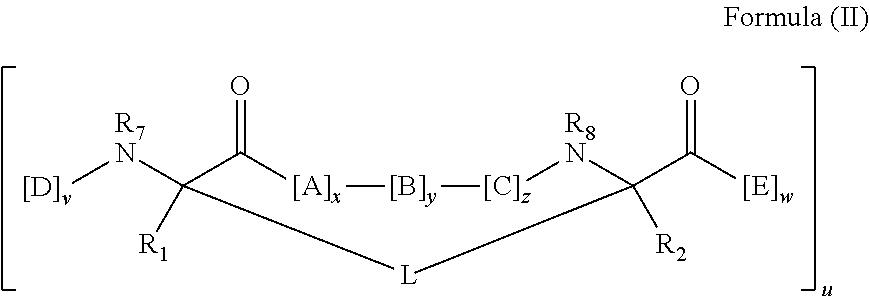
C00014
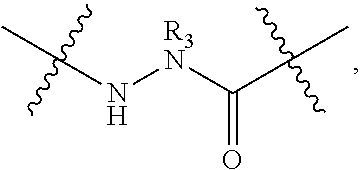
C00015
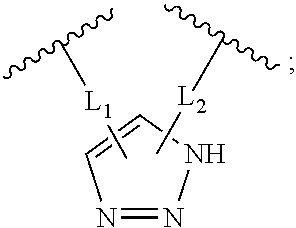
C00016
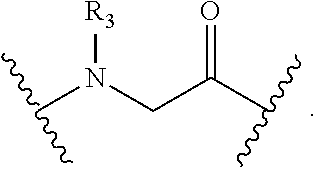
C00017

C00018

C00019

C00020

C00021

C00022

C00023

C00024

C00025

C00026

C00027
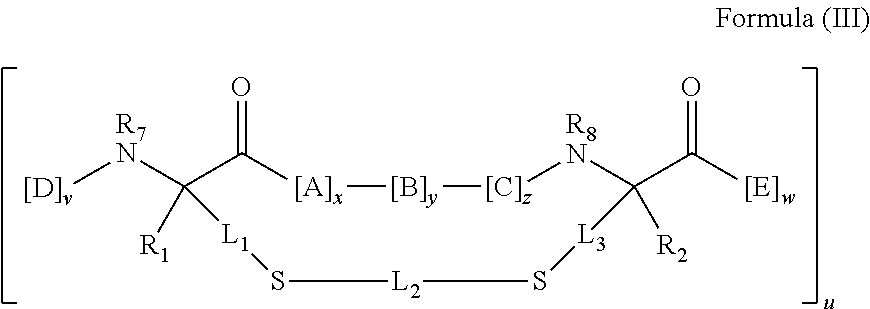
C00028
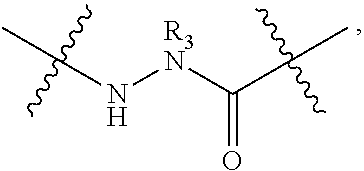
C00029
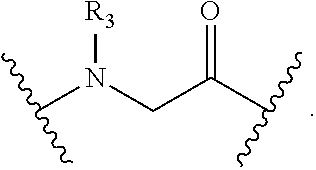
C00030
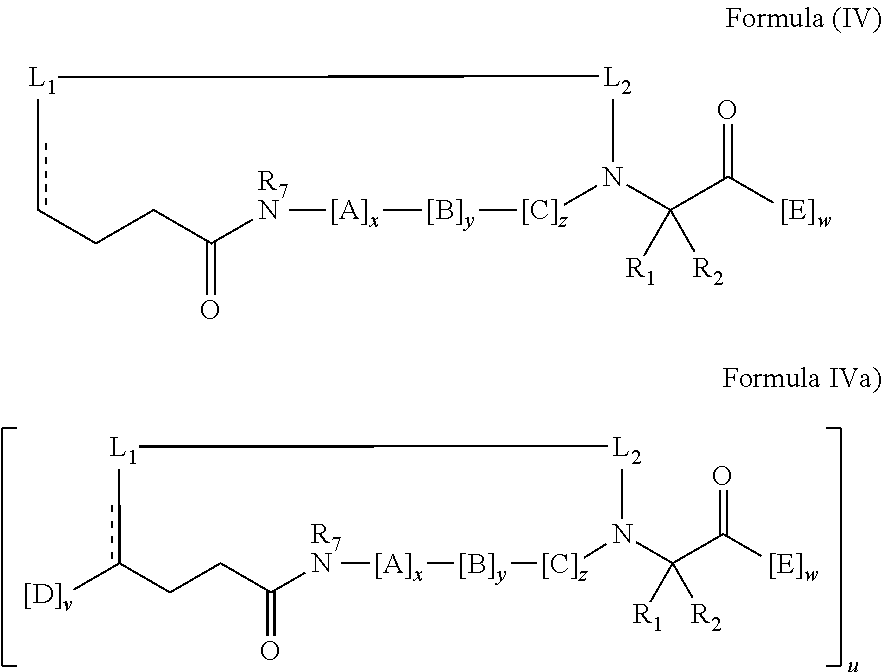
C00031

C00032
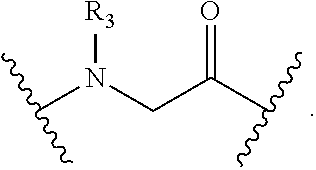
C00033
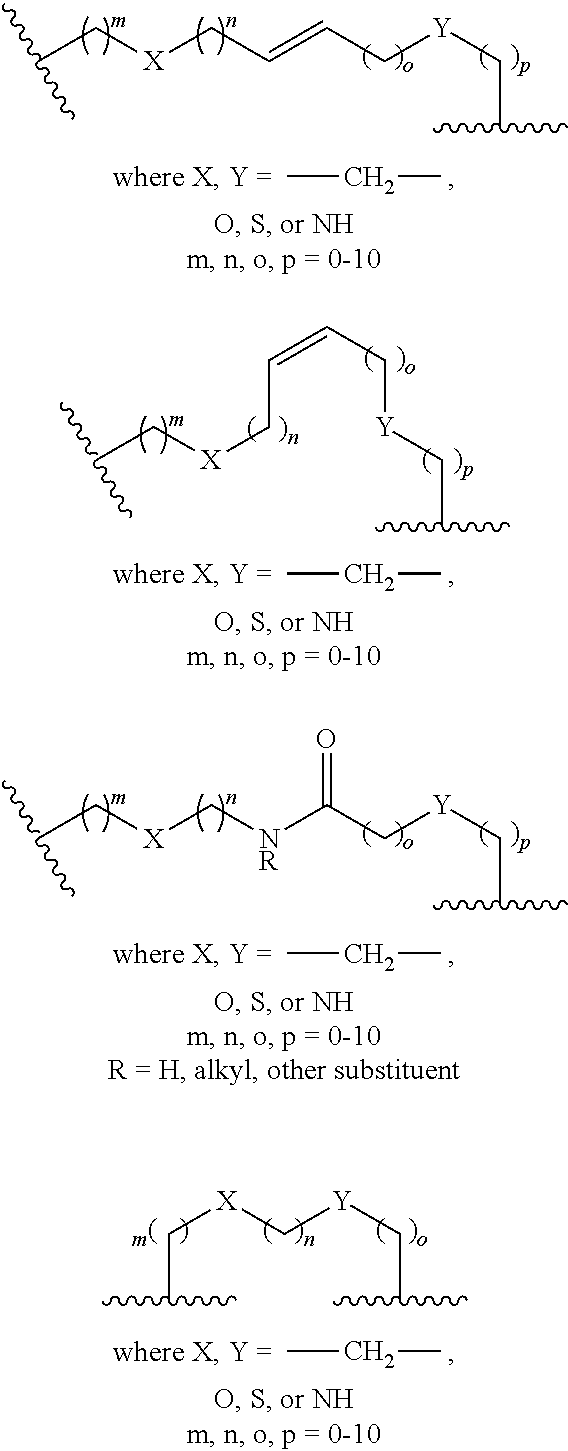
C00034
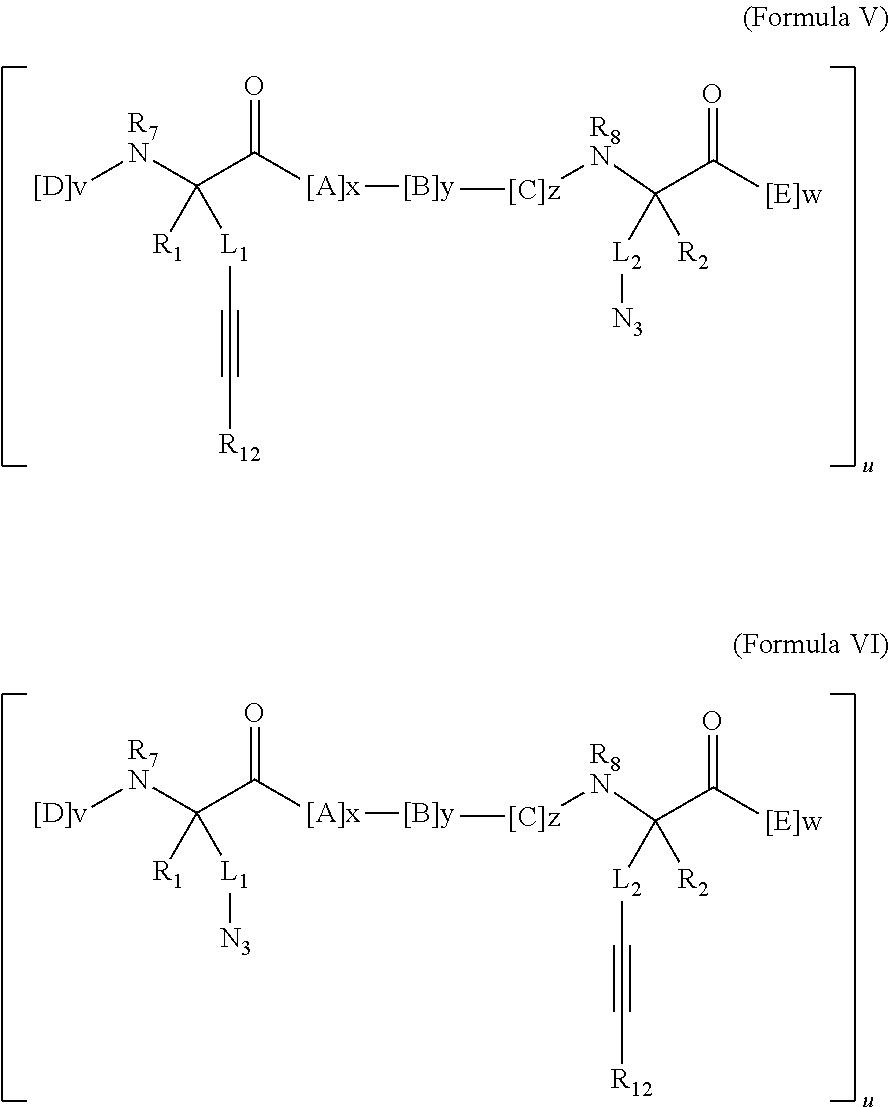
C00035

C00036

C00037
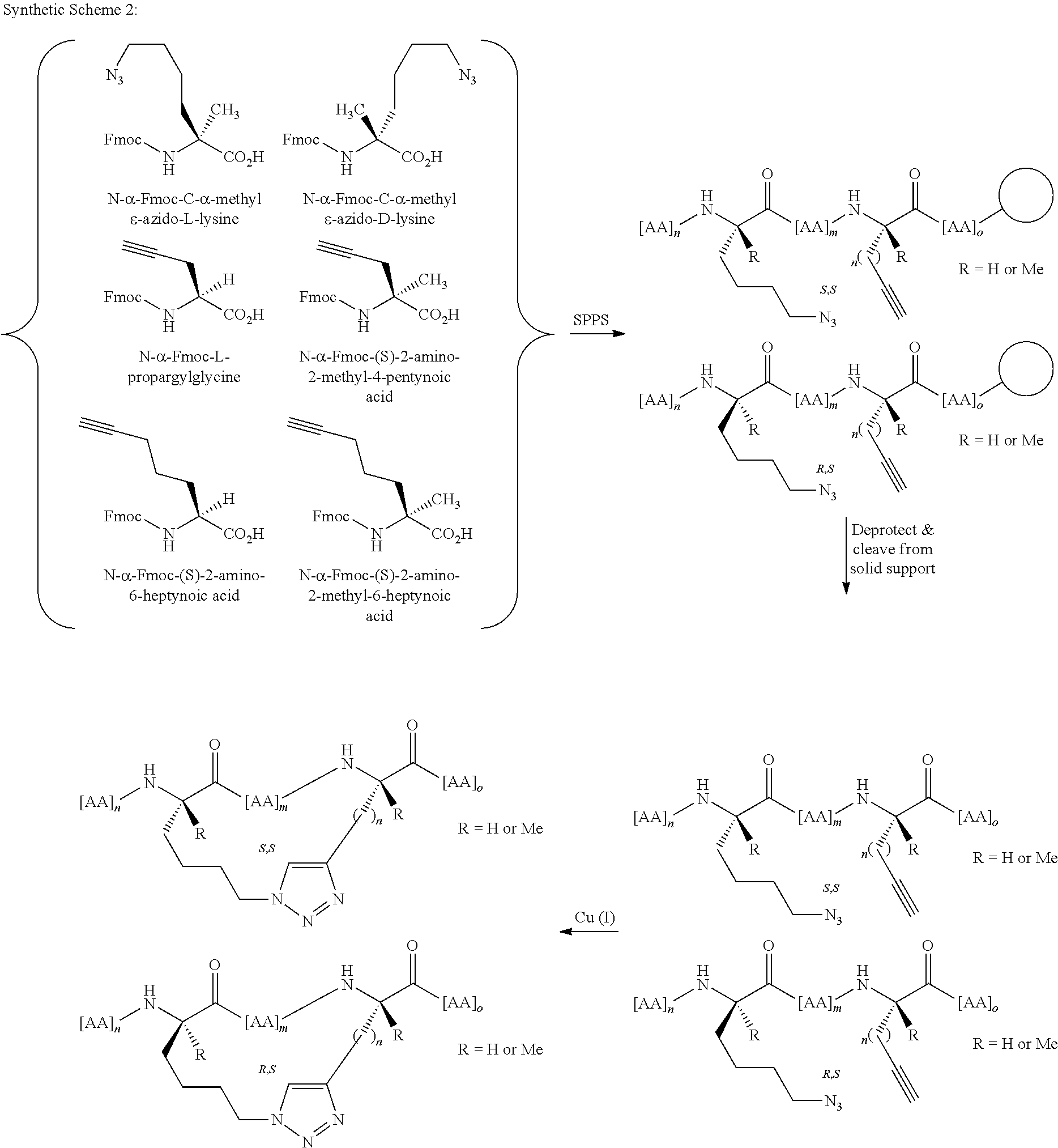
C00038
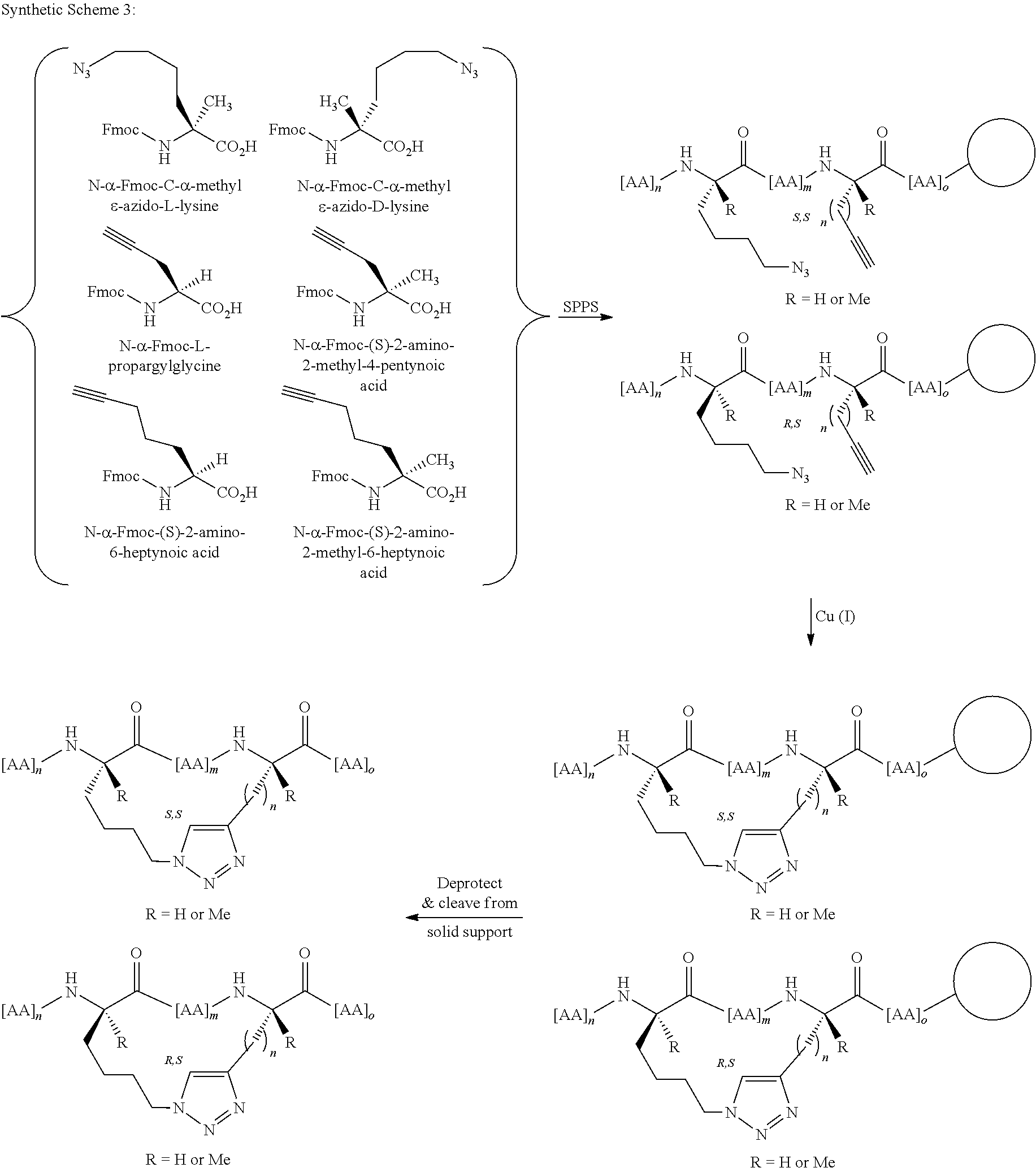
C00039
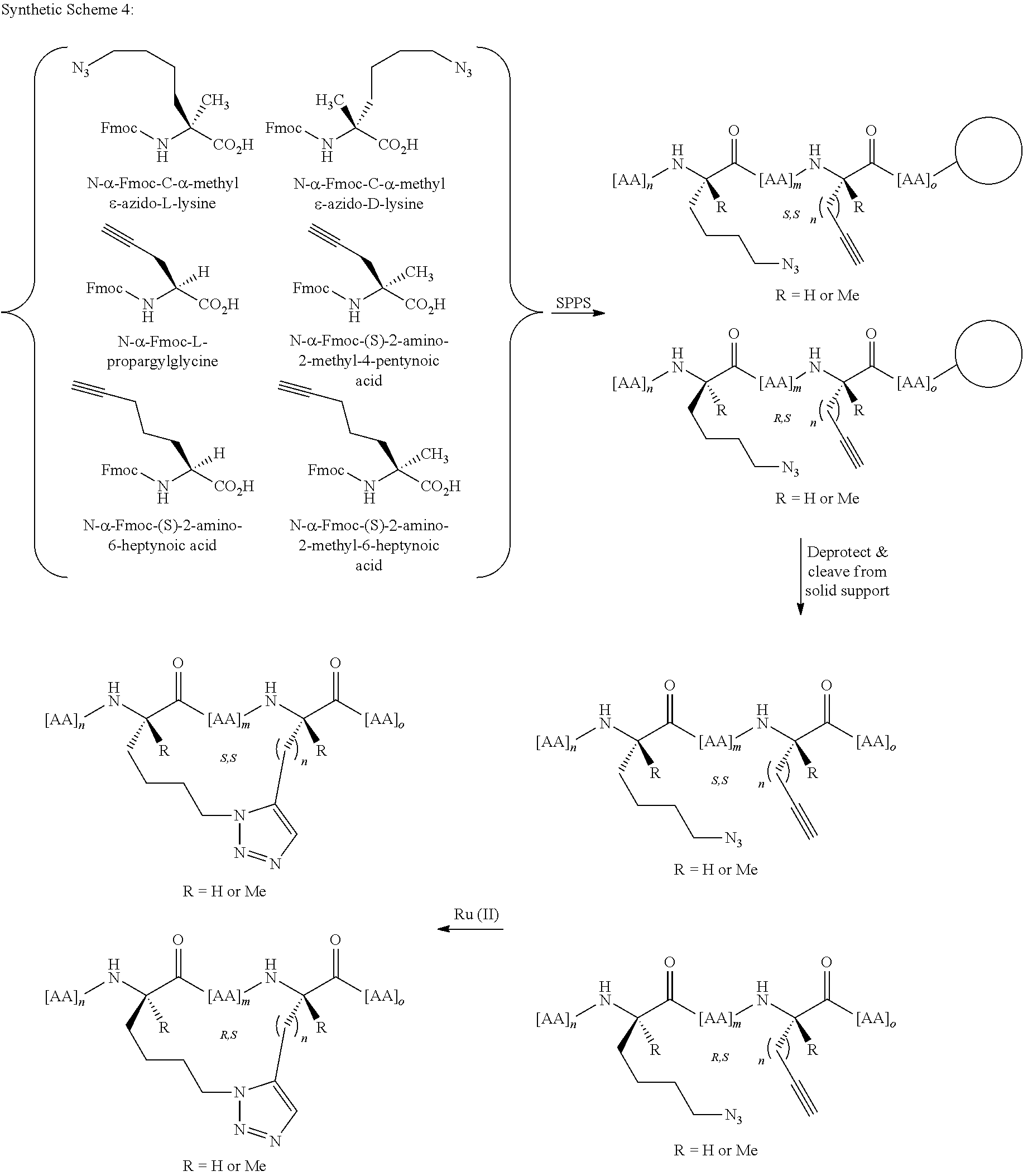
C00040
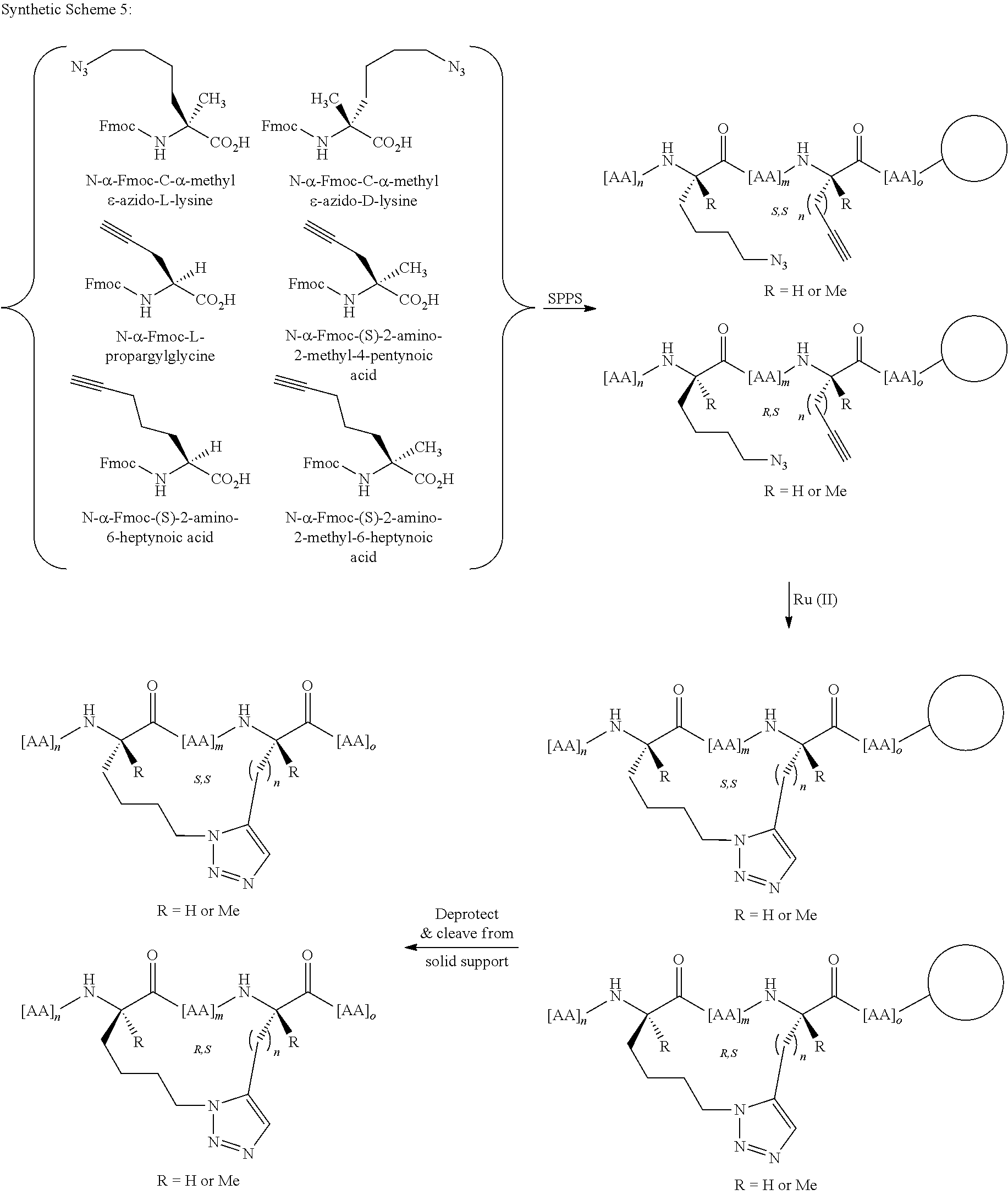
C00041
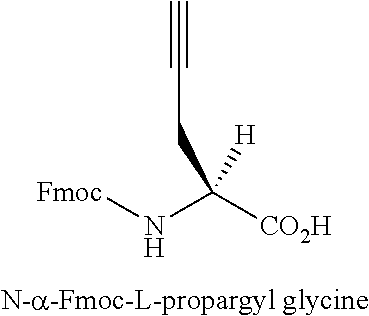
C00042
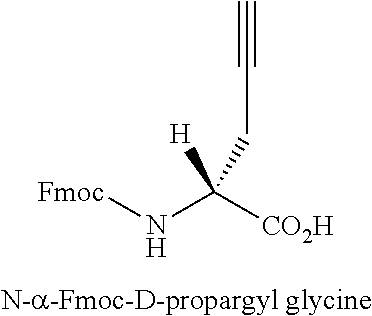
C00043
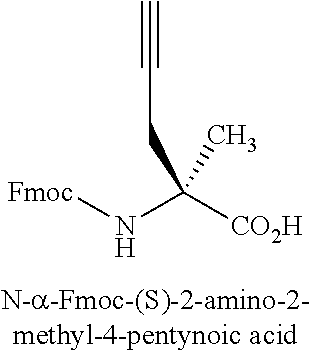
C00044
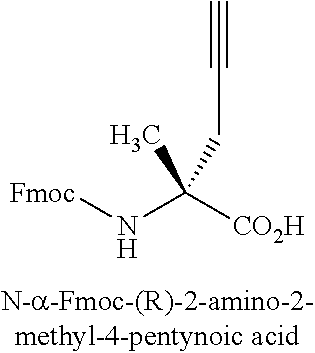
C00045

C00046
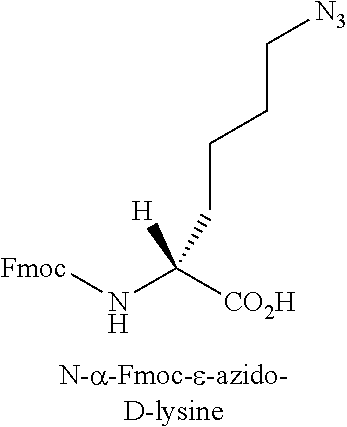
C00047

C00048
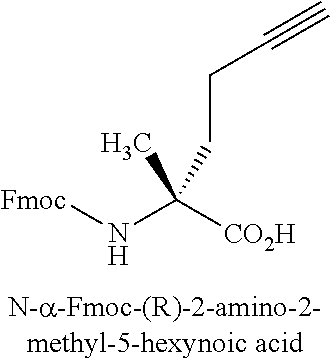
C00049
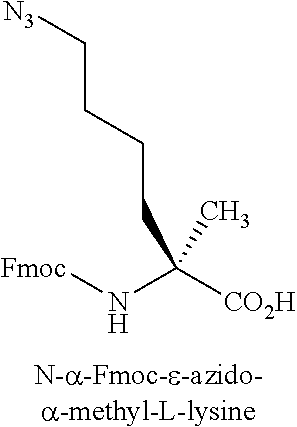
C00050
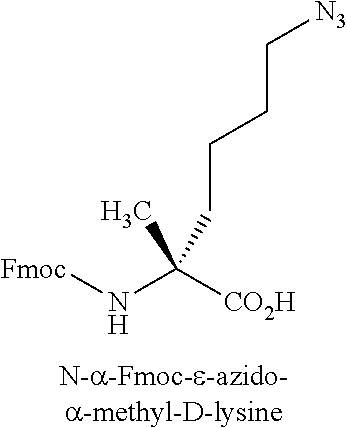
C00051
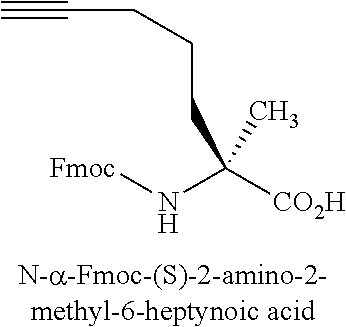
C00052
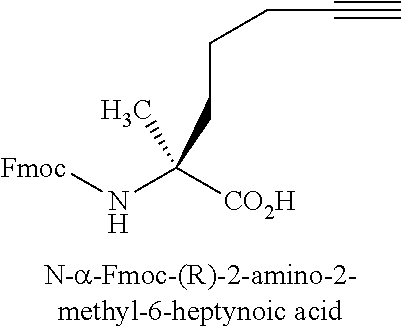
C00053
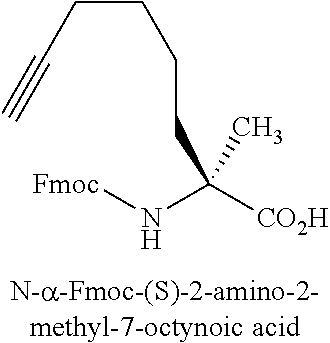
C00054
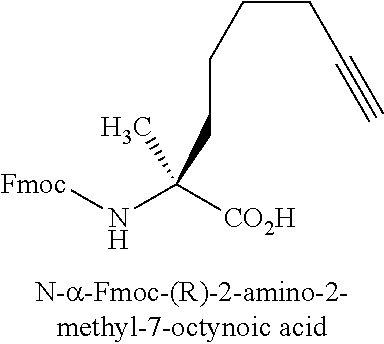
C00055
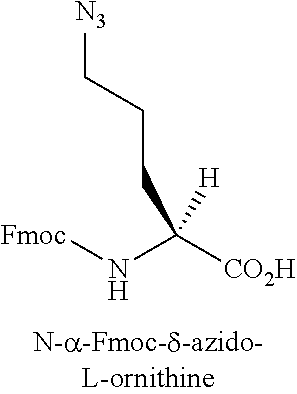
C00056
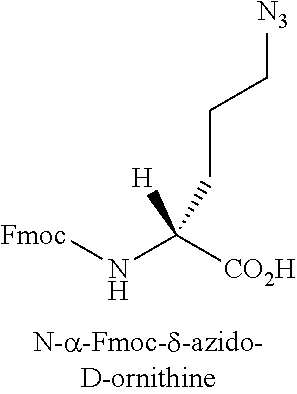
C00057
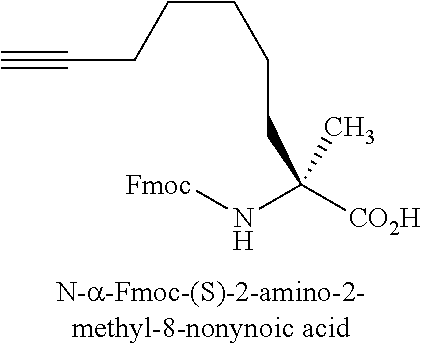
C00058
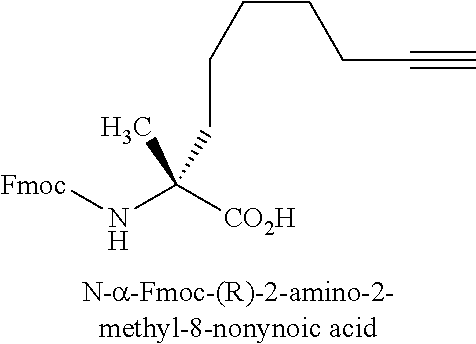
C00059
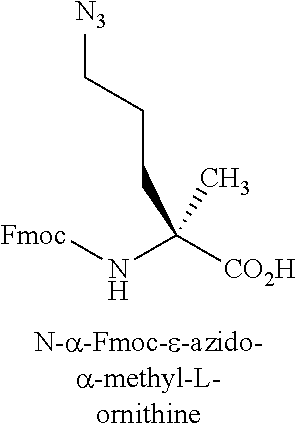
C00060
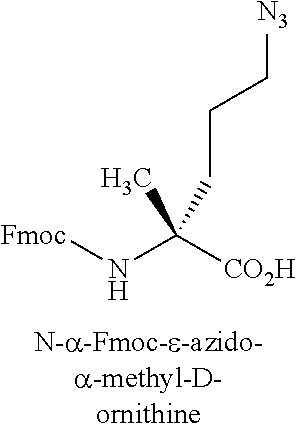
C00061
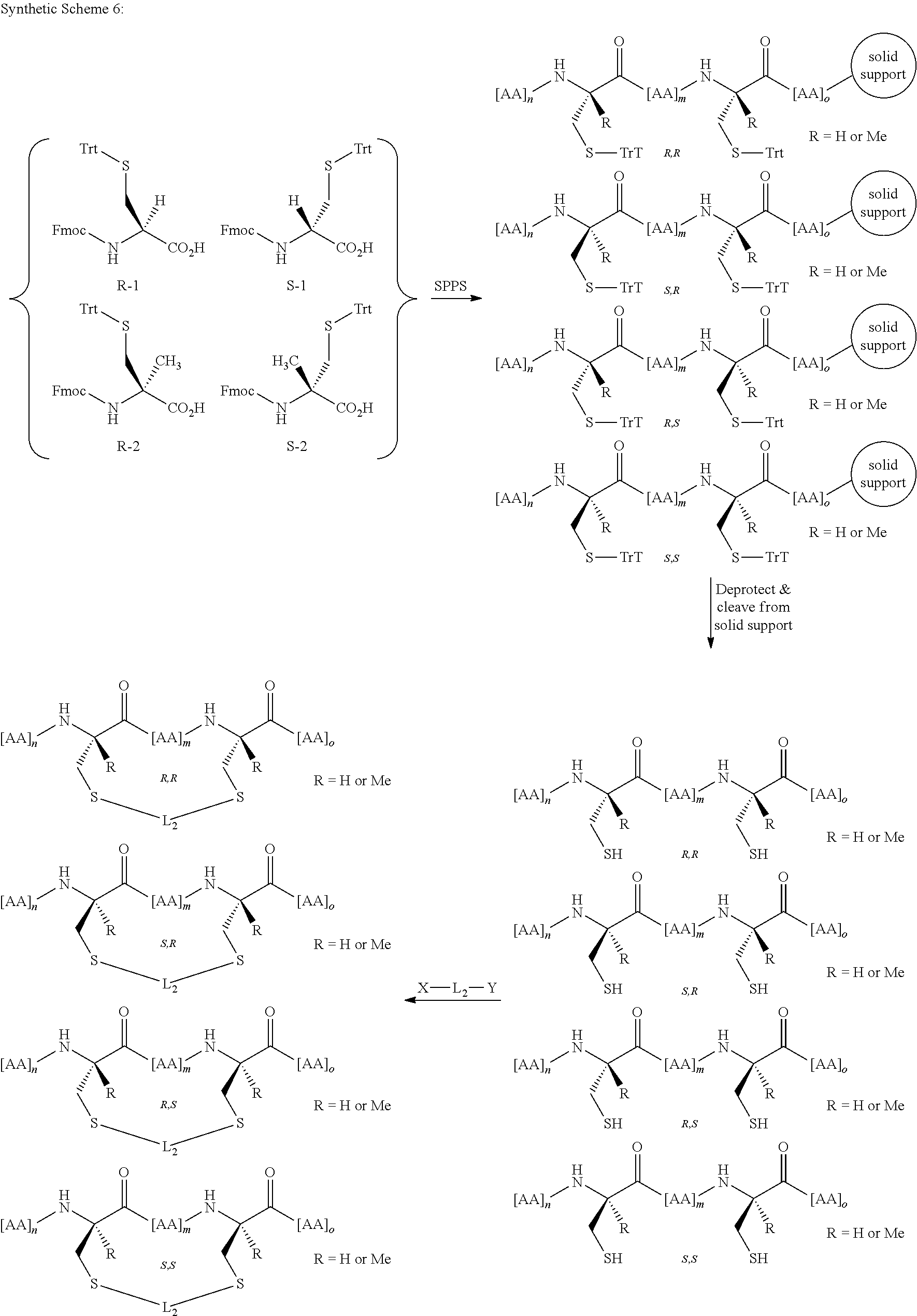
C00062
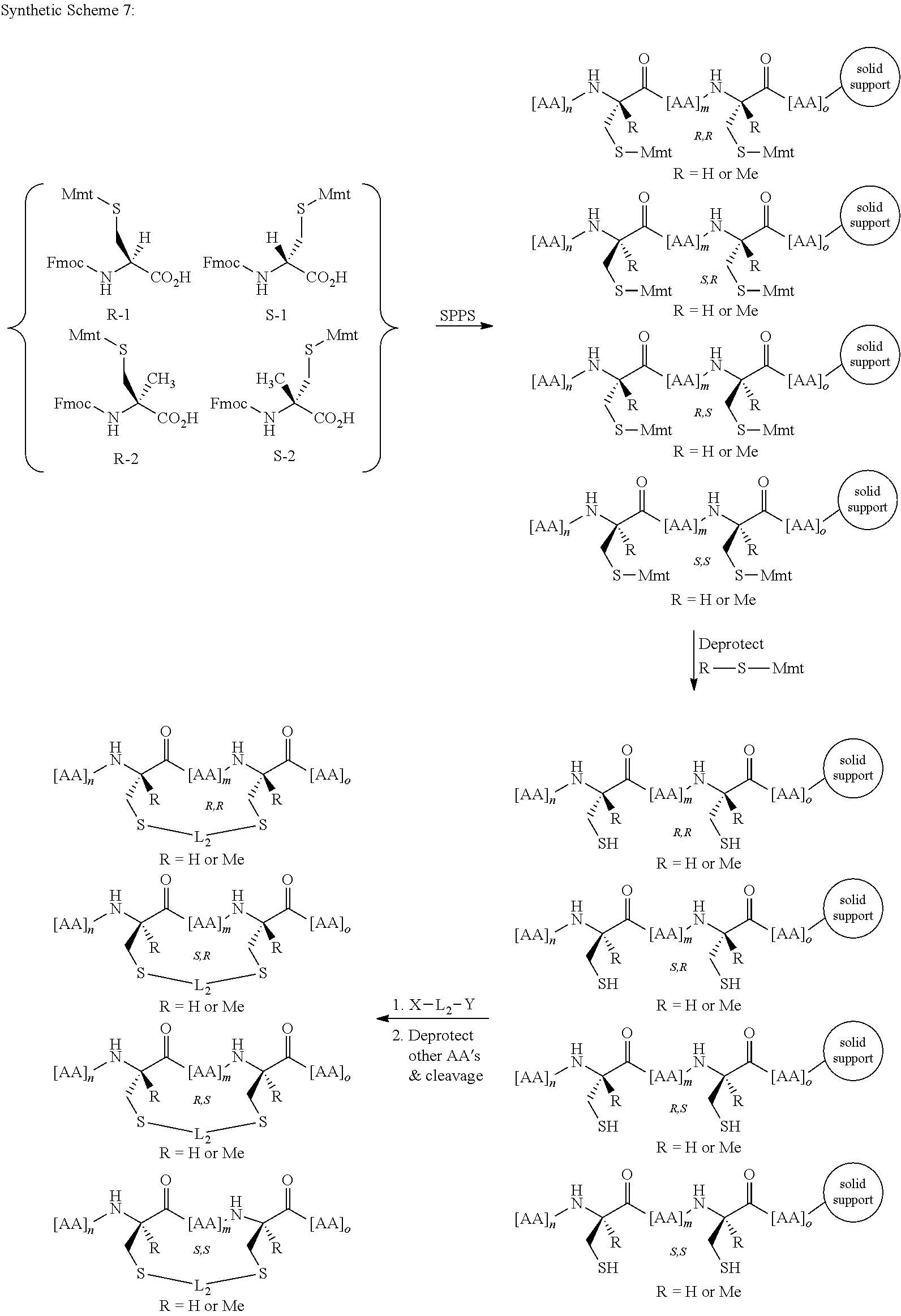
C00063

C00064

C00065

C00066

C00067

C00068

C00069

C00070

C00071

C00072

C00073

C00074

C00075

C00076

C00077

C00078

C00079

C00080

C00081

C00082

C00083

C00084

C00085

C00086

C00087

C00088

C00089

C00090

C00091

C00092

C00093

C00094

C00095

C00096

C00097

C00098

C00099
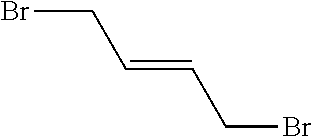
C00100
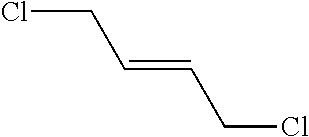
C00101
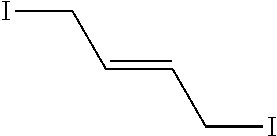
C00102
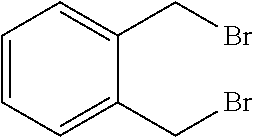
C00103
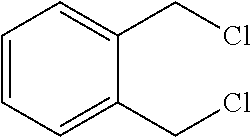
C00104
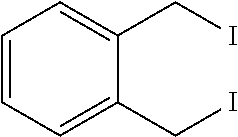
C00105
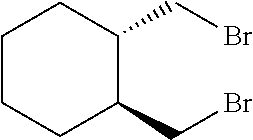
C00106
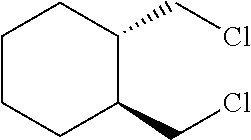
C00107
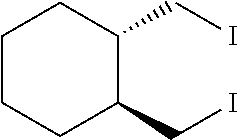
C00108
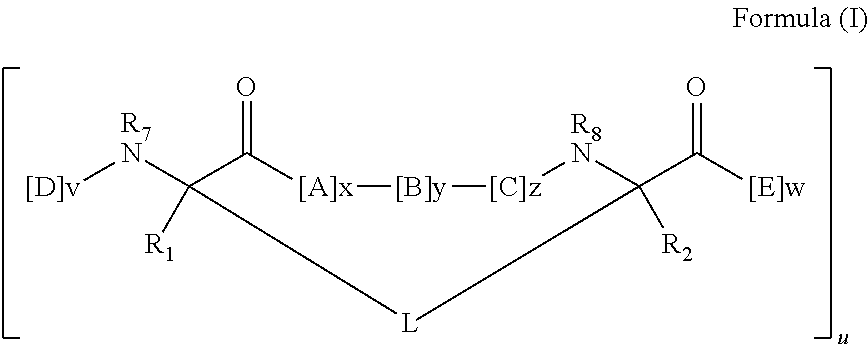
D00001
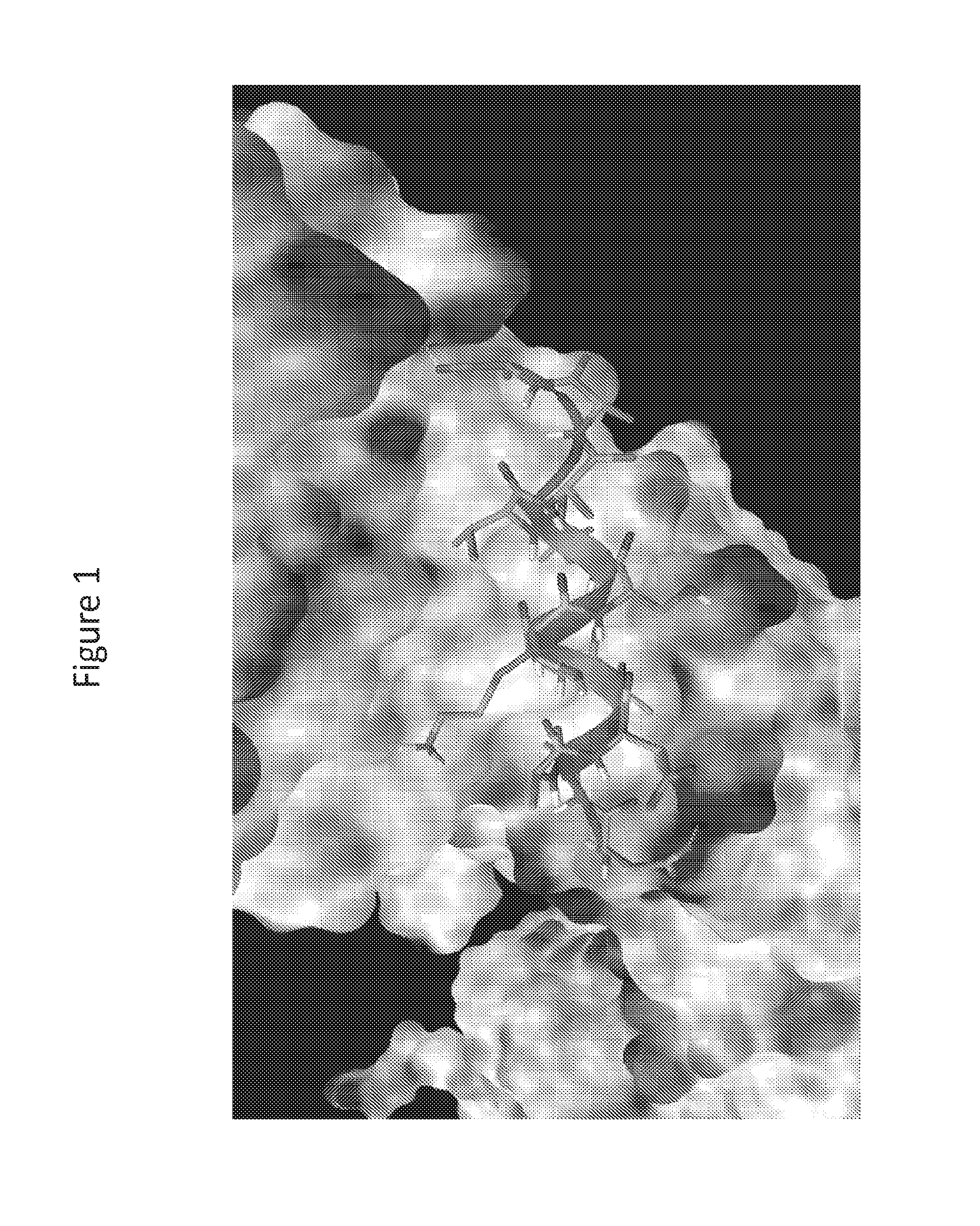
D00002
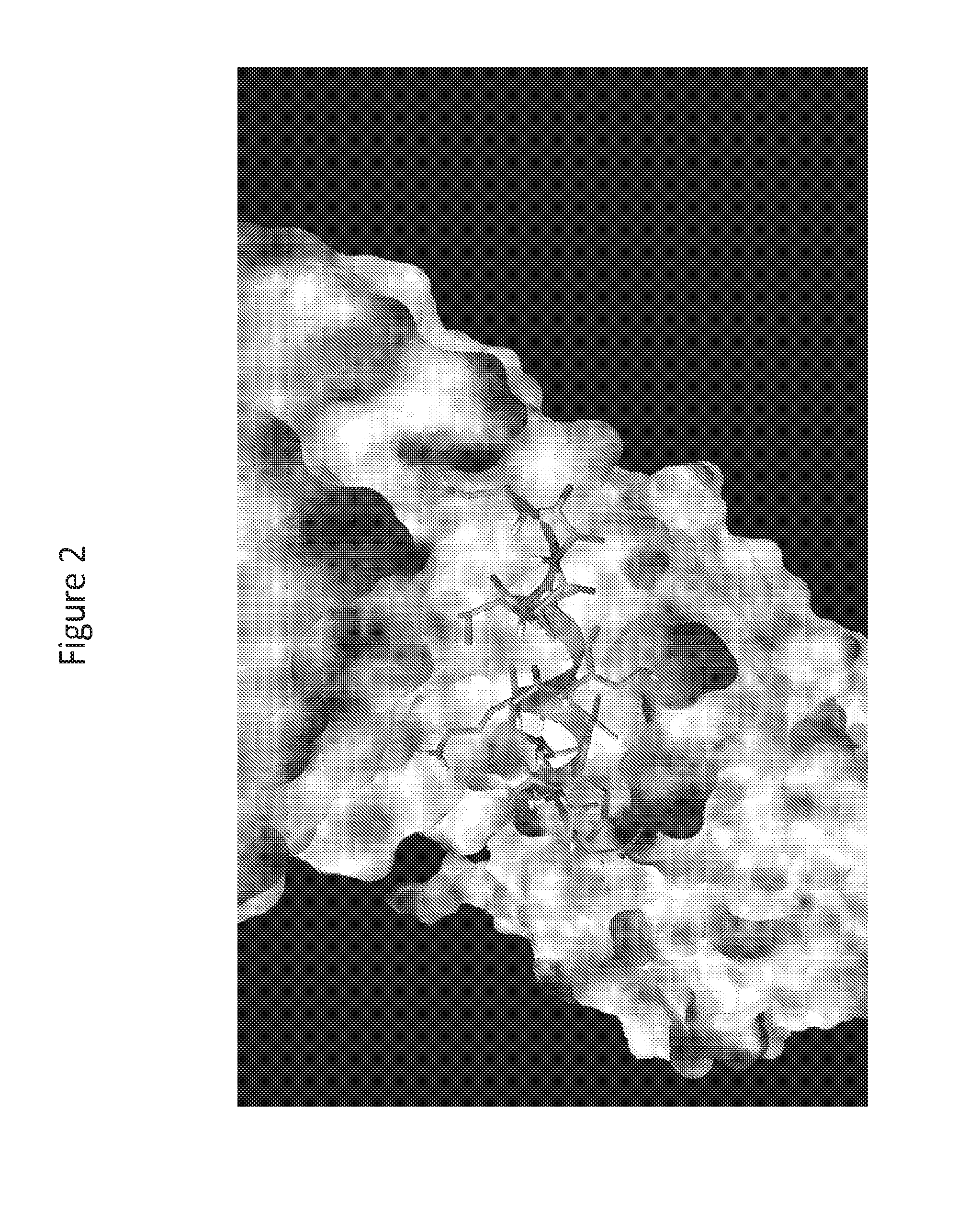
D00003

D00004
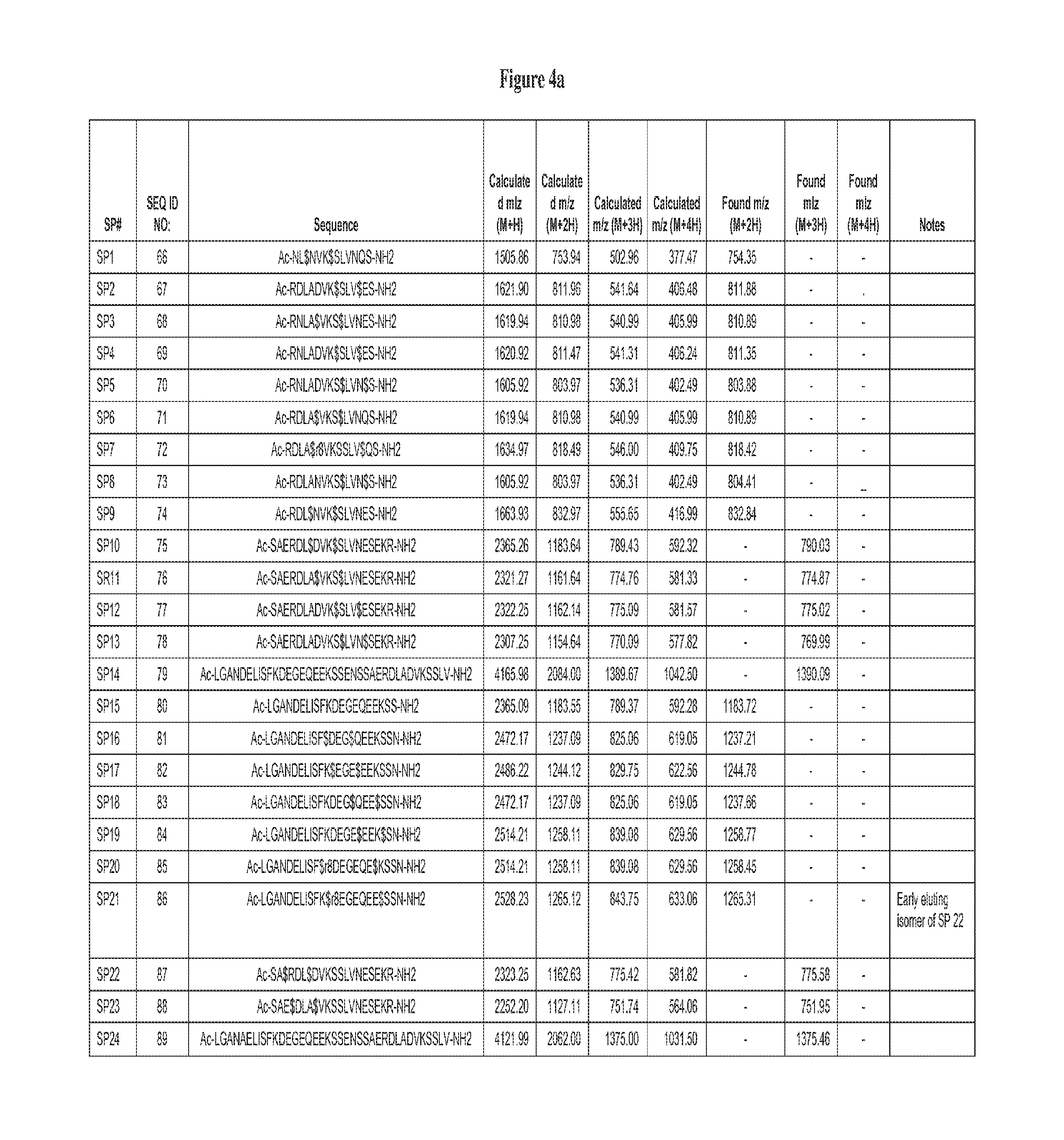
D00005
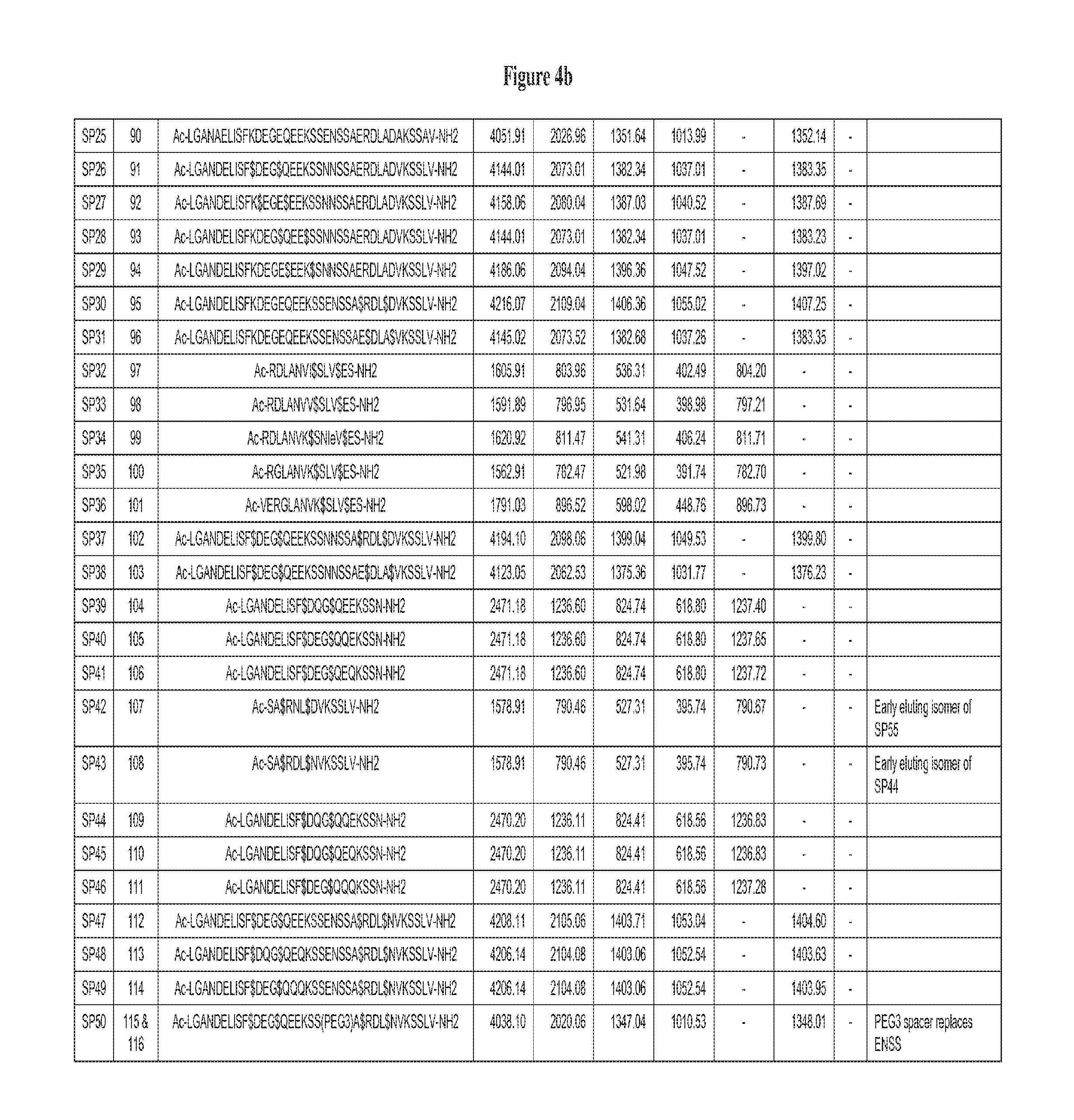
D00006
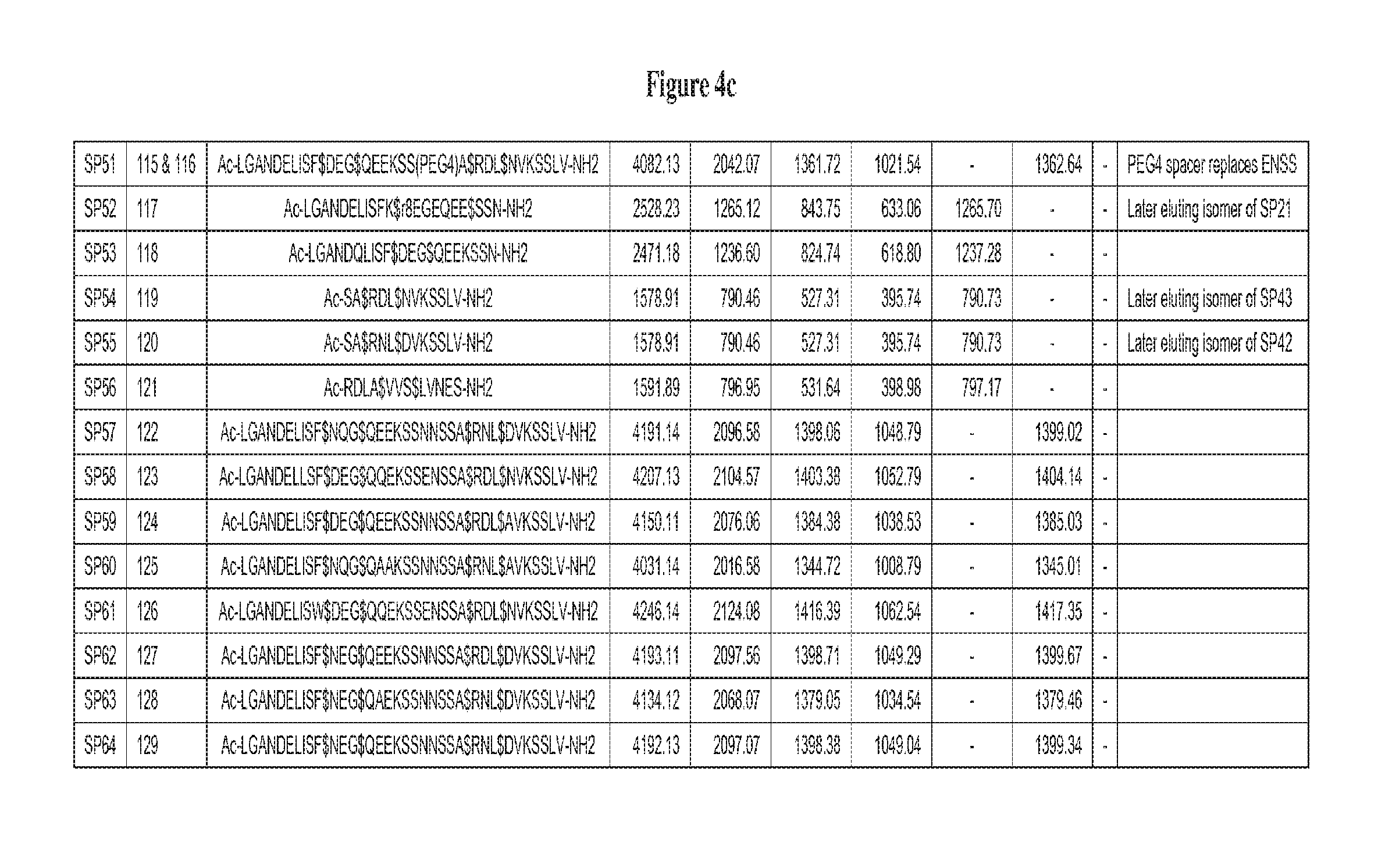
P00001

P00002

S00001
XML
uspto.report is an independent third-party trademark research tool that is not affiliated, endorsed, or sponsored by the United States Patent and Trademark Office (USPTO) or any other governmental organization. The information provided by uspto.report is based on publicly available data at the time of writing and is intended for informational purposes only.
While we strive to provide accurate and up-to-date information, we do not guarantee the accuracy, completeness, reliability, or suitability of the information displayed on this site. The use of this site is at your own risk. Any reliance you place on such information is therefore strictly at your own risk.
All official trademark data, including owner information, should be verified by visiting the official USPTO website at www.uspto.gov. This site is not intended to replace professional legal advice and should not be used as a substitute for consulting with a legal professional who is knowledgeable about trademark law.